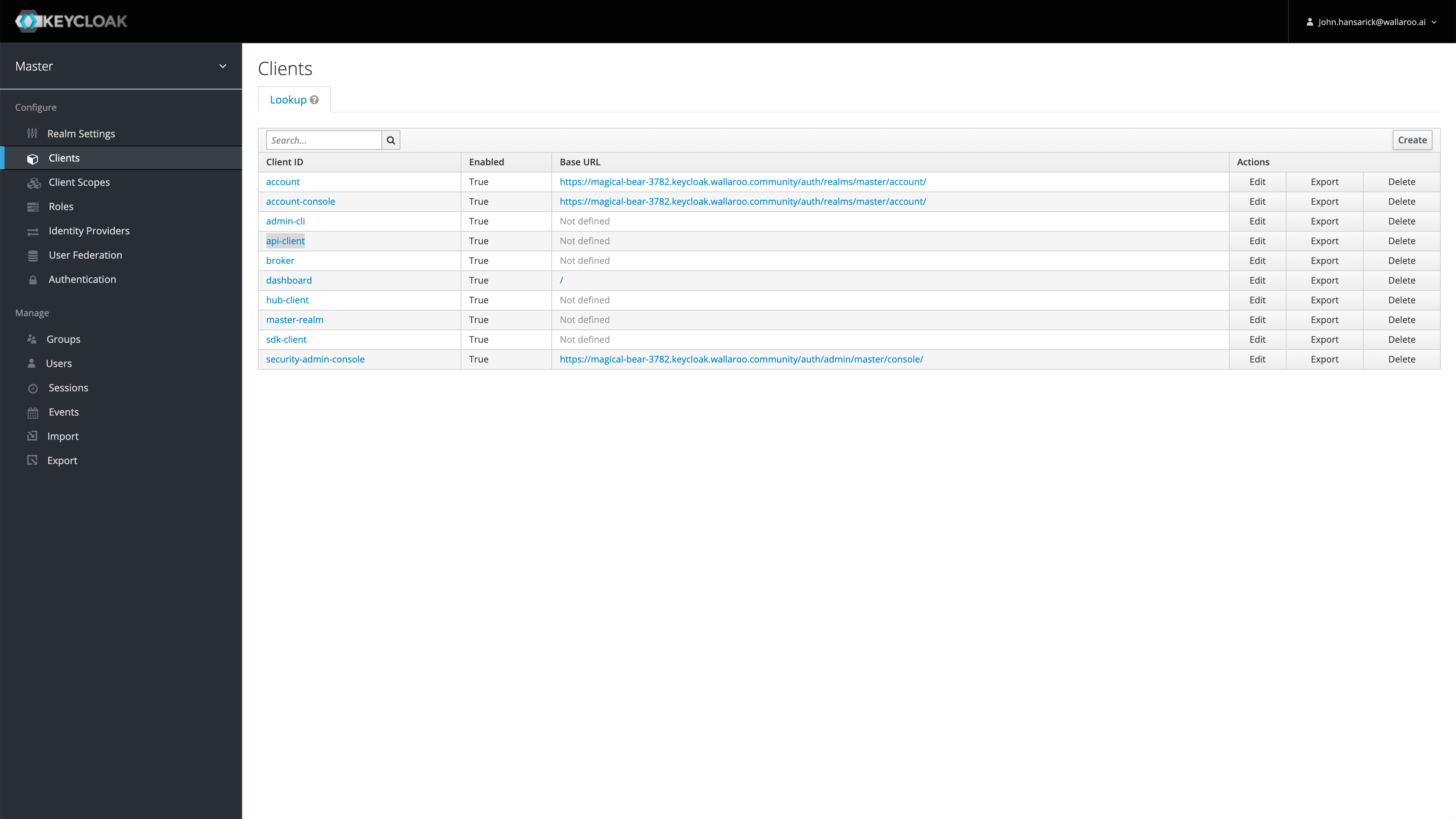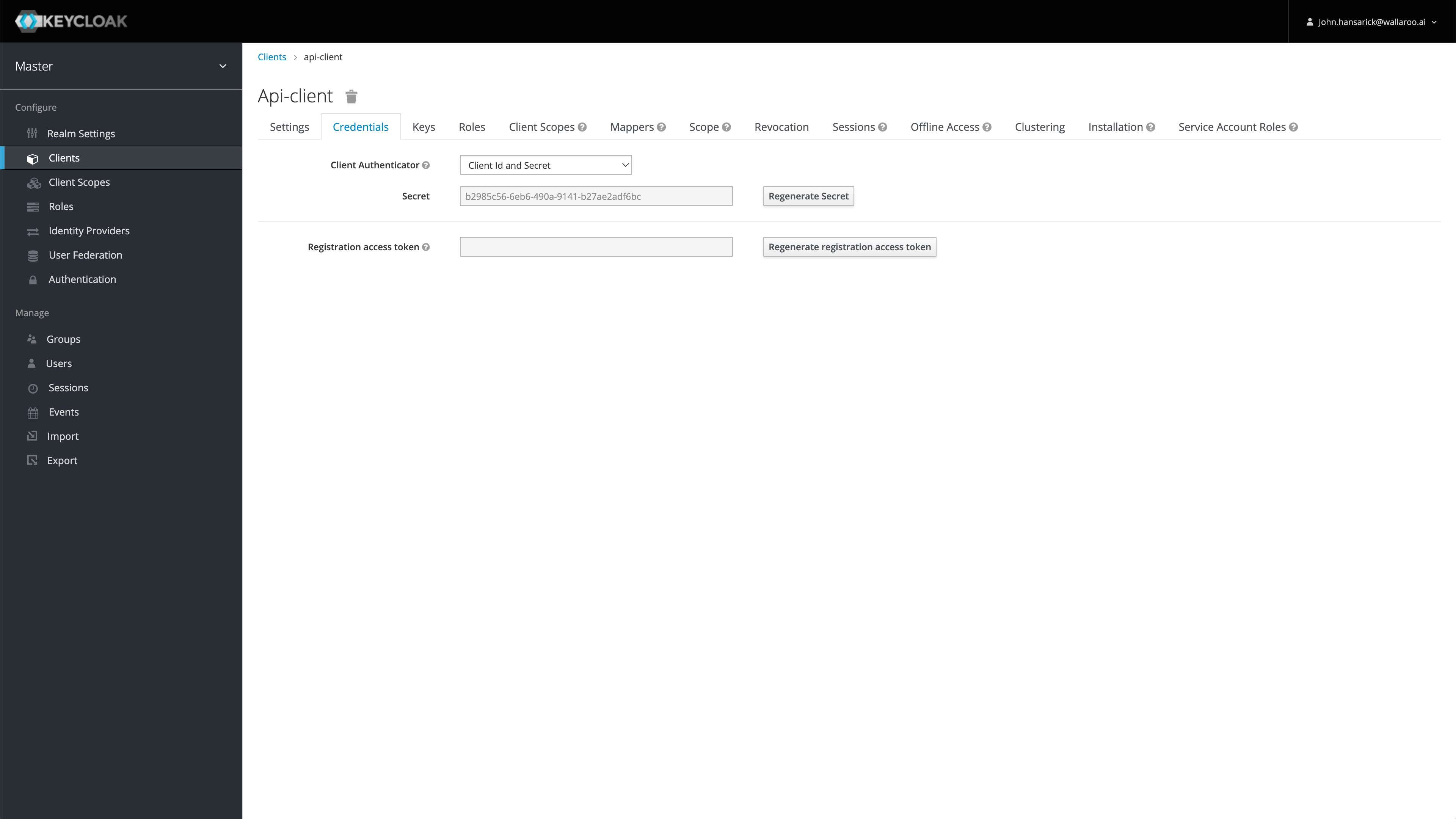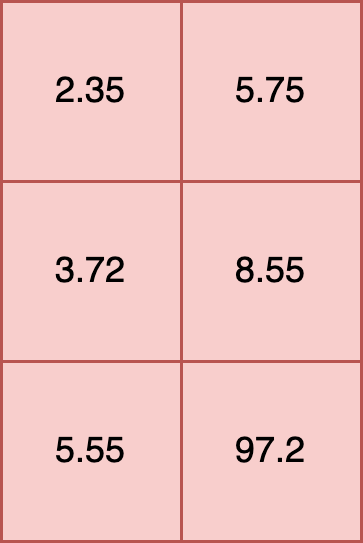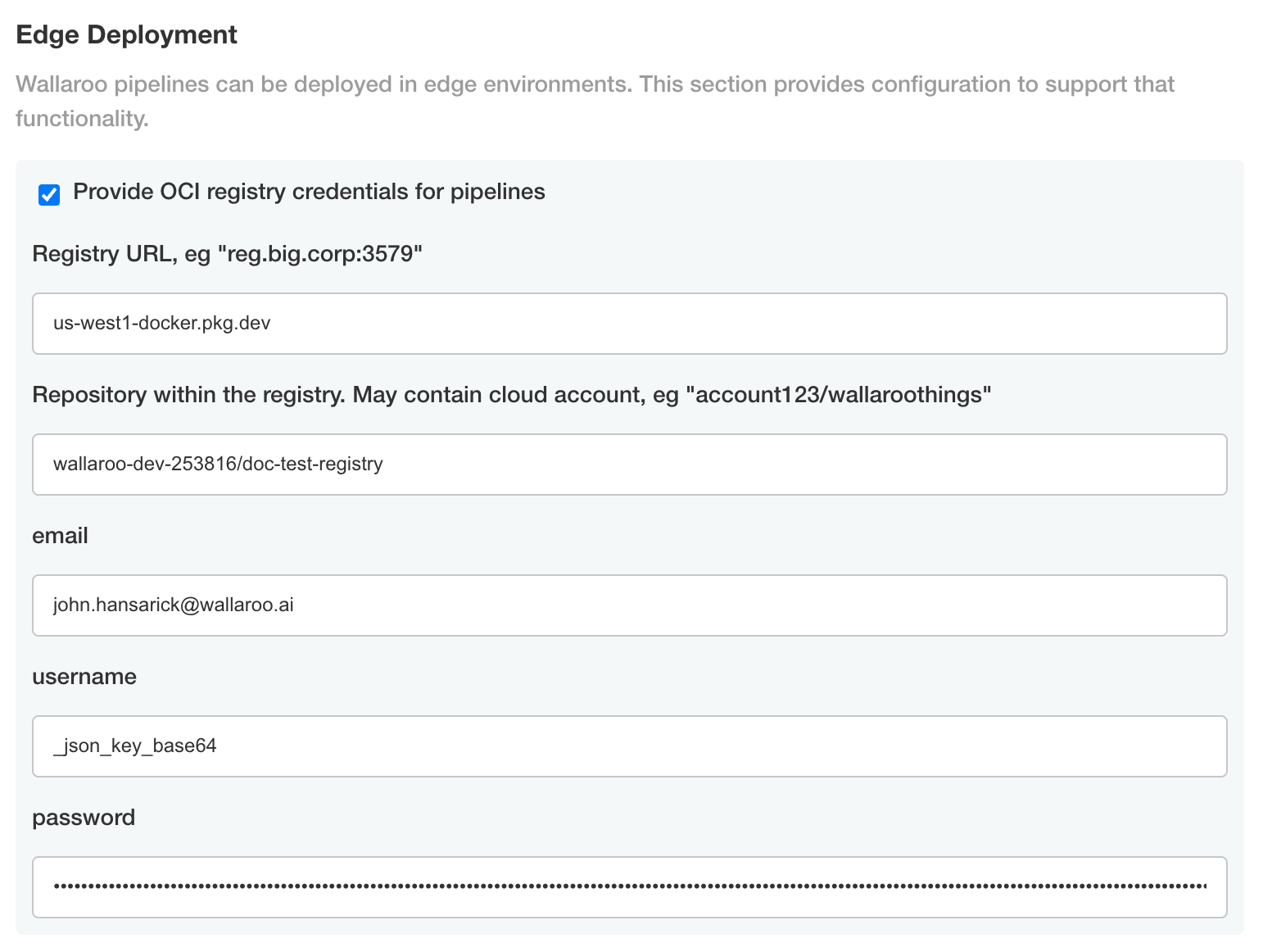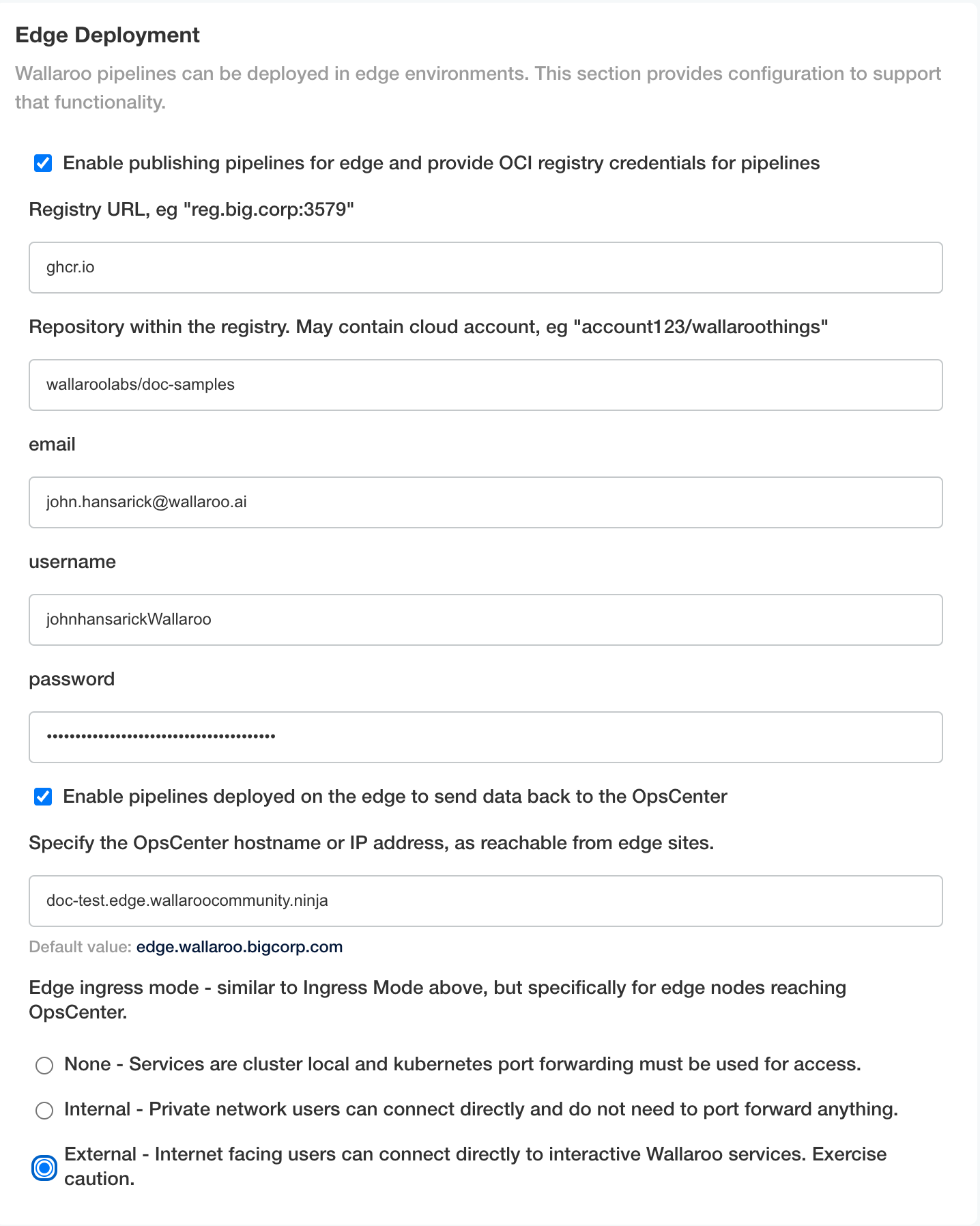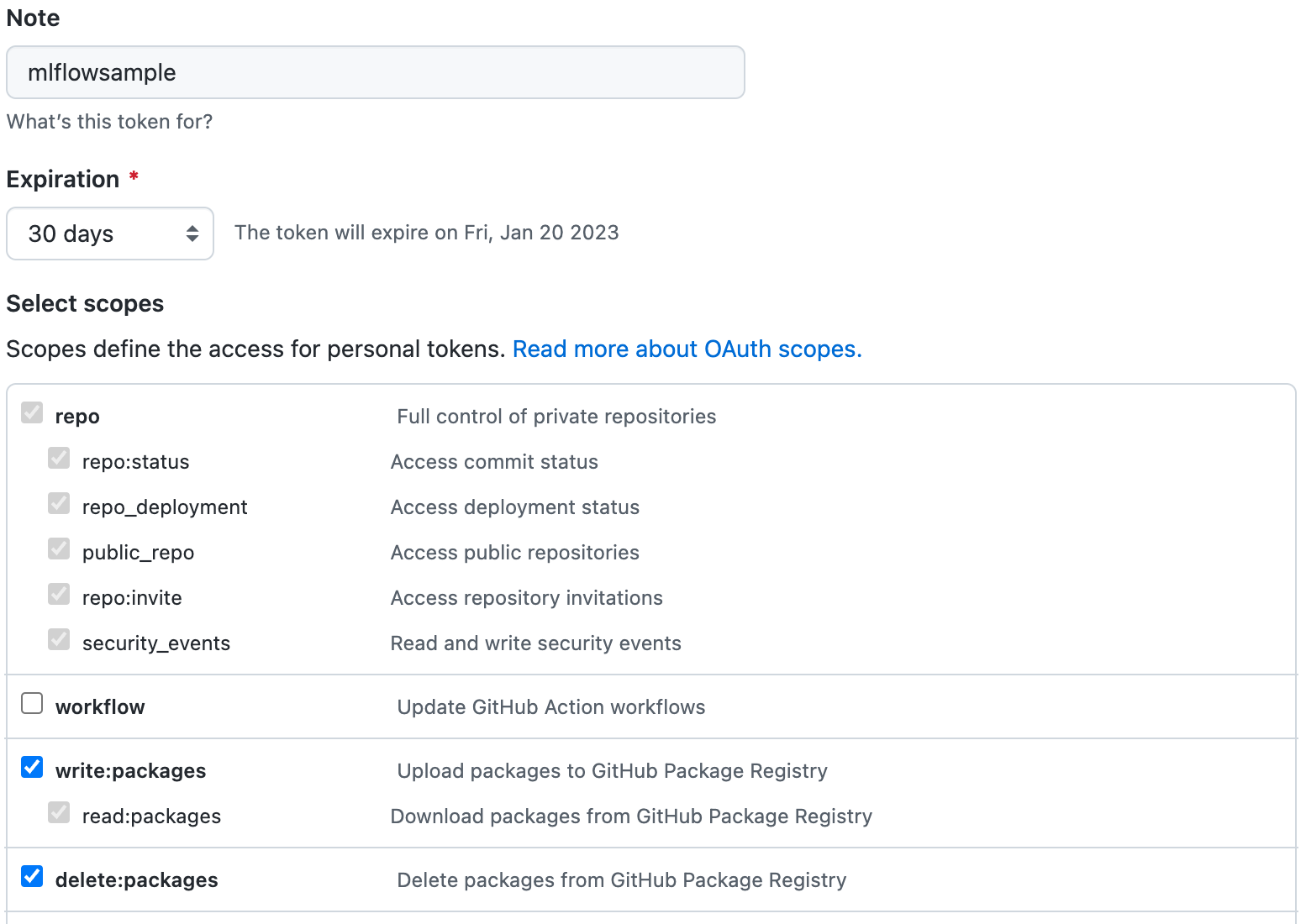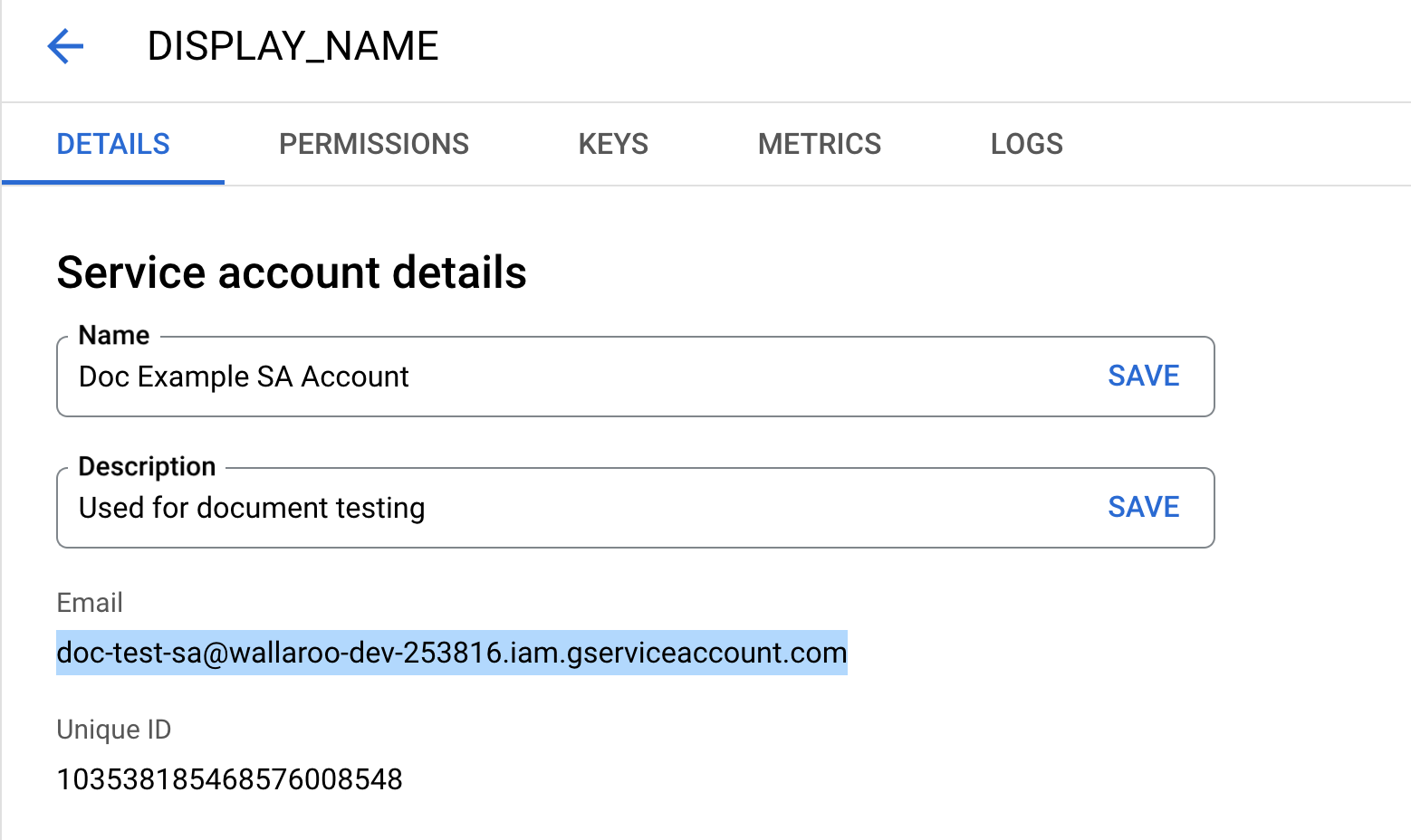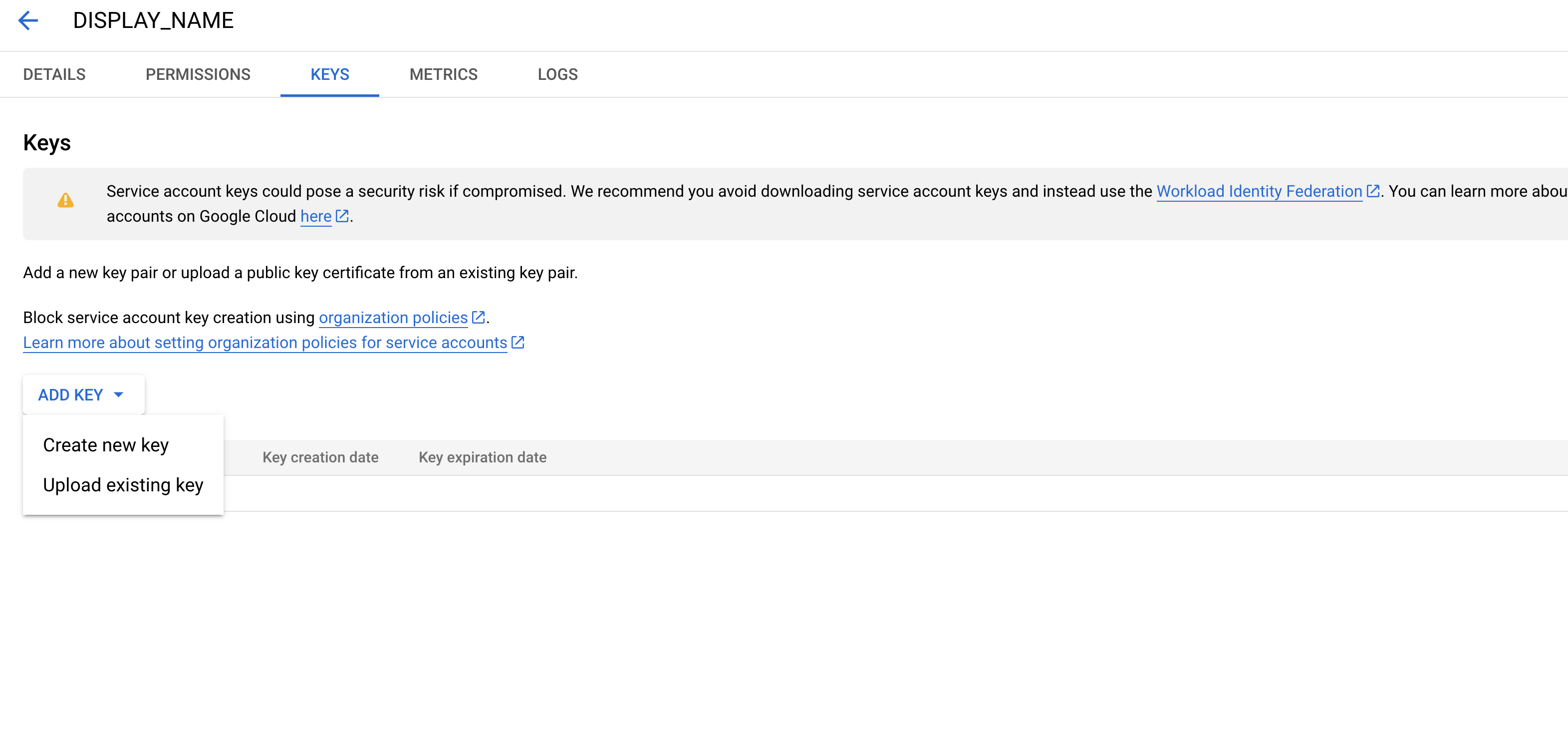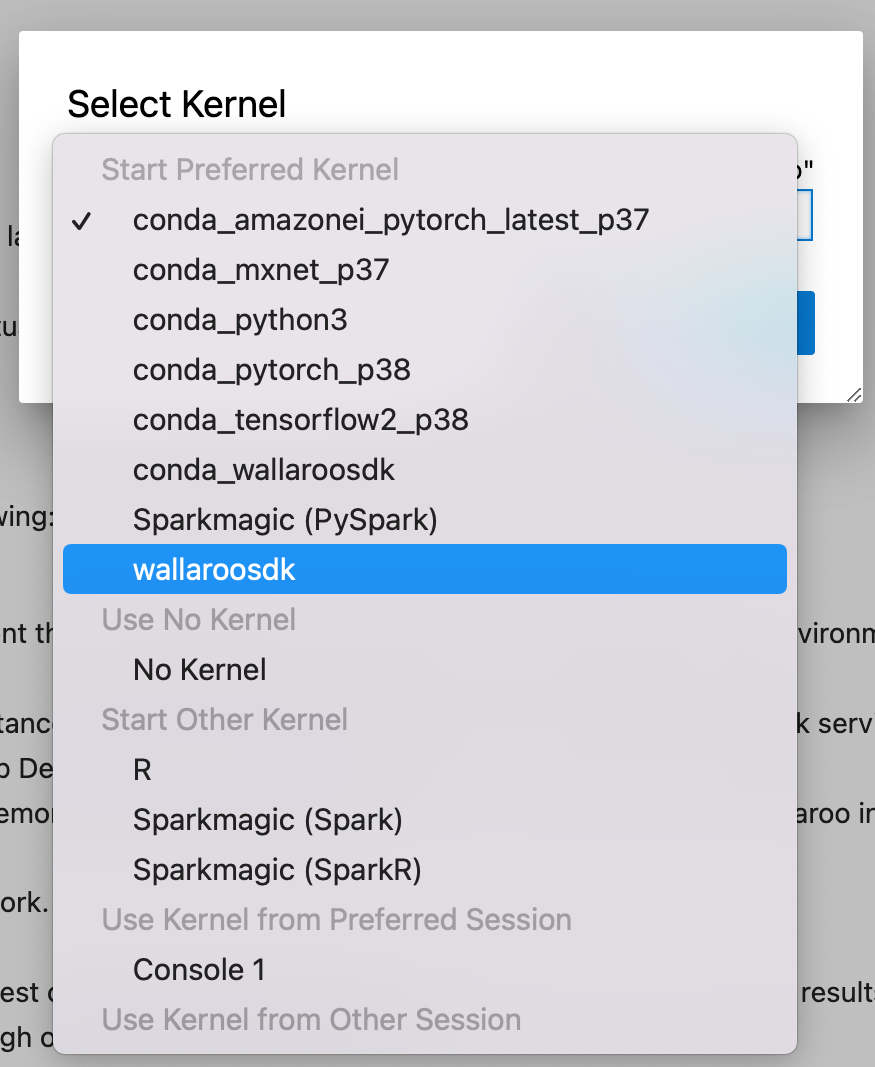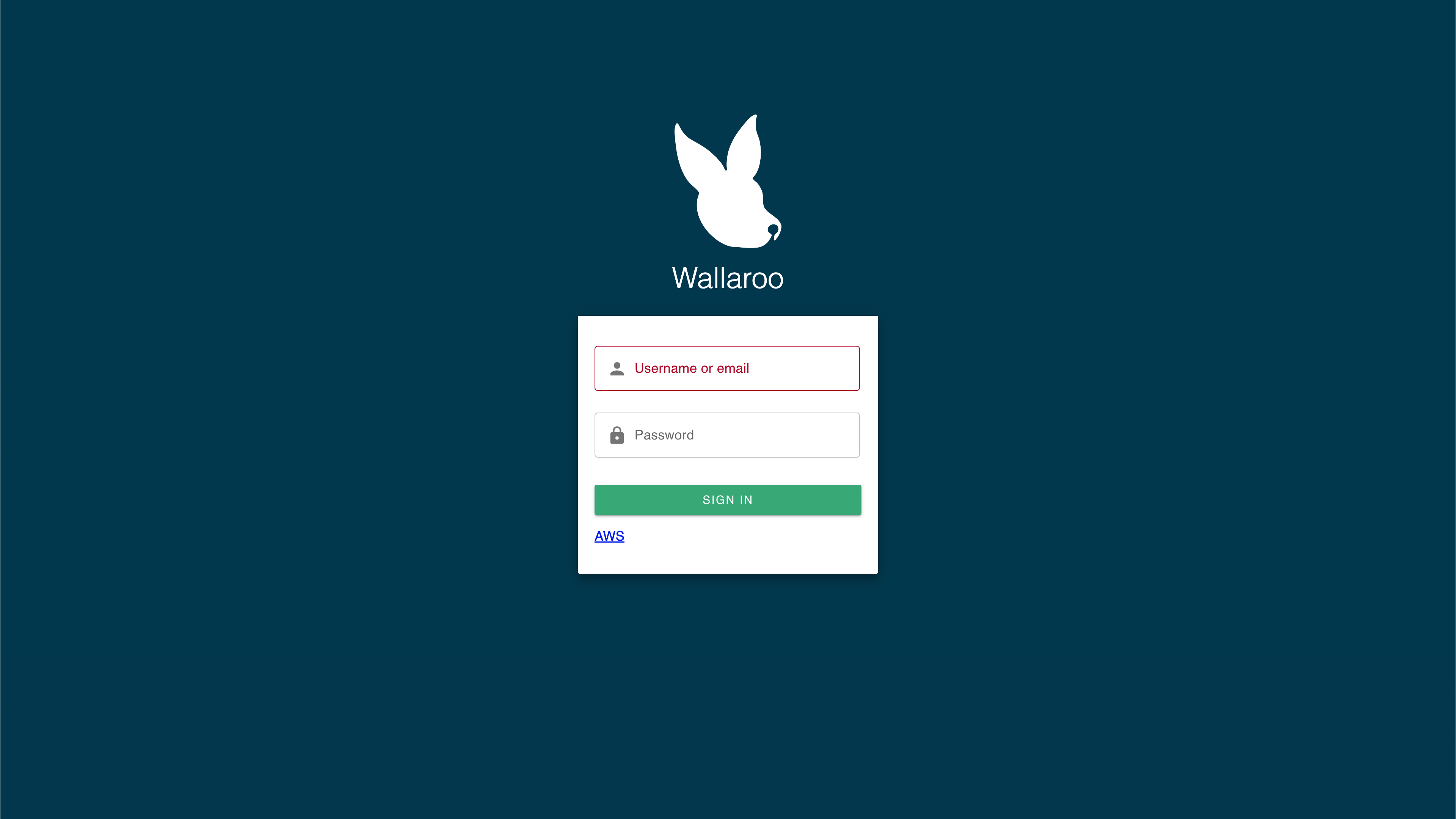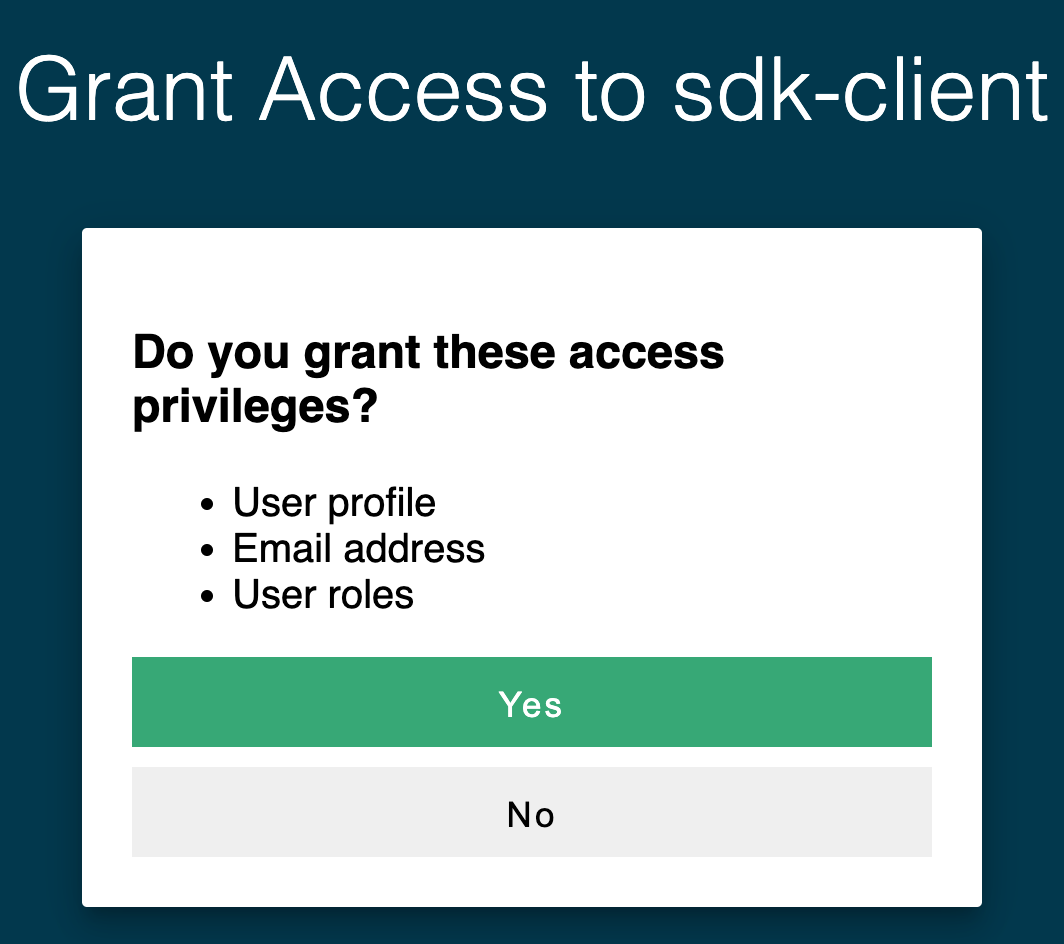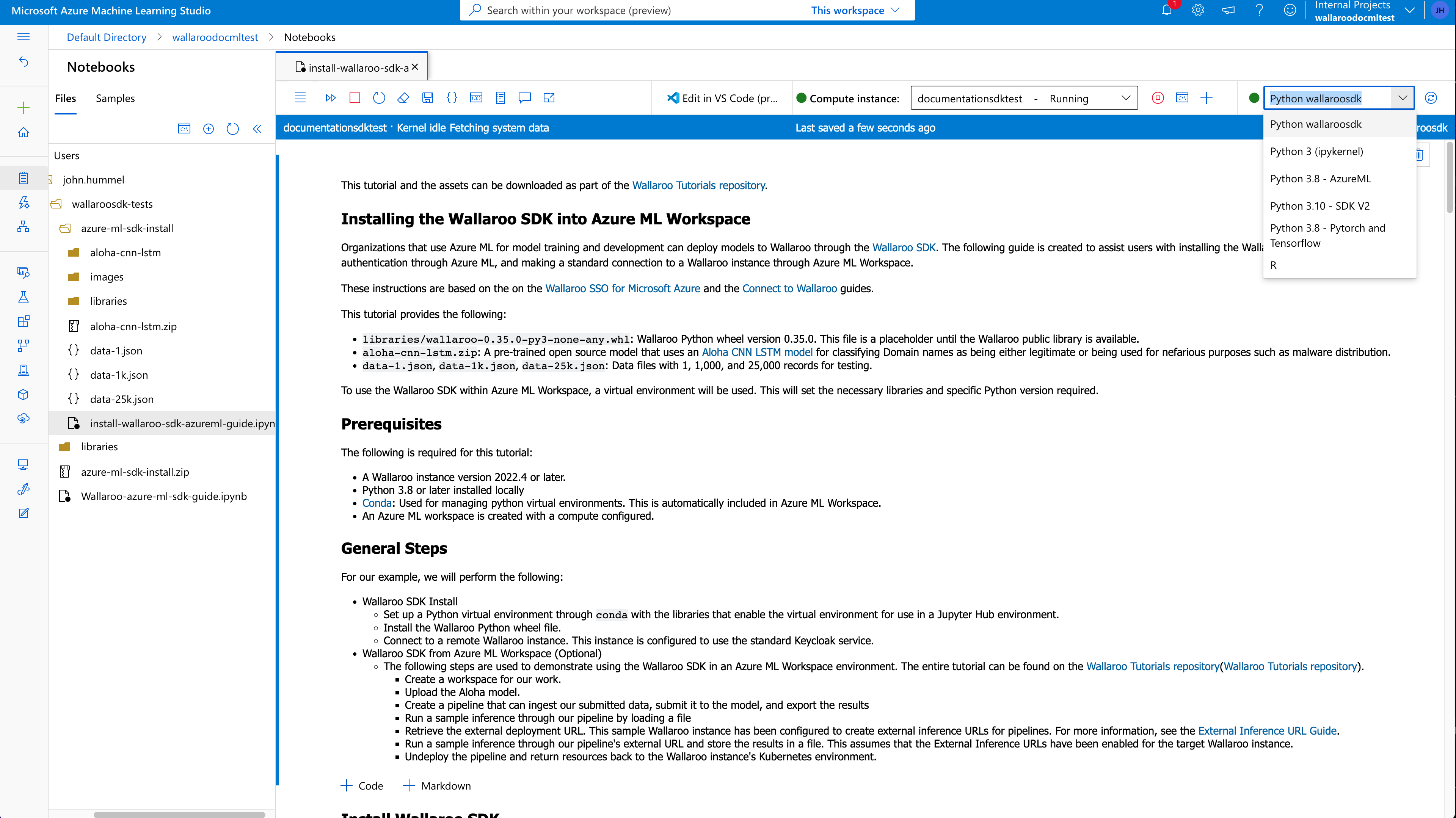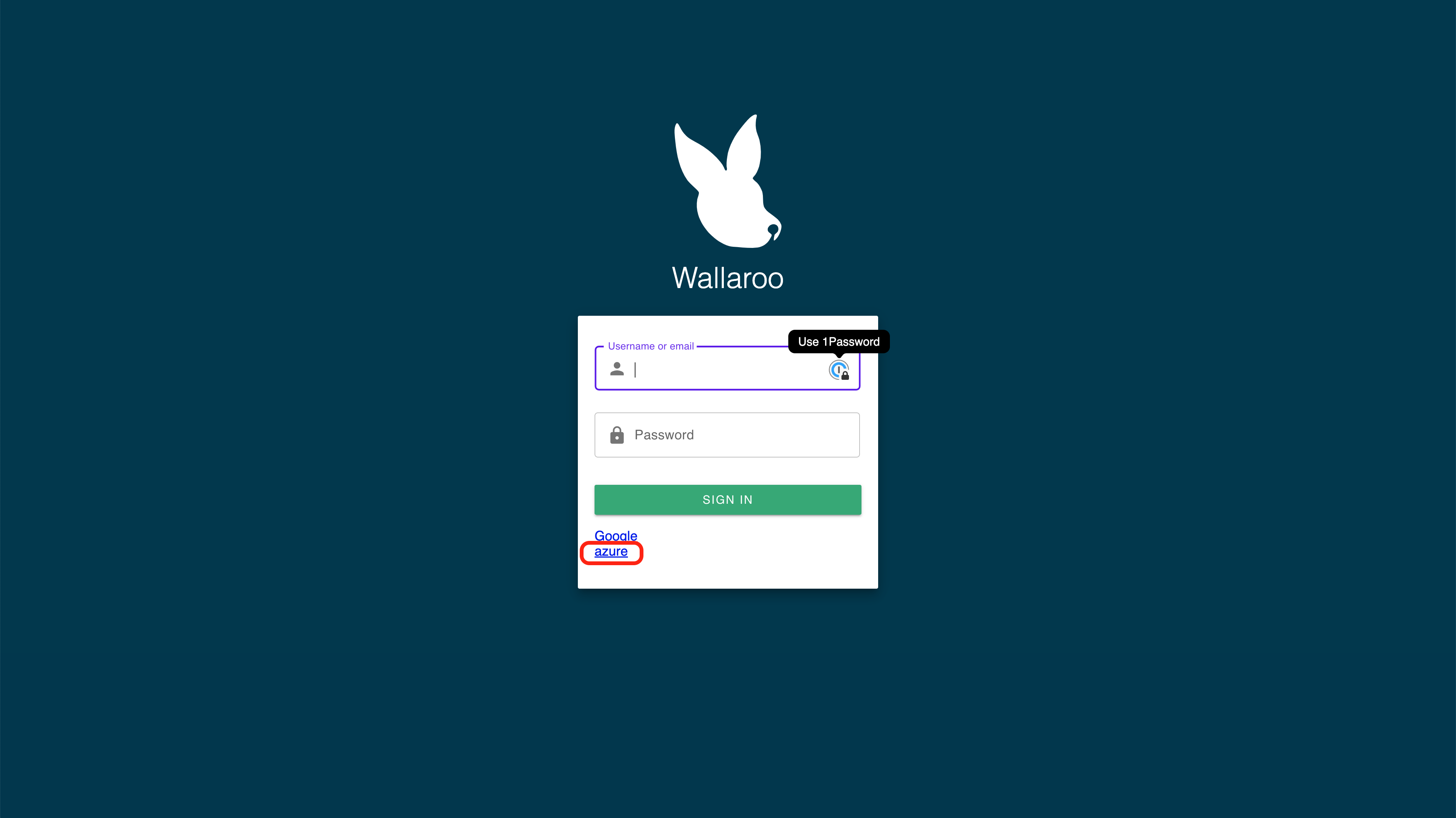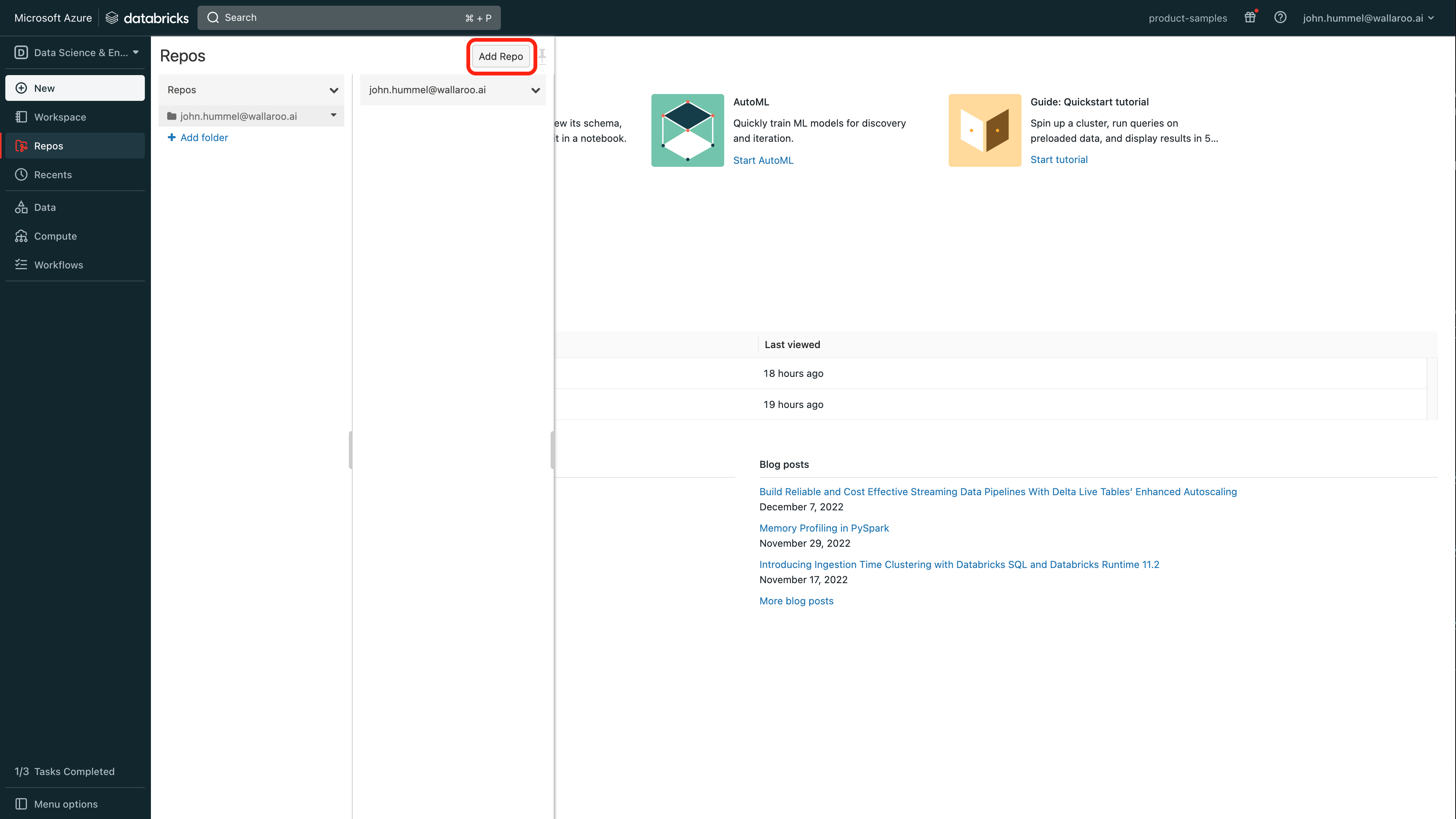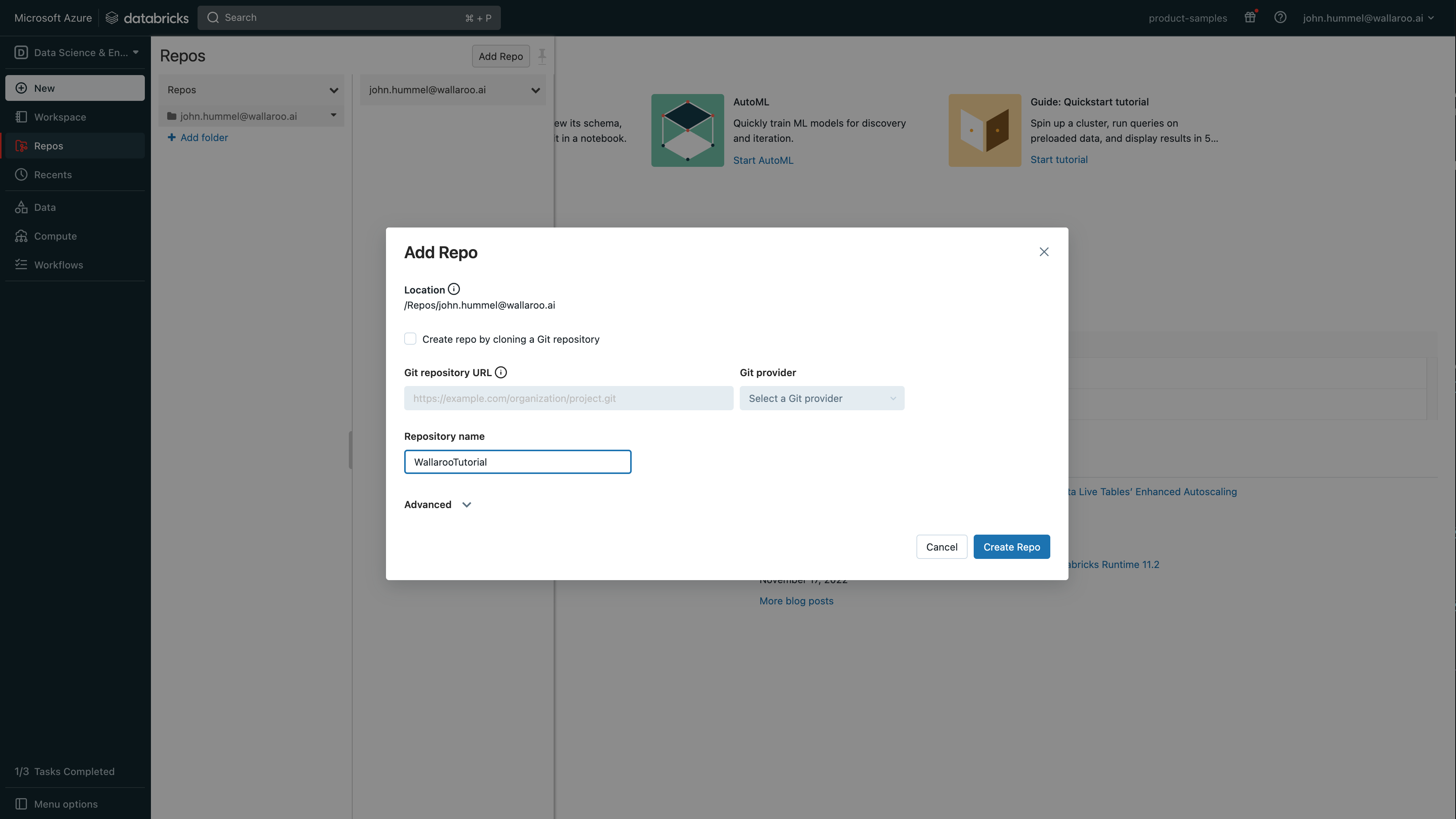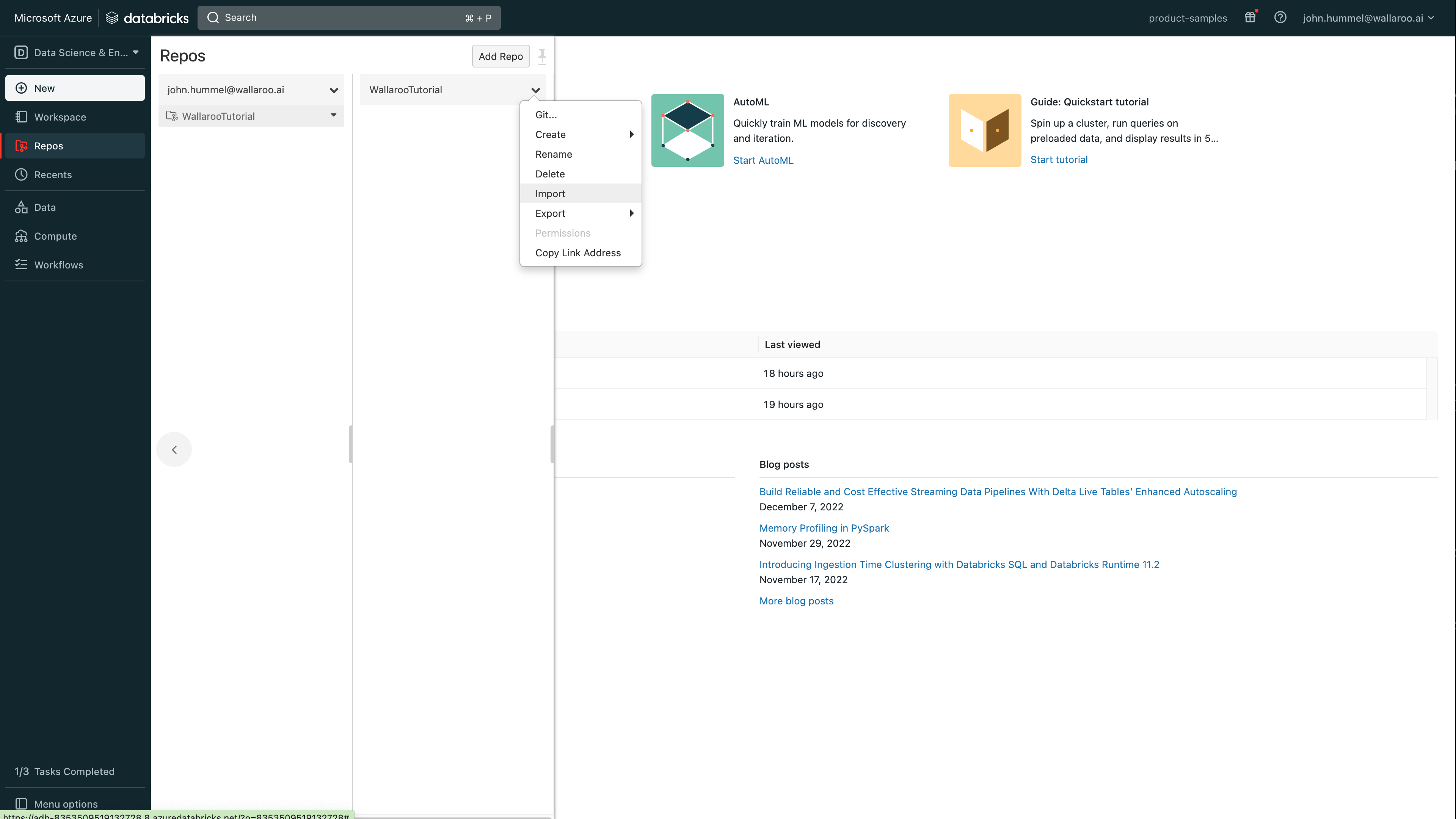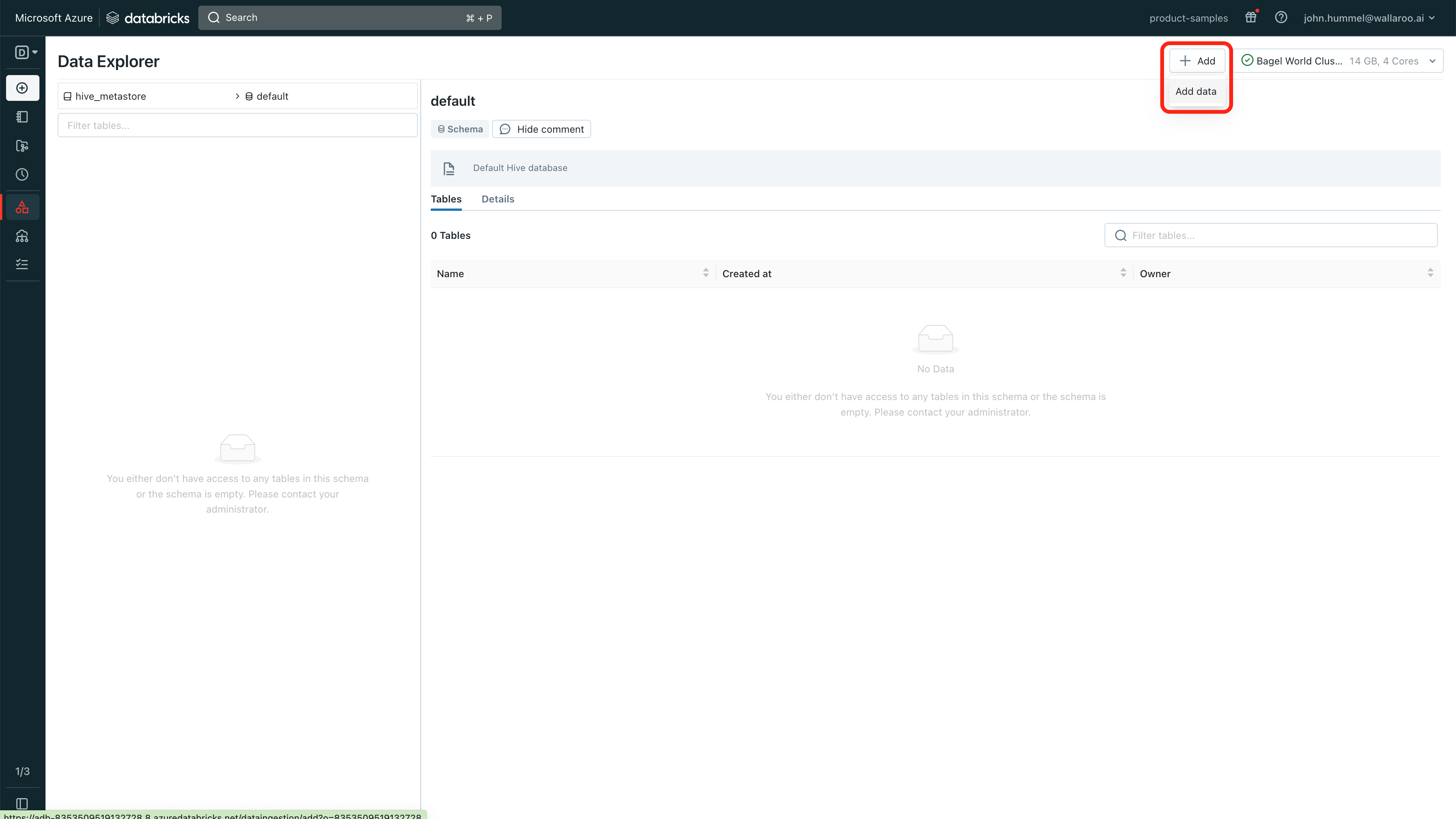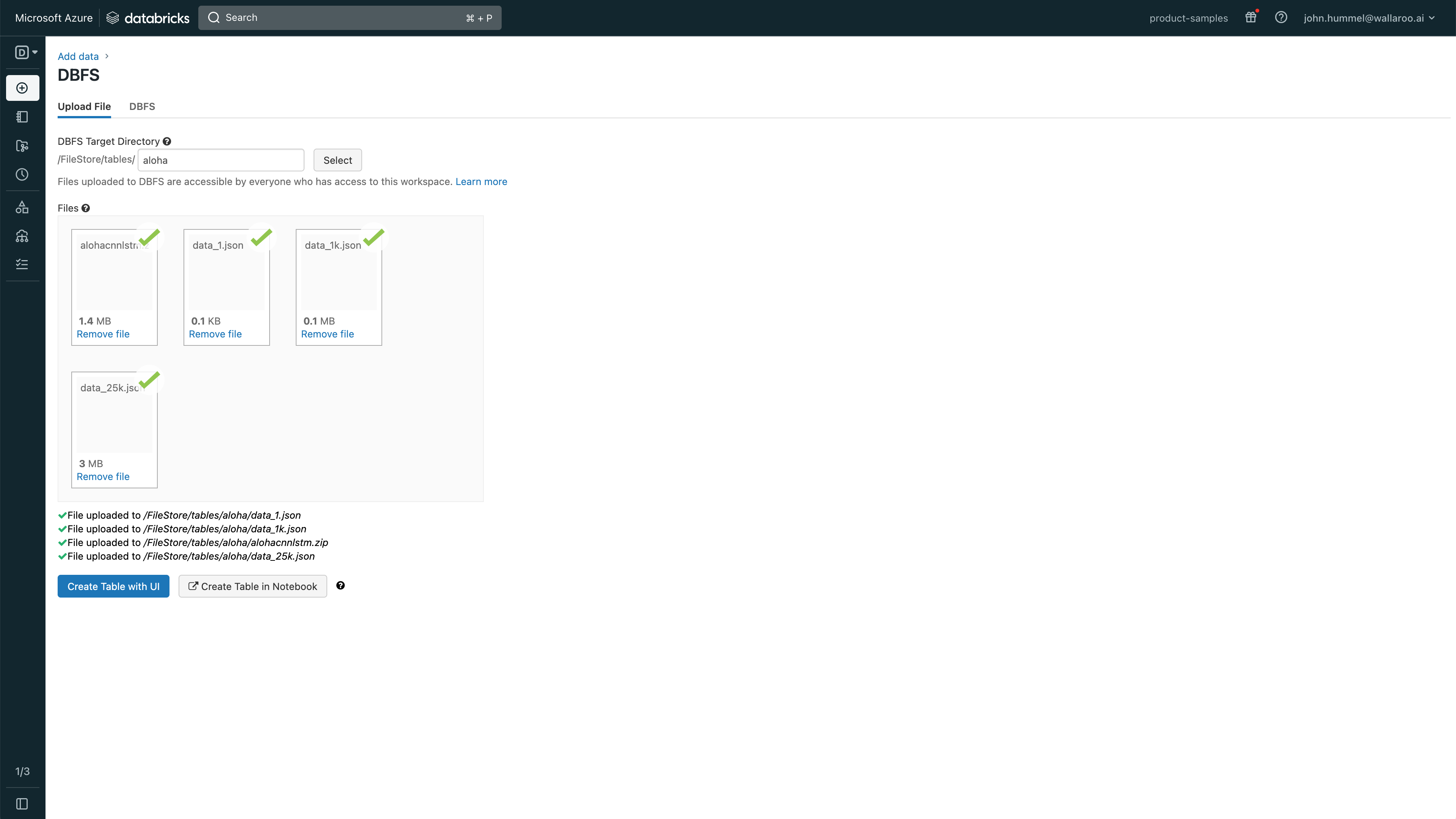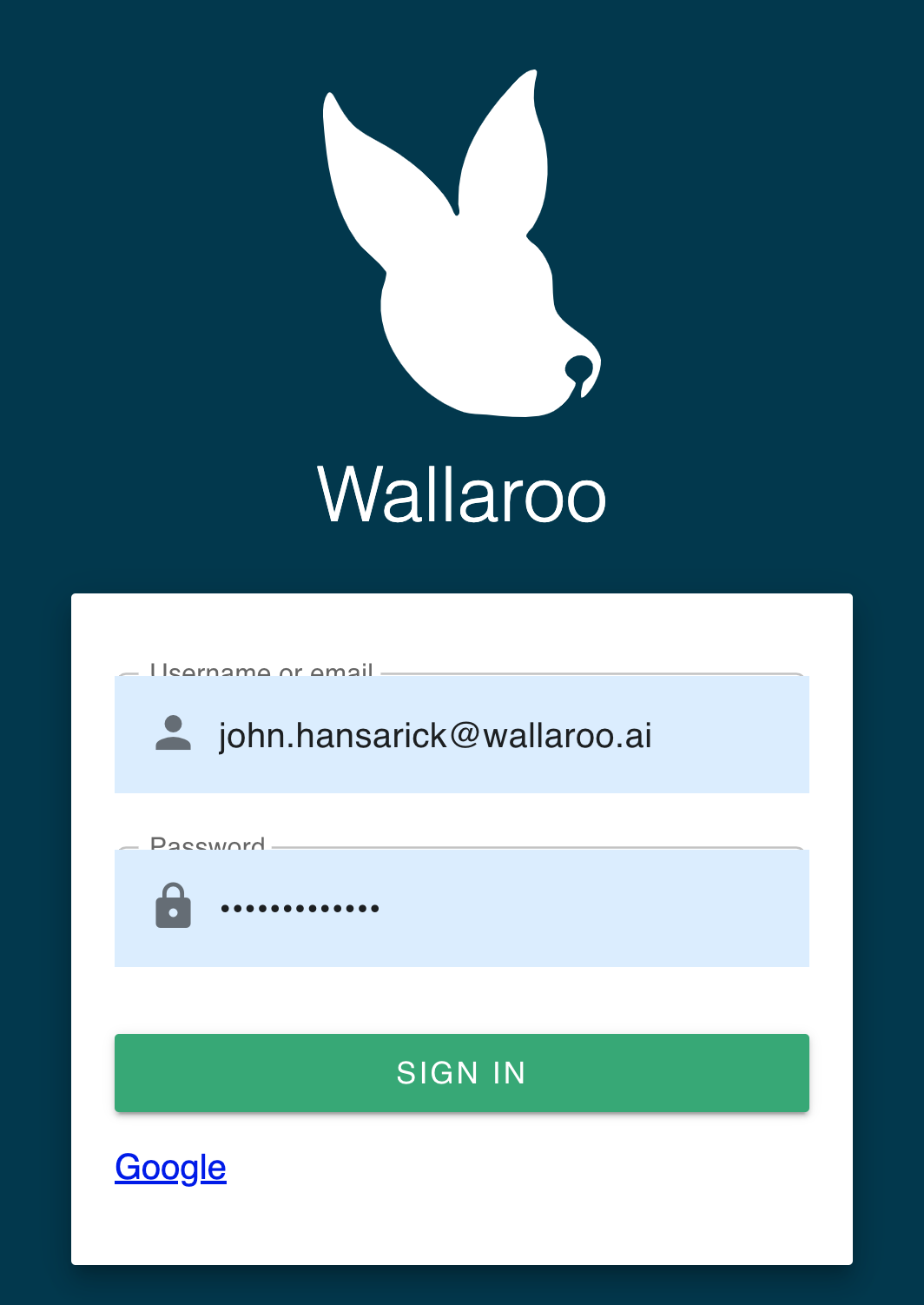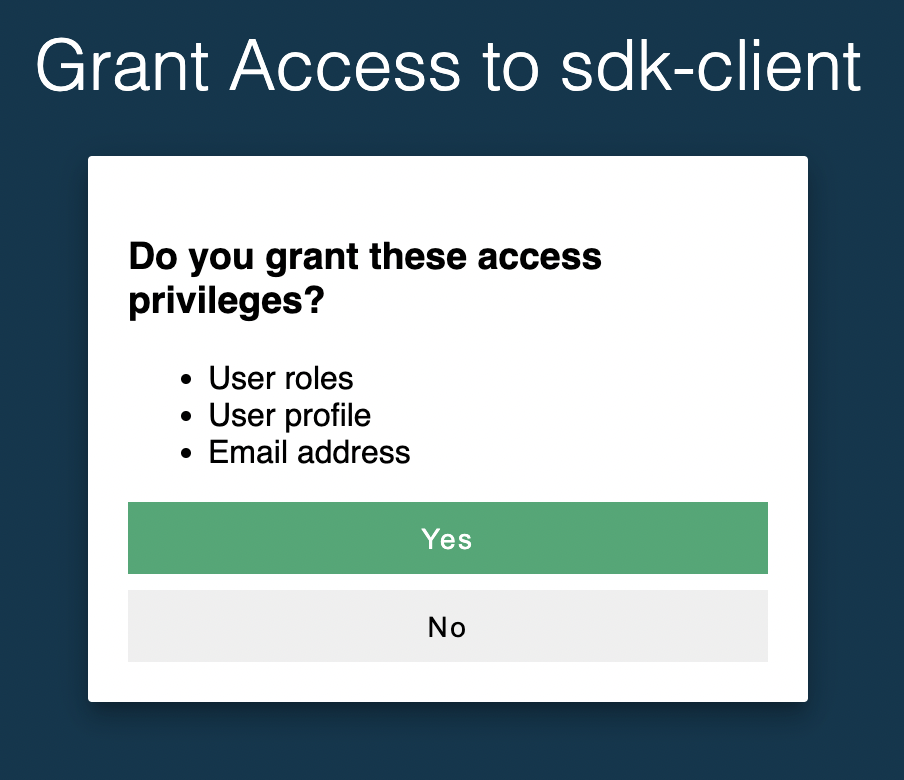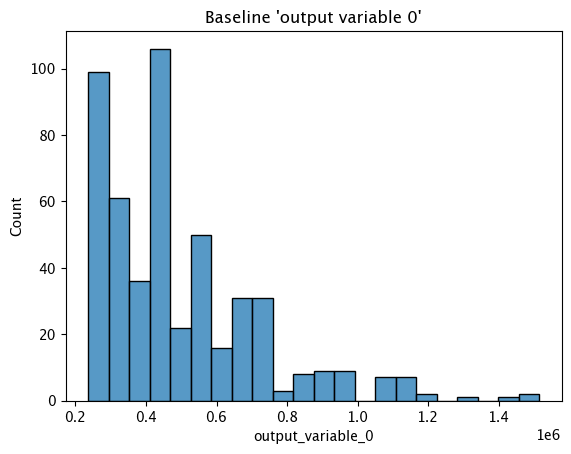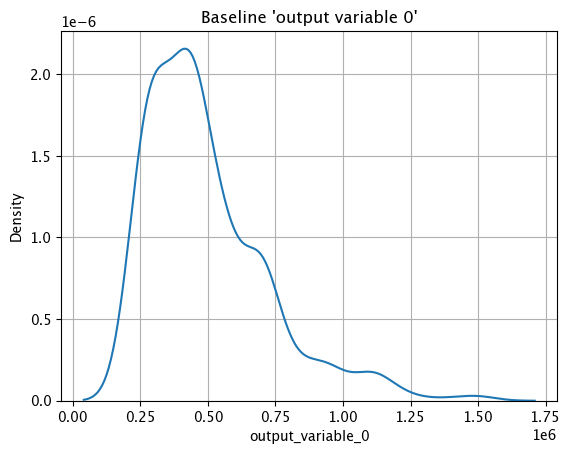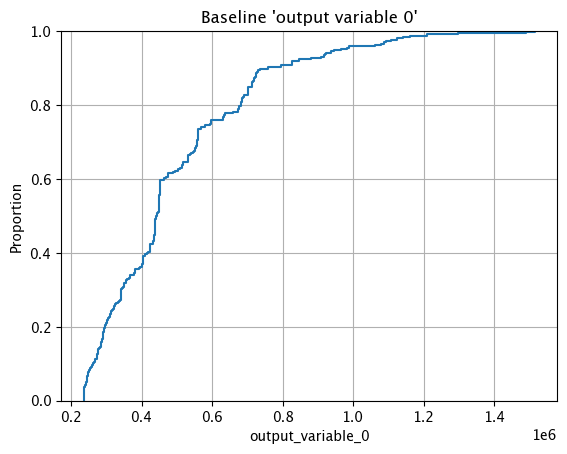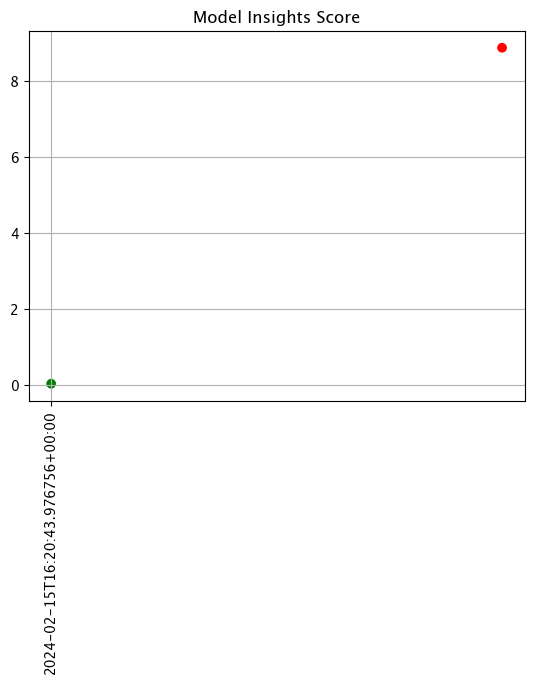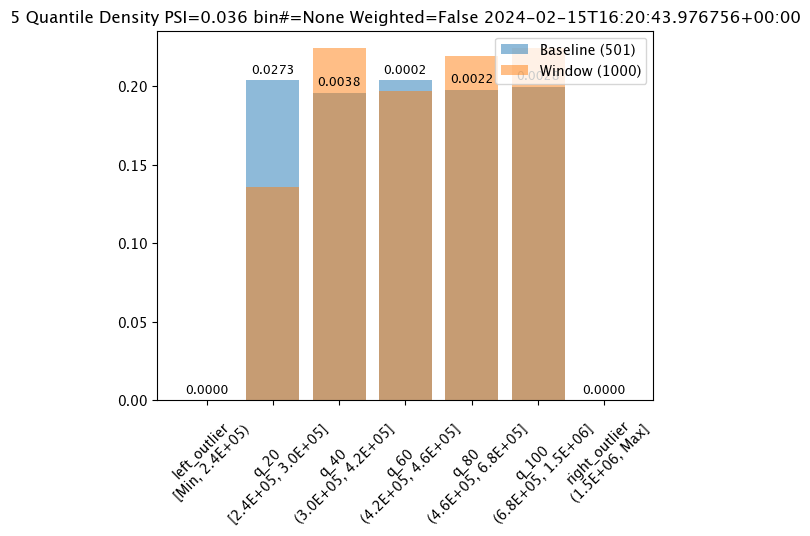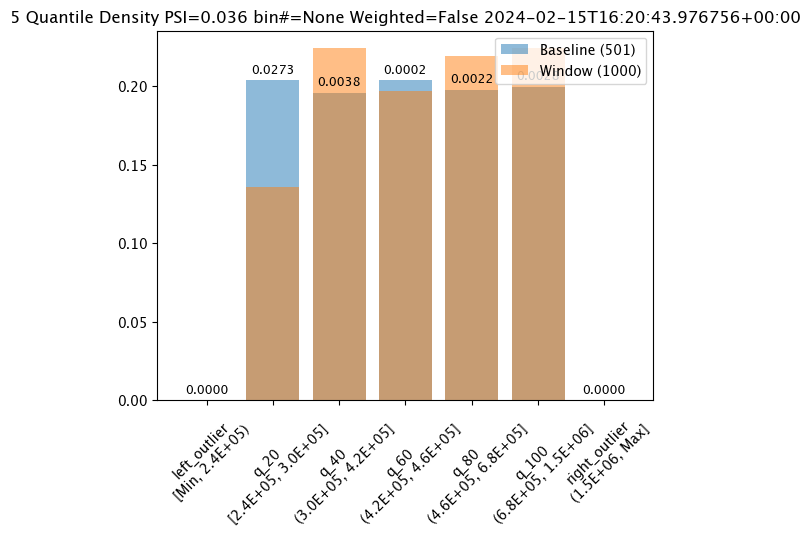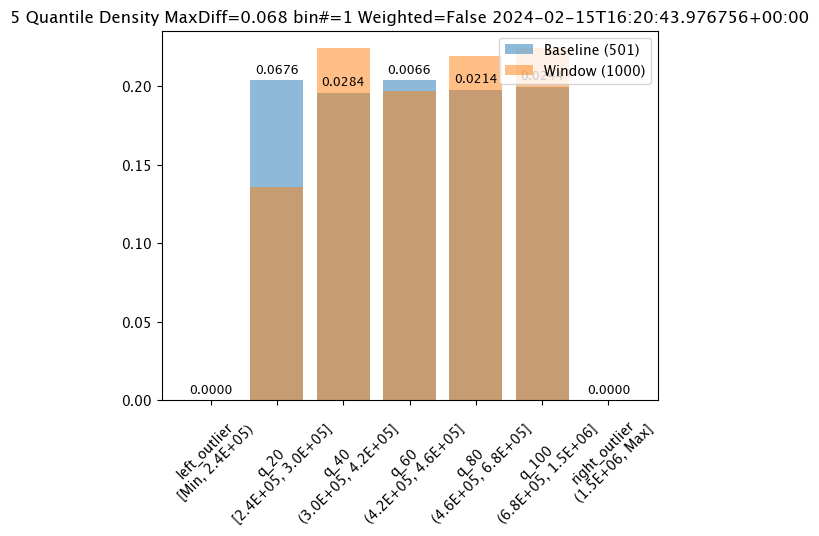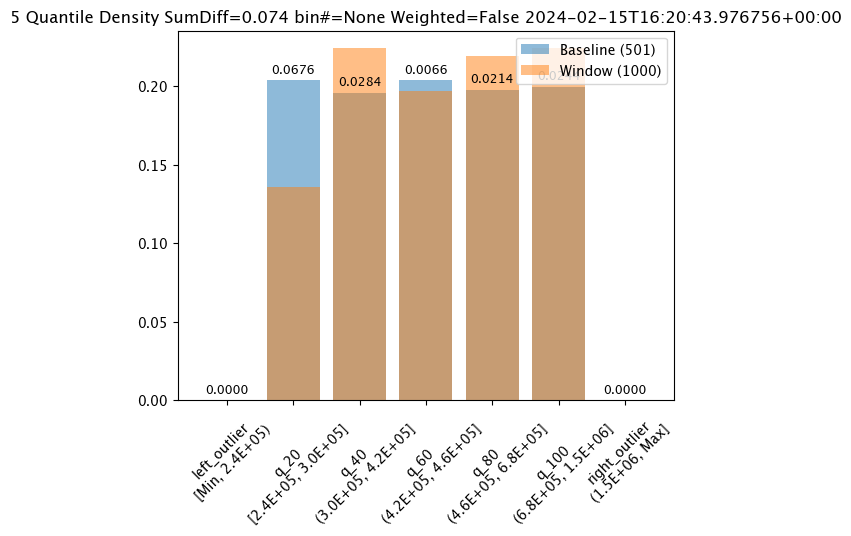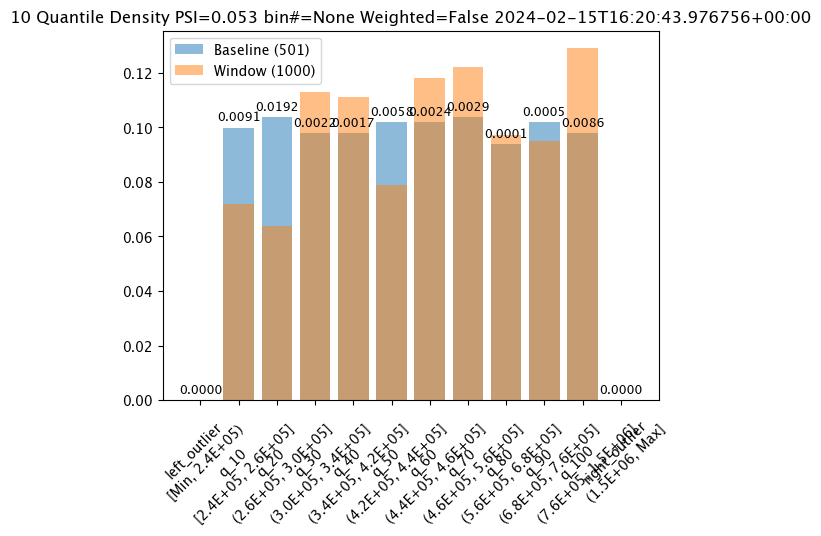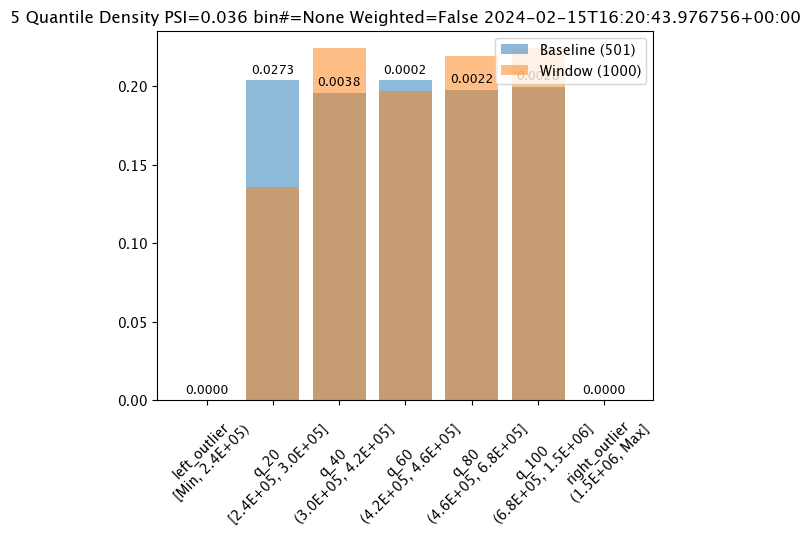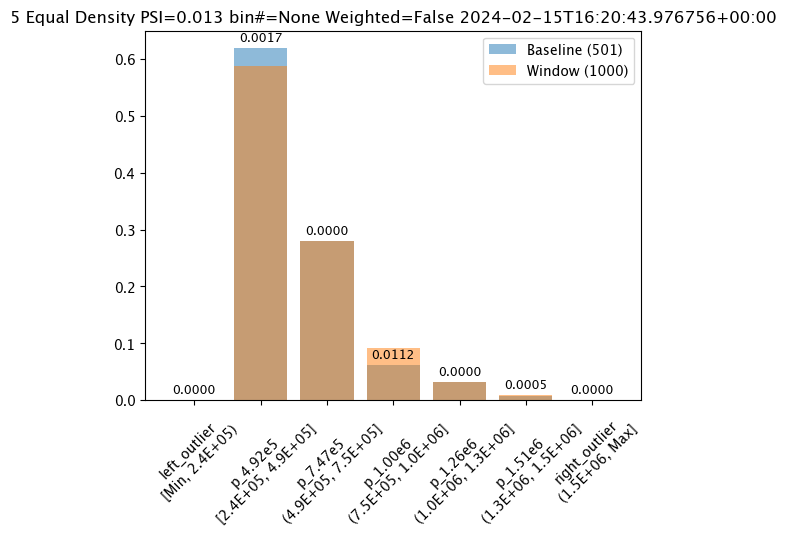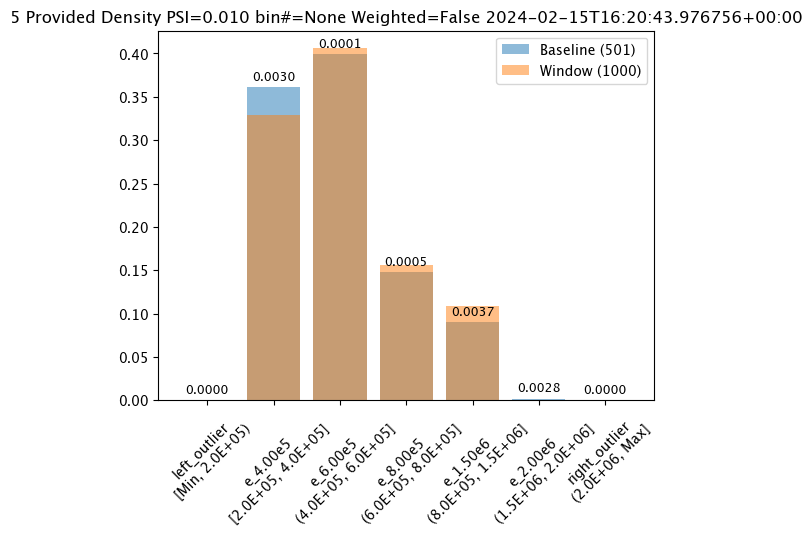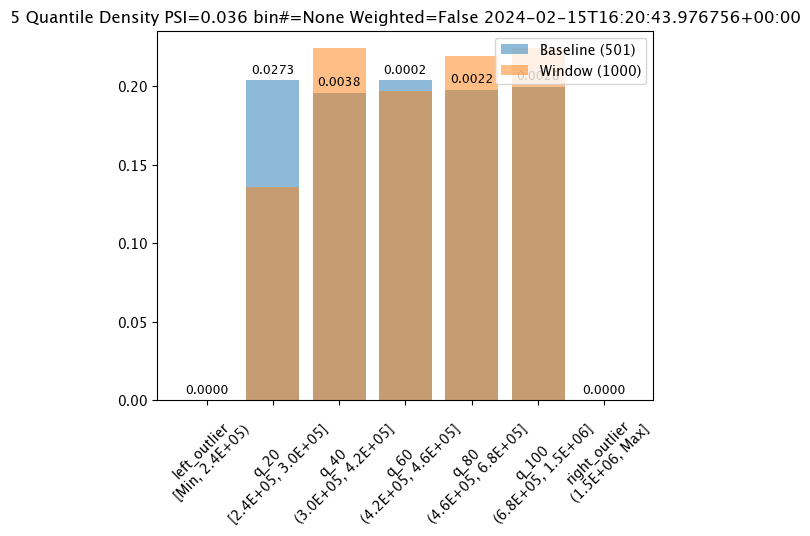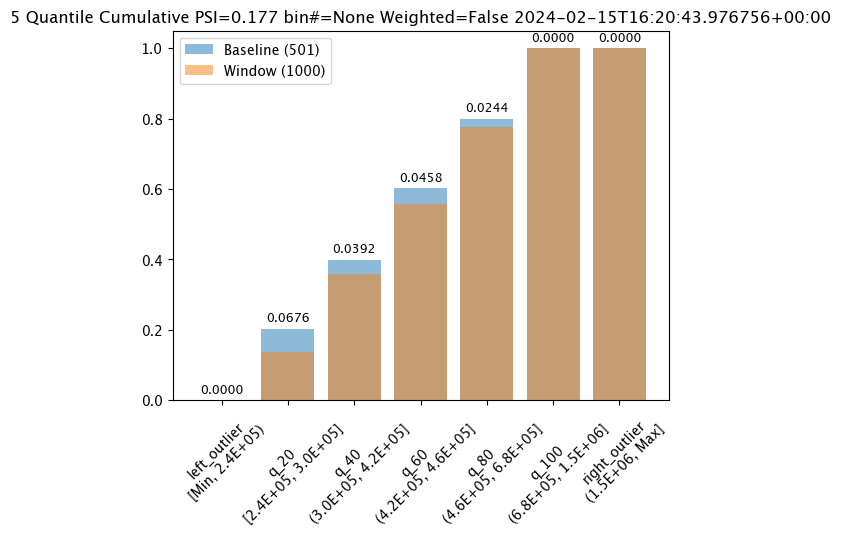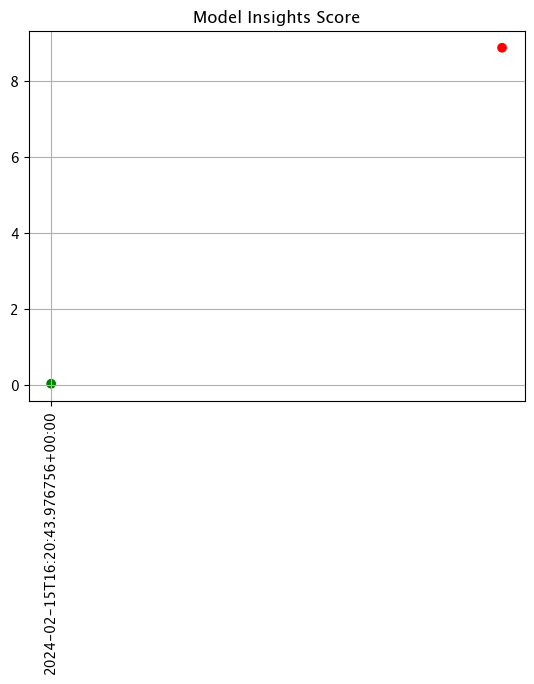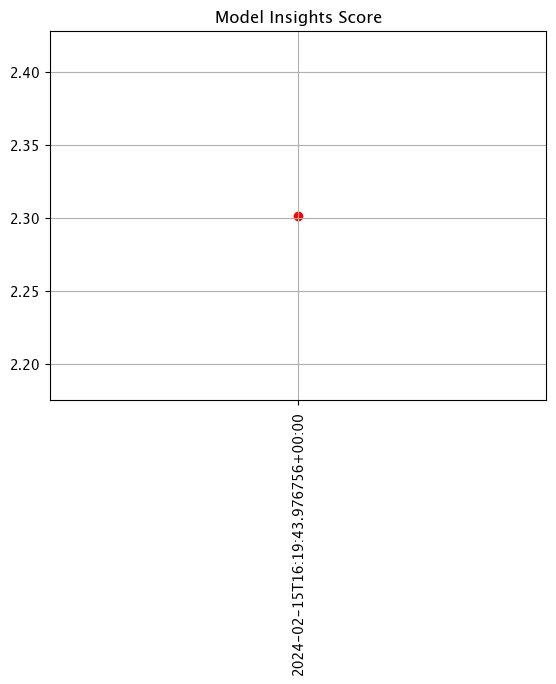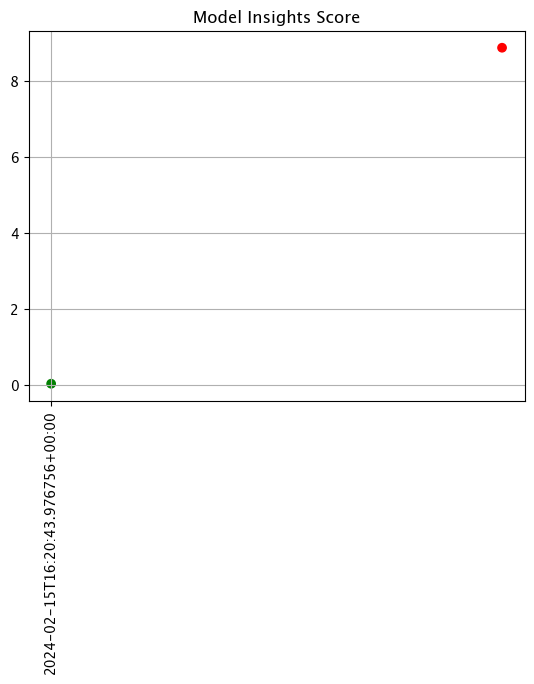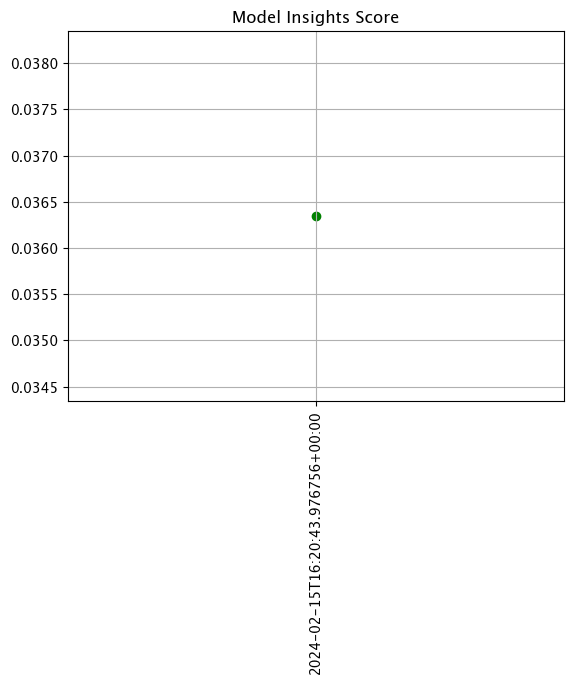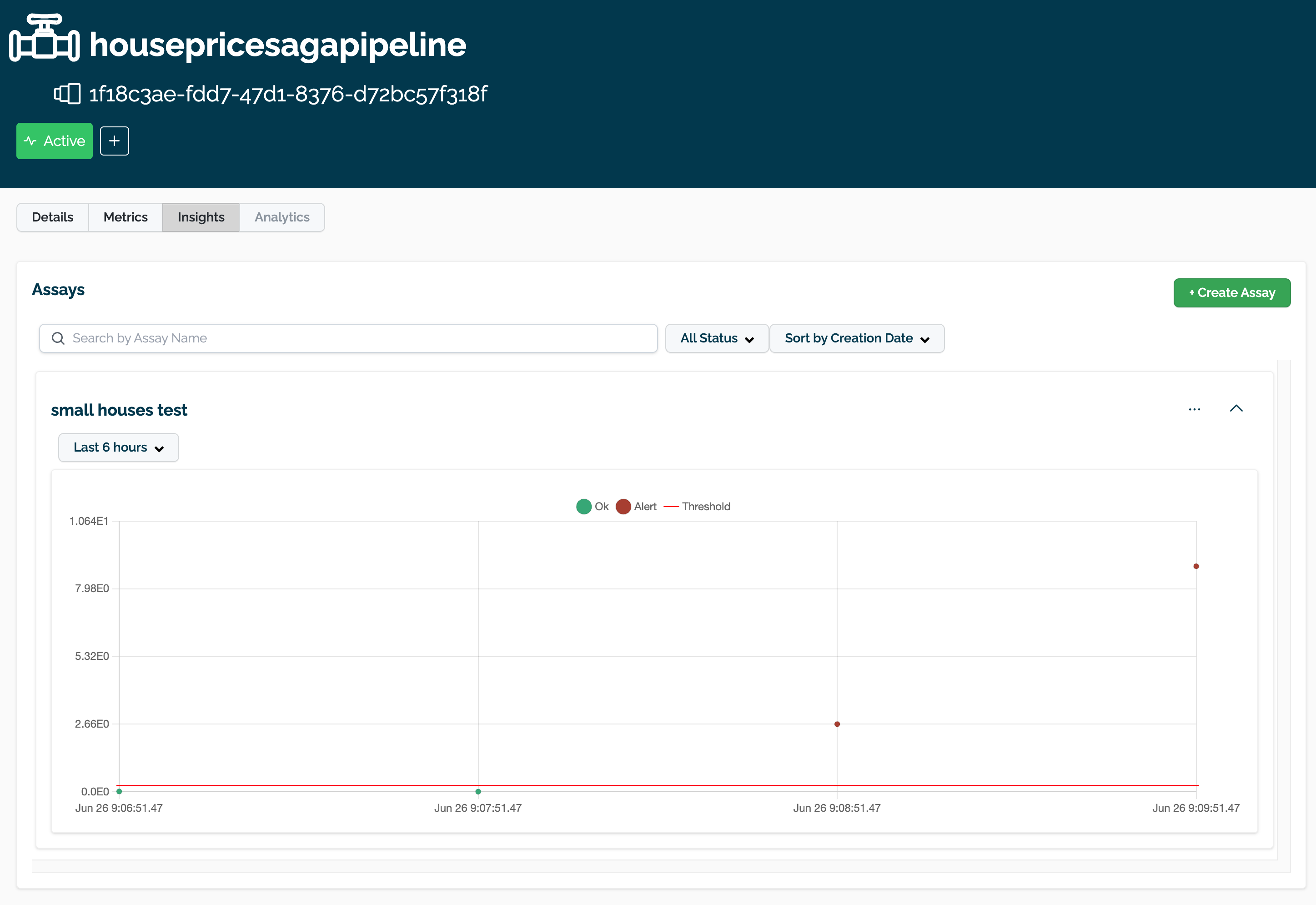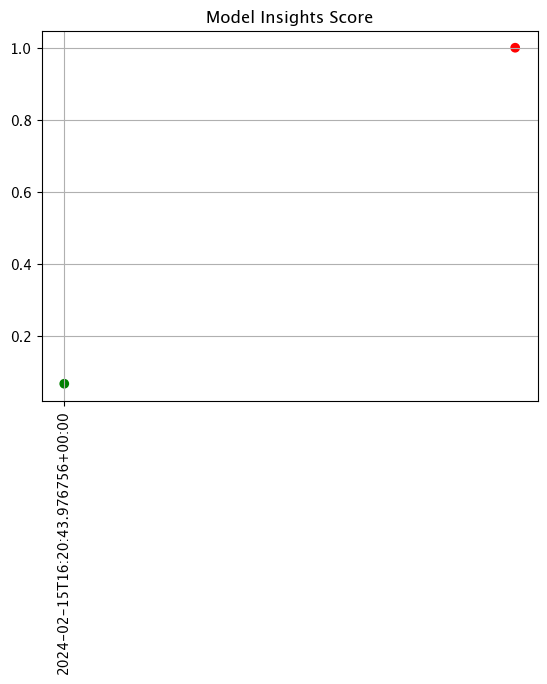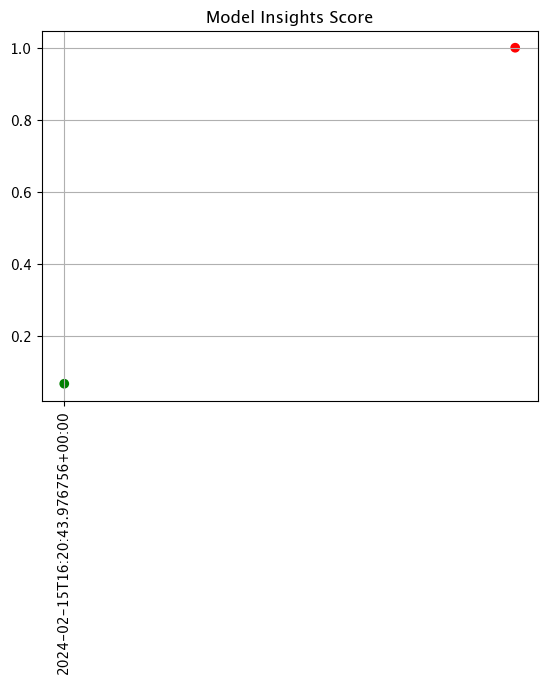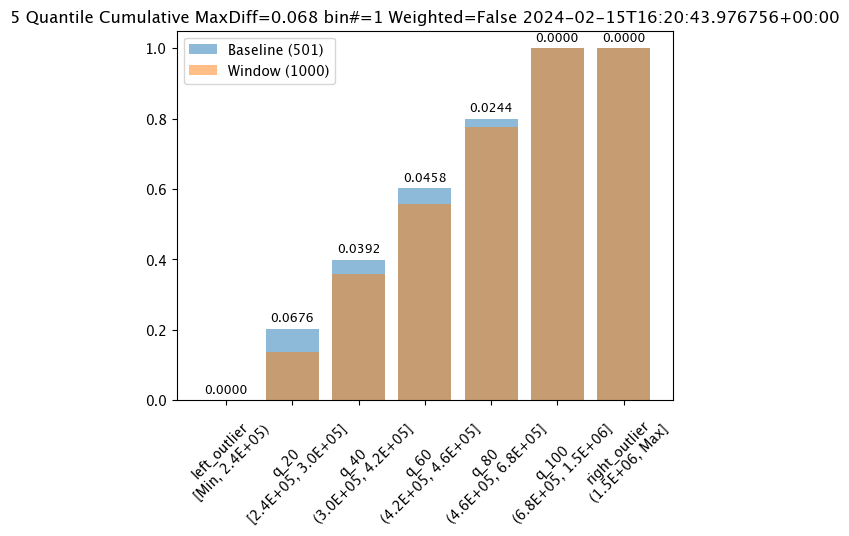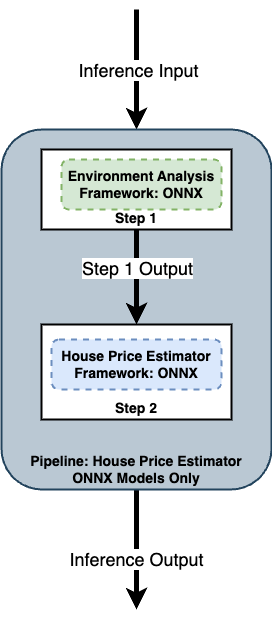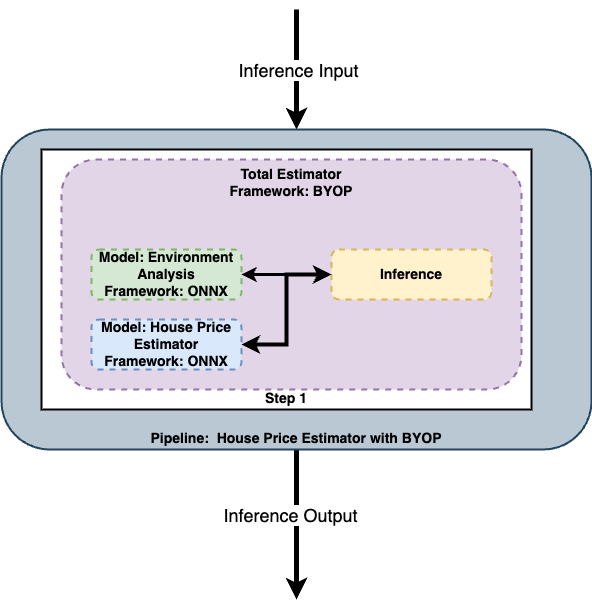1.2.10 - Wallaroo MLOps API Essentials Guide: Assays Management
How to use the Wallaroo API for Assays Management
Enablement Management
Enablement Management allows users to see what Wallaroo features have been activated.
List Enablement Features
Lists the enablement features for the Wallaroo instance.
List Enablement Features Parameters
An empty set {}
List Enablement Features Returns
| Field | Type | Description |
|---|
| features | String | Enabled features. |
| name | String | Name of the Wallaroo instance. |
| is_auth_enabled | Boolean | Whether authentication is enabled. |
# List enablement features
# Retrieve the token
headers = wl.auth.auth_header()
endpoint = f"{wl.api_endpoint}/v1/api/features/list"
data = {
}
response = requests.post(endpoint, json=data, headers=headers, verify=True).json()
response
{'features': {'plateau': 'true'},
'name': 'Wallaroo Dev',
'is_auth_enabled': True}
!curl {wl.api_endpoint}/v1/api/features/list \
-H "Authorization: {wl.auth.auth_header()['Authorization']}" \
-H "Content-Type: application/json" \
--data '{{}}'
{"features":{"plateau":"true"},"name":"Wallaroo Dev","is_auth_enabled":true}
Assays
Create Baseline Summary Statistics
- Endpoint:
/v1/api/assays/summarize
Generate static baseline summary stats for a vector or windowed data. For windows data, this requires that inferences have been performed in the target pipeline. For vector data, a numpy array is used.
Create Baseline Summary Statistics Parameters
| Field | | | Type | Description |
|---|
| baseline | | | Baseline (Required) | The baseline for the assay consisting of the following options. Options are vector and fixed_window. |
| | fixed_window | | (AssayFixConfiguration) (Required) | The fixed configuration for the assay window baseline with the set baseline start and end dates. |
| | | interval | String (Required) | The interval of data to gather for the baseline in the format {Integer} {Unit}, with Unit being minutes, hours, and days. |
| | | model_name | String (Required) | The name of the model to track inference data for the baseline from. |
| | | path | String (Required) | The input/output path in the format `{input |
| | | pipeline_name | String (Required) | The name of the pipeline with the baseline data. |
| | | start | String (Optional) | The DateTime of the baseline start date. |
| | | width | String (Required) | The amount of data from inference results to gather in the format {Integer} {Unit}, with Unit being minutes, hours, and days. |
| | | workspace_id | Integer (Required) | The numerical identifier of the workspace. |
| | | workspace_id | List[String] (Optional) | A list of locations, including edge locations. An empty list [] defaults to the Wallaroo Ops pipeline location. |
| | vector | | List[Float] | A numpy array of values for the baseline. |
| summarizer | | | (AssaySummerizer) (REQUIRED) | The summarizer type for the array aka “advanced settings” in the Wallaroo Dashboard UI. |
| | type | | String (Required) | Type of summarizer. |
| | | bin_mode | String (Required) | The binning model type. Values are: Quantile and Equal |
| | | aggregation | String (Required) | Aggregation type. Values are: Cumulative, Density, and Edges. |
| | | metric | String (Required) | Metric type. Values are: PSI, MaxDiff (Maximum Difference of Bins), and SumDiff (Sum of the Difference of Bins) |
| | | num_bins | *Integer (Required) | The number of bins. Recommended values are between 5 and 14. |
| | | type | String (Required) | Bin type. Values are: UnivariateContinuous |
| | | bin_weights | *List[float] (Optional) | The weights assigned to the assay bins. |
| | | bin_width | List[float] (Optional) | The width assigned to the assay bins. |
| | | provided_edges | List[float] (Optional) | The edges used for the assay bins. |
Create Baseline Summary Statistics Returns
| Field | Type | Description |
|---|
| count | Integer | The number of inference results collected. |
| min | Float | The minimum values from the baseline. |
| max | Float | The maximum values from the baseline. |
| mean | Float | The mean values from the baseline. |
| median | Float | The median values from the baseline. |
| std | Float | The standard deviation score. |
| edges | List[Float] | The defined bin edges. |
| edges | List[String] | The bin names. |
| aggregated_values | List[Float] | The aggregated values of the baseline. |
| aggregation | String | Aggregation type. Values are: Cumulative, Density, and Edges. |
| start | String | The datetime stamp of when the baseline data started. |
| end | String | The datetime stamp of when the baseline data started. |
Create Baseline Summary Statistics Examples
The following example code will:
- Create a workspace for our assay values.
- Upload a model and create a pipeline with the model as a pipeline step.
- Perform sample inference and use the inference results create the baseline summary data.
# create a new workspace
# Retrieve the token
headers = wl.auth.auth_header()
endpoint = f"{wl.api_endpoint}/v1/api/workspaces/create"
data = {
"workspace_name": "test-api-workspace-assays"
}
response = requests.post(endpoint, json=data, headers=headers, verify=True).json()
display(response)
# Stored for future examples
workspace_id = response['workspace_id']
{'workspace_id': 7}
framework='onnx'
example_model_name = f"api-sample-model"
pipeline_name = "api-pipeline-with-models"
# Create pipeline in a workspace with models
# First upload a model
# Retrieve the token
headers = wl.auth.auth_header()
endpoint = f"{wl.api_endpoint}/v1/api/models/upload_and_convert"
metadata = {
"name": example_model_name,
"visibility": "public",
"workspace_id": workspace_id,
"conversion": {
"framework": framework,
"python_version": "3.8",
"requirements": []
}
}
files = {
"metadata": (None, json.dumps(metadata), "application/json"),
'file': (example_model_name, open('./models/ccfraud.onnx', 'rb'), "application/octet-stream")
}
response = requests.post(endpoint, files=files, headers=headers).json()
example_model_id = response['insert_models']['returning'][0]['models'][0]['id']
# Second, get the model version
# Retrieve the token
headers = wl.auth.auth_header()
endpoint = f"{wl.api_endpoint}/v1/api/models/list_versions"
data = {
"model_id": example_model_name,
"models_pk_id": example_model_id
}
response = requests.post(endpoint, json=data, headers=headers, verify=True).json()
example_model_sha = response[-1]['sha']
example_model_version = response[-1]['model_version']
# Now create the pipeline with the new model
# Retrieve the token
headers = wl.auth.auth_header()
endpoint = f"{wl.api_endpoint}/v1/api/pipelines/create"
data = {
"pipeline_id": pipeline_name,
"workspace_id": workspace_id,
"definition": {
'steps': [
{
'ModelInference':
{
'models':
[
{
'name': example_model_name,
'version': example_model_version,
'sha': example_model_sha
}
]
}
}
]
}
}
response = requests.post(endpoint,
json=data,
headers=headers,
verify=True).json()
display(json.dumps(response))
# saved for later steps
model_pipeline_id = response['pipeline_pk_id']
model_pipeline_variant_id=response['pipeline_variant_pk_id']
model_pipeline_variant_version=['pipeline_variant_version']
'{"pipeline_pk_id": 6, "pipeline_variant_pk_id": 6, "pipeline_variant_version": "2f4bf3ac-48bb-4798-b59a-81de844248d1"}'
# deploy that pipeline
# Deploy a pipeline with models
# Retrieve the token
headers = wl.auth.auth_header()
endpoint = f"{wl.api_endpoint}/v1/api/pipelines/deploy"
# verify this matches the pipeline with model created earlier
pipeline_with_models_id = "api-pipeline-with-models"
data = {
"deploy_id": pipeline_with_models_id,
"pipeline_version_pk_id": model_pipeline_variant_id,
"models": [
{
"name": example_model_name,
"version":example_model_version,
"sha":example_model_sha
}
],
"pipeline_id": model_pipeline_id
}
response = requests.post(endpoint, json=data, headers=headers, verify=True).json()
display(response)
model_deployment_id=response['id']
{'id': 3}
# get the inference url
## Retrieve the pipeline's External Inference URL
# Retrieve the token
headers = wl.auth.auth_header()
endpoint = f"{wl.api_endpoint}/v1/api/admin/get_pipeline_external_url"
data = {
"workspace_id": workspace_id,
"pipeline_name": pipeline_with_models_id
}
response = requests.post(endpoint, json=data, headers=headers, verify=True).json()
print(response)
deployurl = response['url']
{'url': 'https://doc-test.api.wallarooexample.ai/v1/api/pipelines/infer/api-pipeline-with-models-3/api-pipeline-with-models'}
# check the deployment status - must be 'Running'
# Retrieve the token
headers = wl.auth.auth_header()
# Get model pipeline deployment
status = ""
while status != 'Running':
time.sleep(15)
endpoint = f"{wl.api_endpoint}/v1/api/status/get_deployment"
data = {
"name": f"{pipeline_with_models_id}-{model_deployment_id}"
}
response = requests.post(endpoint, json=data, headers=headers, verify=True).json()
status = response['status']
print(status)
Running
# sample inference
assay_start = datetime.datetime.now(datetime.timezone.utc)
# Retrieve the token
headers = wl.auth.auth_header()
# set Content-Type type
headers['Content-Type']='application/json; format=pandas-records'
## Inference through external URL using dataframe
# retrieve the json data to submit
data = pd.read_json('./data/cc_data_api_1k.df.json')
response = (requests.post(
deployurl,
data=data.to_json(orient="records"),
headers=headers)
.json())
df = pd.DataFrame.from_records(response)
display(df.head(5))
# sleep for 10 seconds to accommodate any time difference
time.sleep(10)
assay_end = datetime.datetime.now(datetime.timezone.utc)
| time | in | out | check_failures | metadata |
|---|
| 0 | 1704827280654 | {'dense_input': [-1.0603297501, 2.3544967095, ... | {'dense_1': [0.99300325]} | [] | {'last_model': '{"model_name":"api-sample-mode... |
|---|
| 1 | 1704827280654 | {'dense_input': [-1.0603297501, 2.3544967095, ... | {'dense_1': [0.99300325]} | [] | {'last_model': '{"model_name":"api-sample-mode... |
|---|
| 2 | 1704827280654 | {'dense_input': [-1.0603297501, 2.3544967095, ... | {'dense_1': [0.99300325]} | [] | {'last_model': '{"model_name":"api-sample-mode... |
|---|
| 3 | 1704827280654 | {'dense_input': [-1.0603297501, 2.3544967095, ... | {'dense_1': [0.99300325]} | [] | {'last_model': '{"model_name":"api-sample-mode... |
|---|
| 4 | 1704827280654 | {'dense_input': [0.5817662108, 0.097881551, 0.... | {'dense_1': [0.0010916889]} | [] | {'last_model': '{"model_name":"api-sample-mode... |
|---|
Create the summary via Requests.
## create the summary via requests
# Retrieve the token
headers = wl.auth.auth_header()
endpoint = f"{wl.api_endpoint}/v1/api/assays/summarize"
data = {
"summarizer": {
"type": "UnivariateContinuous",
"bin_mode": "Quantile",
"aggregation": "Density",
"metric": "PSI",
"num_bins": 5,
"bin_weights": None,
"bin_width": None,
"provided_edges": None
},
"baseline": {
"fixed_window": {
"interval": "24 hours",
"model_name": example_model_name,
"path": "output dense_1 0",
"pipeline_name": pipeline_name,
"start": assay_start.isoformat(),
"width": "24 hours",
"workspace_id": workspace_id,
"locations": []
}
}
}
# print(data)
response = requests.post(endpoint, json=data, headers=headers, verify=True)
baseline_summary = response.json()
display(baseline_summary)
{'count': 1001,
'min': 1.519918441772461e-06,
'max': 1.0,
'mean': 0.0065982516233499475,
'median': 0.0005419552326202393,
'std': 0.07661715908141875,
'edges': [1.519918441772461e-06,
0.00026360154151916504,
0.0004509389400482178,
0.0006800591945648193,
0.000969529151916504,
1.0,
None],
'edge_names': ['left_outlier',
'q_20',
'q_40',
'q_60',
'q_80',
'q_100',
'right_outlier'],
'aggregated_values': [0.0,
0.1998001998001998,
0.1998001998001998,
0.2007992007992008,
0.1998001998001998,
0.1998001998001998,
0.0],
'aggregation': 'Density',
'start': '2024-01-09T19:07:59.566516Z',
'end': '2024-01-10T19:07:59.566516Z'}
Create Assay
- Endpoint:
/v1/api/assays/create
Create a new array in a specified pipeline. Assays required at least one inference request is completed.
Create Assay Parameters
| Field | | | Type | Description |
|---|
| id | | | Integer (Optional) | The numerical identifier for the assay. |
| name | | | String (Required) | The name of the assay. |
| pipeline_id | | | String (Required) | The numerical identifier the assay will be placed into. |
| pipeline_name | | | String (Required) | The name of the pipeline |
| active | | | Boolean (Required) | Indicates whether the assay will be active upon creation or not. |
| status | | | String (Required) | The status of the assay upon creation. Options are: active: the Assay is created and active. created: The assay is created but inactive. |
| iopath | | | String (Required) | The iopath of the assay in the format `“input |
| baseline | | | Baseline (Required) | The baseline for the assay consisting of the following options. Options are fixed, calculated and static. |
| | fixed | | (AssayFixConfiguration) (Required) | The fixed configuration for the assay with the set baseline start and end dates. |
| | | pipeline | String (Required) | The name of the pipeline with the baseline data. |
| | | model | String (Required) | The name of the model used. |
| | | start_at | String (Required) | The DateTime of the baseline start date. |
| | | end_at | String (Required) | The DateTime of the baseline end date. |
| | calculated | | (AssaysCreateJsonBodyBaselineType0CalculatedType0) (Required) | The calculated baseline submitted with numpy arrays. Declared with calculated. This includes the following fields. |
| | | vector | (List[float]) (Required) | The numpy array of baseline values. |
| | static | | AssaysCreateJsonBodyBaselineType1Static (Required) | The static baseline. These values are generated from the fixed and calculated baseline methods listed above, and can be used to achieve more granularity in the assay baseline creation. |
| | | count | Integer (Required) | The number values used. |
| | | min | Float (Required) | The minimum value of baseline values. |
| | | max | Float (Required) | The maximum value of baseline values. |
| | | mean | Float (Required) | The mean of the of baseline values. |
| | | std | Float (Required) | The standard deviation of baseline values. |
| | | edges | List[Float] (Required) | The edges defined from the baseline values or manually defined. |
| | | aggregated_values | List[Float] (Required) | The aggregated values of each edge. |
| | | aggregation | String (Required) | The type of baseline aggregation. Values are: Cumulative, Density, and Edges. |
| | | start | String (Optional) | The DateTime of the baseline inference start date. |
| | | end | String (Optional) The DateTime of the baseline inference end date. | |
| window | | | AssayWindow (Required) | Assay window. |
| | pipeline | | String (Required) | The name of the pipeline for the assay window. |
| | model | | String (Required) | The name of the model used for the assay window. |
| | width | | String (Required) | The width of the assay window. |
| | start | | String (Required) | The DateTime of when to start the assay window. |
| | interval | | String (Required) | The assay window interval. |
| | locations | | List[String] (Required) | The locations included in the assay. If set to an empty set [] the Wallaroo Ops pipeline will be the only location used. |
| summarizer | | | (AssaySummerizer) (REQUIRED) | The summarizer type for the array aka “advanced settings” in the Wallaroo Dashboard UI. |
| | type | | String (Required) | Type of summarizer. |
| | | bin_mode | String (Required) | The binning model type. Values are: Quantile and Equal |
| | | aggregation | String (Required) | Aggregation type. Values are: Cumulative, Density, and Edges. |
| | | metric | String (Required) | Metric type. Values are: PSI, MaxDiff (Maximum Difference of Bins), and SumDiff (Sum of the Difference of Bins) |
| | | num_bins | *Integer (Required) | The number of bins. Recommended values are between 5 and 14. |
| | | type | String (Required) | Bin type. Values are: UnivariateContinuous |
| | | bin_weights | *List[float] (Optional) | The weights assigned to the assay bins. |
| | | bin_width | List[float] (Optional) | The width assigned to the assay bins. |
| | | provided_edges | List[float] (Optional) | The edges used for the assay bins. |
| | | add_outlier_edges | Boolean (Required) | Indicates whether to add outlier edges or not. |
| warning_threshold | | | Float (Required) | Optional warning threshold. |
| alert_threshold | | | Float (Required) | Alert threshold. |
| run_until | | | String (OPTIONAL) | DateTime of when to end the assay. |
| workspace_id | | | Integer (Required) | The workspace the assay is part of. |
| model_insights_url | | | String (OPTIONAL) | URL for model insights. |
Create Assay Returns
| Field | Type | Description |
|---|
| assay_id | Integer | The id of the new assay. |
Create Assay Examples
The following example code will:
- Create an assay from the endpoint
/v1/api/assays/create with baseline generated from Create Baseline Summary Statistics.- For our example, we will be using the output of the field
dense_2 at the index 0 for the iopath.
- The assay id is stored for later examples.
Create assay via Requests.
import datetime
assay_window_end = datetime.datetime.now(datetime.timezone.utc)
## Create assay
# Retrieve the token
headers = wl.auth.auth_header()
endpoint = f"{wl.api_endpoint}/v1/api/assays/create"
# generate random values so the assay is always unique
import string
import random
# # make a random 4 character suffix to prevent overwriting other user's workspaces
suffix= ''.join(random.choice(string.ascii_lowercase) for i in range(4))
exampleAssayName = f"api assay example {suffix}"
# display(exampleAssayName)
data = {
"name": exampleAssayName,
"pipeline_id": model_pipeline_id,
"pipeline_name": pipeline_name,
"active": True,
"status": "created",
"baseline": {
"static": baseline_summary
},
"window": {
"pipeline_name": pipeline_name,
"model_name": example_model_name,
"width": "1 minute",
"start": assay_start.isoformat(),
"interval": "1 minute",
"path": "output dense_1 0",
"workspace_id": workspace_id,
"locations": []
},
"summarizer": {
"type": "UnivariateContinuous",
"bin_mode": "Quantile",
"aggregation": "Density",
"metric": "PSI",
"num_bins": 5,
"bin_weights": None,
"bin_width": None,
"provided_edges": None,
"add_outlier_edges": None
},
"warning_threshold": None,
"alert_threshold": 0.25,
"run_until": assay_window_end.isoformat(),
"workspace_id": workspace_id
}
print(data)
response = requests.post(endpoint, json=data, headers=headers, verify=True).json()
assay_id = response['assay_id']
response
{'name': 'api assay example fjii', 'pipeline_id': 6, 'pipeline_name': 'api-pipeline-with-models', 'active': True, 'status': 'created', 'baseline': {'static': {'count': 1001, 'min': 1.519918441772461e-06, 'max': 1.0, 'mean': 0.0065982516233499475, 'median': 0.0005419552326202393, 'std': 0.07661715908141875, 'edges': [1.519918441772461e-06, 0.00026360154151916504, 0.0004509389400482178, 0.0006800591945648193, 0.000969529151916504, 1.0, None], 'edge_names': ['left_outlier', 'q_20', 'q_40', 'q_60', 'q_80', 'q_100', 'right_outlier'], 'aggregated_values': [0.0, 0.1998001998001998, 0.1998001998001998, 0.2007992007992008, 0.1998001998001998, 0.1998001998001998, 0.0], 'aggregation': 'Density', 'start': '2024-01-09T19:07:59.566516Z', 'end': '2024-01-10T19:07:59.566516Z'}}, 'window': {'pipeline_name': 'api-pipeline-with-models', 'model_name': 'api-sample-model', 'width': '1 minute', 'start': '2024-01-09T19:07:59.566516+00:00', 'interval': '1 minute', 'path': 'output dense_1 0', 'workspace_id': 7, 'locations': []}, 'summarizer': {'type': 'UnivariateContinuous', 'bin_mode': 'Quantile', 'aggregation': 'Density', 'metric': 'PSI', 'num_bins': 5, 'bin_weights': None, 'bin_width': None, 'provided_edges': None, 'add_outlier_edges': None}, 'warning_threshold': None, 'alert_threshold': 0.25, 'run_until': '2024-01-09T19:09:34.063643+00:00', 'workspace_id': 7}
{‘assay_id’: 9}
Create assay via curl.
exampleAssayName = f"api assay curl examples {suffix}"
data = {
"name": exampleAssayName,
"pipeline_id": model_pipeline_id,
"pipeline_name": pipeline_name,
"active": True,
"status": "created",
"baseline": {
"static": baseline_summary
},
"window": {
"pipeline_name": pipeline_name,
"model_name": example_model_name,
"width": "24 hours",
"start": assay_start.isoformat(),
"interval": "24 hours",
"path": "output dense_1 0",
"workspace_id": workspace_id,
"locations": []
},
"summarizer": {
"type": "UnivariateContinuous",
"bin_mode": "Quantile",
"aggregation": "Density",
"metric": "PSI",
"num_bins": 5,
"bin_weights": None,
"bin_width": None,
"provided_edges": None,
"add_outlier_edges": None
},
"warning_threshold": None,
"alert_threshold": 0.25,
"run_until": assay_window_end.isoformat(),
"workspace_id": workspace_id
}
!curl {wl.api_endpoint}/v1/api/assays/create \
-H "Authorization: {wl.auth.auth_header()['Authorization']}" \
-H "Content-Type: application/json" \
--data '{json.dumps(data)}'
{"assay_id":10}
List Assays
- Endpoint:
/v1/api/assays/list
Lists all assays in the specified pipeline.
List Assays Parameters
| Field | Type | Description |
|---|
| pipeline_id | Integer (Required) | The numerical ID of the pipeline. |
List Assays Returns
A list of assays with the following fields.
| Field | | | Type | Description |
|---|
| id | | | Integer | The numerical identifier for the assay. |
| name | | | String | The name of the assay. |
| active | | | Boolean | Whether the assay is Active or not. |
| status | | | String | The status of the assay. Options are: active: the Assay is created and active. created: The assay is created but inactive. |
| warning_threshold | | | Float (Required) | Optional warning threshold. |
| alert_threshold | | | Float (Required) | Alert threshold. |
| pipeline_id | | | String | The numerical identifier the assay will be placed into. |
| pipeline_name | | | String | The name of the pipeline |
| last_run | | | String | The DateTime for the last time the assay ran. |
| next_run | | | String | The DateTime for the next schedule assay run. |
| run_until | | | String | The DateTime when the assay will stop running. |
| updated_at | | | String | The DateTime when the assay was last updated. |
| iopath | | | String | The iopath of the assay in the format `“input |
| baseline | | | Baseline | The baseline for the assay. This is determined by how the assay was generated. See Create Assay Parameters for complete values. |
| window | | | AssayWindow | Assay window. |
| | model_name | | String | The name of the model used for the assay window. |
| | pipeline_name | | String | The name of the pipeline for the assay window. |
| | path | | String | The iopath of the assay window. |
| | start | | String | The DateTime of when to start the assay window. |
| | width | | String | The width of the assay window. |
| | workspace_id | | String | The width of the assay window. |
| | locations | | List[String] | The locations included in the assay. An empty set indicates only the Wallaroo Ops deployment of the pipeline is used. |
| summarizer | | | (AssaySummerizer) | The summarizer type for the array aka “advanced settings” in the Wallaroo Dashboard UI. |
| | type | | String | Type of summarizer. |
| | | bin_mode | String | The binning model type. Values are: Quantile and Equal |
| | | aggregation | String | Aggregation type. Values are: Cumulative, Density, and Edges. |
| | | metric | String | Metric type. Values are: PSI, MaxDiff (Maximum Difference of Bins), and SumDiff (Sum of the Difference of Bins) |
| | | num_bins | *Integer | The number of bins. Recommended values are between 5 and 14. |
| | | bin_weights | *List[float] | The weights assigned to the assay bins. |
| | | provided_edges | List[float] | The edges used for the assay bins. |
List Assays Examples
Display a list of all assays in a related to a pipeline.
List all pipeline assays via Requests.
# Get assays
# Retrieve the token
headers = wl.auth.auth_header()
endpoint = f"{wl.api_endpoint}/v1/api/assays/list"
data = {
"pipeline_id": model_pipeline_id
}
response = requests.post(endpoint, json=data, headers=headers, verify=True).json()
response[0]
{'id': 10,
'name': 'api assay curl examples fjii',
'active': True,
'status': 'created',
'warning_threshold': None,
'alert_threshold': 0.25,
'pipeline_id': 6,
'pipeline_name': 'api-pipeline-with-models',
'last_run': None,
'next_run': '2024-01-09T19:10:00.429482+00:00',
'run_until': '2024-01-09T19:09:34.063643+00:00',
'updated_at': '2024-01-09T19:10:00.432239+00:00',
'baseline': {'static': {'count': 1001,
'min': 1.519918441772461e-06,
'max': 1.0,
'mean': 0.0065982516233499475,
'median': 0.0005419552326202393,
'std': 0.07661715908141875,
'edges': [1.519918441772461e-06,
0.00026360154151916504,
0.0004509389400482178,
0.0006800591945648193,
0.000969529151916504,
1.0,
None],
'edge_names': ['left_outlier',
'q_20',
'q_40',
'q_60',
'q_80',
'q_100',
'right_outlier'],
'aggregated_values': [0.0,
0.1998001998001998,
0.1998001998001998,
0.2007992007992008,
0.1998001998001998,
0.1998001998001998,
0.0],
'aggregation': 'Density',
'start': '2024-01-09T19:07:59.566516Z',
'end': '2024-01-10T19:07:59.566516Z'}},
'window': {'interval': '24 hours',
'model_name': 'api-sample-model',
'path': 'output dense_1 0',
'pipeline_name': 'api-pipeline-with-models',
'start': '2024-01-09T19:07:59.566516Z',
'width': '24 hours',
'workspace_id': 7,
'locations': []},
'summarizer': {'type': 'UnivariateContinuous',
'bin_mode': 'Quantile',
'aggregation': 'Density',
'metric': 'PSI',
'num_bins': 5,
'bin_weights': None,
'provided_edges': None}}
List all pipeline assays via Curl.
data = {
"pipeline_id": model_pipeline_id
}
!curl {wl.api_endpoint}/v1/api/assays/list \
-H "Authorization: {wl.auth.auth_header()['Authorization']}" \
-H "Content-Type: application/json" \
--data '{json.dumps(data)}'
[{"id":10,"name":"api assay curl examples fjii","active":true,"status":"created","warning_threshold":null,"alert_threshold":0.25,"pipeline_id":6,"pipeline_name":"api-pipeline-with-models","last_run":null,"next_run":"2024-01-09T19:10:00.429482+00:00","run_until":"2024-01-09T19:09:34.063643+00:00","updated_at":"2024-01-09T19:10:00.432239+00:00","baseline":{"static":{"count":1001,"min":1.519918441772461e-6,"max":1.0,"mean":0.0065982516233499475,"median":0.0005419552326202393,"std":0.07661715908141875,"edges":[1.519918441772461e-6,0.00026360154151916504,0.0004509389400482178,0.0006800591945648193,0.000969529151916504,1.0,null],"edge_names":["left_outlier","q_20","q_40","q_60","q_80","q_100","right_outlier"],"aggregated_values":[0.0,0.1998001998001998,0.1998001998001998,0.2007992007992008,0.1998001998001998,0.1998001998001998,0.0],"aggregation":"Density","start":"2024-01-09T19:07:59.566516Z","end":"2024-01-10T19:07:59.566516Z"}},"window":{"interval":"24 hours","model_name":"api-sample-model","path":"output dense_1 0","pipeline_name":"api-pipeline-with-models","start":"2024-01-09T19:07:59.566516Z","width":"24 hours","workspace_id":7,"locations":[]},"summarizer":{"type":"UnivariateContinuous","bin_mode":"Quantile","aggregation":"Density","metric":"PSI","num_bins":5,"bin_weights":null,"provided_edges":null}},{"id":9,"name":"api assay example fjii","active":true,"status":"{\"run_at\": \"2024-01-09T19:10:01.369980660+00:00\", \"num_ok\": 0, \"num_warnings\": 0, \"num_alerts\": 0}","warning_threshold":null,"alert_threshold":0.25,"pipeline_id":6,"pipeline_name":"api-pipeline-with-models","last_run":"2024-01-09T19:10:01.369981+00:00","next_run":"2024-01-09T19:09:59.566516+00:00","run_until":"2024-01-09T19:09:34.063643+00:00","updated_at":"2024-01-09T19:09:34.741218+00:00","baseline":{"static":{"count":1001,"min":1.519918441772461e-6,"max":1.0,"mean":0.0065982516233499475,"median":0.0005419552326202393,"std":0.07661715908141875,"edges":[1.519918441772461e-6,0.00026360154151916504,0.0004509389400482178,0.0006800591945648193,0.000969529151916504,1.0,null],"edge_names":["left_outlier","q_20","q_40","q_60","q_80","q_100","right_outlier"],"aggregated_values":[0.0,0.1998001998001998,0.1998001998001998,0.2007992007992008,0.1998001998001998,0.1998001998001998,0.0],"aggregation":"Density","start":"2024-01-09T19:07:59.566516Z","end":"2024-01-10T19:07:59.566516Z"}},"window":{"interval":"1 minute","model_name":"api-sample-model","path":"output dense_1 0","pipeline_name":"api-pipeline-with-models","start":"2024-01-09T19:07:59.566516Z","width":"1 minute","workspace_id":7,"locations":[]},"summarizer":{"type":"UnivariateContinuous","bin_mode":"Quantile","aggregation":"Density","metric":"PSI","num_bins":5,"bin_weights":null,"provided_edges":null}}]
Activate or Deactivate Assay
- Endpoint:
/v1/api/assays/set_active
Activates or deactivates an existing assay.
Activate or Deactivate Assay Parameters
| Field | Type | Description |
|---|
| id | Integer (Required) | The id of the new assay. |
| active | Boolean (Required) | True to activate the assay, False to deactivate it. |
Activate or Deactivate Assay Returns
| Field | Type | Description |
|---|
| id | | The numerical id of the assay. |
| active | Boolean | True to activate the assay, False to deactivate it. |
Activate or Deactivate Assay Examples
The recently created assay will be deactivated then activated.
Deactivate and activate an assay via Requests
# Deactivate assay
# Retrieve the token
headers = wl.auth.auth_header()
endpoint = f"{wl.api_endpoint}/v1/api/assays/set_active"
data = {
'id': assay_id,
'active': False
}
response = requests.post(endpoint, json=data, headers=headers, verify=True).json()
response
{'id': 9, 'active': False}
# Activate assay
# Retrieve the token
headers = wl.auth.auth_header()
endpoint = f"{wl.api_endpoint}/v1/api/assays/set_active"
data = {
'id': assay_id,
'active': True
}
response = requests.post(endpoint, json=data, headers=headers, verify=True).json()
response
{'id': 9, 'active': True}
Deactivate and activate an assay via curl
data = {
'id': assay_id,
'active': False
}
!curl {wl.api_endpoint}/v1/api/assays/set_active \
-H "Authorization: {wl.auth.auth_header()['Authorization']}" \
-H "Content-Type: application/json" \
--data '{json.dumps(data)}'
{"id":9,"active":false}
data = {
'id': assay_id,
'active': True
}
!curl {wl.api_endpoint}/v1/api/assays/set_active \
-H "Authorization: {wl.auth.auth_header()['Authorization']}" \
-H "Content-Type: application/json" \
--data '{json.dumps(data)}'
{"id":9,"active":true}
Get Assay Baseline
- Endpoint:
/v1/api/assays/get_baseline
Get Assay Baseline Parameters
| Field | Type | Description |
|---|
| workspace_id | Integer (Required) | Numerical id for the workspace the assay is in. |
| pipeline_name | String (Required) | Name of the pipeline the assay is in. |
| start | String (Optional) | DateTime for when the baseline starts. |
| end | String (Optional) | DateTime for when the baseline ends. |
| model_name | String (Optional) | Name of the model. |
| limit | Integer (Optional) | Maximum number of baselines to return. |
Get Assay Baseline Returns
Returns the assay baseline as defined in Create Assay.
Get Assay Baseline Examples
The following examples show retrieving the first three baselines from the recently created baseline.
Retrieve assay baseline via Requests.
## Get Assay Baseline
# Retrieve the token
headers = wl.auth.auth_header()
endpoint = f"{wl.api_endpoint}/v1/api/assays/get_baseline"
data = {
'workspace_id': workspace_id,
'pipeline_name': pipeline_with_models_id,
'limit': 3
}
response = requests.post(endpoint, json=data, headers=headers, verify=True).json()
response[0]
{'time': 1704827224734,
'in.dense_input': [-1.0603297501,
2.3544967095,
-3.5638788326,
5.1387348926,
-1.2308457019,
-0.7687824608,
-3.5881228109,
1.8880837663,
-3.2789674274,
-3.9563254554,
4.0993439118,
-5.6539176395,
-0.8775733373,
-9.131571192,
-0.6093537873,
-3.7480276773,
-5.0309125017,
-0.8748149526,
1.9870535692,
0.7005485718,
0.9204422758,
-0.1041491809,
0.3229564351,
-0.7418141657,
0.0384120159,
1.0993439146,
1.2603409756,
-0.1466244739,
-1.4463212439],
'out.dense_1': [0.99300325],
'check_failures': [],
'metadata.last_model': '{"model_name":"api-sample-model","model_sha":"bc85ce596945f876256f41515c7501c399fd97ebcb9ab3dd41bf03f8937b4507"}',
'metadata.pipeline_version': '2f4bf3ac-48bb-4798-b59a-81de844248d1',
'metadata.elapsed': [5039007, 602225],
'metadata.dropped': [],
'metadata.partition': 'engine-b4789c964-cnjjb'}
Retrieve assay baseline via curl.
data = {
'workspace_id': workspace_id,
'pipeline_name': pipeline_with_models_id,
'limit': 3
}
!curl {wl.api_endpoint}/v1/api/assays/get_baseline \
-H "Authorization: {wl.auth.auth_header()['Authorization']}" \
-H "Content-Type: application/json" \
--data '{json.dumps(data)}'
[{"time":1704827224734,"in.dense_input":[-1.0603297501,2.3544967095,-3.5638788326,5.1387348926,-1.2308457019,-0.7687824608,-3.5881228109,1.8880837663,-3.2789674274,-3.9563254554,4.0993439118,-5.6539176395,-0.8775733373,-9.131571192,-0.6093537873,-3.7480276773,-5.0309125017,-0.8748149526,1.9870535692,0.7005485718,0.9204422758,-0.1041491809,0.3229564351,-0.7418141657,0.0384120159,1.0993439146,1.2603409756,-0.1466244739,-1.4463212439],"out.dense_1":[0.99300325],"check_failures":[],"metadata.last_model":"{\"model_name\":\"api-sample-model\",\"model_sha\":\"bc85ce596945f876256f41515c7501c399fd97ebcb9ab3dd41bf03f8937b4507\"}","metadata.pipeline_version":"2f4bf3ac-48bb-4798-b59a-81de844248d1","metadata.elapsed":[5039007,602225],"metadata.dropped":[],"metadata.partition":"engine-b4789c964-cnjjb"},{"time":1704827224734,"in.dense_input":[-1.0603297501,2.3544967095,-3.5638788326,5.1387348926,-1.2308457019,-0.7687824608,-3.5881228109,1.8880837663,-3.2789674274,-3.9563254554,4.0993439118,-5.6539176395,-0.8775733373,-9.131571192,-0.6093537873,-3.7480276773,-5.0309125017,-0.8748149526,1.9870535692,0.7005485718,0.9204422758,-0.1041491809,0.3229564351,-0.7418141657,0.0384120159,1.0993439146,1.2603409756,-0.1466244739,-1.4463212439],"out.dense_1":[0.99300325],"check_failures":[],"metadata.last_model":"{\"model_name\":\"api-sample-model\",\"model_sha\":\"bc85ce596945f876256f41515c7501c399fd97ebcb9ab3dd41bf03f8937b4507\"}","metadata.pipeline_version":"2f4bf3ac-48bb-4798-b59a-81de844248d1","metadata.elapsed":[5039007,602225],"metadata.dropped":[],"metadata.partition":"engine-b4789c964-cnjjb"},{"time":1704827224734,"in.dense_input":[-1.0603297501,2.3544967095,-3.5638788326,5.1387348926,-1.2308457019,-0.7687824608,-3.5881228109,1.8880837663,-3.2789674274,-3.9563254554,4.0993439118,-5.6539176395,-0.8775733373,-9.131571192,-0.6093537873,-3.7480276773,-5.0309125017,-0.8748149526,1.9870535692,0.7005485718,0.9204422758,-0.1041491809,0.3229564351,-0.7418141657,0.0384120159,1.0993439146,1.2603409756,-0.1466244739,-1.4463212439],"out.dense_1":[0.99300325],"check_failures":[],"metadata.last_model":"{\"model_name\":\"api-sample-model\",\"model_sha\":\"bc85ce596945f876256f41515c7501c399fd97ebcb9ab3dd41bf03f8937b4507\"}","metadata.pipeline_version":"2f4bf3ac-48bb-4798-b59a-81de844248d1","metadata.elapsed":[5039007,602225],"metadata.dropped":[],"metadata.partition":"engine-b4789c964-cnjjb"},{"time":1704827224734,"in.dense_input":[-1.0603297501,2.3544967095,-3.5638788326,5.1387348926,-1.2308457019,-0.7687824608,-3.5881228109,1.8880837663,-3.2789674274,-3.9563254554,4.0993439118,-5.6539176395,-0.8775733373,-9.131571192,-0.6093537873,-3.7480276773,-5.0309125017,-0.8748149526,1.9870535692,0.7005485718,0.9204422758,-0.1041491809,0.3229564351,-0.7418141657,0.0384120159,1.0993439146,1.2603409756,-0.1466244739,-1.4463212439],"out.dense_1":[0.99300325],"check_failures":[],"metadata.last_model":"{\"model_name\":\"api-sample-model\",\"model_sha\":\"bc85ce596945f876256f41515c7501c399fd97ebcb9ab3dd41bf03f8937b4507\"}","metadata.pipeline_version":"2f4bf3ac-48bb-4798-b59a-81de844248d1","metadata.elapsed":[5039007,602225],"metadata.dropped":[],"metadata.partition":"engine-b4789c964-cnjjb"},{"time":1704827224734,"in.dense_input":[0.5817662108,0.097881551,0.1546819424,0.4754101949,-0.1978862306,-0.4504344854,0.0166540447,-0.0256070551,0.0920561602,-0.2783917153,0.0593299441,-0.0196585416,-0.4225083157,-0.1217538877,1.5473094894,0.2391622864,0.3553974881,-0.7685165301,-0.7000849355,-0.1190043285,-0.3450517133,-1.1065114108,0.2523411195,0.0209441826,0.2199267436,0.2540689265,-0.0450225094,0.1086773898,0.2547179311],"out.dense_1":[0.0010916889],"check_failures":[],"metadata.last_model":"{\"model_name\":\"api-sample-model\",\"model_sha\":\"bc85ce596945f876256f41515c7501c399fd97ebcb9ab3dd41bf03f8937b4507\"}","metadata.pipeline_version":"2f4bf3ac-48bb-4798-b59a-81de844248d1","metadata.elapsed":[5039007,602225],"metadata.dropped":[],"metadata.partition":"engine-b4789c964-cnjjb"},{"time":1704827224734,"in.dense_input":[-0.7621273681,0.8854701414,0.5235808652,-0.8139743551,0.3793240544,0.1560653365,0.5451299665,0.0785927242,0.4143968543,0.4914052348,0.0774391022,1.050105026,0.9901440217,-0.6142483131,-1.5260740653,0.2053324703,-1.0185637854,0.0490986919,0.6964184879,0.5948331722,-0.3934362922,-0.592249266,-0.3953093077,-1.3310427025,0.6287441287,0.8665525996,0.7974673604,1.1174342262,-0.6700716551],"out.dense_1":[0.00047266483],"check_failures":[],"metadata.last_model":"{\"model_name\":\"api-sample-model\",\"model_sha\":\"bc85ce596945f876256f41515c7501c399fd97ebcb9ab3dd41bf03f8937b4507\"}","metadata.pipeline_version":"2f4bf3ac-48bb-4798-b59a-81de844248d1","metadata.elapsed":[5039007,602225],"metadata.dropped":[],"metadata.partition":"engine-b4789c964-cnjjb"},{"time":1704827224734,"in.dense_input":[-0.2836830107,0.2281341608,1.0358808685,1.0311413647,0.6485053917,0.6993339,0.1827667194,0.0989746212,-0.5734487733,0.5928927597,0.3085637362,0.1533869918,-0.3628347923,-0.2865054499,-1.1380446536,-0.2207117601,-0.1206033931,-0.2325246936,0.8675179232,-0.0081323034,-0.015330415,0.4169237822,-0.4249025314,-0.9834451977,-1.1175903578,2.1076701885,-0.3361950073,-0.3469573431,0.019307669],"out.dense_1":[0.00082170963],"check_failures":[],"metadata.last_model":"{\"model_name\":\"api-sample-model\",\"model_sha\":\"bc85ce596945f876256f41515c7501c399fd97ebcb9ab3dd41bf03f8937b4507\"}","metadata.pipeline_version":"2f4bf3ac-48bb-4798-b59a-81de844248d1","metadata.elapsed":[5039007,602225],"metadata.dropped":[],"metadata.partition":"engine-b4789c964-cnjjb"},{"time":1704827224734,"in.dense_input":[1.0379636346,-0.152987302,-1.0912561862,-0.0033339828,0.4804281836,0.1120708475,0.0233157709,0.0009213038,0.4021730182,0.2120753712,-0.1462804223,0.4424477027,-0.4641602117,0.498425643,-0.8230270969,0.3168388184,-0.9050440977,0.0710365039,1.1111388587,-0.2157914054,-0.373759129,-1.0330075347,0.3144720913,-0.5109243112,-0.1685910498,0.5918324406,-0.2231792825,-0.2287153377,-0.0868944762],"out.dense_1":[0.0011294782],"check_failures":[],"metadata.last_model":"{\"model_name\":\"api-sample-model\",\"model_sha\":\"bc85ce596945f876256f41515c7501c399fd97ebcb9ab3dd41bf03f8937b4507\"}","metadata.pipeline_version":"2f4bf3ac-48bb-4798-b59a-81de844248d1","metadata.elapsed":[5039007,602225],"metadata.dropped":[],"metadata.partition":"engine-b4789c964-cnjjb"},{"time":1704827224734,"in.dense_input":[0.1517283662,0.6589966337,-0.3323713647,0.7285871979,0.6430271573,-0.0361051306,0.2201530504,-1.4928731939,-0.5895806487,0.2227251103,0.4443729713,0.8411555815,-0.241291302,0.898682875,-0.9866307096,-0.8919301767,-0.0878875914,0.1163332461,1.1469566646,-0.5417470436,2.2321360563,-0.1679271382,-0.8071223667,-0.6379226787,1.9121889391,-0.5565545169,0.6528273964,0.8163897966,-0.2281615017],"out.dense_1":[0.0018743575],"check_failures":[],"metadata.last_model":"{\"model_name\":\"api-sample-model\",\"model_sha\":\"bc85ce596945f876256f41515c7501c399fd97ebcb9ab3dd41bf03f8937b4507\"}","metadata.pipeline_version":"2f4bf3ac-48bb-4798-b59a-81de844248d1","metadata.elapsed":[5039007,602225],"metadata.dropped":[],"metadata.partition":"engine-b4789c964-cnjjb"},{"time":1704827224734,"in.dense_input":[-0.1683100246,0.7070470317,0.1875234948,-0.3885406952,0.8190382137,-0.2264929889,0.9204469154,-0.1362740974,-0.3336344399,-0.3174281686,1.1903478934,0.1774292097,-0.5681631429,-0.8907063935,-0.5603225649,0.0897831737,0.4187525906,0.3406269046,0.7358794384,0.2162316926,-0.4090832915,-0.8736089461,-0.1128706509,1.0027861774,-0.9404916154,0.3447144641,0.0908233867,0.0338594886,-1.529552268],"out.dense_1":[0.0011520088],"check_failures":[],"metadata.last_model":"{\"model_name\":\"api-sample-model\",\"model_sha\":\"bc85ce596945f876256f41515c7501c399fd97ebcb9ab3dd41bf03f8937b4507\"}","metadata.pipeline_version":"2f4bf3ac-48bb-4798-b59a-81de844248d1","metadata.elapsed":[5039007,602225],"metadata.dropped":[],"metadata.partition":"engine-b4789c964-cnjjb"},{"time":1704827224734,"in.dense_input":[0.6066235674,0.0631839305,-0.0802961973,0.6955262345,-0.1775255859,-0.3757158261,-0.1003478381,-0.0020206974,0.6859442462,-0.6582840559,-0.9995187666,-0.5340094458,-1.1303344302,-1.4048093395,-0.0953316119,0.3428650708,1.1376277711,0.4248309202,0.2316384963,-0.1145370746,-0.301586357,-0.6731341245,-0.2723217481,-0.3925227831,1.1115261431,0.9205381913,-0.0280590004,0.1311643902,0.215202258],"out.dense_1":[0.0016568303],"check_failures":[],"metadata.last_model":"{\"model_name\":\"api-sample-model\",\"model_sha\":\"bc85ce596945f876256f41515c7501c399fd97ebcb9ab3dd41bf03f8937b4507\"}","metadata.pipeline_version":"2f4bf3ac-48bb-4798-b59a-81de844248d1","metadata.elapsed":[5039007,602225],"metadata.dropped":[],"metadata.partition":"engine-b4789c964-cnjjb"},{"time":1704827224734,"in.dense_input":[0.6022605286,0.0335418852,0.073849277,0.1851178536,-0.3054855539,-0.7940218337,0.1654941906,-0.1303600246,-0.1884158694,0.0665975781,1.4810974231,0.6472122045,-0.6703196484,0.7565686747,0.2134058731,0.1505475751,-0.4312378589,-0.0182951925,0.2851995511,-0.1076509026,0.0068242826,-0.1076589048,-0.0788026491,0.9475328125,0.8413388083,1.1769860739,-0.2026212206,-0.0006311265,0.1851559549],"out.dense_1":[0.0010267198],"check_failures":[],"metadata.last_model":"{\"model_name\":\"api-sample-model\",\"model_sha\":\"bc85ce596945f876256f41515c7501c399fd97ebcb9ab3dd41bf03f8937b4507\"}","metadata.pipeline_version":"2f4bf3ac-48bb-4798-b59a-81de844248d1","metadata.elapsed":[5039007,602225],"metadata.dropped":[],"metadata.partition":"engine-b4789c964-cnjjb"},{"time":1704827224734,"in.dense_input":[-1.2004162236,-0.0293424715,0.6002673903,-1.0581165764,0.8618826503,0.9173564432,0.0753151511,0.2206189225,1.2188735091,-0.388652383,-0.609512583,0.1965043267,-0.2661495952,-0.6379133677,0.483398342,-0.4985531207,-0.3064243289,-1.4524496793,-3.1140699631,-1.0750208206,0.3341223842,1.5687760942,-0.5201671364,-0.5317761577,-0.3832949469,-0.9846864507,-2.8976275684,-0.507351229,-0.3252693381],"out.dense_1":[0.00019043684],"check_failures":[],"metadata.last_model":"{\"model_name\":\"api-sample-model\",\"model_sha\":\"bc85ce596945f876256f41515c7501c399fd97ebcb9ab3dd41bf03f8937b4507\"}","metadata.pipeline_version":"2f4bf3ac-48bb-4798-b59a-81de844248d1","metadata.elapsed":[5039007,602225],"metadata.dropped":[],"metadata.partition":"engine-b4789c964-cnjjb"},{"time":1704827224734,"in.dense_input":[-2.8427357031,2.8260142811,-1.595334492,-0.2991672886,-1.5495220405,1.6401772163,-3.2821951849,0.4863028451,0.3576801276,0.3222372163,0.2710846269,2.0025589608,-1.2151492104,2.2835338744,-0.4148465662,-0.6786230741,2.6106103198,-1.6468850705,-1.6080123756,0.9995474223,-0.4665201753,0.8316050292,1.2855678736,-2.3561879048,0.2107938402,1.1256706306,1.1538189945,1.033206103,-1.4715524921],"out.dense_1":[0.00032365322],"check_failures":[],"metadata.last_model":"{\"model_name\":\"api-sample-model\",\"model_sha\":\"bc85ce596945f876256f41515c7501c399fd97ebcb9ab3dd41bf03f8937b4507\"}","metadata.pipeline_version":"2f4bf3ac-48bb-4798-b59a-81de844248d1","metadata.elapsed":[5039007,602225],"metadata.dropped":[],"metadata.partition":"engine-b4789c964-cnjjb"},{"time":1704827224734,"in.dense_input":[0.3702516863,-0.559565197,0.6757255982,0.6920586122,-1.0975950837,-0.3864326068,-0.2464826411,-0.0304654993,0.6888634288,-0.2568824022,-0.3126212674,0.4177154049,0.0865827265,-0.235865361,0.7111355283,0.2937196012,-0.2150665771,-0.037999824,-0.5299304856,0.4921897196,0.3506791137,0.4934112482,-0.3645305682,1.304678649,0.3883791808,1.0901335639,-0.098187589,0.2221143885,1.2586007559],"out.dense_1":[0.00062185526],"check_failures":[],"metadata.last_model":"{\"model_name\":\"api-sample-model\",\"model_sha\":\"bc85ce596945f876256f41515c7501c399fd97ebcb9ab3dd41bf03f8937b4507\"}","metadata.pipeline_version":"2f4bf3ac-48bb-4798-b59a-81de844248d1","metadata.elapsed":[5039007,602225],"metadata.dropped":[],"metadata.partition":"engine-b4789c964-cnjjb"},{"time":1704827224734,"in.dense_input":[1.0740600995,-0.5004444123,-0.6665104459,-0.5137954506,-0.221802514,0.1734011149,-0.6004987142,0.0105770193,-0.4816997217,0.8861570874,0.1852976978,0.8741913982,1.1965272846,-0.1099339687,-0.6057668522,-1.1254346438,-0.7830480708,1.9148497747,-0.3837603969,-0.6387752587,-0.4853295483,-0.5961116066,0.4123371083,0.1760369794,-0.5173803145,1.1181808797,-0.0934318755,-0.1756922307,-0.2551430327],"out.dense_1":[0.00033929944],"check_failures":[],"metadata.last_model":"{\"model_name\":\"api-sample-model\",\"model_sha\":\"bc85ce596945f876256f41515c7501c399fd97ebcb9ab3dd41bf03f8937b4507\"}","metadata.pipeline_version":"2f4bf3ac-48bb-4798-b59a-81de844248d1","metadata.elapsed":[5039007,602225],"metadata.dropped":[],"metadata.partition":"engine-b4789c964-cnjjb"},{"time":1704827224734,"in.dense_input":[-0.3389501954,0.4600633973,1.5422134203,0.0267389924,0.1158931731,0.504544689,0.0516362685,0.2645286362,1.2691985832,-1.0147580415,0.7932464418,-2.0832021155,1.2439082485,1.1713997667,-2.0616089222,0.7783038412,-0.374691853,1.3187633761,-0.5760757781,-0.2563693397,-0.2008462631,-0.1523985678,-0.5701108144,-0.9852939717,0.3654040112,-1.1771122816,0.2181815201,0.2822386297,-0.6710689243],"out.dense_1":[0.00094124675],"check_failures":[],"metadata.last_model":"{\"model_name\":\"api-sample-model\",\"model_sha\":\"bc85ce596945f876256f41515c7501c399fd97ebcb9ab3dd41bf03f8937b4507\"}","metadata.pipeline_version":"2f4bf3ac-48bb-4798-b59a-81de844248d1","metadata.elapsed":[5039007,602225],"metadata.dropped":[],"metadata.partition":"engine-b4789c964-cnjjb"},{"time":1704827224734,"in.dense_input":[-0.1743934044,0.5772185632,0.8490726828,-0.1038906591,0.0252342973,-0.4811598747,0.4933987162,0.0493502938,-0.1311069416,-0.2281717828,-1.0658145716,-1.0302882811,-1.434383579,0.4349549767,1.1462514329,0.4591260283,-0.5472935959,0.0172749694,0.2631614897,0.0145841831,-0.3874654386,-1.1470861804,-0.1080720714,-0.3041743294,-0.3364262981,0.2217097324,0.6161928746,0.3643105274,-1.1844813719],"out.dense_1":[0.00040614605],"check_failures":[],"metadata.last_model":"{\"model_name\":\"api-sample-model\",\"model_sha\":\"bc85ce596945f876256f41515c7501c399fd97ebcb9ab3dd41bf03f8937b4507\"}","metadata.pipeline_version":"2f4bf3ac-48bb-4798-b59a-81de844248d1","metadata.elapsed":[5039007,602225],"metadata.dropped":[],"metadata.partition":"engine-b4789c964-cnjjb"},{"time":1704827224734,"in.dense_input":[-0.2332974393,0.6800384852,1.5082537441,1.902665731,-0.4182576747,0.6195860859,0.2622512804,-0.0835581768,-0.4142605796,0.5189395936,0.3581939017,-2.8619533966,3.0848026022,1.055798472,0.7858524275,0.3180247098,1.0839174042,0.2026623381,1.7253719223,0.4795673018,-0.0043843842,0.4299095507,-0.2194886598,0.1370990841,-0.6193370967,5.7056185317,-0.3816283254,0.0847421447,0.820767133],"out.dense_1":[0.00014156103],"check_failures":[],"metadata.last_model":"{\"model_name\":\"api-sample-model\",\"model_sha\":\"bc85ce596945f876256f41515c7501c399fd97ebcb9ab3dd41bf03f8937b4507\"}","metadata.pipeline_version":"2f4bf3ac-48bb-4798-b59a-81de844248d1","metadata.elapsed":[5039007,602225],"metadata.dropped":[],"metadata.partition":"engine-b4789c964-cnjjb"},{"time":1704827224734,"in.dense_input":[-0.1576920792,0.5255560704,0.5355833824,-0.3921080777,0.5239687507,0.3137754019,0.4081535059,0.2258116533,-0.3212348791,-0.0856048598,-0.4439710421,-0.6280442182,-1.0677764986,0.5136290082,0.4487000903,1.0692428642,-1.3535798799,1.0473038479,1.196566953,0.1138327061,-0.4203194737,-1.2798508059,-0.3799819591,-2.444457856,-0.0622016625,0.3411696338,0.6030329737,0.2957255243,-0.6235003345],"out.dense_1":[0.0006403029],"check_failures":[],"metadata.last_model":"{\"model_name\":\"api-sample-model\",\"model_sha\":\"bc85ce596945f876256f41515c7501c399fd97ebcb9ab3dd41bf03f8937b4507\"}","metadata.pipeline_version":"2f4bf3ac-48bb-4798-b59a-81de844248d1","metadata.elapsed":[5039007,602225],"metadata.dropped":[],"metadata.partition":"engine-b4789c964-cnjjb"},{"time":1704827224734,"in.dense_input":[0.5821285026,0.1104055282,0.0005528572,0.35847768,0.0009258978,-0.5660804934,0.3656322942,-0.1789639774,-0.2540332045,-0.1110368122,0.1015306466,0.59766274,0.4702091968,0.44627195,1.0536294201,-0.3214604285,0.0087329979,-1.611796012,-0.3327904927,-0.0192282074,-0.4490871711,-1.4274565627,0.2396383569,0.1392294253,0.4135983881,0.3334319006,-0.1338884357,0.0567416816,0.4859567322],"out.dense_1":[0.0008019507],"check_failures":[],"metadata.last_model":"{\"model_name\":\"api-sample-model\",\"model_sha\":\"bc85ce596945f876256f41515c7501c399fd97ebcb9ab3dd41bf03f8937b4507\"}","metadata.pipeline_version":"2f4bf3ac-48bb-4798-b59a-81de844248d1","metadata.elapsed":[5039007,602225],"metadata.dropped":[],"metadata.partition":"engine-b4789c964-cnjjb"},{"time":1704827224734,"in.dense_input":[-0.0333590017,0.72533966,-0.3903269517,-0.5782608278,0.8241545254,-0.2370125504,0.7091515215,0.0588503252,-0.1144217342,-0.3106048523,0.7264094916,0.5107899987,0.091243163,-0.944940746,-1.0101438628,0.6696018979,-0.0273902198,0.4503850675,0.2018647107,0.2297016577,-0.4741291427,-1.130144259,0.0881564968,0.2847338898,-0.6596809902,0.2495021965,0.7838420374,0.4252710087,-1.529552268],"out.dense_1":[0.0011220276],"check_failures":[],"metadata.last_model":"{\"model_name\":\"api-sample-model\",\"model_sha\":\"bc85ce596945f876256f41515c7501c399fd97ebcb9ab3dd41bf03f8937b4507\"}","metadata.pipeline_version":"2f4bf3ac-48bb-4798-b59a-81de844248d1","metadata.elapsed":[5039007,602225],"metadata.dropped":[],"metadata.partition":"engine-b4789c964-cnjjb"},{"time":1704827224734,"in.dense_input":[0.996120637,-0.070714643,-0.075803509,0.375222792,-0.4103418483,-0.5206063577,-0.4036313477,-0.1552825032,2.2485933197,-0.5432778503,0.3780502341,-1.6682524862,2.3059322904,1.4362260723,0.3328187169,0.1123140088,0.1167606432,0.1679027741,-0.5310203866,-0.3375143864,-0.3548673107,-0.4578689929,0.640507891,-0.206852076,-0.7297064476,-1.9848061122,0.0908649427,-0.0923745124,-1.0974333077],"out.dense_1":[0.0007892251],"check_failures":[],"metadata.last_model":"{\"model_name\":\"api-sample-model\",\"model_sha\":\"bc85ce596945f876256f41515c7501c399fd97ebcb9ab3dd41bf03f8937b4507\"}","metadata.pipeline_version":"2f4bf3ac-48bb-4798-b59a-81de844248d1","metadata.elapsed":[5039007,602225],"metadata.dropped":[],"metadata.partition":"engine-b4789c964-cnjjb"},{"time":1704827224734,"in.dense_input":[0.6669037649,0.1705099542,-0.0474385403,-0.0406692165,0.0221413792,-0.7551039228,0.3490489213,-0.3029571738,-0.2439987474,-0.1523054091,-0.3251253997,0.8622392734,1.5689607531,0.117906692,0.7897991483,0.2109904707,-0.5235865272,-1.1954295371,0.5662182824,0.060217664,-0.6320622503,-1.8353984748,0.226614813,-0.1215965129,0.4161900406,1.3380167293,-0.2317966956,0.018291942,-0.2108207026],"out.dense_1":[0.00040519238],"check_failures":[],"metadata.last_model":"{\"model_name\":\"api-sample-model\",\"model_sha\":\"bc85ce596945f876256f41515c7501c399fd97ebcb9ab3dd41bf03f8937b4507\"}","metadata.pipeline_version":"2f4bf3ac-48bb-4798-b59a-81de844248d1","metadata.elapsed":[5039007,602225],"metadata.dropped":[],"metadata.partition":"engine-b4789c964-cnjjb"},{"time":1704827224734,"in.dense_input":[0.595425401,0.1748922456,0.3199916062,1.0054676941,-0.1558116713,-0.2865859824,-0.1008624849,-0.0397099148,1.3330975816,-0.2638554919,0.4846079641,-3.0550595925,0.1049865994,2.1513403248,0.6738207076,-0.1172208139,0.7147722707,-0.0442742046,-1.2792547588,-0.3996199419,-0.0939447634,0.0533509264,-0.0823611777,-0.0309503038,1.0073502749,-0.5888372618,-0.0129730027,0.0412812629,-0.3297778345],"out.dense_1":[0.000813812],"check_failures":[],"metadata.last_model":"{\"model_name\":\"api-sample-model\",\"model_sha\":\"bc85ce596945f876256f41515c7501c399fd97ebcb9ab3dd41bf03f8937b4507\"}","metadata.pipeline_version":"2f4bf3ac-48bb-4798-b59a-81de844248d1","metadata.elapsed":[5039007,602225],"metadata.dropped":[],"metadata.partition":"engine-b4789c964-cnjjb"},{"time":1704827224734,"in.dense_input":[-0.0744693675,0.3759375447,-0.0939607155,-0.6793985764,1.2705145551,-0.7267385735,0.9701613337,-0.3021118583,-0.046024169,-0.8712874369,-0.8927457215,-0.1990438604,0.1089836046,-1.2071697887,-0.7052919033,0.493177229,-0.0388577771,-0.212483322,-0.7632953293,-0.0241397226,-0.3506033969,-0.8706072175,0.1972542306,0.6212803788,-1.8726409047,-0.2064992992,-0.0389139704,0.1145916908,-1.1314557747],"out.dense_1":[0.00046765804],"check_failures":[],"metadata.last_model":"{\"model_name\":\"api-sample-model\",\"model_sha\":\"bc85ce596945f876256f41515c7501c399fd97ebcb9ab3dd41bf03f8937b4507\"}","metadata.pipeline_version":"2f4bf3ac-48bb-4798-b59a-81de844248d1","metadata.elapsed":[5039007,602225],"metadata.dropped":[],"metadata.partition":"engine-b4789c964-cnjjb"},{"time":1704827224734,"in.dense_input":[0.5147528799,-0.3092386086,0.2202983757,0.3659359406,-0.1553912974,0.5975108346,-0.2690881025,0.1078891231,0.3656514104,-0.1139340204,-0.0256032439,1.377567284,1.6224705773,-0.4696812501,-0.7431821922,0.5846581609,-1.0572315587,0.7425234994,0.8572045757,0.3786566877,0.1544498541,0.4263391768,-0.6959067546,-1.5441769846,1.2422346773,1.1549270147,-0.0404567279,0.0704368742,0.9527486644],"out.dense_1":[0.00020697713],"check_failures":[],"metadata.last_model":"{\"model_name\":\"api-sample-model\",\"model_sha\":\"bc85ce596945f876256f41515c7501c399fd97ebcb9ab3dd41bf03f8937b4507\"}","metadata.pipeline_version":"2f4bf3ac-48bb-4798-b59a-81de844248d1","metadata.elapsed":[5039007,602225],"metadata.dropped":[],"metadata.partition":"engine-b4789c964-cnjjb"},{"time":1704827224734,"in.dense_input":[-0.5004119071,0.5710679403,-0.7004768368,-1.5298941982,0.1226834696,-0.8023827375,0.5407325829,0.3167065547,-2.3045022923,-0.129750004,0.3272245451,0.189108887,0.842542912,0.9200364366,-1.4378879553,1.0624661174,0.158084957,-1.0738218615,1.243701082,-0.1363782132,0.7573872869,1.6388302051,-0.7735879367,-0.6830006547,1.1140363274,0.125792406,-0.762906004,-0.2095034943,0.5154124157],"out.dense_1":[0.00071662664],"check_failures":[],"metadata.last_model":"{\"model_name\":\"api-sample-model\",\"model_sha\":\"bc85ce596945f876256f41515c7501c399fd97ebcb9ab3dd41bf03f8937b4507\"}","metadata.pipeline_version":"2f4bf3ac-48bb-4798-b59a-81de844248d1","metadata.elapsed":[5039007,602225],"metadata.dropped":[],"metadata.partition":"engine-b4789c964-cnjjb"},{"time":1704827224734,"in.dense_input":[1.0361011127,-0.0008696652,-0.8793289149,0.3046015897,0.3029690048,-0.4764488549,0.2686106475,-0.2846177954,0.3363357135,0.032398869,-1.1434221195,0.960917481,1.5005986312,-0.0465846933,-0.3294647919,-0.2212449959,-0.5470982629,-1.0241194517,0.406600429,-0.1433458082,-0.3594085848,-0.7389766245,0.3019516292,-1.1330311333,-0.056791208,0.2800813723,-0.1277028101,-0.1886957034,-0.1227703777],"out.dense_1":[0.00077426434],"check_failures":[],"metadata.last_model":"{\"model_name\":\"api-sample-model\",\"model_sha\":\"bc85ce596945f876256f41515c7501c399fd97ebcb9ab3dd41bf03f8937b4507\"}","metadata.pipeline_version":"2f4bf3ac-48bb-4798-b59a-81de844248d1","metadata.elapsed":[5039007,602225],"metadata.dropped":[],"metadata.partition":"engine-b4789c964-cnjjb"},{"time":1704827224734,"in.dense_input":[-0.1342293161,0.5885043933,0.8013512628,-0.0749059894,0.3626415018,-0.1719553337,0.7418286317,-0.1110203028,-0.2338422399,-0.3124686598,-0.1941903724,-0.1848918535,0.1883050864,-0.6446637405,1.30464823,0.1200699111,0.0585841234,-0.5700200679,-0.3925486208,0.2726402386,-0.4164246671,-0.867875246,-0.0378090556,-0.5754678894,-0.3795274681,0.1956127413,0.2197846989,-0.4012862645,0.0558900763],"out.dense_1":[0.00072047114],"check_failures":[],"metadata.last_model":"{\"model_name\":\"api-sample-model\",\"model_sha\":\"bc85ce596945f876256f41515c7501c399fd97ebcb9ab3dd41bf03f8937b4507\"}","metadata.pipeline_version":"2f4bf3ac-48bb-4798-b59a-81de844248d1","metadata.elapsed":[5039007,602225],"metadata.dropped":[],"metadata.partition":"engine-b4789c964-cnjjb"},{"time":1704827224734,"in.dense_input":[1.0314610678,0.1866147519,-0.9675649751,0.4416746397,0.4012324483,-0.6225398051,0.1392907242,-0.2993184586,1.4711266523,-0.6794687485,0.5419127166,-1.9156076373,2.5038748264,0.4530600582,-0.6905031983,0.2636870451,1.3335654497,-0.1475923811,-0.2126411897,-0.1763170685,-0.6911300613,-1.4972259053,0.5978433471,0.8760902448,-0.4911312852,0.2635810572,-0.2134215466,-0.0958789049,-0.3778135637],"out.dense_1":[0.0011078417],"check_failures":[],"metadata.last_model":"{\"model_name\":\"api-sample-model\",\"model_sha\":\"bc85ce596945f876256f41515c7501c399fd97ebcb9ab3dd41bf03f8937b4507\"}","metadata.pipeline_version":"2f4bf3ac-48bb-4798-b59a-81de844248d1","metadata.elapsed":[5039007,602225],"metadata.dropped":[],"metadata.partition":"engine-b4789c964-cnjjb"},{"time":1704827224734,"in.dense_input":[-0.442037716,0.7099227108,0.8526703303,-0.3780673287,-0.1040647304,-0.7837050373,0.4876154094,0.2182253898,-0.7070515247,-0.9084344008,-0.442028478,0.6687432712,1.0360110324,0.2724678839,0.239193594,0.6503611227,-0.6246111339,-0.702817108,-0.7871962026,-0.1578322738,-0.2558803073,-1.0996249805,0.2053001265,0.6436521706,-0.7173240075,-0.1807012827,-0.1780590941,0.1765385302,0.0200562951],"out.dense_1":[0.00034046173],"check_failures":[],"metadata.last_model":"{\"model_name\":\"api-sample-model\",\"model_sha\":\"bc85ce596945f876256f41515c7501c399fd97ebcb9ab3dd41bf03f8937b4507\"}","metadata.pipeline_version":"2f4bf3ac-48bb-4798-b59a-81de844248d1","metadata.elapsed":[5039007,602225],"metadata.dropped":[],"metadata.partition":"engine-b4789c964-cnjjb"},{"time":1704827224734,"in.dense_input":[1.0306029645,-0.0987504781,-0.6829126331,0.3023232401,-0.1994088505,-0.9453840708,0.0849942154,-0.2079332162,0.659456217,0.1082157136,-0.9329141406,-0.3043515747,-1.3438600066,0.5728034752,0.2017053638,-0.0542533428,-0.228468972,-0.8118631833,0.1884637008,-0.4121132168,-0.4221404823,-1.1464951878,0.6295380124,0.0039466782,-0.6541091926,0.4131260899,-0.1994605585,-0.1881334502,-1.1816916919],"out.dense_1":[0.0009812713],"check_failures":[],"metadata.last_model":"{\"model_name\":\"api-sample-model\",\"model_sha\":\"bc85ce596945f876256f41515c7501c399fd97ebcb9ab3dd41bf03f8937b4507\"}","metadata.pipeline_version":"2f4bf3ac-48bb-4798-b59a-81de844248d1","metadata.elapsed":[5039007,602225],"metadata.dropped":[],"metadata.partition":"engine-b4789c964-cnjjb"},{"time":1704827224734,"in.dense_input":[1.0075769213,-1.2756438093,0.0521996529,-1.0390974975,-1.0037422762,1.5008410928,-1.8225067582,0.5232012879,-0.1395611951,1.0056699216,-0.8200283624,0.0569786717,0.9611161631,-1.4249620822,-0.4269038458,-1.7077422168,1.776168946,-1.6468299192,-1.3404514972,-0.5501627433,-0.164029694,0.6213204501,0.6916747795,-0.5768679352,-1.2334156564,-0.2610768736,0.3177277072,-0.0819241077,0.4355256115],"out.dense_1":[0.00014293194],"check_failures":[],"metadata.last_model":"{\"model_name\":\"api-sample-model\",\"model_sha\":\"bc85ce596945f876256f41515c7501c399fd97ebcb9ab3dd41bf03f8937b4507\"}","metadata.pipeline_version":"2f4bf3ac-48bb-4798-b59a-81de844248d1","metadata.elapsed":[5039007,602225],"metadata.dropped":[],"metadata.partition":"engine-b4789c964-cnjjb"},{"time":1704827224734,"in.dense_input":[-0.4858230218,-0.1472918704,0.3581659894,-1.6885973567,-0.4470823069,-0.7588063355,-0.0105622872,0.2224493411,-2.5852776759,0.6018766863,-0.4255550905,-0.4675146284,1.0372911653,0.0259019666,-0.2714938327,-0.7914221044,0.8986040726,-1.0924019978,-1.1911633609,-0.1370313007,-0.415262695,-1.0700475931,0.4559526717,0.0079893336,-0.484857517,-1.2643088032,0.5648047486,0.2477349128,0.6446368299],"out.dense_1":[0.00011792779],"check_failures":[],"metadata.last_model":"{\"model_name\":\"api-sample-model\",\"model_sha\":\"bc85ce596945f876256f41515c7501c399fd97ebcb9ab3dd41bf03f8937b4507\"}","metadata.pipeline_version":"2f4bf3ac-48bb-4798-b59a-81de844248d1","metadata.elapsed":[5039007,602225],"metadata.dropped":[],"metadata.partition":"engine-b4789c964-cnjjb"},{"time":1704827224734,"in.dense_input":[0.6719021761,-0.4446021252,0.792188472,-0.3198164137,-1.1308394945,-0.2776607632,-0.8503602566,-0.0261966251,-0.1782044773,0.3639999826,-0.4123664061,0.3382654375,1.4787013183,-1.0856503703,-0.2577362351,1.0686611073,0.4525187885,-1.7047869338,0.8341225764,0.2104337681,0.1873331929,0.7545139535,-0.0497730586,0.7401947642,0.7763305379,-0.4149761552,0.1439961625,0.1080152854,-0.0912402128],"out.dense_1":[0.0006335676],"check_failures":[],"metadata.last_model":"{\"model_name\":\"api-sample-model\",\"model_sha\":\"bc85ce596945f876256f41515c7501c399fd97ebcb9ab3dd41bf03f8937b4507\"}","metadata.pipeline_version":"2f4bf3ac-48bb-4798-b59a-81de844248d1","metadata.elapsed":[5039007,602225],"metadata.dropped":[],"metadata.partition":"engine-b4789c964-cnjjb"},{"time":1704827224734,"in.dense_input":[-0.0276449855,0.6927756366,-0.3744033832,-0.9896722102,1.2325598788,-0.7477087765,1.6407014648,-0.6010296785,-0.2609108501,0.3636689824,1.0811771601,0.6362177576,0.117093479,0.329452877,-0.9119542135,-0.7531077662,-1.0245882524,0.0179167241,0.1570078142,0.3440067991,0.2280509273,1.4617734538,-0.5109522633,1.3767855525,-0.584343833,-0.0448705863,0.4069264628,-0.3644750311,-1.2598414361],"out.dense_1":[0.0013659596],"check_failures":[],"metadata.last_model":"{\"model_name\":\"api-sample-model\",\"model_sha\":\"bc85ce596945f876256f41515c7501c399fd97ebcb9ab3dd41bf03f8937b4507\"}","metadata.pipeline_version":"2f4bf3ac-48bb-4798-b59a-81de844248d1","metadata.elapsed":[5039007,602225],"metadata.dropped":[],"metadata.partition":"engine-b4789c964-cnjjb"},{"time":1704827224734,"in.dense_input":[-0.3384930522,-0.1350077025,1.7730489201,-1.4961598812,-0.341010334,0.3711759103,-0.2225174436,0.110461079,-0.7908547433,0.0100715821,0.3306484016,0.3338636955,1.0332386666,-0.83958595,-0.2095565316,-0.3044533198,-1.4219615886,2.6925348147,-1.869126955,-0.4193305945,-0.1961258426,0.2410224886,-0.6437846398,-0.7635183209,0.3553694234,1.305484704,-0.3271994389,-0.5214080878,-0.0937406161],"out.dense_1":[0.00021669269],"check_failures":[],"metadata.last_model":"{\"model_name\":\"api-sample-model\",\"model_sha\":\"bc85ce596945f876256f41515c7501c399fd97ebcb9ab3dd41bf03f8937b4507\"}","metadata.pipeline_version":"2f4bf3ac-48bb-4798-b59a-81de844248d1","metadata.elapsed":[5039007,602225],"metadata.dropped":[],"metadata.partition":"engine-b4789c964-cnjjb"},{"time":1704827224734,"in.dense_input":[0.5226781278,0.0360061448,0.2738333174,0.7483427823,-0.0033877767,0.3459733888,-0.1154726471,0.2192017295,-0.1987700935,0.1227782315,1.6558729684,0.8679092844,-0.3773973621,0.643273559,0.8896578559,-0.201276985,-0.1791290082,-0.5057350841,-1.1407790952,-0.1906826006,0.216975141,0.5973547345,-0.0779115563,-0.4872249401,0.7913490599,-0.598486183,0.1003142706,0.0494557472,0.3270506659],"out.dense_1":[0.0009980798],"check_failures":[],"metadata.last_model":"{\"model_name\":\"api-sample-model\",\"model_sha\":\"bc85ce596945f876256f41515c7501c399fd97ebcb9ab3dd41bf03f8937b4507\"}","metadata.pipeline_version":"2f4bf3ac-48bb-4798-b59a-81de844248d1","metadata.elapsed":[5039007,602225],"metadata.dropped":[],"metadata.partition":"engine-b4789c964-cnjjb"},{"time":1704827224734,"in.dense_input":[0.6185855789,0.3409010443,0.0841288197,0.8725067795,-0.1154327983,-1.118557588,0.5202806334,-0.3571526483,-0.4056645578,0.0239676111,0.2529066508,0.7910254402,0.6836777592,0.4592019787,0.6033229894,-0.4638255392,-0.1811950748,-0.7371228401,-0.5739380185,-0.1443809373,0.0683932973,0.2959187297,-0.1516327844,1.598227182,1.5469021934,-0.6865120951,-0.013013052,0.070010954,-0.4680877333],"out.dense_1":[0.001267314],"check_failures":[],"metadata.last_model":"{\"model_name\":\"api-sample-model\",\"model_sha\":\"bc85ce596945f876256f41515c7501c399fd97ebcb9ab3dd41bf03f8937b4507\"}","metadata.pipeline_version":"2f4bf3ac-48bb-4798-b59a-81de844248d1","metadata.elapsed":[5039007,602225],"metadata.dropped":[],"metadata.partition":"engine-b4789c964-cnjjb"},{"time":1704827224734,"in.dense_input":[-0.2945695555,0.5039030655,-0.4631250831,-0.6813453162,1.9329760352,0.7493585348,1.0001631264,0.2380791886,-1.0362838971,-1.0531305885,1.0889661192,0.2753463086,-0.2674949658,-0.516491129,-0.3193715652,-0.8311937812,1.2842604623,-0.8138567535,-0.711598118,-0.0002541351,0.1669684402,0.4997055887,-0.9252820231,-1.6252100588,2.2022481555,1.9290973309,-0.3354883763,-0.2746254353,0.089535606],"out.dense_1":[0.0011075437],"check_failures":[],"metadata.last_model":"{\"model_name\":\"api-sample-model\",\"model_sha\":\"bc85ce596945f876256f41515c7501c399fd97ebcb9ab3dd41bf03f8937b4507\"}","metadata.pipeline_version":"2f4bf3ac-48bb-4798-b59a-81de844248d1","metadata.elapsed":[5039007,602225],"metadata.dropped":[],"metadata.partition":"engine-b4789c964-cnjjb"},{"time":1704827224734,"in.dense_input":[-0.5793514087,0.8547055771,0.5166598117,0.5025779892,-0.1393733536,-0.1232543648,0.781044255,-0.0721889935,0.1195301809,0.6905211682,-0.3726241411,-0.6905692983,-1.1509800542,0.294006349,1.6156033363,-0.7158768615,0.0855617242,-0.2934661214,0.0416137578,0.0588284923,0.0574016672,0.7156543072,-0.2266283581,0.0918381,-0.5975459574,-0.7613066834,-0.6684053088,-0.7390200779,0.6656157739],"out.dense_1":[0.00041285157],"check_failures":[],"metadata.last_model":"{\"model_name\":\"api-sample-model\",\"model_sha\":\"bc85ce596945f876256f41515c7501c399fd97ebcb9ab3dd41bf03f8937b4507\"}","metadata.pipeline_version":"2f4bf3ac-48bb-4798-b59a-81de844248d1","metadata.elapsed":[5039007,602225],"metadata.dropped":[],"metadata.partition":"engine-b4789c964-cnjjb"},{"time":1704827224734,"in.dense_input":[1.0246421161,-0.2336945205,-1.6049888944,-0.5273757064,1.7727454513,2.5607669046,-0.3777701865,0.6641135507,0.3454493671,0.0890205304,0.0174148404,0.3818606232,-0.2119368835,0.5128641248,0.5087733118,-0.199115856,-0.4137274274,-1.1382834697,0.0271345853,-0.1995129579,-0.4054614156,-1.1788812674,0.6686829006,1.1594224579,-0.4980188163,0.4525198344,-0.1324238025,-0.2004146003,-1.1314557747],"out.dense_1":[0.00055009127],"check_failures":[],"metadata.last_model":"{\"model_name\":\"api-sample-model\",\"model_sha\":\"bc85ce596945f876256f41515c7501c399fd97ebcb9ab3dd41bf03f8937b4507\"}","metadata.pipeline_version":"2f4bf3ac-48bb-4798-b59a-81de844248d1","metadata.elapsed":[5039007,602225],"metadata.dropped":[],"metadata.partition":"engine-b4789c964-cnjjb"},{"time":1704827224734,"in.dense_input":[-0.340204676,0.6445650134,0.8896254681,2.6472555118,1.015752421,-0.1354293611,0.5044619888,0.0860662519,-1.9542389382,0.9993263912,-0.6998759588,-1.1181509086,-1.0718847074,0.7593853625,0.5740441154,-0.0660167169,0.1044120237,-0.6224725298,-0.7955622448,0.0525767401,0.2167119161,0.2954513662,-0.091720767,0.0636361985,-0.3795352688,0.3449625084,0.229846756,0.4705717928,-1.4715524921],"out.dense_1":[0.00047805905],"check_failures":[],"metadata.last_model":"{\"model_name\":\"api-sample-model\",\"model_sha\":\"bc85ce596945f876256f41515c7501c399fd97ebcb9ab3dd41bf03f8937b4507\"}","metadata.pipeline_version":"2f4bf3ac-48bb-4798-b59a-81de844248d1","metadata.elapsed":[5039007,602225],"metadata.dropped":[],"metadata.partition":"engine-b4789c964-cnjjb"},{"time":1704827224734,"in.dense_input":[-0.6046399756,0.8141915252,-0.1656262919,-0.398833901,0.2073777152,-0.2551055685,-0.3172505844,-3.0687626641,-0.086478426,-0.5349837289,-0.9441501229,0.4441369349,-0.1193653581,0.40570155,-0.4541626955,-0.0085709384,-0.2665227583,-0.914992552,-0.3170264252,0.3170819485,-1.0394452292,-0.5051802092,0.8504294497,-0.2105558037,-1.1844435042,0.0885612986,-1.7341103475,-1.3068028754,-1.1314557747],"out.dense_1":[0.0008250773],"check_failures":[],"metadata.last_model":"{\"model_name\":\"api-sample-model\",\"model_sha\":\"bc85ce596945f876256f41515c7501c399fd97ebcb9ab3dd41bf03f8937b4507\"}","metadata.pipeline_version":"2f4bf3ac-48bb-4798-b59a-81de844248d1","metadata.elapsed":[5039007,602225],"metadata.dropped":[],"metadata.partition":"engine-b4789c964-cnjjb"},{"time":1704827224734,"in.dense_input":[0.9466879452,-0.3025078108,-0.723171796,-0.1203979931,0.4863147524,1.1768567233,-0.4806290996,0.3457448924,0.6846292838,-0.0567247377,0.8148850904,1.3929603649,0.9400029565,-0.0036565077,0.0546098029,0.5494182936,-1.1186925746,0.4290933245,0.4261478737,0.1245732028,-0.2316319031,-0.9160232466,0.8017921376,5.164034868,-0.6731037603,-1.7194443994,-0.0086521154,0.00929943,0.613273822],"out.dense_1":[0.00045129657],"check_failures":[],"metadata.last_model":"{\"model_name\":\"api-sample-model\",\"model_sha\":\"bc85ce596945f876256f41515c7501c399fd97ebcb9ab3dd41bf03f8937b4507\"}","metadata.pipeline_version":"2f4bf3ac-48bb-4798-b59a-81de844248d1","metadata.elapsed":[5039007,602225],"metadata.dropped":[],"metadata.partition":"engine-b4789c964-cnjjb"},{"time":1704827224734,"in.dense_input":[0.6166254931,0.2755988607,0.2970256235,0.8404176585,-0.2507521136,-0.8530978245,0.2471933558,-0.2516354401,-0.1830763893,-0.0046605692,0.0741401481,0.7952357246,0.9094898091,0.2284509749,0.8568709202,-0.1097385665,-0.4071118664,-0.4278791807,-0.6225567586,-0.1244600809,0.0804959683,0.3535801836,-0.1084336581,1.2466713529,1.3014776927,-0.7258651956,0.0454374466,0.0903617544,-0.926179732],"out.dense_1":[0.0012124777],"check_failures":[],"metadata.last_model":"{\"model_name\":\"api-sample-model\",\"model_sha\":\"bc85ce596945f876256f41515c7501c399fd97ebcb9ab3dd41bf03f8937b4507\"}","metadata.pipeline_version":"2f4bf3ac-48bb-4798-b59a-81de844248d1","metadata.elapsed":[5039007,602225],"metadata.dropped":[],"metadata.partition":"engine-b4789c964-cnjjb"},{"time":1704827224734,"in.dense_input":[0.7084081023,-0.8053308484,-0.7990510233,0.2882620272,-0.4588183986,-0.4634810699,0.2218481487,-0.1137886287,0.8008137564,-0.1380535617,0.7404815802,0.9025995975,-0.9328052521,0.5438950028,-0.9113684571,-0.3714153709,-0.2338855894,-0.1260291827,0.5589974499,0.4128228401,0.0929129406,-0.4110294591,-0.0445802296,0.0348056056,-0.4814034464,-0.2834284752,-0.2146789339,-0.0393314228,1.3728909145],"out.dense_1":[0.00078850985],"check_failures":[],"metadata.last_model":"{\"model_name\":\"api-sample-model\",\"model_sha\":\"bc85ce596945f876256f41515c7501c399fd97ebcb9ab3dd41bf03f8937b4507\"}","metadata.pipeline_version":"2f4bf3ac-48bb-4798-b59a-81de844248d1","metadata.elapsed":[5039007,602225],"metadata.dropped":[],"metadata.partition":"engine-b4789c964-cnjjb"},{"time":1704827224734,"in.dense_input":[-0.1100031411,-0.6286340708,1.3735621279,-0.9407905743,-1.1506550424,0.1896704174,-0.8874503611,0.2406698751,-1.4029988262,0.8756156133,-0.9218040029,-1.3620981701,-0.4643563753,-0.7914997333,0.231929933,-1.2442810357,1.4747530895,0.0173351721,0.4492968169,-0.1958189118,-0.0778874565,0.3805544138,0.350147098,0.0708889275,-1.4621771969,-0.3509147972,0.5492074565,0.5680184562,0.5154124157],"out.dense_1":[0.00010386109],"check_failures":[],"metadata.last_model":"{\"model_name\":\"api-sample-model\",\"model_sha\":\"bc85ce596945f876256f41515c7501c399fd97ebcb9ab3dd41bf03f8937b4507\"}","metadata.pipeline_version":"2f4bf3ac-48bb-4798-b59a-81de844248d1","metadata.elapsed":[5039007,602225],"metadata.dropped":[],"metadata.partition":"engine-b4789c964-cnjjb"},{"time":1704827224734,"in.dense_input":[0.9578437248,-0.781993808,-0.0680338082,-0.5758641016,-0.8808739578,0.0390436818,-1.0870211344,0.0391177723,0.9878376915,0.4499659157,2.0645016112,-2.165004481,2.3650249623,1.0974601251,-0.4643429353,2.1107874542,0.2942383184,-0.1755036084,0.3116370475,0.2914826275,0.3089597382,0.7916470351,0.4183431694,1.1891417983,-1.0588971085,-0.8049384517,-0.0626630305,-0.0677134114,0.8915709343],"out.dense_1":[0.00038146973],"check_failures":[],"metadata.last_model":"{\"model_name\":\"api-sample-model\",\"model_sha\":\"bc85ce596945f876256f41515c7501c399fd97ebcb9ab3dd41bf03f8937b4507\"}","metadata.pipeline_version":"2f4bf3ac-48bb-4798-b59a-81de844248d1","metadata.elapsed":[5039007,602225],"metadata.dropped":[],"metadata.partition":"engine-b4789c964-cnjjb"},{"time":1704827224734,"in.dense_input":[-0.7247012034,0.4390140345,0.0371636803,-2.6726078594,-0.1550702531,-1.0138491983,0.2380202317,0.4985954403,1.0861815293,-2.5798698786,-1.4233126314,1.2690924401,0.804343696,0.4079736685,-0.123457729,-0.3152041612,-0.5239937988,-0.0304288868,0.1366202239,-0.5657605233,-0.0517990659,-0.3220527372,-0.2654182383,-0.7281586092,0.8474823306,-2.4832093764,-0.5265044329,-0.2646400735,-0.6280579546],"out.dense_1":[0.00033721328],"check_failures":[],"metadata.last_model":"{\"model_name\":\"api-sample-model\",\"model_sha\":\"bc85ce596945f876256f41515c7501c399fd97ebcb9ab3dd41bf03f8937b4507\"}","metadata.pipeline_version":"2f4bf3ac-48bb-4798-b59a-81de844248d1","metadata.elapsed":[5039007,602225],"metadata.dropped":[],"metadata.partition":"engine-b4789c964-cnjjb"},{"time":1704827224734,"in.dense_input":[-0.1742012011,0.932975796,1.5799085175,2.9603859895,0.2004513959,1.0669770803,0.1265372789,0.2568331604,-2.0864386844,1.2354601908,0.4901402684,0.1568014334,1.1591066402,-0.0055863874,0.5861963478,0.5688835387,-0.504264656,1.3357728292,1.6957999562,0.4338777857,0.3523130353,1.0875123828,-0.7269438664,-0.5204005097,0.3630238401,1.1696186335,0.2892035663,0.2815605006,-0.2948029886],"out.dense_1":[0.00061005354],"check_failures":[],"metadata.last_model":"{\"model_name\":\"api-sample-model\",\"model_sha\":\"bc85ce596945f876256f41515c7501c399fd97ebcb9ab3dd41bf03f8937b4507\"}","metadata.pipeline_version":"2f4bf3ac-48bb-4798-b59a-81de844248d1","metadata.elapsed":[5039007,602225],"metadata.dropped":[],"metadata.partition":"engine-b4789c964-cnjjb"},{"time":1704827224734,"in.dense_input":[1.1600056298,-0.4397584102,-1.5776228701,-1.706710726,0.0446631282,-1.2864542655,0.2911051553,-0.5594357117,0.0043151763,0.04044862,-1.177667901,0.3664221848,0.9189486164,0.5322241108,0.8609279316,-2.7597092969,-0.1447177794,1.2889759042,0.4280371473,-0.7167401024,-0.3981424448,-0.2052932816,-0.0899866187,-1.1444332178,0.8708352113,-0.0686274197,-0.0808563568,-0.2305384078,-0.1171558383],"out.dense_1":[0.00044989586],"check_failures":[],"metadata.last_model":"{\"model_name\":\"api-sample-model\",\"model_sha\":\"bc85ce596945f876256f41515c7501c399fd97ebcb9ab3dd41bf03f8937b4507\"}","metadata.pipeline_version":"2f4bf3ac-48bb-4798-b59a-81de844248d1","metadata.elapsed":[5039007,602225],"metadata.dropped":[],"metadata.partition":"engine-b4789c964-cnjjb"},{"time":1704827224734,"in.dense_input":[0.6086772713,0.0597078035,-0.0331853592,0.7132847374,0.3277012716,0.623832838,-0.0635204617,0.1974466588,0.1438487435,0.0602727369,0.0553960008,0.5879254336,-0.4562196172,0.2929133897,-0.7361260135,-0.1936170463,-0.4334550482,-0.0398026574,0.4533604957,-0.2297132564,-0.1854913495,-0.284776251,-0.3549369442,-1.9395751722,1.4873317718,-0.5272980582,0.0734670379,-0.0137021765,-0.6021859933],"out.dense_1":[0.0010098517],"check_failures":[],"metadata.last_model":"{\"model_name\":\"api-sample-model\",\"model_sha\":\"bc85ce596945f876256f41515c7501c399fd97ebcb9ab3dd41bf03f8937b4507\"}","metadata.pipeline_version":"2f4bf3ac-48bb-4798-b59a-81de844248d1","metadata.elapsed":[5039007,602225],"metadata.dropped":[],"metadata.partition":"engine-b4789c964-cnjjb"},{"time":1704827224734,"in.dense_input":[0.6513607333,0.1562731489,-0.0953674233,0.2132918814,0.1748809912,-0.0560765264,-0.0320900654,0.0284394516,-0.1208688747,-0.0869551489,0.552581672,0.4216222641,0.1430842489,-0.115143597,0.5391977879,1.1404953482,-0.7537320424,0.7307475508,0.6609371752,-0.0579857864,-0.4359271513,-1.3357919511,-0.0337215407,-1.5098196975,0.6469430264,0.3110472845,-0.0773194657,0.0360617708,-1.1314557747],"out.dense_1":[0.0005174279],"check_failures":[],"metadata.last_model":"{\"model_name\":\"api-sample-model\",\"model_sha\":\"bc85ce596945f876256f41515c7501c399fd97ebcb9ab3dd41bf03f8937b4507\"}","metadata.pipeline_version":"2f4bf3ac-48bb-4798-b59a-81de844248d1","metadata.elapsed":[5039007,602225],"metadata.dropped":[],"metadata.partition":"engine-b4789c964-cnjjb"},{"time":1704827224734,"in.dense_input":[0.4064086733,-0.8154938929,0.3248972301,0.2254128775,-0.3909807979,1.6693509347,-0.8972765712,0.6716936723,-0.399868465,0.5922808622,1.0935515322,-0.0394446025,-1.7089468818,0.461087224,1.0339918771,-2.5992352023,1.0043337683,0.4268140499,-2.8426925525,-0.6250608922,-0.0356590883,0.3400743871,-0.139419564,-2.3573552814,0.2105352316,-0.2072246851,0.2495548925,0.0978124321,1.0503175049],"out.dense_1":[0.0002129376],"check_failures":[],"metadata.last_model":"{\"model_name\":\"api-sample-model\",\"model_sha\":\"bc85ce596945f876256f41515c7501c399fd97ebcb9ab3dd41bf03f8937b4507\"}","metadata.pipeline_version":"2f4bf3ac-48bb-4798-b59a-81de844248d1","metadata.elapsed":[5039007,602225],"metadata.dropped":[],"metadata.partition":"engine-b4789c964-cnjjb"},{"time":1704827224734,"in.dense_input":[1.0398185628,0.4499805071,-2.1638884052,0.2978699754,1.1850206266,-1.1026144439,0.9064961301,-0.4035129521,-0.2727961461,-0.7545284575,1.7728861097,0.9072540348,0.2686384603,-1.4262757738,-0.5601090668,-0.3211797034,1.6885882455,1.1310759104,0.0034914181,-0.1883414086,0.3254326273,1.2665214998,-0.4208645302,0.9744932295,1.7301925375,-0.5093624493,-0.0625245538,-0.0895265801,-1.4715524921],"out.dense_1":[0.0035973191],"check_failures":[],"metadata.last_model":"{\"model_name\":\"api-sample-model\",\"model_sha\":\"bc85ce596945f876256f41515c7501c399fd97ebcb9ab3dd41bf03f8937b4507\"}","metadata.pipeline_version":"2f4bf3ac-48bb-4798-b59a-81de844248d1","metadata.elapsed":[5039007,602225],"metadata.dropped":[],"metadata.partition":"engine-b4789c964-cnjjb"},{"time":1704827224734,"in.dense_input":[0.9078251426,-0.9216493897,-1.0211431957,-0.5905335677,-0.2192534059,0.3123963019,-0.369880037,0.0137076203,-0.1745171586,0.6627525515,-0.3418868526,0.274098224,0.1495655891,0.238749734,-0.275629082,-1.1945303151,-0.8539760419,2.3778658027,-0.066359494,-0.2280562135,-0.4089114439,-1.0242756555,0.0174560333,-0.6417913486,-0.3549781458,-0.0895051032,-0.106111479,-0.0741439466,1.174639839],"out.dense_1":[0.00019824505],"check_failures":[],"metadata.last_model":"{\"model_name\":\"api-sample-model\",\"model_sha\":\"bc85ce596945f876256f41515c7501c399fd97ebcb9ab3dd41bf03f8937b4507\"}","metadata.pipeline_version":"2f4bf3ac-48bb-4798-b59a-81de844248d1","metadata.elapsed":[5039007,602225],"metadata.dropped":[],"metadata.partition":"engine-b4789c964-cnjjb"},{"time":1704827224734,"in.dense_input":[0.7148347934,-0.1965831485,-0.0354243694,-0.4184072953,-0.6087237372,-1.2081250227,-0.0243746681,-0.3362527104,-1.0217501302,0.6233316756,0.0126503348,-0.7035527998,-0.308185204,0.2195643471,0.4728635506,0.720318398,0.624263278,-1.9501063695,0.6392417709,0.0456339337,0.2864189247,0.6965729971,-0.1972506165,1.2577627068,1.4151516273,-0.2155497034,-0.080828775,0.0250148159,-0.1227703777],"out.dense_1":[0.0012329519],"check_failures":[],"metadata.last_model":"{\"model_name\":\"api-sample-model\",\"model_sha\":\"bc85ce596945f876256f41515c7501c399fd97ebcb9ab3dd41bf03f8937b4507\"}","metadata.pipeline_version":"2f4bf3ac-48bb-4798-b59a-81de844248d1","metadata.elapsed":[5039007,602225],"metadata.dropped":[],"metadata.partition":"engine-b4789c964-cnjjb"},{"time":1704827224734,"in.dense_input":[-0.198214714,0.4536700564,-0.0942715242,-0.6562033425,0.80770913,0.2518348029,0.0026958978,-2.5127143779,-0.0353900272,-0.2950943342,-0.3167343763,-0.2011920741,-1.5167358656,0.5134140451,-0.9791010073,0.5393185635,-1.191410922,0.3243676349,0.6453220451,0.6371052053,-2.2239694652,-0.4049175335,0.4124008307,-1.9543031194,-1.0945871508,0.1979445067,-1.1862321988,-1.2610626938,-1.1314557747],"out.dense_1":[0.00071904063],"check_failures":[],"metadata.last_model":"{\"model_name\":\"api-sample-model\",\"model_sha\":\"bc85ce596945f876256f41515c7501c399fd97ebcb9ab3dd41bf03f8937b4507\"}","metadata.pipeline_version":"2f4bf3ac-48bb-4798-b59a-81de844248d1","metadata.elapsed":[5039007,602225],"metadata.dropped":[],"metadata.partition":"engine-b4789c964-cnjjb"},{"time":1704827224734,"in.dense_input":[-1.1934926312,1.7999614,-0.9972628255,-1.2368211868,0.6247128259,-1.3617769423,1.6718268894,-0.7008239316,1.8290435908,3.0480233039,-0.3974386501,-0.1965993925,-0.3636055155,-0.4992940013,0.1036983207,-1.2739304265,-0.7395596641,-0.8231686555,-0.6555884567,1.8834949813,-0.2378613847,1.0475591217,-0.2619544414,-0.0172159578,0.3662057888,0.1501848465,2.6267585324,1.6847088953,-0.4595267744],"out.dense_1":[0.00021103024],"check_failures":[],"metadata.last_model":"{\"model_name\":\"api-sample-model\",\"model_sha\":\"bc85ce596945f876256f41515c7501c399fd97ebcb9ab3dd41bf03f8937b4507\"}","metadata.pipeline_version":"2f4bf3ac-48bb-4798-b59a-81de844248d1","metadata.elapsed":[5039007,602225],"metadata.dropped":[],"metadata.partition":"engine-b4789c964-cnjjb"},{"time":1704827224734,"in.dense_input":[1.0513806365,-0.0507019399,-0.9231040852,0.2380782389,0.1672405846,-0.5724856025,-0.0503378749,-0.1926866926,2.1157545916,-0.3538814108,-0.3808681592,-3.3954205653,-0.357017608,2.3646368862,0.4444133574,-0.1344638168,0.2305037188,0.8893171035,-0.333005262,-0.5189039615,0.0972490838,0.6785876132,0.0382031176,0.6242076804,0.5729387775,-0.9665964123,-0.0956741174,-0.1812650148,-1.4715524921],"out.dense_1":[0.0007276833],"check_failures":[],"metadata.last_model":"{\"model_name\":\"api-sample-model\",\"model_sha\":\"bc85ce596945f876256f41515c7501c399fd97ebcb9ab3dd41bf03f8937b4507\"}","metadata.pipeline_version":"2f4bf3ac-48bb-4798-b59a-81de844248d1","metadata.elapsed":[5039007,602225],"metadata.dropped":[],"metadata.partition":"engine-b4789c964-cnjjb"},{"time":1704827224734,"in.dense_input":[-1.5500022906,2.2164024066,-2.2540143263,-0.8590351599,-0.4967919365,-1.3039801276,-0.3709294584,1.7977606818,-0.5659127324,-0.2680812595,-1.5253491435,1.3230457781,1.0747721395,2.1093494511,-0.4460064564,-0.055986676,0.5383261967,-0.3397024126,-0.3633421521,-0.007291557,0.4836143581,1.0430159743,0.2588766741,1.3091998532,0.2908498649,0.1836718301,0.4222905767,0.6266771926,-0.8002631147],"out.dense_1":[0.00014591217],"check_failures":[],"metadata.last_model":"{\"model_name\":\"api-sample-model\",\"model_sha\":\"bc85ce596945f876256f41515c7501c399fd97ebcb9ab3dd41bf03f8937b4507\"}","metadata.pipeline_version":"2f4bf3ac-48bb-4798-b59a-81de844248d1","metadata.elapsed":[5039007,602225],"metadata.dropped":[],"metadata.partition":"engine-b4789c964-cnjjb"},{"time":1704827224734,"in.dense_input":[0.8272847086,-0.8497372154,0.1459903645,0.4214648321,-0.647996086,1.4182218276,-1.1739733107,0.4799617051,2.135808305,-0.3797777868,-0.6316113055,1.8223383131,1.0493127945,-1.3265485008,-2.2342553419,-0.0195386827,-0.5816296379,0.9129311574,0.9292366673,0.1806783043,0.2598920585,1.170674628,-0.1220605687,-0.210779905,-0.188860279,-0.3443546928,0.2088774795,-0.0293586111,0.9760885266],"out.dense_1":[0.0004656613],"check_failures":[],"metadata.last_model":"{\"model_name\":\"api-sample-model\",\"model_sha\":\"bc85ce596945f876256f41515c7501c399fd97ebcb9ab3dd41bf03f8937b4507\"}","metadata.pipeline_version":"2f4bf3ac-48bb-4798-b59a-81de844248d1","metadata.elapsed":[5039007,602225],"metadata.dropped":[],"metadata.partition":"engine-b4789c964-cnjjb"},{"time":1704827224734,"in.dense_input":[1.0029567494,-1.1641067609,-0.7538959263,-1.1302116836,-0.940259972,-0.3872366903,-0.7218010571,-0.1134754519,-1.0649049004,1.3535244446,-1.2348872482,-1.4908267646,-0.6963033818,-0.0341554404,0.3793283555,-0.1645253385,0.3892961888,-0.2268569739,0.096368774,-0.1898245595,-0.7719026054,-2.3624879879,0.7635329577,0.5594694955,-1.3496936231,-1.4810923307,-0.0827988328,-0.0180734872,1.1124923345],"out.dense_1":[0.00006631017],"check_failures":[],"metadata.last_model":"{\"model_name\":\"api-sample-model\",\"model_sha\":\"bc85ce596945f876256f41515c7501c399fd97ebcb9ab3dd41bf03f8937b4507\"}","metadata.pipeline_version":"2f4bf3ac-48bb-4798-b59a-81de844248d1","metadata.elapsed":[5039007,602225],"metadata.dropped":[],"metadata.partition":"engine-b4789c964-cnjjb"},{"time":1704827224734,"in.dense_input":[1.1165904116,-0.8897942527,-0.5619932431,-1.1732103832,-0.9004236302,-0.3875642138,-0.896124829,-0.117110921,-1.3476461258,1.529413058,0.4905725606,0.0402225453,0.8276716488,-0.3360207518,-0.9850301751,-0.3323334037,0.1246389064,0.5165508762,0.3107354699,-0.4663617529,-0.1935127069,0.0773872918,0.3273114735,-0.5881643991,-0.3941288437,-0.408454347,0.0181480109,-0.1714616789,0.2979390331],"out.dense_1":[0.0002733171],"check_failures":[],"metadata.last_model":"{\"model_name\":\"api-sample-model\",\"model_sha\":\"bc85ce596945f876256f41515c7501c399fd97ebcb9ab3dd41bf03f8937b4507\"}","metadata.pipeline_version":"2f4bf3ac-48bb-4798-b59a-81de844248d1","metadata.elapsed":[5039007,602225],"metadata.dropped":[],"metadata.partition":"engine-b4789c964-cnjjb"},{"time":1704827224734,"in.dense_input":[-0.1532265439,0.6244313998,-0.1209647995,-0.5345024638,0.215751894,-0.4321906095,0.4339823886,0.369367508,-0.3637163756,-0.4046780749,0.310839667,0.6515377448,-0.3996268136,0.719873637,-1.1326179691,0.3110543818,-0.5962314129,-0.1483667411,0.315705206,-0.1960040058,-0.2558989107,-0.7720737776,0.1780081217,-0.7059269574,-0.9062863377,0.3100212471,0.2773039381,0.0746347609,-0.3706612079],"out.dense_1":[0.00057315826],"check_failures":[],"metadata.last_model":"{\"model_name\":\"api-sample-model\",\"model_sha\":\"bc85ce596945f876256f41515c7501c399fd97ebcb9ab3dd41bf03f8937b4507\"}","metadata.pipeline_version":"2f4bf3ac-48bb-4798-b59a-81de844248d1","metadata.elapsed":[5039007,602225],"metadata.dropped":[],"metadata.partition":"engine-b4789c964-cnjjb"},{"time":1704827224734,"in.dense_input":[1.0360515739,0.0520170129,-1.1257493355,0.2738258168,0.3247198465,-0.6003987532,0.1367498882,-0.1581528651,0.5128117788,-0.3159355391,-0.7695735327,-0.2081900823,-0.4744561029,-0.7471976075,0.296882405,0.4292799322,0.5131130205,-0.2017326507,0.1400640427,-0.2254458453,-0.5219307301,-1.4407356724,0.565252075,0.5995544549,-0.4862951116,0.3767979851,-0.1704777487,-0.0908697796,-0.3783680213],"out.dense_1":[0.0013138652],"check_failures":[],"metadata.last_model":"{\"model_name\":\"api-sample-model\",\"model_sha\":\"bc85ce596945f876256f41515c7501c399fd97ebcb9ab3dd41bf03f8937b4507\"}","metadata.pipeline_version":"2f4bf3ac-48bb-4798-b59a-81de844248d1","metadata.elapsed":[5039007,602225],"metadata.dropped":[],"metadata.partition":"engine-b4789c964-cnjjb"},{"time":1704827224734,"in.dense_input":[0.9649793354,-0.3863987894,-0.1468574376,0.3038702502,-0.7070686146,-0.2943077122,-0.6399609709,0.1252349451,1.0553573181,0.2070826117,0.5356054039,0.2611277616,-1.479387538,0.2796431133,-0.2637549623,0.5614220554,-0.6689834053,0.7876176213,-0.009940588,-0.3516795244,0.3301520241,1.0954077218,0.2585799419,0.1624228325,-0.5998733657,1.2228470456,-0.0963015949,-0.1793648097,-0.0704786665],"out.dense_1":[0.0008817017],"check_failures":[],"metadata.last_model":"{\"model_name\":\"api-sample-model\",\"model_sha\":\"bc85ce596945f876256f41515c7501c399fd97ebcb9ab3dd41bf03f8937b4507\"}","metadata.pipeline_version":"2f4bf3ac-48bb-4798-b59a-81de844248d1","metadata.elapsed":[5039007,602225],"metadata.dropped":[],"metadata.partition":"engine-b4789c964-cnjjb"},{"time":1704827224734,"in.dense_input":[1.028394782,-0.5001033349,-0.804574904,-0.4576384705,-0.450897411,-0.4178493482,-0.6984817788,-0.0607895219,-0.0133731923,0.0402379378,-0.2836388789,-0.6362404923,0.5122979585,-2.2049674941,0.4274728877,1.8306405255,1.5593113876,-0.5918710637,0.1808854675,0.2220079945,0.3667944458,1.0169828499,0.1766745267,0.9692575725,-0.2687018898,-0.2501365031,0.0450527131,0.019954334,0.6000607144],"out.dense_1":[0.0009045303],"check_failures":[],"metadata.last_model":"{\"model_name\":\"api-sample-model\",\"model_sha\":\"bc85ce596945f876256f41515c7501c399fd97ebcb9ab3dd41bf03f8937b4507\"}","metadata.pipeline_version":"2f4bf3ac-48bb-4798-b59a-81de844248d1","metadata.elapsed":[5039007,602225],"metadata.dropped":[],"metadata.partition":"engine-b4789c964-cnjjb"},{"time":1704827224734,"in.dense_input":[0.5839988195,0.0881881178,0.1602215269,0.6791484766,-0.1397902145,-0.2882884537,0.0418008474,-0.0173223267,-0.1410417095,0.1616140279,0.9272067882,0.5817679777,-0.3243094703,0.601793855,0.3635746373,0.4639166813,-0.9132404116,0.7167690631,-0.0178311405,-0.1012652688,0.1587175171,0.3576531017,-0.3155439013,-0.0177804142,1.2909593473,-0.6092459016,0.0132641915,0.0507372211,0.2993645599],"out.dense_1":[0.00085651875],"check_failures":[],"metadata.last_model":"{\"model_name\":\"api-sample-model\",\"model_sha\":\"bc85ce596945f876256f41515c7501c399fd97ebcb9ab3dd41bf03f8937b4507\"}","metadata.pipeline_version":"2f4bf3ac-48bb-4798-b59a-81de844248d1","metadata.elapsed":[5039007,602225],"metadata.dropped":[],"metadata.partition":"engine-b4789c964-cnjjb"},{"time":1704827224734,"in.dense_input":[-0.3448633063,-0.0006880299,1.4598506125,0.8738877302,-0.9702001693,0.2747665194,0.5632517225,0.1084133336,0.3813231817,-0.7492838885,-0.8874189114,0.5537742853,0.3162319383,-0.8380593189,-1.0910875886,-0.509556155,0.1358853053,0.0991500359,-0.2034816962,0.4870386154,0.4518936635,1.2937766969,0.3633259239,1.2559823526,0.6010871452,-0.3784350552,0.0887755933,0.188983179,1.1959703557],"out.dense_1":[0.00035372376],"check_failures":[],"metadata.last_model":"{\"model_name\":\"api-sample-model\",\"model_sha\":\"bc85ce596945f876256f41515c7501c399fd97ebcb9ab3dd41bf03f8937b4507\"}","metadata.pipeline_version":"2f4bf3ac-48bb-4798-b59a-81de844248d1","metadata.elapsed":[5039007,602225],"metadata.dropped":[],"metadata.partition":"engine-b4789c964-cnjjb"},{"time":1704827224734,"in.dense_input":[1.0094413405,0.0016912592,-2.0826907767,0.0824253686,2.283993021,2.3451970801,0.173379896,0.4854710861,-0.2920741758,0.3462776599,0.0179376229,0.1615254562,-0.2965490371,1.0451579884,0.6541220301,-0.5466429306,-0.5892495077,-0.6186257292,-0.6413421258,-0.2195227626,0.1799711774,0.4402562551,0.0246595993,1.1653653537,0.9680660022,-0.9610183842,-0.0459589401,-0.1994715401,0.1317278233],"out.dense_1":[0.00047540665],"check_failures":[],"metadata.last_model":"{\"model_name\":\"api-sample-model\",\"model_sha\":\"bc85ce596945f876256f41515c7501c399fd97ebcb9ab3dd41bf03f8937b4507\"}","metadata.pipeline_version":"2f4bf3ac-48bb-4798-b59a-81de844248d1","metadata.elapsed":[5039007,602225],"metadata.dropped":[],"metadata.partition":"engine-b4789c964-cnjjb"},{"time":1704827224734,"in.dense_input":[-0.1484749991,0.5546831928,0.0895724136,-0.4923147033,0.8445123055,-0.428486969,1.1912234206,-0.162352713,-0.785106689,-0.4955120592,0.3802734064,0.7044581764,0.0563116415,0.4717609529,-1.7347402383,-0.4364168569,-0.5839320361,-0.1761659132,0.4346925982,-0.110833185,0.1477172582,0.5283654883,-0.5748151768,-0.5705527314,0.2562123227,0.7033200133,0.1326855631,0.3869419801,0.0678128986],"out.dense_1":[0.0009534657],"check_failures":[],"metadata.last_model":"{\"model_name\":\"api-sample-model\",\"model_sha\":\"bc85ce596945f876256f41515c7501c399fd97ebcb9ab3dd41bf03f8937b4507\"}","metadata.pipeline_version":"2f4bf3ac-48bb-4798-b59a-81de844248d1","metadata.elapsed":[5039007,602225],"metadata.dropped":[],"metadata.partition":"engine-b4789c964-cnjjb"},{"time":1704827224734,"in.dense_input":[1.0067044888,0.0652535132,-1.0105762019,0.2326670183,0.3181265138,-0.4236546155,0.0731279777,-0.0602923567,0.1720397917,-0.1875804249,1.3298776722,0.9369835461,0.0154508043,-0.6512942475,-0.5242840409,0.4397387563,0.3892508972,0.0560452704,0.2517225741,-0.201492349,-0.4086909439,-1.0873387232,0.6260040606,1.0152673678,-0.6111235772,0.3058736202,-0.1571415456,-0.1141519398,-1.529552268],"out.dense_1":[0.001532048],"check_failures":[],"metadata.last_model":"{\"model_name\":\"api-sample-model\",\"model_sha\":\"bc85ce596945f876256f41515c7501c399fd97ebcb9ab3dd41bf03f8937b4507\"}","metadata.pipeline_version":"2f4bf3ac-48bb-4798-b59a-81de844248d1","metadata.elapsed":[5039007,602225],"metadata.dropped":[],"metadata.partition":"engine-b4789c964-cnjjb"},{"time":1704827224734,"in.dense_input":[-0.6930886119,1.747981112,-1.400089486,0.4907836525,0.812233823,1.5843945349,-2.7687341135,-8.6206313951,-1.6502519869,-0.9346162096,0.1201507766,1.9147236256,0.528765212,2.1729067482,-0.5233269824,0.1121045565,-0.1706717353,0.5464687228,0.4763991339,1.9356035681,-1.8196851527,1.2368977565,0.4161590942,-0.4086206754,1.650779262,-0.668477445,0.4403740859,1.2442970207,-1.4715524921],"out.dense_1":[0.0005040765],"check_failures":[],"metadata.last_model":"{\"model_name\":\"api-sample-model\",\"model_sha\":\"bc85ce596945f876256f41515c7501c399fd97ebcb9ab3dd41bf03f8937b4507\"}","metadata.pipeline_version":"2f4bf3ac-48bb-4798-b59a-81de844248d1","metadata.elapsed":[5039007,602225],"metadata.dropped":[],"metadata.partition":"engine-b4789c964-cnjjb"},{"time":1704827224734,"in.dense_input":[-0.2638094438,0.5934398462,0.167008782,-0.0291717633,-0.0845882329,-0.4709148158,0.404647543,0.297372992,-0.6610835082,-0.2466001052,0.6037068804,0.1172350962,-1.0017587921,0.982140098,-0.0886412233,0.4347924106,-0.5275205141,0.5371435297,0.4786731745,-0.3561835258,0.152913578,0.1269858782,0.0750585955,-0.0111011315,-0.3987958001,0.5346695727,-0.5960920126,-0.2161906917,0.353278955],"out.dense_1":[0.00095278025],"check_failures":[],"metadata.last_model":"{\"model_name\":\"api-sample-model\",\"model_sha\":\"bc85ce596945f876256f41515c7501c399fd97ebcb9ab3dd41bf03f8937b4507\"}","metadata.pipeline_version":"2f4bf3ac-48bb-4798-b59a-81de844248d1","metadata.elapsed":[5039007,602225],"metadata.dropped":[],"metadata.partition":"engine-b4789c964-cnjjb"},{"time":1704827224734,"in.dense_input":[0.6451716637,0.0633070452,0.0706582697,0.4852480136,-0.3063074705,-0.784292055,0.1347037375,-0.1552155784,0.3048104645,-0.0601323731,-0.7339755656,-0.361011933,-1.3515954113,0.458399868,0.2022533364,-0.3095693732,0.0711779747,-0.5489225639,0.1710059095,-0.2767515707,-0.116803418,-0.2116045569,-0.1470075146,0.7033160594,1.1967794518,1.1534056262,-0.1522003084,0.0034743907,-4.9137397424],"out.dense_1":[0.0014761388],"check_failures":[],"metadata.last_model":"{\"model_name\":\"api-sample-model\",\"model_sha\":\"bc85ce596945f876256f41515c7501c399fd97ebcb9ab3dd41bf03f8937b4507\"}","metadata.pipeline_version":"2f4bf3ac-48bb-4798-b59a-81de844248d1","metadata.elapsed":[5039007,602225],"metadata.dropped":[],"metadata.partition":"engine-b4789c964-cnjjb"},{"time":1704827224734,"in.dense_input":[1.0234369751,0.1278127395,-1.2116095652,0.4375585702,0.228113037,-1.1448351856,0.3756053527,-0.2944999594,0.5985988783,-0.4772017395,-0.4978246756,-0.2079605691,-1.0350022749,-0.5918026174,0.295816567,-0.2212165817,0.955063234,-0.0648359209,-0.0946654723,-0.371698953,-0.2385541454,-0.4741037149,0.2544675273,-0.2480167762,0.2197551733,-0.7652798309,-0.0421948369,-0.0984193033,-0.6065519129],"out.dense_1":[0.0019688308],"check_failures":[],"metadata.last_model":"{\"model_name\":\"api-sample-model\",\"model_sha\":\"bc85ce596945f876256f41515c7501c399fd97ebcb9ab3dd41bf03f8937b4507\"}","metadata.pipeline_version":"2f4bf3ac-48bb-4798-b59a-81de844248d1","metadata.elapsed":[5039007,602225],"metadata.dropped":[],"metadata.partition":"engine-b4789c964-cnjjb"},{"time":1704827224734,"in.dense_input":[-1.170572588,1.2395738779,1.1057427409,-1.2384332243,-0.0704526246,-0.7988909865,0.9450354117,-0.2537068966,1.373458103,1.4448319683,-0.3488386556,-0.5807430597,-0.9688720089,-0.8501834328,0.2900461878,0.7923944606,-1.4424072948,-0.5860580177,-2.337502101,1.2052011727,-0.7702275331,-1.2499185801,-0.2880108975,0.4946713805,1.1503161343,-0.0089706685,1.4366127544,0.4068034756,-0.5235355577],"out.dense_1":[0.00018692017],"check_failures":[],"metadata.last_model":"{\"model_name\":\"api-sample-model\",\"model_sha\":\"bc85ce596945f876256f41515c7501c399fd97ebcb9ab3dd41bf03f8937b4507\"}","metadata.pipeline_version":"2f4bf3ac-48bb-4798-b59a-81de844248d1","metadata.elapsed":[5039007,602225],"metadata.dropped":[],"metadata.partition":"engine-b4789c964-cnjjb"},{"time":1704827224734,"in.dense_input":[0.6229782862,0.4454728378,-0.2113246226,0.9600087618,0.0611848958,-0.9405244757,0.2623985008,-0.1959441758,-0.0891511764,-0.5947375603,0.1232780538,-0.1545532267,-0.1265858445,-1.3421411607,1.1936092915,0.6644328663,1.0224008807,0.7299436004,-0.778473323,-0.1332594933,-0.0958175799,-0.1942555364,-0.2013281687,0.4095522214,1.3237214262,-0.6752281668,0.0797318185,0.1907778168,-1.4715524921],"out.dense_1":[0.0014978945],"check_failures":[],"metadata.last_model":"{\"model_name\":\"api-sample-model\",\"model_sha\":\"bc85ce596945f876256f41515c7501c399fd97ebcb9ab3dd41bf03f8937b4507\"}","metadata.pipeline_version":"2f4bf3ac-48bb-4798-b59a-81de844248d1","metadata.elapsed":[5039007,602225],"metadata.dropped":[],"metadata.partition":"engine-b4789c964-cnjjb"},{"time":1704827224734,"in.dense_input":[-0.3255032628,-0.5133067385,0.7884672832,-0.3906748421,0.0756343288,0.006876687,-0.3353099778,0.235274068,-1.1405036169,0.450504825,0.6967619157,-0.6841633125,-1.2415140149,0.0631460156,-0.5900585073,0.0285539128,1.221894634,-1.2913625185,2.629784472,0.5703873989,0.4118074769,0.8646039635,0.1021522659,-0.512245259,-0.3307508033,-0.0803007095,0.2710487034,0.4284382362,0.6187025103],"out.dense_1":[0.0009764731],"check_failures":[],"metadata.last_model":"{\"model_name\":\"api-sample-model\",\"model_sha\":\"bc85ce596945f876256f41515c7501c399fd97ebcb9ab3dd41bf03f8937b4507\"}","metadata.pipeline_version":"2f4bf3ac-48bb-4798-b59a-81de844248d1","metadata.elapsed":[5039007,602225],"metadata.dropped":[],"metadata.partition":"engine-b4789c964-cnjjb"},{"time":1704827224734,"in.dense_input":[-3.1432585939,-4.8084424191,0.4343196105,0.199376941,0.1528025549,-0.2585395341,-0.4534527968,0.937294533,-0.7634705087,-0.793525491,0.8512453567,0.3622441667,-0.2635593712,-0.0244855434,-1.2639618706,0.91298507,1.161009825,-1.5016344561,-0.4116014082,4.4778277154,1.5464431904,-0.089487771,3.0812157826,-0.5793484669,1.1108155508,-0.7146032673,0.0260615921,-2.2320679853,1.8951424806],"out.dense_1":[0.00016763806],"check_failures":[],"metadata.last_model":"{\"model_name\":\"api-sample-model\",\"model_sha\":\"bc85ce596945f876256f41515c7501c399fd97ebcb9ab3dd41bf03f8937b4507\"}","metadata.pipeline_version":"2f4bf3ac-48bb-4798-b59a-81de844248d1","metadata.elapsed":[5039007,602225],"metadata.dropped":[],"metadata.partition":"engine-b4789c964-cnjjb"},{"time":1704827224734,"in.dense_input":[0.4580673334,-0.4486504946,0.6241696631,0.2672318975,-0.9204941478,-0.316817672,-0.2978466573,-0.0716553907,0.619056368,-0.3240468438,-0.3409596027,0.9407661041,1.3722540801,-0.5537140342,0.6307163205,0.3621278246,-0.3551864096,-0.2543542497,-0.149725179,0.46549638,0.255135497,0.5054014835,-0.3147537082,0.8590218506,0.3755389371,2.2441684122,-0.1485160654,0.156925483,1.0955054828],"out.dense_1":[0.0003772974],"check_failures":[],"metadata.last_model":"{\"model_name\":\"api-sample-model\",\"model_sha\":\"bc85ce596945f876256f41515c7501c399fd97ebcb9ab3dd41bf03f8937b4507\"}","metadata.pipeline_version":"2f4bf3ac-48bb-4798-b59a-81de844248d1","metadata.elapsed":[5039007,602225],"metadata.dropped":[],"metadata.partition":"engine-b4789c964-cnjjb"},{"time":1704827224734,"in.dense_input":[0.6157556639,0.3067752539,0.3822934629,0.6891872027,-0.2985149227,-0.9014540172,0.0551331189,-0.2802691876,1.0599539632,-0.5912060613,1.2595305598,-1.8149650518,2.456884706,1.0709493078,0.2801297998,0.3577304888,0.9217876752,-0.2280509119,-0.6613648388,-0.1031946789,-0.5606505741,-1.2803702271,0.3001274541,1.042011755,0.329558021,0.0676968792,-0.1185030507,0.1055585175,-0.3778135637],"out.dense_1":[0.0010609627],"check_failures":[],"metadata.last_model":"{\"model_name\":\"api-sample-model\",\"model_sha\":\"bc85ce596945f876256f41515c7501c399fd97ebcb9ab3dd41bf03f8937b4507\"}","metadata.pipeline_version":"2f4bf3ac-48bb-4798-b59a-81de844248d1","metadata.elapsed":[5039007,602225],"metadata.dropped":[],"metadata.partition":"engine-b4789c964-cnjjb"},{"time":1704827224734,"in.dense_input":[1.0894713968,-0.6212788863,-0.4547698387,-0.6581799852,-0.6399456127,-0.3342083575,-0.7475384195,-0.1248357317,0.0646554533,0.6425923472,-1.2913105599,-0.3861288914,0.9474999939,-0.6493822319,0.1620500469,1.474858165,-0.1638621965,-1.1650383826,0.8621509892,0.0824903447,0.4055206773,1.2876735417,0.0600289227,-1.0125995149,-0.0753904514,-0.1047414434,0.0204680268,-0.1496055301,0.2056731977],"out.dense_1":[0.00032794476],"check_failures":[],"metadata.last_model":"{\"model_name\":\"api-sample-model\",\"model_sha\":\"bc85ce596945f876256f41515c7501c399fd97ebcb9ab3dd41bf03f8937b4507\"}","metadata.pipeline_version":"2f4bf3ac-48bb-4798-b59a-81de844248d1","metadata.elapsed":[5039007,602225],"metadata.dropped":[],"metadata.partition":"engine-b4789c964-cnjjb"},{"time":1704827224734,"in.dense_input":[-0.3540412545,0.3995387311,1.1055784956,0.377272406,0.193485931,-0.1625249679,0.4521606317,0.0147416992,-0.4064366559,-0.3710787311,-0.0692050782,0.5682289617,1.0256373675,-0.0962915438,1.2331958297,-0.057349683,-0.3737227319,-0.6846022948,-0.7008523693,-0.137846332,-0.1231560545,-0.252560663,0.5192861193,0.0765225924,-0.2073284053,-1.3150870325,-0.003753117,0.0142581585,0.1423747086],"out.dense_1":[0.0007766485],"check_failures":[],"metadata.last_model":"{\"model_name\":\"api-sample-model\",\"model_sha\":\"bc85ce596945f876256f41515c7501c399fd97ebcb9ab3dd41bf03f8937b4507\"}","metadata.pipeline_version":"2f4bf3ac-48bb-4798-b59a-81de844248d1","metadata.elapsed":[5039007,602225],"metadata.dropped":[],"metadata.partition":"engine-b4789c964-cnjjb"},{"time":1704827224734,"in.dense_input":[-0.4456770688,0.7631072077,0.835623752,-0.8098843356,-0.3747502076,-1.1609323378,0.4438296243,0.1814095098,-0.4749691869,-0.8323892178,0.039384862,0.8370102525,1.0108913092,0.2015055958,0.1933562917,0.4039389077,-0.3580964861,-0.8032622109,-1.0734161532,-0.0595519995,0.0448717437,0.0975646148,0.00013772,1.6694956718,-0.5567733559,1.5043166011,0.3290078919,0.3950599574,-1.6081295298],"out.dense_1":[0.00072845817],"check_failures":[],"metadata.last_model":"{\"model_name\":\"api-sample-model\",\"model_sha\":\"bc85ce596945f876256f41515c7501c399fd97ebcb9ab3dd41bf03f8937b4507\"}","metadata.pipeline_version":"2f4bf3ac-48bb-4798-b59a-81de844248d1","metadata.elapsed":[5039007,602225],"metadata.dropped":[],"metadata.partition":"engine-b4789c964-cnjjb"},{"time":1704827224734,"in.dense_input":[-0.7219659501,0.8628524909,0.3646933361,-0.5545673475,-0.4846653337,-0.4047987266,-0.1424564779,0.9058309102,-0.1164576316,-0.5063773072,0.115249529,0.0654211172,-1.845954521,1.0129482855,-0.9329025264,0.6551635107,-0.2580385764,0.3708997029,0.2024286053,-0.2263236863,-0.181320335,-0.7349230306,0.0204419544,-0.0434315073,-0.3036599413,0.6423471813,0.3429313291,0.3151728194,-0.7812247993],"out.dense_1":[0.00037050247],"check_failures":[],"metadata.last_model":"{\"model_name\":\"api-sample-model\",\"model_sha\":\"bc85ce596945f876256f41515c7501c399fd97ebcb9ab3dd41bf03f8937b4507\"}","metadata.pipeline_version":"2f4bf3ac-48bb-4798-b59a-81de844248d1","metadata.elapsed":[5039007,602225],"metadata.dropped":[],"metadata.partition":"engine-b4789c964-cnjjb"},{"time":1704827224734,"in.dense_input":[-0.3495213344,0.4527805569,1.0276297797,0.9102637839,0.2377957463,-0.1880272772,0.5176187123,-0.0217491074,-0.3845362574,-0.2404490845,-0.2389418634,0.5990427378,0.4092101483,-0.105757957,-0.0476946146,-1.3794468554,0.6737329593,-1.0392612745,0.4307604463,-0.0595122051,0.0656518256,0.5273539497,0.0645064914,0.7042184793,-0.2092682296,-0.6564943411,0.142629752,0.4964536484,-0.1168275334],"out.dense_1":[0.0007018745],"check_failures":[],"metadata.last_model":"{\"model_name\":\"api-sample-model\",\"model_sha\":\"bc85ce596945f876256f41515c7501c399fd97ebcb9ab3dd41bf03f8937b4507\"}","metadata.pipeline_version":"2f4bf3ac-48bb-4798-b59a-81de844248d1","metadata.elapsed":[5039007,602225],"metadata.dropped":[],"metadata.partition":"engine-b4789c964-cnjjb"},{"time":1704827224734,"in.dense_input":[-0.1507455515,0.8508504015,-0.415463986,-0.6253505721,0.9289268087,-1.2462204105,1.4150938557,-0.5247625807,0.772994574,-0.5145889826,0.3401741803,-1.8915674524,2.6701417605,1.8811682311,-1.0967720752,-0.9376898879,0.3495487813,-0.4216373962,-0.560520407,0.1287816309,0.1208633083,1.157483689,-0.3530193578,0.0108423272,-0.4593636559,0.1099379518,1.1742148818,1.0838649626,0.020554755],"out.dense_1":[0.00045329332],"check_failures":[],"metadata.last_model":"{\"model_name\":\"api-sample-model\",\"model_sha\":\"bc85ce596945f876256f41515c7501c399fd97ebcb9ab3dd41bf03f8937b4507\"}","metadata.pipeline_version":"2f4bf3ac-48bb-4798-b59a-81de844248d1","metadata.elapsed":[5039007,602225],"metadata.dropped":[],"metadata.partition":"engine-b4789c964-cnjjb"},{"time":1704827224734,"in.dense_input":[-1.2402039535,0.8586260632,-0.1721337911,-0.1262035479,-0.3924481974,-0.4780367833,-0.0031669532,0.8879785209,0.620731612,-0.2452540426,-1.9247879707,0.5673356699,-0.3646492096,0.131803637,-2.2005544464,-0.6009878286,0.6219754517,-0.9852845898,0.6595469112,-0.1138089821,-0.6312479249,-0.9764379887,0.2732936781,-0.1748725379,0.4124818557,0.2622758967,0.5601346276,-0.3390519882,0.2157076363],"out.dense_1":[0.00020772219],"check_failures":[],"metadata.last_model":"{\"model_name\":\"api-sample-model\",\"model_sha\":\"bc85ce596945f876256f41515c7501c399fd97ebcb9ab3dd41bf03f8937b4507\"}","metadata.pipeline_version":"2f4bf3ac-48bb-4798-b59a-81de844248d1","metadata.elapsed":[5039007,602225],"metadata.dropped":[],"metadata.partition":"engine-b4789c964-cnjjb"},{"time":1704827224734,"in.dense_input":[0.6572001686,-0.157142282,0.2772135815,-0.3343325753,-0.6958949963,-0.7537114004,-0.4029120628,-0.1078564034,-0.8707647261,0.1409322005,0.9012791387,-0.0717557028,0.7444853166,-1.2139265267,1.1036154708,1.1663399243,1.5803206051,-2.2097679902,-0.1119067966,0.1403332182,-0.1039707597,-0.3912963624,0.3576384021,0.8812490579,0.220976615,-1.0031935911,0.0991353105,0.1618019275,-0.1227703777],"out.dense_1":[0.0009835362],"check_failures":[],"metadata.last_model":"{\"model_name\":\"api-sample-model\",\"model_sha\":\"bc85ce596945f876256f41515c7501c399fd97ebcb9ab3dd41bf03f8937b4507\"}","metadata.pipeline_version":"2f4bf3ac-48bb-4798-b59a-81de844248d1","metadata.elapsed":[5039007,602225],"metadata.dropped":[],"metadata.partition":"engine-b4789c964-cnjjb"},{"time":1704827224734,"in.dense_input":[-0.3250525309,0.1131650492,0.7014305036,-1.6652709922,0.1913783425,-1.0296490528,0.5583701635,-0.2188115226,-1.3954788273,-0.2246623557,-0.8706049633,-1.3090354712,-0.455029676,-0.0062286447,-0.2419559411,1.1824323902,-0.0295533561,-1.345421758,-0.1463417446,0.0775611904,0.6051771031,1.458067144,-1.0504754848,0.1431908639,2.0536680062,0.2214322557,-0.1018284795,0.1093658789,-0.3247709031],"out.dense_1":[0.0008764863],"check_failures":[],"metadata.last_model":"{\"model_name\":\"api-sample-model\",\"model_sha\":\"bc85ce596945f876256f41515c7501c399fd97ebcb9ab3dd41bf03f8937b4507\"}","metadata.pipeline_version":"2f4bf3ac-48bb-4798-b59a-81de844248d1","metadata.elapsed":[5039007,602225],"metadata.dropped":[],"metadata.partition":"engine-b4789c964-cnjjb"},{"time":1704827224734,"in.dense_input":[0.4947638681,-0.2449770073,0.7161278301,0.460204458,-0.201901926,1.3496763887,-0.7551679512,0.5572065305,0.783907083,-0.3820875152,0.2560026056,0.8743176124,0.1097889442,-0.3109742774,1.3895504738,-1.2488932248,1.1626137133,-2.5819860304,-1.9849579595,-0.2765984861,0.0464383988,0.5845175879,0.2701242446,-1.5321276024,-0.1037688668,0.9158579193,0.2082914793,0.0551775163,-0.0508351586],"out.dense_1":[0.000718981],"check_failures":[],"metadata.last_model":"{\"model_name\":\"api-sample-model\",\"model_sha\":\"bc85ce596945f876256f41515c7501c399fd97ebcb9ab3dd41bf03f8937b4507\"}","metadata.pipeline_version":"2f4bf3ac-48bb-4798-b59a-81de844248d1","metadata.elapsed":[5039007,602225],"metadata.dropped":[],"metadata.partition":"engine-b4789c964-cnjjb"},{"time":1704827224734,"in.dense_input":[-2.2223342176,0.0937743615,-0.2983311731,-1.9050651367,-0.5327906963,-0.5793110145,0.3376384644,0.4319159677,2.1225211498,1.1439015624,0.3719969846,0.3315492345,-0.7776107322,-0.333649101,-0.1734501431,1.2436543377,-1.552872098,0.8187153348,-1.1386489655,0.2949847669,-0.4712970913,0.6166571159,-0.3852355873,-0.6038976771,1.0554629796,1.1335165026,1.0688180908,2.2894523828,0.6375391331],"out.dense_1":[0.00012177229],"check_failures":[],"metadata.last_model":"{\"model_name\":\"api-sample-model\",\"model_sha\":\"bc85ce596945f876256f41515c7501c399fd97ebcb9ab3dd41bf03f8937b4507\"}","metadata.pipeline_version":"2f4bf3ac-48bb-4798-b59a-81de844248d1","metadata.elapsed":[5039007,602225],"metadata.dropped":[],"metadata.partition":"engine-b4789c964-cnjjb"},{"time":1704827224734,"in.dense_input":[0.6122214444,-0.2273847039,0.3762158649,-1.0234897885,-0.7785849295,-0.832162668,-0.2567491215,-0.0630368481,0.9462674609,-0.7681967499,1.814893685,1.4721624953,0.1652886601,0.3799389188,1.2534640827,-0.106285035,-0.4883666353,0.3422701596,1.0859296138,-0.0317350228,-0.1056097013,-0.2839014334,0.1419715851,0.9256126308,0.41079248,-0.3765281877,0.0159717188,0.0663090234,0.020554755],"out.dense_1":[0.0005405545],"check_failures":[],"metadata.last_model":"{\"model_name\":\"api-sample-model\",\"model_sha\":\"bc85ce596945f876256f41515c7501c399fd97ebcb9ab3dd41bf03f8937b4507\"}","metadata.pipeline_version":"2f4bf3ac-48bb-4798-b59a-81de844248d1","metadata.elapsed":[5039007,602225],"metadata.dropped":[],"metadata.partition":"engine-b4789c964-cnjjb"},{"time":1704827224734,"in.dense_input":[-1.6841451919,-5.7896817286,-1.9894753346,0.5071514898,-2.616194126,0.2822155713,2.2221586751,-0.7500472456,-1.8035653312,0.180768526,-1.4578085605,-1.1895887184,0.4567520548,0.2877272379,0.0475053345,-0.4245208812,0.7706857955,0.6582783283,-0.5695006086,6.4790723231,1.7959755604,-2.3049761496,-4.2559909714,-0.5557565219,-0.3328340396,-0.5915174364,-1.1685308497,1.4323390265,2.4471438972],"out.dense_1":[0.000030845404],"check_failures":[],"metadata.last_model":"{\"model_name\":\"api-sample-model\",\"model_sha\":\"bc85ce596945f876256f41515c7501c399fd97ebcb9ab3dd41bf03f8937b4507\"}","metadata.pipeline_version":"2f4bf3ac-48bb-4798-b59a-81de844248d1","metadata.elapsed":[5039007,602225],"metadata.dropped":[],"metadata.partition":"engine-b4789c964-cnjjb"},{"time":1704827224734,"in.dense_input":[-0.6419090005,0.0445895685,-0.4326139168,-0.6006386432,-0.4891395087,0.0834201513,2.479430154,-0.3700228262,-0.3994747859,-1.3475499627,0.6794205419,-0.4516392145,-1.1650955471,-0.5354765356,-0.3025469483,1.0195828667,-0.2976019049,1.6583207559,-0.8429523797,-0.2313980577,0.3443922324,1.0269362209,-0.3012198625,-0.6970710412,0.8757512542,-0.3873845443,0.494707786,0.0137145769,1.64565703],"out.dense_1":[0.0007120669],"check_failures":[],"metadata.last_model":"{\"model_name\":\"api-sample-model\",\"model_sha\":\"bc85ce596945f876256f41515c7501c399fd97ebcb9ab3dd41bf03f8937b4507\"}","metadata.pipeline_version":"2f4bf3ac-48bb-4798-b59a-81de844248d1","metadata.elapsed":[5039007,602225],"metadata.dropped":[],"metadata.partition":"engine-b4789c964-cnjjb"},{"time":1704827224734,"in.dense_input":[0.3666811739,0.7093571166,-1.4573687788,0.1473113672,1.4050583653,-0.9627390517,1.0431168729,-0.3711787519,0.3451711085,-1.1482537741,-0.6879755776,-1.1734898108,-0.648277053,-3.1121616926,1.0381902113,0.4594814296,2.2886618331,1.9745089612,0.4237356971,0.2406831177,-0.2127383468,-0.0215299033,-0.3703659276,-2.2865314049,-0.0835274413,-0.9402497032,0.291183179,-0.5502175567,-0.1571427067],"out.dense_1":[0.0017395318],"check_failures":[],"metadata.last_model":"{\"model_name\":\"api-sample-model\",\"model_sha\":\"bc85ce596945f876256f41515c7501c399fd97ebcb9ab3dd41bf03f8937b4507\"}","metadata.pipeline_version":"2f4bf3ac-48bb-4798-b59a-81de844248d1","metadata.elapsed":[5039007,602225],"metadata.dropped":[],"metadata.partition":"engine-b4789c964-cnjjb"},{"time":1704827224734,"in.dense_input":[-0.3778116656,-0.1577971265,0.2526892577,-0.6630990691,0.4070334969,0.3464643369,1.0090923009,0.0990345227,-0.113406664,-0.9438933426,0.0241421247,0.4094150539,-0.3978085555,0.1845698539,-1.1743117298,-0.0547081167,-0.6902457793,0.4088378913,0.9919394721,0.5895859653,-0.081381416,-0.8155853649,0.2373858919,0.103432467,1.9772077628,0.0703373977,-0.5510172274,-0.367621891,1.1922607323],"out.dense_1":[0.0005328357],"check_failures":[],"metadata.last_model":"{\"model_name\":\"api-sample-model\",\"model_sha\":\"bc85ce596945f876256f41515c7501c399fd97ebcb9ab3dd41bf03f8937b4507\"}","metadata.pipeline_version":"2f4bf3ac-48bb-4798-b59a-81de844248d1","metadata.elapsed":[5039007,602225],"metadata.dropped":[],"metadata.partition":"engine-b4789c964-cnjjb"},{"time":1704827224734,"in.dense_input":[-0.5441514957,0.6152365957,-0.1028930192,-0.7942758134,1.9625087161,2.5010895499,0.0571511561,1.0853030384,-0.9089337309,-0.8080814789,-0.5073249231,-0.1673589432,-0.1438776513,0.7348398794,0.5527528749,0.7042737336,-1.0803332187,0.533508861,-0.5809954389,-0.0956003555,0.1090608148,-0.2418768093,-0.6832408007,1.653353524,1.6738994554,-0.8081847996,-0.2205701238,-0.0924768173,-0.720345956],"out.dense_1":[0.00022161007],"check_failures":[],"metadata.last_model":"{\"model_name\":\"api-sample-model\",\"model_sha\":\"bc85ce596945f876256f41515c7501c399fd97ebcb9ab3dd41bf03f8937b4507\"}","metadata.pipeline_version":"2f4bf3ac-48bb-4798-b59a-81de844248d1","metadata.elapsed":[5039007,602225],"metadata.dropped":[],"metadata.partition":"engine-b4789c964-cnjjb"},{"time":1704827224734,"in.dense_input":[1.0696514948,0.0145074472,-1.3482268339,0.2022396284,0.4565883074,-0.8534341692,0.496612897,-0.3343277061,0.2447250014,0.1757891377,-1.064342882,-0.2923822251,-0.9742293059,0.7601266021,-0.2212454686,-0.6228461623,-0.1146818971,-0.6925597678,0.234309135,-0.3538015729,0.1016323175,0.4687259849,0.0140472082,1.1989469259,0.7404084127,1.4193680708,-0.3059179117,-0.2461198314,-1.6081295298],"out.dense_1":[0.0018556714],"check_failures":[],"metadata.last_model":"{\"model_name\":\"api-sample-model\",\"model_sha\":\"bc85ce596945f876256f41515c7501c399fd97ebcb9ab3dd41bf03f8937b4507\"}","metadata.pipeline_version":"2f4bf3ac-48bb-4798-b59a-81de844248d1","metadata.elapsed":[5039007,602225],"metadata.dropped":[],"metadata.partition":"engine-b4789c964-cnjjb"},{"time":1704827224734,"in.dense_input":[0.8079032476,-0.8051961123,-0.1898013868,0.1972531923,-0.1342094375,1.935187399,-1.1146904364,0.7489110577,1.8221754406,-0.2965957201,0.1549235137,0.8215013138,-1.1076904025,-0.2614240179,-0.2709761627,-0.6148817762,0.216416401,-0.5337778464,-0.5200865509,-0.1752512918,0.1395998941,0.6140323283,0.324650333,-1.6171831023,-0.9440576882,-0.6020581102,0.2175056272,-0.0924018016,0.8753510976],"out.dense_1":[0.0007133782],"check_failures":[],"metadata.last_model":"{\"model_name\":\"api-sample-model\",\"model_sha\":\"bc85ce596945f876256f41515c7501c399fd97ebcb9ab3dd41bf03f8937b4507\"}","metadata.pipeline_version":"2f4bf3ac-48bb-4798-b59a-81de844248d1","metadata.elapsed":[5039007,602225],"metadata.dropped":[],"metadata.partition":"engine-b4789c964-cnjjb"},{"time":1704827224734,"in.dense_input":[-0.3539694395,0.3211230776,0.0615372767,-2.5152491493,0.6643882601,-1.296534795,1.3751830248,-0.2864153865,0.3927208572,-1.9082564587,0.9163808785,0.7557388265,-1.2486574819,0.9823430007,-0.6299724684,-1.6671562034,-0.1549036831,0.251860171,1.1174859711,-0.2196843251,0.3097346359,1.0025579051,-1.2897661171,0.0991975839,2.938792912,-1.1298470723,-0.0339498707,0.0484769099,-0.1227703777],"out.dense_1":[0.001019597],"check_failures":[],"metadata.last_model":"{\"model_name\":\"api-sample-model\",\"model_sha\":\"bc85ce596945f876256f41515c7501c399fd97ebcb9ab3dd41bf03f8937b4507\"}","metadata.pipeline_version":"2f4bf3ac-48bb-4798-b59a-81de844248d1","metadata.elapsed":[5039007,602225],"metadata.dropped":[],"metadata.partition":"engine-b4789c964-cnjjb"},{"time":1704827224734,"in.dense_input":[0.9765249403,-0.2617475277,0.0918102454,0.3305698427,-0.7065000672,-0.3006283955,-0.6415920295,0.0169556893,1.3088320225,-0.1688434364,-0.7000468419,0.8034345696,0.7866464622,-0.3703660578,0.9714296292,0.3729975635,-0.7384507413,0.1426851173,-0.5018365384,-0.2397077861,0.1241382089,0.6701315457,0.4747222598,-0.0232138981,-0.7240052462,-0.8431349258,0.1539678494,-0.0688106414,-0.4781520848],"out.dense_1":[0.00054195523],"check_failures":[],"metadata.last_model":"{\"model_name\":\"api-sample-model\",\"model_sha\":\"bc85ce596945f876256f41515c7501c399fd97ebcb9ab3dd41bf03f8937b4507\"}","metadata.pipeline_version":"2f4bf3ac-48bb-4798-b59a-81de844248d1","metadata.elapsed":[5039007,602225],"metadata.dropped":[],"metadata.partition":"engine-b4789c964-cnjjb"},{"time":1704827224734,"in.dense_input":[-0.2476351106,0.6052024525,0.343505243,-1.0970064748,0.3538920291,-0.8127984111,0.9604792087,-0.3469162589,0.3073683159,-0.0502009602,-0.2932408359,-0.1242183717,-0.3800844922,0.0497787543,0.6023697862,-0.6437108233,-0.1681428392,-0.8783338578,0.8575594551,0.3598195731,-0.4223463242,-0.8191549966,0.0419441032,1.9376324245,-1.0215174256,1.0435875053,0.262827177,0.1652051881,-0.6700716551],"out.dense_1":[0.00031384826],"check_failures":[],"metadata.last_model":"{\"model_name\":\"api-sample-model\",\"model_sha\":\"bc85ce596945f876256f41515c7501c399fd97ebcb9ab3dd41bf03f8937b4507\"}","metadata.pipeline_version":"2f4bf3ac-48bb-4798-b59a-81de844248d1","metadata.elapsed":[5039007,602225],"metadata.dropped":[],"metadata.partition":"engine-b4789c964-cnjjb"},{"time":1704827224734,"in.dense_input":[0.9156742681,-0.2359925592,-0.4152929754,0.8744032306,-0.2087899169,-0.048423197,-0.2562146419,0.0888457997,0.6104403551,0.3293043759,0.3140392431,0.3920182773,-1.0242870555,0.4922484901,-0.266729879,0.4768335988,-0.9450724199,0.7396572983,-0.2103346048,-0.2557185827,0.1414904362,0.3541587705,0.1791995628,-0.7620164296,-0.2103474961,-1.3828881223,0.0525092481,-0.1191900239,0.6062499594],"out.dense_1":[0.0006339848],"check_failures":[],"metadata.last_model":"{\"model_name\":\"api-sample-model\",\"model_sha\":\"bc85ce596945f876256f41515c7501c399fd97ebcb9ab3dd41bf03f8937b4507\"}","metadata.pipeline_version":"2f4bf3ac-48bb-4798-b59a-81de844248d1","metadata.elapsed":[5039007,602225],"metadata.dropped":[],"metadata.partition":"engine-b4789c964-cnjjb"},{"time":1704827224734,"in.dense_input":[-2.2033460284,1.9512372604,-0.3815070903,0.4845230768,-1.6287968828,-0.5688235236,-0.7781114737,1.6527306188,0.3839853921,1.1954474957,-0.9455630929,0.4401334637,0.1486184137,0.9672333041,1.5642717015,0.387604963,0.4764023476,0.5942741376,0.0521130771,0.8511594862,0.0556698455,0.5053812491,-0.5109380296,0.655595481,1.8629834017,-0.1728130064,0.9133790733,0.5711638469,0.3714665846],"out.dense_1":[0.00026103854],"check_failures":[],"metadata.last_model":"{\"model_name\":\"api-sample-model\",\"model_sha\":\"bc85ce596945f876256f41515c7501c399fd97ebcb9ab3dd41bf03f8937b4507\"}","metadata.pipeline_version":"2f4bf3ac-48bb-4798-b59a-81de844248d1","metadata.elapsed":[5039007,602225],"metadata.dropped":[],"metadata.partition":"engine-b4789c964-cnjjb"},{"time":1704827224734,"in.dense_input":[-0.3907215767,-0.1144361133,0.6100063224,-1.3264341994,0.2123789752,-0.3434832929,0.2892317469,-0.0828331914,-1.5154959393,0.281560895,0.315298994,0.2680696044,0.8366855559,0.0292321832,-0.5364617099,-0.8672705767,-0.9740494931,1.9913490149,-0.8437619574,-0.5635670523,-0.3708940032,-0.5970080152,-0.2925354821,-0.7742779217,-0.3443488763,1.8164117301,-0.2160349963,0.4061743809,0.5679058477],"out.dense_1":[0.00017133355],"check_failures":[],"metadata.last_model":"{\"model_name\":\"api-sample-model\",\"model_sha\":\"bc85ce596945f876256f41515c7501c399fd97ebcb9ab3dd41bf03f8937b4507\"}","metadata.pipeline_version":"2f4bf3ac-48bb-4798-b59a-81de844248d1","metadata.elapsed":[5039007,602225],"metadata.dropped":[],"metadata.partition":"engine-b4789c964-cnjjb"},{"time":1704827224734,"in.dense_input":[-0.1032078113,0.6122533804,0.6698835559,0.3253377779,0.3467638909,-0.4961217504,0.6786204374,-0.1645881642,-0.7580427378,-0.1782270839,-0.7824629767,-0.2438909589,0.310491283,0.3444837399,1.2258805367,-0.4075017456,-0.1116873709,-0.0333965776,1.5041876386,0.1573729206,0.0306226482,0.1314511239,-0.4261483729,-0.1183982756,-0.1554093892,1.0020909972,0.1962257059,0.3856694541,-1.1289470305],"out.dense_1":[0.0014289618],"check_failures":[],"metadata.last_model":"{\"model_name\":\"api-sample-model\",\"model_sha\":\"bc85ce596945f876256f41515c7501c399fd97ebcb9ab3dd41bf03f8937b4507\"}","metadata.pipeline_version":"2f4bf3ac-48bb-4798-b59a-81de844248d1","metadata.elapsed":[5039007,602225],"metadata.dropped":[],"metadata.partition":"engine-b4789c964-cnjjb"},{"time":1704827224734,"in.dense_input":[0.031586509,0.7073561097,0.0527195111,0.7521641772,0.4869868156,-0.2086220503,0.5512501089,-0.1236863944,-0.548342333,-0.2218457428,-0.5169576211,-0.6265250757,-0.2745762199,-0.6863605026,1.6351842168,-0.9116227739,1.6949204534,0.3024363876,3.4729907131,0.3399321825,-0.342551677,-0.8926090926,0.0598822543,0.9827192747,-1.4692708519,1.169062467,0.059697573,0.6743340457,-0.4447317063],"out.dense_1":[0.0012334585],"check_failures":[],"metadata.last_model":"{\"model_name\":\"api-sample-model\",\"model_sha\":\"bc85ce596945f876256f41515c7501c399fd97ebcb9ab3dd41bf03f8937b4507\"}","metadata.pipeline_version":"2f4bf3ac-48bb-4798-b59a-81de844248d1","metadata.elapsed":[5039007,602225],"metadata.dropped":[],"metadata.partition":"engine-b4789c964-cnjjb"},{"time":1704827224734,"in.dense_input":[0.636306172,0.0396445991,0.3189589192,0.1672215215,-0.0751258831,0.235717246,-0.3009451013,0.0762624771,-0.0029134874,0.0521981366,0.546285701,1.1612104045,1.5297628965,-0.0551453792,0.6056905984,1.1731461644,-1.4560296854,0.7228765808,0.4923260991,0.0538671971,-0.1357148452,-0.3593004985,-0.1260179141,-1.3446137302,0.6334768028,0.5463975286,-0.0139982696,0.0322510734,-0.5800801251],"out.dense_1":[0.00022864342],"check_failures":[],"metadata.last_model":"{\"model_name\":\"api-sample-model\",\"model_sha\":\"bc85ce596945f876256f41515c7501c399fd97ebcb9ab3dd41bf03f8937b4507\"}","metadata.pipeline_version":"2f4bf3ac-48bb-4798-b59a-81de844248d1","metadata.elapsed":[5039007,602225],"metadata.dropped":[],"metadata.partition":"engine-b4789c964-cnjjb"},{"time":1704827224734,"in.dense_input":[-1.2420869031,-2.0213367549,1.8530980148,-0.6004309606,0.975141569,-0.4134251249,-2.1394535327,0.690586588,0.2900921357,-0.143376157,-0.7375135746,-0.2890994396,-1.107766271,-1.2198426945,-3.1394588716,1.0425665767,0.4557112485,-0.4739344048,1.5841076314,0.97989718,0.4894270123,0.5999177093,0.0983573237,-0.8035501794,1.3199797109,-0.1904987393,-0.0231018061,0.3284212626,0.2468717869],"out.dense_1":[0.00023332238],"check_failures":[],"metadata.last_model":"{\"model_name\":\"api-sample-model\",\"model_sha\":\"bc85ce596945f876256f41515c7501c399fd97ebcb9ab3dd41bf03f8937b4507\"}","metadata.pipeline_version":"2f4bf3ac-48bb-4798-b59a-81de844248d1","metadata.elapsed":[5039007,602225],"metadata.dropped":[],"metadata.partition":"engine-b4789c964-cnjjb"},{"time":1704827224734,"in.dense_input":[-0.103031529,0.5943716164,0.0879088571,-0.1280866936,0.8735817854,0.0270169292,0.6234107991,0.0982445196,-0.6415872427,-0.633064877,0.6581363938,-0.188897684,-0.8795502204,-0.4982065808,-0.072560627,0.1161637968,0.6638667198,0.7388906858,1.8058075434,0.0879757789,-0.3574736501,-1.0883584395,-0.19156996,0.190237195,-0.6770299971,0.7341228009,0.1974717745,0.4818163502,-1.344792593],"out.dense_1":[0.0015328526],"check_failures":[],"metadata.last_model":"{\"model_name\":\"api-sample-model\",\"model_sha\":\"bc85ce596945f876256f41515c7501c399fd97ebcb9ab3dd41bf03f8937b4507\"}","metadata.pipeline_version":"2f4bf3ac-48bb-4798-b59a-81de844248d1","metadata.elapsed":[5039007,602225],"metadata.dropped":[],"metadata.partition":"engine-b4789c964-cnjjb"},{"time":1704827224734,"in.dense_input":[-0.3445013607,-0.1355262119,0.1597217414,-0.4233132328,1.035537935,0.1072638355,0.5863004547,0.0752438833,0.3921433132,-0.1289986144,-0.3537290904,-0.5424968784,-1.6942695973,0.2827473327,0.7338425886,-1.159820258,0.5248354938,-2.3684095395,-1.4554056513,-0.3825931049,-0.3794687229,-0.3623115329,1.3388882014,-1.7288159076,-1.2600151307,0.4646216144,0.2018596869,-0.6677603186,-0.3778135637],"out.dense_1":[0.00048568845],"check_failures":[],"metadata.last_model":"{\"model_name\":\"api-sample-model\",\"model_sha\":\"bc85ce596945f876256f41515c7501c399fd97ebcb9ab3dd41bf03f8937b4507\"}","metadata.pipeline_version":"2f4bf3ac-48bb-4798-b59a-81de844248d1","metadata.elapsed":[5039007,602225],"metadata.dropped":[],"metadata.partition":"engine-b4789c964-cnjjb"},{"time":1704827224734,"in.dense_input":[-0.3464988183,0.7334383885,-0.3598637395,-0.503159461,0.7754640321,-0.6990058854,1.096985306,0.0951138938,-0.6575288862,-0.9729090386,-1.2506928136,-0.1887377665,-0.6789765634,0.9954469871,-0.5335171659,-0.911966605,0.0605099297,-0.3802541938,0.0818257673,-0.2741495023,0.3478512207,0.8407775706,-0.6563233962,1.1806591458,1.283014757,-0.1919589688,-0.1697565442,0.1353313618,0.1810213455],"out.dense_1":[0.00044089556],"check_failures":[],"metadata.last_model":"{\"model_name\":\"api-sample-model\",\"model_sha\":\"bc85ce596945f876256f41515c7501c399fd97ebcb9ab3dd41bf03f8937b4507\"}","metadata.pipeline_version":"2f4bf3ac-48bb-4798-b59a-81de844248d1","metadata.elapsed":[5039007,602225],"metadata.dropped":[],"metadata.partition":"engine-b4789c964-cnjjb"},{"time":1704827224734,"in.dense_input":[-0.6980022777,-0.0691967545,-1.0044444805,-0.6722263807,1.6882895481,-1.1085689736,0.8558392798,-0.1491317594,-0.0054758743,-0.9304423788,-1.1513689313,0.1160145773,0.4390016637,-1.1267803976,-1.5242294306,0.5083905613,0.1079361307,-0.3469333655,-1.4776282676,-0.9207842611,-0.1825688398,0.2047916007,0.8209324514,0.3807318749,-0.2762100045,0.412709462,-0.7211784389,-1.0187040951,-0.6700716551],"out.dense_1":[0.0008994341],"check_failures":[],"metadata.last_model":"{\"model_name\":\"api-sample-model\",\"model_sha\":\"bc85ce596945f876256f41515c7501c399fd97ebcb9ab3dd41bf03f8937b4507\"}","metadata.pipeline_version":"2f4bf3ac-48bb-4798-b59a-81de844248d1","metadata.elapsed":[5039007,602225],"metadata.dropped":[],"metadata.partition":"engine-b4789c964-cnjjb"},{"time":1704827224734,"in.dense_input":[-0.4331363427,0.560310948,1.2341641308,-0.8165726563,-0.1553369987,-0.5728288209,0.4231440992,-0.1083902335,1.7498943845,-0.3943004265,0.7272937745,-3.5394642485,-0.5946570844,1.5783019233,0.2986478131,0.1766563806,0.5231061603,-0.4805195246,-1.7184768613,-0.0063764778,-0.3761742483,-0.5297311091,0.0166099284,0.5098777104,-1.0302721916,1.3623112217,0.0905320494,0.0025262509,-1.2831588519],"out.dense_1":[0.00027915835],"check_failures":[],"metadata.last_model":"{\"model_name\":\"api-sample-model\",\"model_sha\":\"bc85ce596945f876256f41515c7501c399fd97ebcb9ab3dd41bf03f8937b4507\"}","metadata.pipeline_version":"2f4bf3ac-48bb-4798-b59a-81de844248d1","metadata.elapsed":[5039007,602225],"metadata.dropped":[],"metadata.partition":"engine-b4789c964-cnjjb"},{"time":1704827224734,"in.dense_input":[1.0072009583,0.1364593611,-0.9202688861,0.3783498976,0.377107517,-0.38601793,0.0024923959,-0.1308510315,1.3165518546,-0.5179097304,2.2636909621,-1.5084459738,1.734792124,0.7984467479,-1.3416958184,0.4035117172,1.2151211558,0.370147013,-0.0020757976,-0.2496739805,-0.6145344474,-1.3393479019,0.6432508272,0.9163604046,-0.6515852968,0.2254817957,-0.2216304874,-0.1333020105,-1.1314557747],"out.dense_1":[0.0018437505],"check_failures":[],"metadata.last_model":"{\"model_name\":\"api-sample-model\",\"model_sha\":\"bc85ce596945f876256f41515c7501c399fd97ebcb9ab3dd41bf03f8937b4507\"}","metadata.pipeline_version":"2f4bf3ac-48bb-4798-b59a-81de844248d1","metadata.elapsed":[5039007,602225],"metadata.dropped":[],"metadata.partition":"engine-b4789c964-cnjjb"},{"time":1704827224734,"in.dense_input":[-0.4036347738,1.2107257636,0.95685083,3.0187873071,0.2442314315,0.9966495298,0.3626239751,0.5267080049,-2.1177671523,0.9493930872,-1.2760380153,-0.1529149206,1.1596183436,0.2195909142,0.4825962965,0.0485669008,0.3238021577,-0.3578281497,2.0668252591,0.6071637782,-0.6389586526,-1.9895065892,0.2494625514,0.6631632502,0.0581034083,-0.0631739095,0.4809000365,0.3504047165,0.5659923067],"out.dense_1":[0.0006955266],"check_failures":[],"metadata.last_model":"{\"model_name\":\"api-sample-model\",\"model_sha\":\"bc85ce596945f876256f41515c7501c399fd97ebcb9ab3dd41bf03f8937b4507\"}","metadata.pipeline_version":"2f4bf3ac-48bb-4798-b59a-81de844248d1","metadata.elapsed":[5039007,602225],"metadata.dropped":[],"metadata.partition":"engine-b4789c964-cnjjb"},{"time":1704827224734,"in.dense_input":[-0.8496019057,0.0761149448,0.6717502385,2.4917326118,0.4165878317,0.0013426022,0.8109497859,-0.4557218463,0.6136663197,1.1225996755,0.7139421204,-3.0226221572,1.0618671372,1.3674317283,-0.0848899383,-1.0844668565,1.4193018151,-0.5695433927,0.6130859654,-1.1084959256,-0.5281941009,0.7974469201,1.3318781814,0.6420509919,-1.1299166281,0.322396298,0.4529149139,-0.3315259282,0.9026779827],"out.dense_1":[0.00033926964],"check_failures":[],"metadata.last_model":"{\"model_name\":\"api-sample-model\",\"model_sha\":\"bc85ce596945f876256f41515c7501c399fd97ebcb9ab3dd41bf03f8937b4507\"}","metadata.pipeline_version":"2f4bf3ac-48bb-4798-b59a-81de844248d1","metadata.elapsed":[5039007,602225],"metadata.dropped":[],"metadata.partition":"engine-b4789c964-cnjjb"},{"time":1704827224734,"in.dense_input":[-0.4962418227,0.5863097892,1.8261854982,2.0021725723,-0.617644812,0.2840512785,-0.2887964744,0.3528008709,-0.3818951074,0.966616363,-0.8628728393,-1.5228239084,-1.54000644,0.0609463175,2.3321851327,0.6962710156,-0.2007008329,1.2657229458,0.4825490594,0.4822452582,0.2715261302,0.9183700633,-0.2665045714,0.5830632029,0.0578288285,0.8786249108,1.1408392777,0.8137528078,0.3407305587],"out.dense_1":[0.0002180636],"check_failures":[],"metadata.last_model":"{\"model_name\":\"api-sample-model\",\"model_sha\":\"bc85ce596945f876256f41515c7501c399fd97ebcb9ab3dd41bf03f8937b4507\"}","metadata.pipeline_version":"2f4bf3ac-48bb-4798-b59a-81de844248d1","metadata.elapsed":[5039007,602225],"metadata.dropped":[],"metadata.partition":"engine-b4789c964-cnjjb"},{"time":1704827224734,"in.dense_input":[0.0155775315,0.4020469959,0.0915898561,-0.5537871616,0.3547895881,-0.4223323091,0.633901467,0.0858982252,-0.0056510403,-0.1653777593,0.2028556031,-0.3049054437,-1.9876884601,0.7053494872,-0.9071728393,0.2535761934,-0.6887005127,0.025550772,0.3352050134,-0.1879789212,-0.3406938945,-0.9295563206,0.1004197913,-0.7732041145,-1.0531871811,0.3155694939,0.5611994195,0.2599139026,-0.6335827077],"out.dense_1":[0.00056687],"check_failures":[],"metadata.last_model":"{\"model_name\":\"api-sample-model\",\"model_sha\":\"bc85ce596945f876256f41515c7501c399fd97ebcb9ab3dd41bf03f8937b4507\"}","metadata.pipeline_version":"2f4bf3ac-48bb-4798-b59a-81de844248d1","metadata.elapsed":[5039007,602225],"metadata.dropped":[],"metadata.partition":"engine-b4789c964-cnjjb"},{"time":1704827224734,"in.dense_input":[1.0681666222,-0.3598415105,-1.1335440806,-1.5336707372,-0.1093443246,-1.0459073175,0.0767171239,-0.2237734368,1.9302653842,-1.061062518,-0.6621821706,0.1692890008,-1.3888831913,0.826318259,1.6925384935,-1.1798086703,-0.0495659271,-0.2631745024,1.4708657642,-0.3675805614,-0.3334347946,-0.8119260689,0.5004149416,0.8973033759,0.0120550182,-2.3184656003,0.0367774615,-0.1356495451,-0.4975007863],"out.dense_1":[0.00094896555],"check_failures":[],"metadata.last_model":"{\"model_name\":\"api-sample-model\",\"model_sha\":\"bc85ce596945f876256f41515c7501c399fd97ebcb9ab3dd41bf03f8937b4507\"}","metadata.pipeline_version":"2f4bf3ac-48bb-4798-b59a-81de844248d1","metadata.elapsed":[5039007,602225],"metadata.dropped":[],"metadata.partition":"engine-b4789c964-cnjjb"},{"time":1704827224734,"in.dense_input":[0.6245080066,-0.0146352987,0.4152886208,-0.1385190112,-0.4889598616,-0.5119162437,-0.1962945988,-0.0496432252,-0.0043893755,-0.0528395797,1.5794761655,1.3234447715,0.8586360695,0.1764920893,0.4970535323,0.6253470042,-0.7453709394,-0.0086549539,0.3881251693,-0.0022448811,-0.1019269581,-0.2864979501,0.1389164152,0.6625172805,0.2272058642,1.8267663101,-0.1735321012,0.0127925273,-1.0482621856],"out.dense_1":[0.00043475628],"check_failures":[],"metadata.last_model":"{\"model_name\":\"api-sample-model\",\"model_sha\":\"bc85ce596945f876256f41515c7501c399fd97ebcb9ab3dd41bf03f8937b4507\"}","metadata.pipeline_version":"2f4bf3ac-48bb-4798-b59a-81de844248d1","metadata.elapsed":[5039007,602225],"metadata.dropped":[],"metadata.partition":"engine-b4789c964-cnjjb"},{"time":1704827224734,"in.dense_input":[0.6753377581,0.067221,-0.0854948761,-0.056897512,-0.0348159659,-0.6075886299,0.2256260466,-0.270263657,0.1218882797,-0.2467912924,-0.7052927085,0.8229669309,1.3300810122,-0.12691542,0.0349733446,-0.2755218906,-0.217058899,-0.8643444311,0.6969385694,0.0155638531,-0.1516486178,-0.1509953105,-0.2803717031,-0.0235559783,1.2670855784,2.3754947869,-0.2201937704,-0.02280941,-0.6977243738],"out.dense_1":[0.0005276203],"check_failures":[],"metadata.last_model":"{\"model_name\":\"api-sample-model\",\"model_sha\":\"bc85ce596945f876256f41515c7501c399fd97ebcb9ab3dd41bf03f8937b4507\"}","metadata.pipeline_version":"2f4bf3ac-48bb-4798-b59a-81de844248d1","metadata.elapsed":[5039007,602225],"metadata.dropped":[],"metadata.partition":"engine-b4789c964-cnjjb"},{"time":1704827224734,"in.dense_input":[-0.0070928351,0.8330026226,0.7969698815,1.9214634878,0.4748199313,-0.0947001815,1.0192305331,-0.1949979172,-1.232404824,0.9847935431,-1.1518821089,-1.142472576,-1.0317839705,0.1690399037,-0.4395102548,1.430327661,-1.3486070264,-0.6003049963,-2.0942086417,-0.3283539279,-0.5698194746,-1.8271298412,0.5150706793,-0.2167155521,-1.8589263037,-1.5463668684,-0.5897947181,-0.5319440692,0.353278955],"out.dense_1":[0.000123173],"check_failures":[],"metadata.last_model":"{\"model_name\":\"api-sample-model\",\"model_sha\":\"bc85ce596945f876256f41515c7501c399fd97ebcb9ab3dd41bf03f8937b4507\"}","metadata.pipeline_version":"2f4bf3ac-48bb-4798-b59a-81de844248d1","metadata.elapsed":[5039007,602225],"metadata.dropped":[],"metadata.partition":"engine-b4789c964-cnjjb"},{"time":1704827224734,"in.dense_input":[-3.9609477775,-3.779116943,-0.0071772301,3.0479557793,3.1335286235,-1.4981002007,1.8326122059,-1.0578169657,-0.51107443,1.86762063,-1.0628889461,-1.08600563,-0.1447420337,-0.8740151719,-1.1263527189,1.2283014145,-1.6066317493,-0.9614598474,-1.0636939526,-5.6126762803,-2.5783447891,0.92082156,7.8417999671,-0.1319273131,5.2494705413,0.7815078885,3.2692705115,-1.3719101562,1.1759158504],"out.dense_1":[0.000026136637],"check_failures":[],"metadata.last_model":"{\"model_name\":\"api-sample-model\",\"model_sha\":\"bc85ce596945f876256f41515c7501c399fd97ebcb9ab3dd41bf03f8937b4507\"}","metadata.pipeline_version":"2f4bf3ac-48bb-4798-b59a-81de844248d1","metadata.elapsed":[5039007,602225],"metadata.dropped":[],"metadata.partition":"engine-b4789c964-cnjjb"},{"time":1704827224734,"in.dense_input":[1.0166998382,-0.1114529559,-0.7691983092,0.1504589199,0.0408986765,-0.5029032658,0.0507434541,-0.1074997159,0.3299149751,0.2322937556,0.5199712384,0.7124046158,-0.4687380072,0.5712677835,-0.6402995164,0.2507665116,-0.7342019485,-0.1974738829,0.7253602905,-0.2868139273,-0.3669158314,-0.9969120562,0.4935357273,-0.713040663,-0.5579063622,0.4204566583,-0.1992828451,-0.2230357792,-0.3778135637],"out.dense_1":[0.00086921453],"check_failures":[],"metadata.last_model":"{\"model_name\":\"api-sample-model\",\"model_sha\":\"bc85ce596945f876256f41515c7501c399fd97ebcb9ab3dd41bf03f8937b4507\"}","metadata.pipeline_version":"2f4bf3ac-48bb-4798-b59a-81de844248d1","metadata.elapsed":[5039007,602225],"metadata.dropped":[],"metadata.partition":"engine-b4789c964-cnjjb"},{"time":1704827224734,"in.dense_input":[-0.0701372323,0.6896473291,-0.0628573439,0.3688321378,1.1726753529,0.1367064857,1.2422540593,-0.2866503876,-0.1630784913,0.8483467154,0.1193374715,-0.65023392,-1.9649718343,0.5022569209,-0.760937545,-1.0918624106,-0.4133609187,0.5434508465,1.517050093,0.3382379363,-0.040458022,0.7277261454,-0.630142686,0.3064005401,0.0465459552,-0.9165848061,0.4909567944,-0.4813833356,-1.1289470305],"out.dense_1":[0.0012970865],"check_failures":[],"metadata.last_model":"{\"model_name\":\"api-sample-model\",\"model_sha\":\"bc85ce596945f876256f41515c7501c399fd97ebcb9ab3dd41bf03f8937b4507\"}","metadata.pipeline_version":"2f4bf3ac-48bb-4798-b59a-81de844248d1","metadata.elapsed":[5039007,602225],"metadata.dropped":[],"metadata.partition":"engine-b4789c964-cnjjb"},{"time":1704827224734,"in.dense_input":[-0.4186941292,0.249373081,0.9987356124,0.1456582978,0.9833991702,2.1264323164,0.4571754215,-0.7019927366,1.4594794682,2.3479588239,1.1869235776,-0.7682315017,-1.1836743966,-1.3235142015,2.3508782794,-2.0955960077,0.2452038212,-0.198509118,2.5210190606,0.6335571281,0.1846211951,1.9133826364,-0.7143538519,-1.4839696779,-1.8133695054,1.7566430457,-4.6820960606,-3.1456471335,-0.1719507389],"out.dense_1":[0.00013917685],"check_failures":[],"metadata.last_model":"{\"model_name\":\"api-sample-model\",\"model_sha\":\"bc85ce596945f876256f41515c7501c399fd97ebcb9ab3dd41bf03f8937b4507\"}","metadata.pipeline_version":"2f4bf3ac-48bb-4798-b59a-81de844248d1","metadata.elapsed":[5039007,602225],"metadata.dropped":[],"metadata.partition":"engine-b4789c964-cnjjb"},{"time":1704827224734,"in.dense_input":[-0.5132501523,0.4465396527,1.4221953079,-1.4179375968,-0.5274335065,-0.5948764514,0.2204210224,0.1187849185,1.3315885635,-1.1960324608,-0.6466905732,0.2403520604,-0.5228897516,-0.3374796776,0.7969244204,-0.3429182627,-0.4040283163,0.36617511,-0.0250372889,0.1699501739,-0.063061784,0.2384105047,-0.5874528922,0.6317631195,1.1771098252,-1.551197124,1.10693887,0.6317344108,-1.4715524921],"out.dense_1":[0.0005213022],"check_failures":[],"metadata.last_model":"{\"model_name\":\"api-sample-model\",\"model_sha\":\"bc85ce596945f876256f41515c7501c399fd97ebcb9ab3dd41bf03f8937b4507\"}","metadata.pipeline_version":"2f4bf3ac-48bb-4798-b59a-81de844248d1","metadata.elapsed":[5039007,602225],"metadata.dropped":[],"metadata.partition":"engine-b4789c964-cnjjb"},{"time":1704827224734,"in.dense_input":[-0.0651506331,-0.2860430771,1.1846690231,-0.9600883705,-1.0872528195,-0.1824141794,-0.2564776576,-0.0226414226,-2.3307901375,0.9949929633,0.0795787422,-0.7852334582,0.9429097674,-0.4395868971,1.3463885258,-1.2114705482,1.3168896262,-0.4150409777,0.4760682595,0.0031979481,-0.2186523326,-0.226774165,0.5694001841,0.5821411851,-1.4310421195,-0.6858400499,0.444949913,0.5212203598,0.7198808092],"out.dense_1":[0.00013825297],"check_failures":[],"metadata.last_model":"{\"model_name\":\"api-sample-model\",\"model_sha\":\"bc85ce596945f876256f41515c7501c399fd97ebcb9ab3dd41bf03f8937b4507\"}","metadata.pipeline_version":"2f4bf3ac-48bb-4798-b59a-81de844248d1","metadata.elapsed":[5039007,602225],"metadata.dropped":[],"metadata.partition":"engine-b4789c964-cnjjb"},{"time":1704827224734,"in.dense_input":[-0.1979135358,-0.7660453068,0.9991776979,-1.4592262476,-1.0882017192,2.0935043295,-1.3507578413,0.6276272661,0.0921939931,0.904857135,-1.4341503083,-0.3005859526,0.6075252868,-2.1047538363,-1.5005188382,-2.1693121562,2.0320692563,-1.1605158944,-0.843978406,-0.6596542967,0.1603623606,2.1593640289,0.5909655082,-0.5054270114,-3.0365409381,-0.0972293038,0.9622131079,0.8994393291,0.6784174889],"out.dense_1":[0.000028938055],"check_failures":[],"metadata.last_model":"{\"model_name\":\"api-sample-model\",\"model_sha\":\"bc85ce596945f876256f41515c7501c399fd97ebcb9ab3dd41bf03f8937b4507\"}","metadata.pipeline_version":"2f4bf3ac-48bb-4798-b59a-81de844248d1","metadata.elapsed":[5039007,602225],"metadata.dropped":[],"metadata.partition":"engine-b4789c964-cnjjb"},{"time":1704827224734,"in.dense_input":[-0.0423869949,0.3579785151,-0.5046951801,-0.4514123134,1.2307148177,1.0656355777,0.3751691564,0.4358746629,0.0813423689,-1.0364234625,1.0782676708,0.1188918287,-1.1239180573,-1.4850952986,-0.6387605648,-0.4592197466,1.8372344701,-0.4344433441,-1.2771169127,-0.3655213828,0.1942517058,0.8593425896,-0.0986721976,-1.3985328517,-0.6352201154,1.2979260353,-0.2019902364,-0.0270598892,-0.0311071765],"out.dense_1":[0.0017323494],"check_failures":[],"metadata.last_model":"{\"model_name\":\"api-sample-model\",\"model_sha\":\"bc85ce596945f876256f41515c7501c399fd97ebcb9ab3dd41bf03f8937b4507\"}","metadata.pipeline_version":"2f4bf3ac-48bb-4798-b59a-81de844248d1","metadata.elapsed":[5039007,602225],"metadata.dropped":[],"metadata.partition":"engine-b4789c964-cnjjb"},{"time":1704827224734,"in.dense_input":[-0.0506711806,0.747275459,-0.9241946207,-0.6555439889,1.7742766697,0.1871059642,1.2268269144,-0.0521730134,-0.7500652986,-0.8460982977,-0.2101291379,-0.19388478,0.0943373137,-0.5377587884,0.6605090755,-0.9550370728,1.3156104729,-1.4231247467,-1.5949660383,-0.2803832536,0.3892873236,1.2883852634,-0.2572357627,-0.9862459129,-1.2031139325,1.2147114631,0.1067951622,0.6960247123,-1.1289470305],"out.dense_1":[0.0008547902],"check_failures":[],"metadata.last_model":"{\"model_name\":\"api-sample-model\",\"model_sha\":\"bc85ce596945f876256f41515c7501c399fd97ebcb9ab3dd41bf03f8937b4507\"}","metadata.pipeline_version":"2f4bf3ac-48bb-4798-b59a-81de844248d1","metadata.elapsed":[5039007,602225],"metadata.dropped":[],"metadata.partition":"engine-b4789c964-cnjjb"},{"time":1704827224734,"in.dense_input":[1.0289187116,0.1399817471,-1.1677085632,0.2992175346,0.4485223066,-0.6085497248,0.245231736,-0.211501447,0.5500346064,-0.5477237597,-0.5629050511,0.4339368323,0.5291127663,-1.0367523584,0.3283449221,0.1535645733,0.5508781401,-0.037670317,0.1476275423,-0.1691218745,-0.4706460428,-1.1764339051,0.4601054299,0.5713903259,-0.067531025,-1.2438974612,-0.002140208,-0.040878438,-0.3252693381],"out.dense_1":[0.0015102625],"check_failures":[],"metadata.last_model":"{\"model_name\":\"api-sample-model\",\"model_sha\":\"bc85ce596945f876256f41515c7501c399fd97ebcb9ab3dd41bf03f8937b4507\"}","metadata.pipeline_version":"2f4bf3ac-48bb-4798-b59a-81de844248d1","metadata.elapsed":[5039007,602225],"metadata.dropped":[],"metadata.partition":"engine-b4789c964-cnjjb"},{"time":1704827224734,"in.dense_input":[-0.0997513619,-0.8383426906,-1.3290595247,-1.1714380879,0.2823775574,-1.2703338656,0.0405171524,-0.0418418276,-2.4850235683,1.0618811774,-1.433943146,-1.5659197229,-0.4623466911,0.7502755665,-0.6078919112,-1.6500817177,1.2852314692,0.1034068173,0.6996895954,-0.0087506967,0.5134027831,1.2402755496,0.1000807597,1.1552913957,0.1525416158,0.5468807387,-0.3468342704,-0.7558924039,0.838590162],"out.dense_1":[0.0006158948],"check_failures":[],"metadata.last_model":"{\"model_name\":\"api-sample-model\",\"model_sha\":\"bc85ce596945f876256f41515c7501c399fd97ebcb9ab3dd41bf03f8937b4507\"}","metadata.pipeline_version":"2f4bf3ac-48bb-4798-b59a-81de844248d1","metadata.elapsed":[5039007,602225],"metadata.dropped":[],"metadata.partition":"engine-b4789c964-cnjjb"},{"time":1704827224734,"in.dense_input":[0.5600772896,-0.0980379019,0.624613462,0.3184354391,-0.5959768466,-0.0578518158,-0.4588590164,0.2162618736,0.2171639256,0.051566671,1.605648683,0.5490468845,-0.911368386,0.4935090524,1.0444901451,0.5201299271,-0.419516383,-0.0504754292,-0.5399009255,-0.1980164197,-0.0057831479,-0.1211438985,0.2575391711,0.3442962336,-0.0452656786,0.6633968154,-0.0278093668,0.050388066,-0.1231026233],"out.dense_1":[0.0008177459],"check_failures":[],"metadata.last_model":"{\"model_name\":\"api-sample-model\",\"model_sha\":\"bc85ce596945f876256f41515c7501c399fd97ebcb9ab3dd41bf03f8937b4507\"}","metadata.pipeline_version":"2f4bf3ac-48bb-4798-b59a-81de844248d1","metadata.elapsed":[5039007,602225],"metadata.dropped":[],"metadata.partition":"engine-b4789c964-cnjjb"},{"time":1704827224734,"in.dense_input":[-0.6151195339,1.446852664,-0.2411044423,0.4735369055,0.1488031133,-0.2219524671,-2.615479376,-6.7769450413,-1.3956449422,-2.2108182162,0.4472530571,1.4323734388,0.6570531028,-0.2910563041,0.5208947035,0.9401685268,1.7143991438,0.1043511553,-1.3010757842,2.5701239263,-5.3617001909,1.0834949875,-0.9636382225,1.0546505898,1.3957906953,0.7214668341,-0.0270217855,1.1052352258,-1.6081295298],"out.dense_1":[0.0011470616],"check_failures":[],"metadata.last_model":"{\"model_name\":\"api-sample-model\",\"model_sha\":\"bc85ce596945f876256f41515c7501c399fd97ebcb9ab3dd41bf03f8937b4507\"}","metadata.pipeline_version":"2f4bf3ac-48bb-4798-b59a-81de844248d1","metadata.elapsed":[5039007,602225],"metadata.dropped":[],"metadata.partition":"engine-b4789c964-cnjjb"},{"time":1704827224734,"in.dense_input":[0.6462223277,-0.3342537505,-0.34172157,-1.2163298591,1.033758365,2.690282582,-0.9858081148,0.7344797399,2.6371138741,-1.2313017249,0.7493047893,-1.8610470827,1.685597561,1.4410382018,0.7696875082,-0.1746837391,0.0958691958,1.0768351936,0.8958528046,-0.0188728292,-0.2886721006,-0.3959932936,-0.1115724656,1.5937056753,1.2238166564,-1.4676676206,0.1605953593,0.0861767728,-0.2402067958],"out.dense_1":[0.0011638403],"check_failures":[],"metadata.last_model":"{\"model_name\":\"api-sample-model\",\"model_sha\":\"bc85ce596945f876256f41515c7501c399fd97ebcb9ab3dd41bf03f8937b4507\"}","metadata.pipeline_version":"2f4bf3ac-48bb-4798-b59a-81de844248d1","metadata.elapsed":[5039007,602225],"metadata.dropped":[],"metadata.partition":"engine-b4789c964-cnjjb"},{"time":1704827224734,"in.dense_input":[0.6370200857,-0.8105910483,-0.9245872681,0.510848159,-0.2932579107,-0.1691108018,0.1154979007,-0.1039499247,0.7496299211,-0.586358829,-0.6030765935,0.3011626601,0.6705012434,-1.2951716104,0.7457987023,1.0355106513,0.2918801709,0.2532477238,-0.3110159594,0.9297205386,-0.1482303339,-1.5403088098,0.123509998,0.6353177133,-1.309311447,0.1207603196,-0.2305172703,0.1912404354,1.5129868379],"out.dense_1":[0.00066691637],"check_failures":[],"metadata.last_model":"{\"model_name\":\"api-sample-model\",\"model_sha\":\"bc85ce596945f876256f41515c7501c399fd97ebcb9ab3dd41bf03f8937b4507\"}","metadata.pipeline_version":"2f4bf3ac-48bb-4798-b59a-81de844248d1","metadata.elapsed":[5039007,602225],"metadata.dropped":[],"metadata.partition":"engine-b4789c964-cnjjb"},{"time":1704827224734,"in.dense_input":[-0.1810593715,0.2716027016,0.7956154447,0.1120096402,-0.1454775285,-0.0502235149,0.4254937211,-0.1138582511,0.2333407023,-0.5178551281,-0.80803887,0.8683277061,1.7541638882,-0.5398598271,0.577509168,-0.6130728421,-0.2608307809,0.3078231937,0.8932885957,0.1384950429,0.5185091446,1.8872771283,-0.252723106,0.0086658643,-0.9026729338,-0.1666978085,0.34500985,0.7214824925,0.7267496949],"out.dense_1":[0.00041496754],"check_failures":[],"metadata.last_model":"{\"model_name\":\"api-sample-model\",\"model_sha\":\"bc85ce596945f876256f41515c7501c399fd97ebcb9ab3dd41bf03f8937b4507\"}","metadata.pipeline_version":"2f4bf3ac-48bb-4798-b59a-81de844248d1","metadata.elapsed":[5039007,602225],"metadata.dropped":[],"metadata.partition":"engine-b4789c964-cnjjb"},{"time":1704827224734,"in.dense_input":[-0.1754331903,0.6226609375,0.8120171464,0.0646469646,0.0917228288,-0.3465695139,0.3193070078,0.1181801651,0.8611527854,-0.5719532928,1.739688151,-3.1258379281,-0.425062189,1.6517721045,-0.320457816,0.8302201845,0.5635580925,1.2077504257,0.1633291987,-0.0396658559,-0.5603645995,-1.4090091202,-0.0154060812,-0.2920056258,-0.4504693434,0.0893243421,0.4777386536,0.2442630112,-0.3800351059],"out.dense_1":[0.0013764501],"check_failures":[],"metadata.last_model":"{\"model_name\":\"api-sample-model\",\"model_sha\":\"bc85ce596945f876256f41515c7501c399fd97ebcb9ab3dd41bf03f8937b4507\"}","metadata.pipeline_version":"2f4bf3ac-48bb-4798-b59a-81de844248d1","metadata.elapsed":[5039007,602225],"metadata.dropped":[],"metadata.partition":"engine-b4789c964-cnjjb"},{"time":1704827224734,"in.dense_input":[0.7163931925,-0.580445101,-0.3727522736,-1.2981737761,0.7598307267,2.7245048038,-1.2904809044,0.7792004951,-0.5048465672,0.5957964434,-0.0617099158,-0.7577284574,0.3599531529,-0.3242880419,1.4083403432,2.0107586326,-0.5049690323,-0.4785359112,0.7380863698,0.2965139911,0.45510369,1.0382543504,-0.2324925397,1.7471481505,1.1329677837,-0.071212852,0.0926016551,0.0718620945,-0.1589251769],"out.dense_1":[0.00047448277],"check_failures":[],"metadata.last_model":"{\"model_name\":\"api-sample-model\",\"model_sha\":\"bc85ce596945f876256f41515c7501c399fd97ebcb9ab3dd41bf03f8937b4507\"}","metadata.pipeline_version":"2f4bf3ac-48bb-4798-b59a-81de844248d1","metadata.elapsed":[5039007,602225],"metadata.dropped":[],"metadata.partition":"engine-b4789c964-cnjjb"},{"time":1704827224734,"in.dense_input":[-1.5344303141,1.8314029199,-1.3770344256,-0.7064345086,0.3168986838,5.9994184319,-7.4237956775,-14.1016769093,-0.9920093338,-3.6784984275,-0.755977649,1.9633418786,-1.6060214275,2.9214794401,0.8102392066,1.5508365748,0.3329199881,0.5961891248,-1.7712402701,5.8049152935,-12.055762327,4.0980232117,2.1796859291,0.9506343934,-0.0270777257,-0.7445238641,-0.0183310092,1.5878187913,0.0832055326],"out.dense_1":[0.000018686056],"check_failures":[],"metadata.last_model":"{\"model_name\":\"api-sample-model\",\"model_sha\":\"bc85ce596945f876256f41515c7501c399fd97ebcb9ab3dd41bf03f8937b4507\"}","metadata.pipeline_version":"2f4bf3ac-48bb-4798-b59a-81de844248d1","metadata.elapsed":[5039007,602225],"metadata.dropped":[],"metadata.partition":"engine-b4789c964-cnjjb"},{"time":1704827224734,"in.dense_input":[0.5652518557,0.0609554591,0.151209305,0.7283597893,-0.0152549271,0.089734988,-0.0525385268,0.1282124345,-0.1361542472,0.1867612798,1.0522663086,0.3896416806,-0.8276381084,0.7234187692,0.6548833159,0.207159429,-0.5822693948,0.2434909925,-0.5264544549,-0.1985116833,0.1839056976,0.4539081068,-0.2400971334,-0.5332874213,1.1112796902,-0.5126520332,0.0442873814,0.03487627,0.2209000796],"out.dense_1":[0.00090131164],"check_failures":[],"metadata.last_model":"{\"model_name\":\"api-sample-model\",\"model_sha\":\"bc85ce596945f876256f41515c7501c399fd97ebcb9ab3dd41bf03f8937b4507\"}","metadata.pipeline_version":"2f4bf3ac-48bb-4798-b59a-81de844248d1","metadata.elapsed":[5039007,602225],"metadata.dropped":[],"metadata.partition":"engine-b4789c964-cnjjb"},{"time":1704827224734,"in.dense_input":[-0.3424519166,0.21240609,0.7035242694,0.1338626066,0.573795822,0.4118093481,1.3231026205,-0.1826001648,-0.2377577389,-0.6346284835,-1.2238378263,0.4765557041,1.0886642103,-0.5448079731,-0.9134127815,-0.4902345171,-0.5596580418,-0.8277658112,-0.8310917738,0.4175861134,0.0277591998,0.2078012565,0.1080606934,-1.2784563656,0.3252651134,-1.0505394411,-0.1664732941,-0.2345984292,1.071916102],"out.dense_1":[0.0004555285],"check_failures":[],"metadata.last_model":"{\"model_name\":\"api-sample-model\",\"model_sha\":\"bc85ce596945f876256f41515c7501c399fd97ebcb9ab3dd41bf03f8937b4507\"}","metadata.pipeline_version":"2f4bf3ac-48bb-4798-b59a-81de844248d1","metadata.elapsed":[5039007,602225],"metadata.dropped":[],"metadata.partition":"engine-b4789c964-cnjjb"},{"time":1704827224734,"in.dense_input":[-0.2376864086,0.1776527577,0.8953233615,-0.6392121363,-0.3638105615,-0.6876042099,0.7156639972,-0.065808383,-0.0567757477,-0.714985783,-0.5980944857,-0.4079945829,-0.6525561643,0.1698351493,0.6128508724,0.7872038696,-0.7513423955,-0.3274658428,-0.7786503457,0.0929184912,-0.0647017487,-0.6231602835,0.703308791,0.6235827545,-1.8810459745,0.9778162589,0.0970540801,0.5758384785,0.8647558183],"out.dense_1":[0.00014528632],"check_failures":[],"metadata.last_model":"{\"model_name\":\"api-sample-model\",\"model_sha\":\"bc85ce596945f876256f41515c7501c399fd97ebcb9ab3dd41bf03f8937b4507\"}","metadata.pipeline_version":"2f4bf3ac-48bb-4798-b59a-81de844248d1","metadata.elapsed":[5039007,602225],"metadata.dropped":[],"metadata.partition":"engine-b4789c964-cnjjb"},{"time":1704827224734,"in.dense_input":[-0.0937077126,0.6353040803,0.6475039276,0.2399056602,0.5948507545,0.1620009538,0.5255205912,0.0148794772,0.5179362445,-0.5310648478,0.9664275822,-2.5369618659,1.2548863807,1.9705017153,-0.6643146421,0.5408450682,-0.3707533033,1.4630089107,0.3682780422,-0.1256554175,-0.1070532166,-0.0627227345,-0.6233428406,-1.5271795915,0.6584218329,-0.7243752943,-0.0007764899,0.0007149781,-0.2155995952],"out.dense_1":[0.0015679598],"check_failures":[],"metadata.last_model":"{\"model_name\":\"api-sample-model\",\"model_sha\":\"bc85ce596945f876256f41515c7501c399fd97ebcb9ab3dd41bf03f8937b4507\"}","metadata.pipeline_version":"2f4bf3ac-48bb-4798-b59a-81de844248d1","metadata.elapsed":[5039007,602225],"metadata.dropped":[],"metadata.partition":"engine-b4789c964-cnjjb"},{"time":1704827224734,"in.dense_input":[0.4962513236,-0.0129289595,0.4538779722,0.8365503142,0.1080763523,1.008829247,-0.2737664738,0.4108653726,0.3659281393,-0.3140722907,0.5509315488,1.0358147473,-0.0962320174,0.075231732,0.9583441567,-1.861824561,1.420397569,-3.0716778331,-2.0229787438,-0.3790804492,-0.1556183336,-0.0047062401,0.3434872964,-1.0800491995,0.3251673414,-0.8640485953,0.2643386785,0.0618191397,-0.3425198227],"out.dense_1":[0.0014259815],"check_failures":[],"metadata.last_model":"{\"model_name\":\"api-sample-model\",\"model_sha\":\"bc85ce596945f876256f41515c7501c399fd97ebcb9ab3dd41bf03f8937b4507\"}","metadata.pipeline_version":"2f4bf3ac-48bb-4798-b59a-81de844248d1","metadata.elapsed":[5039007,602225],"metadata.dropped":[],"metadata.partition":"engine-b4789c964-cnjjb"},{"time":1704827224734,"in.dense_input":[-0.6332153648,0.3322139927,0.7904723015,1.0089908624,0.2834876281,-0.0746599481,0.4199682954,-0.0112592694,0.009703579,0.2593378881,-0.6060704837,-0.0308613331,-0.4648723693,-0.0429858258,0.3615458506,-1.3414634685,0.689805874,-0.770630988,0.984609229,-0.2313716488,-0.1172660663,0.3620541848,0.2644722931,0.1486038016,-0.0775267211,-0.4971486583,0.2095900358,0.8896675473,0.2200662403],"out.dense_1":[0.0005337],"check_failures":[],"metadata.last_model":"{\"model_name\":\"api-sample-model\",\"model_sha\":\"bc85ce596945f876256f41515c7501c399fd97ebcb9ab3dd41bf03f8937b4507\"}","metadata.pipeline_version":"2f4bf3ac-48bb-4798-b59a-81de844248d1","metadata.elapsed":[5039007,602225],"metadata.dropped":[],"metadata.partition":"engine-b4789c964-cnjjb"},{"time":1704827224734,"in.dense_input":[-0.039035863,-0.7788331073,1.8615132587,-1.6810203972,-1.6294335581,0.8134440795,-1.6754796259,-0.2710645758,-0.5305061095,0.29360852,-0.0753010316,0.6562023671,0.8776377997,-1.863612438,-3.5361645176,-0.4427322651,0.6132755799,0.646275526,-0.5275894928,-0.6357166727,0.9064161875,0.280293468,-0.8230696195,0.2124330231,2.9748721511,0.3156180592,0.375530546,0.4396236979,-0.0906170678],"out.dense_1":[0.00044471025],"check_failures":[],"metadata.last_model":"{\"model_name\":\"api-sample-model\",\"model_sha\":\"bc85ce596945f876256f41515c7501c399fd97ebcb9ab3dd41bf03f8937b4507\"}","metadata.pipeline_version":"2f4bf3ac-48bb-4798-b59a-81de844248d1","metadata.elapsed":[5039007,602225],"metadata.dropped":[],"metadata.partition":"engine-b4789c964-cnjjb"},{"time":1704827224734,"in.dense_input":[-0.3129685177,0.6102944161,0.2208630594,-0.4823671364,0.7563230604,-0.4052432632,0.6607815623,0.0618542784,-0.4212024152,-0.649267948,1.1271421528,0.2421187716,-0.6317540941,-0.7739429662,-0.7228238455,0.5271657013,0.342140612,0.3576348403,0.2517111787,0.0486089865,-0.5329973447,-1.5648072026,-0.4069395465,1.0897813989,1.247665253,0.6054120702,-0.0937150341,-0.2027410656,-0.4080847151],"out.dense_1":[0.00078490376],"check_failures":[],"metadata.last_model":"{\"model_name\":\"api-sample-model\",\"model_sha\":\"bc85ce596945f876256f41515c7501c399fd97ebcb9ab3dd41bf03f8937b4507\"}","metadata.pipeline_version":"2f4bf3ac-48bb-4798-b59a-81de844248d1","metadata.elapsed":[5039007,602225],"metadata.dropped":[],"metadata.partition":"engine-b4789c964-cnjjb"},{"time":1704827224734,"in.dense_input":[-0.3044142774,0.7789925225,0.8916766228,0.1155880099,0.1992651914,-0.2393577151,0.4841831012,0.0418593385,-0.7468406319,-0.1121658606,1.2883774686,0.5945630836,0.4737014796,-0.2852143071,0.6244258821,0.392141335,-0.1325271734,0.6254765618,1.2954475622,0.3251390578,-0.2781383941,-0.777196402,-0.2243990049,-0.052356072,-0.3502474816,0.3713972061,0.4406238298,0.5335245308,-1.529552268],"out.dense_1":[0.001003474],"check_failures":[],"metadata.last_model":"{\"model_name\":\"api-sample-model\",\"model_sha\":\"bc85ce596945f876256f41515c7501c399fd97ebcb9ab3dd41bf03f8937b4507\"}","metadata.pipeline_version":"2f4bf3ac-48bb-4798-b59a-81de844248d1","metadata.elapsed":[5039007,602225],"metadata.dropped":[],"metadata.partition":"engine-b4789c964-cnjjb"},{"time":1704827224734,"in.dense_input":[-1.1507574666,0.8476337531,0.1615033153,1.4097082513,0.1911649224,0.8082101712,0.0263869153,0.4776006865,-0.5534558045,1.0444354198,-1.7871152942,-0.582749975,0.5833878926,0.0899581656,1.3224715877,0.8262345795,-0.6559656172,0.3422379318,-0.1855776094,-0.7526932373,0.1804720025,0.9662877491,0.3382626452,-2.1878527963,-0.3575047737,0.3366276977,-2.106406962,0.1917150717,0.5057233428],"out.dense_1":[0.0001847744],"check_failures":[],"metadata.last_model":"{\"model_name\":\"api-sample-model\",\"model_sha\":\"bc85ce596945f876256f41515c7501c399fd97ebcb9ab3dd41bf03f8937b4507\"}","metadata.pipeline_version":"2f4bf3ac-48bb-4798-b59a-81de844248d1","metadata.elapsed":[5039007,602225],"metadata.dropped":[],"metadata.partition":"engine-b4789c964-cnjjb"},{"time":1704827224734,"in.dense_input":[0.9447128899,-0.9088783236,-0.0800489081,-0.6223434154,-1.0437992999,-0.0162711404,-1.0117898561,0.0658626074,0.0129490112,0.7023952466,0.7408085057,0.6010620463,1.1571826538,-0.6694520454,-0.3539976835,1.95221884,-0.4648250744,-0.592824765,0.9135915007,0.380333507,0.4657037958,1.0812685547,0.2032341191,-0.5082495926,-0.8589203909,-0.5604301073,0.0373781564,-0.0726606804,0.9406751414],"out.dense_1":[0.00021365285],"check_failures":[],"metadata.last_model":"{\"model_name\":\"api-sample-model\",\"model_sha\":\"bc85ce596945f876256f41515c7501c399fd97ebcb9ab3dd41bf03f8937b4507\"}","metadata.pipeline_version":"2f4bf3ac-48bb-4798-b59a-81de844248d1","metadata.elapsed":[5039007,602225],"metadata.dropped":[],"metadata.partition":"engine-b4789c964-cnjjb"},{"time":1704827224734,"in.dense_input":[-0.4036166503,0.8250024845,0.6346569451,0.8800987966,0.8007699998,-0.3245774462,0.9037753047,-0.0713088715,-1.4101083234,0.4772436079,0.5098403088,-0.1412477194,-0.8017994838,0.6377231697,-1.1722719461,0.8623846782,-1.2301585434,0.3214832424,-1.2374486398,-0.4027411256,0.1895329862,0.2488040832,-0.5539030881,-0.0524126354,0.0007664164,-0.3204638329,-0.4328456127,0.3417229982,-0.5510061188],"out.dense_1":[0.00088074803],"check_failures":[],"metadata.last_model":"{\"model_name\":\"api-sample-model\",\"model_sha\":\"bc85ce596945f876256f41515c7501c399fd97ebcb9ab3dd41bf03f8937b4507\"}","metadata.pipeline_version":"2f4bf3ac-48bb-4798-b59a-81de844248d1","metadata.elapsed":[5039007,602225],"metadata.dropped":[],"metadata.partition":"engine-b4789c964-cnjjb"},{"time":1704827224734,"in.dense_input":[0.0963399525,0.5814730375,-0.4862016918,-0.6312694228,1.0266491178,0.0219987853,0.6821235331,0.105504539,-0.1757701678,-0.5690277031,0.1116293657,0.0255002934,-0.3550967509,-0.7981296561,-0.9140623507,0.9112712432,-0.2203224242,0.7719052626,0.5147532441,0.0383780994,-0.4946490917,-1.3093849122,-0.0417452945,-0.701227656,-0.6456053308,0.3178556298,0.518525149,0.2105571135,-1.1314557747],"out.dense_1":[0.00108248],"check_failures":[],"metadata.last_model":"{\"model_name\":\"api-sample-model\",\"model_sha\":\"bc85ce596945f876256f41515c7501c399fd97ebcb9ab3dd41bf03f8937b4507\"}","metadata.pipeline_version":"2f4bf3ac-48bb-4798-b59a-81de844248d1","metadata.elapsed":[5039007,602225],"metadata.dropped":[],"metadata.partition":"engine-b4789c964-cnjjb"},{"time":1704827224734,"in.dense_input":[0.9660632256,-0.0994670053,-0.1648720618,1.12996555,-0.3214209622,-0.214050378,-0.2071487123,0.0091927982,1.077241894,-0.0003262721,-1.2542716848,0.6002593086,-0.4855206723,-0.2058654899,-1.2615277309,-0.5372464047,0.0308096078,-1.0974909136,0.1764324601,-0.4245976522,-0.7239012954,-1.6932003555,0.7895306273,-0.1860871798,-0.6449587653,-2.2724013445,0.1330906698,-0.090184785,-0.6760854342],"out.dense_1":[0.00053855777],"check_failures":[],"metadata.last_model":"{\"model_name\":\"api-sample-model\",\"model_sha\":\"bc85ce596945f876256f41515c7501c399fd97ebcb9ab3dd41bf03f8937b4507\"}","metadata.pipeline_version":"2f4bf3ac-48bb-4798-b59a-81de844248d1","metadata.elapsed":[5039007,602225],"metadata.dropped":[],"metadata.partition":"engine-b4789c964-cnjjb"},{"time":1704827224734,"in.dense_input":[-9.7167931532,9.1749815168,-14.4507610655,8.6538247823,-11.0399514619,0.6602411004,-22.825524836,-9.91939572,-8.0643244934,-16.7379272666,4.852197246,-12.5633431259,-1.0762653002,-7.5245908787,-3.2938414646,-9.6210202785,-15.6501046672,-7.0897413013,1.7687133343,5.04490625,-11.3656249932,4.5987033857,4.4777047425,0.3170269858,-2.27319765,0.0794467478,-10.0520585128,-2.0241080271,-1.0611984956],"out.dense_1":[1.0],"check_failures":[],"metadata.last_model":"{\"model_name\":\"api-sample-model\",\"model_sha\":\"bc85ce596945f876256f41515c7501c399fd97ebcb9ab3dd41bf03f8937b4507\"}","metadata.pipeline_version":"2f4bf3ac-48bb-4798-b59a-81de844248d1","metadata.elapsed":[5039007,602225],"metadata.dropped":[],"metadata.partition":"engine-b4789c964-cnjjb"},{"time":1704827224734,"in.dense_input":[0.026135422,0.4854457928,0.0774222077,-0.5856312089,0.5034566411,-0.3922302674,0.7373207563,-0.0105491823,-0.2336673953,-0.2025600905,0.3168694804,0.5522614861,-0.1905818262,0.3338914366,-1.1588466644,0.2748608065,-0.9271389198,-0.0677678688,0.4793263529,-0.02763812,-0.3349314501,-0.8001027603,0.017576789,-0.8551527135,-0.8739431084,0.3117807323,0.5816260926,0.2687124499,-0.7236631158],"out.dense_1":[0.000688076],"check_failures":[],"metadata.last_model":"{\"model_name\":\"api-sample-model\",\"model_sha\":\"bc85ce596945f876256f41515c7501c399fd97ebcb9ab3dd41bf03f8937b4507\"}","metadata.pipeline_version":"2f4bf3ac-48bb-4798-b59a-81de844248d1","metadata.elapsed":[5039007,602225],"metadata.dropped":[],"metadata.partition":"engine-b4789c964-cnjjb"},{"time":1704827224734,"in.dense_input":[-0.5035387765,0.4313342382,1.0779041297,0.2962133735,0.1902087044,-0.2429722227,0.8276932732,-0.0055081351,-0.2203509547,-0.6506243607,-0.4757258851,0.2452065007,-0.4356618799,-0.064511208,-0.8015065164,-0.7304021888,0.1443874934,-1.1274464296,-1.2575344553,-0.3334807359,0.0063372226,0.2145713713,-0.0387094981,0.6657203415,0.5518300654,-1.0127882339,0.0066395972,0.2951201235,0.5060995045],"out.dense_1":[0.00026342273],"check_failures":[],"metadata.last_model":"{\"model_name\":\"api-sample-model\",\"model_sha\":\"bc85ce596945f876256f41515c7501c399fd97ebcb9ab3dd41bf03f8937b4507\"}","metadata.pipeline_version":"2f4bf3ac-48bb-4798-b59a-81de844248d1","metadata.elapsed":[5039007,602225],"metadata.dropped":[],"metadata.partition":"engine-b4789c964-cnjjb"},{"time":1704827224734,"in.dense_input":[0.920542116,-1.4181020978,-0.0080210559,-1.1478736024,-1.2973151836,0.8600697332,-1.6830167377,0.3876726155,-0.5291381066,1.226722203,-0.4046508765,-0.9555773481,0.1277231499,-0.5982374624,2.1328302154,-0.5431249118,0.9673470165,-0.6180074727,-2.3564392883,-0.342633794,0.3489494587,1.3507524911,0.451739863,-1.9308895758,-1.6351296041,-0.0528987793,0.2285534296,-0.0383832614,1.0280698552],"out.dense_1":[0.000038206577],"check_failures":[],"metadata.last_model":"{\"model_name\":\"api-sample-model\",\"model_sha\":\"bc85ce596945f876256f41515c7501c399fd97ebcb9ab3dd41bf03f8937b4507\"}","metadata.pipeline_version":"2f4bf3ac-48bb-4798-b59a-81de844248d1","metadata.elapsed":[5039007,602225],"metadata.dropped":[],"metadata.partition":"engine-b4789c964-cnjjb"},{"time":1704827224734,"in.dense_input":[0.9964421623,-0.2507927505,-0.2645503367,0.2831914999,-0.193831697,0.3329960943,-0.7395370252,0.1402111335,2.3340871794,-0.3006524883,1.1011532658,-1.8555432895,1.1522436088,1.5446600738,-0.9093880663,0.457776039,-0.1869634217,1.5343878796,0.0126693722,-0.3458749883,0.1416667379,0.9966966174,0.1426588463,0.3845087625,-0.0680619427,-0.4454363494,0.0020921828,-0.1605029202,-1.0253842473],"out.dense_1":[0.00092691183],"check_failures":[],"metadata.last_model":"{\"model_name\":\"api-sample-model\",\"model_sha\":\"bc85ce596945f876256f41515c7501c399fd97ebcb9ab3dd41bf03f8937b4507\"}","metadata.pipeline_version":"2f4bf3ac-48bb-4798-b59a-81de844248d1","metadata.elapsed":[5039007,602225],"metadata.dropped":[],"metadata.partition":"engine-b4789c964-cnjjb"},{"time":1704827224734,"in.dense_input":[1.0223160152,-0.1422795065,-0.6959725666,0.1942460956,0.0420936209,-0.3017799745,-0.1515750567,-0.1473745206,1.9936354144,-0.3398706348,1.1090275318,-1.5423612426,1.3140816734,1.7358983829,-2.0076426083,-0.3866523774,0.3168219909,0.6182415731,0.6711688242,-0.3681837919,-0.0756770498,0.5196111928,-0.0252837242,-0.8415124408,0.3976321067,0.3443504764,-0.1472826933,-0.2563978175,-0.8770449011],"out.dense_1":[0.0014551878],"check_failures":[],"metadata.last_model":"{\"model_name\":\"api-sample-model\",\"model_sha\":\"bc85ce596945f876256f41515c7501c399fd97ebcb9ab3dd41bf03f8937b4507\"}","metadata.pipeline_version":"2f4bf3ac-48bb-4798-b59a-81de844248d1","metadata.elapsed":[5039007,602225],"metadata.dropped":[],"metadata.partition":"engine-b4789c964-cnjjb"},{"time":1704827224734,"in.dense_input":[0.9557900479,-0.4114724903,-0.309014815,0.2164341183,-0.5442304685,-0.1411145779,-0.5810261761,0.1459159991,1.4008215618,-0.03993682,0.1403375211,0.1989880988,-1.6672228869,0.395187453,0.0211410566,0.3006463699,-0.8395303755,1.3252787941,0.281540335,-0.3597526348,0.3666373511,1.2049835918,0.0366659956,-0.6141274971,-0.0214644258,-0.996498685,0.099853763,-0.139339971,0.282719461],"out.dense_1":[0.00071805716],"check_failures":[],"metadata.last_model":"{\"model_name\":\"api-sample-model\",\"model_sha\":\"bc85ce596945f876256f41515c7501c399fd97ebcb9ab3dd41bf03f8937b4507\"}","metadata.pipeline_version":"2f4bf3ac-48bb-4798-b59a-81de844248d1","metadata.elapsed":[5039007,602225],"metadata.dropped":[],"metadata.partition":"engine-b4789c964-cnjjb"},{"time":1704827224734,"in.dense_input":[-0.6144058316,-0.3667142186,0.8089999517,-2.4011064322,0.0883492998,-1.3028200057,0.7712113663,-0.1217789033,1.2499073238,-2.3564767291,0.2416801313,1.4443114784,0.3392472127,-0.0317976052,0.148390286,-1.3513834877,-0.0044872986,-1.0917873499,-0.9803189716,0.1686149272,0.135898635,0.1525083692,0.4252373691,0.997143873,0.391322285,-2.5901676088,0.2184858857,0.4685509511,0.9048362055],"out.dense_1":[0.00015214086],"check_failures":[],"metadata.last_model":"{\"model_name\":\"api-sample-model\",\"model_sha\":\"bc85ce596945f876256f41515c7501c399fd97ebcb9ab3dd41bf03f8937b4507\"}","metadata.pipeline_version":"2f4bf3ac-48bb-4798-b59a-81de844248d1","metadata.elapsed":[5039007,602225],"metadata.dropped":[],"metadata.partition":"engine-b4789c964-cnjjb"},{"time":1704827224734,"in.dense_input":[0.3771318608,-0.6064359867,0.9555134438,1.1998815519,-0.8533265931,1.1849387865,-0.8439920276,0.5194017329,1.3508802949,-0.2744900892,0.0893261361,1.1754771673,-0.7192227153,-0.7620586821,-2.1500570804,-0.5427925566,0.2938452495,0.0459199196,0.2319917008,0.1208286785,0.0999852084,0.4854444541,-0.4102693955,-0.4438191953,0.8246815021,-0.4263832433,0.2142172729,0.1569324829,1.046900173],"out.dense_1":[0.0005412996],"check_failures":[],"metadata.last_model":"{\"model_name\":\"api-sample-model\",\"model_sha\":\"bc85ce596945f876256f41515c7501c399fd97ebcb9ab3dd41bf03f8937b4507\"}","metadata.pipeline_version":"2f4bf3ac-48bb-4798-b59a-81de844248d1","metadata.elapsed":[5039007,602225],"metadata.dropped":[],"metadata.partition":"engine-b4789c964-cnjjb"},{"time":1704827224734,"in.dense_input":[1.1431705871,-0.4011895345,-1.1921073387,-0.8481527586,0.0794681665,-0.5395413829,-0.1534734946,-0.250327657,-0.5567584638,0.7731695666,-1.2180968454,-1.0116149153,-0.0670444294,0.1839661262,0.3996821536,1.2400147826,-0.0770412139,-1.7004930124,1.1964427114,-0.0032937565,-0.010794346,-0.1958494358,0.286651335,0.0234832573,0.0832357621,-0.626371393,-0.1438144518,-0.18803651,-0.0683897506],"out.dense_1":[0.0009803176],"check_failures":[],"metadata.last_model":"{\"model_name\":\"api-sample-model\",\"model_sha\":\"bc85ce596945f876256f41515c7501c399fd97ebcb9ab3dd41bf03f8937b4507\"}","metadata.pipeline_version":"2f4bf3ac-48bb-4798-b59a-81de844248d1","metadata.elapsed":[5039007,602225],"metadata.dropped":[],"metadata.partition":"engine-b4789c964-cnjjb"},{"time":1704827224734,"in.dense_input":[0.5369113857,0.1615138122,0.2770413867,0.7565043521,-0.1891480479,-0.5812061327,0.3043244725,-0.1219151237,-0.474000949,0.0864157345,1.7182244751,1.4766456854,0.6424163058,0.5489060936,0.0711258027,0.2404117977,-0.6922906068,-0.3974038813,0.120498463,0.0406080922,-0.5012562836,-1.7240939568,0.3127564596,0.7840016613,0.3965195672,-1.8393565975,0.0012847469,0.1148560233,0.6074019319],"out.dense_1":[0.0006777942],"check_failures":[],"metadata.last_model":"{\"model_name\":\"api-sample-model\",\"model_sha\":\"bc85ce596945f876256f41515c7501c399fd97ebcb9ab3dd41bf03f8937b4507\"}","metadata.pipeline_version":"2f4bf3ac-48bb-4798-b59a-81de844248d1","metadata.elapsed":[5039007,602225],"metadata.dropped":[],"metadata.partition":"engine-b4789c964-cnjjb"},{"time":1704827224734,"in.dense_input":[-0.2969605767,0.2843268264,0.0175353313,-0.7417365782,0.9904608978,-0.5126594705,1.1532594519,-0.133707314,-0.4314839105,-0.8586658024,0.6837389594,0.9931490569,0.0198784982,0.5626598728,-1.4329293974,-0.9135525786,-0.4694915266,0.1345723175,0.676290103,0.1138477504,0.2695899836,0.6700130469,-0.3238554501,1.313188094,0.8358676275,-1.1387257056,0.1929692512,0.4527704084,0.580613281],"out.dense_1":[0.00057959557],"check_failures":[],"metadata.last_model":"{\"model_name\":\"api-sample-model\",\"model_sha\":\"bc85ce596945f876256f41515c7501c399fd97ebcb9ab3dd41bf03f8937b4507\"}","metadata.pipeline_version":"2f4bf3ac-48bb-4798-b59a-81de844248d1","metadata.elapsed":[5039007,602225],"metadata.dropped":[],"metadata.partition":"engine-b4789c964-cnjjb"},{"time":1704827224734,"in.dense_input":[0.982203379,-0.3794518059,0.2671035557,0.2665035777,-0.9648511684,-0.2512327548,-0.9109510589,0.0784359912,1.3778361688,-0.020886603,-0.8497872825,0.4298641458,0.4836836559,-0.5295109492,0.9780854642,0.888469535,-0.822528895,0.3762168722,-0.5986566524,-0.2124637406,0.2869689099,1.1103184829,0.4441860507,0.1620627931,-1.066216994,1.286514685,0.0093559826,-0.098550765,-0.5876216751],"out.dense_1":[0.0003915429],"check_failures":[],"metadata.last_model":"{\"model_name\":\"api-sample-model\",\"model_sha\":\"bc85ce596945f876256f41515c7501c399fd97ebcb9ab3dd41bf03f8937b4507\"}","metadata.pipeline_version":"2f4bf3ac-48bb-4798-b59a-81de844248d1","metadata.elapsed":[5039007,602225],"metadata.dropped":[],"metadata.partition":"engine-b4789c964-cnjjb"},{"time":1704827224734,"in.dense_input":[0.7336517908,-0.5368067786,0.1549629716,-1.0162405836,-0.9602256911,-0.7823732953,-0.5013506858,-0.1817806768,-2.1968674297,1.4238481056,1.51216725,0.0349048221,0.4677341533,0.0971313135,-0.4178048015,-0.5009280392,0.497745014,-0.1762044794,0.301661674,-0.3960192167,-0.6807004501,-1.6070774227,0.3768620254,0.7917049705,0.3542203777,-1.1565836427,0.0072138029,0.0523671953,0.1183982024],"out.dense_1":[0.0006445646],"check_failures":[],"metadata.last_model":"{\"model_name\":\"api-sample-model\",\"model_sha\":\"bc85ce596945f876256f41515c7501c399fd97ebcb9ab3dd41bf03f8937b4507\"}","metadata.pipeline_version":"2f4bf3ac-48bb-4798-b59a-81de844248d1","metadata.elapsed":[5039007,602225],"metadata.dropped":[],"metadata.partition":"engine-b4789c964-cnjjb"},{"time":1704827224734,"in.dense_input":[0.0574466653,0.6204658232,-0.2587710203,-0.396698479,0.7544836323,-0.5422802925,0.8386387174,-0.0925881797,-0.1413428069,-0.7606519697,-0.5404659486,0.2019121529,0.6138045894,-1.1450750582,-0.2874062927,0.2800301423,0.4302144786,-0.4100166298,-0.3673889788,0.1153519066,-0.4450270009,-1.0899991474,0.2266032137,0.8515319748,-0.7651058389,0.2417184664,0.5405356466,0.2821082802,-0.1382877346],"out.dense_1":[0.0006419718],"check_failures":[],"metadata.last_model":"{\"model_name\":\"api-sample-model\",\"model_sha\":\"bc85ce596945f876256f41515c7501c399fd97ebcb9ab3dd41bf03f8937b4507\"}","metadata.pipeline_version":"2f4bf3ac-48bb-4798-b59a-81de844248d1","metadata.elapsed":[5039007,602225],"metadata.dropped":[],"metadata.partition":"engine-b4789c964-cnjjb"},{"time":1704827224734,"in.dense_input":[0.6436247369,-0.0946641031,0.0420295027,-0.2385967782,-0.2440920907,-0.3348694207,-0.1467194152,0.0149980762,0.1604219708,0.010917545,0.6800886842,0.1053640162,-0.919707924,0.6233246036,0.6522940009,0.7819026105,-0.8395957951,0.4377219246,0.7740356595,-0.1007018127,-0.1503918125,-0.5824226094,-0.0753455964,-0.5325560606,0.5087863387,2.0385186683,-0.2432609397,-0.0325777697,-0.1132303853],"out.dense_1":[0.00044178963],"check_failures":[],"metadata.last_model":"{\"model_name\":\"api-sample-model\",\"model_sha\":\"bc85ce596945f876256f41515c7501c399fd97ebcb9ab3dd41bf03f8937b4507\"}","metadata.pipeline_version":"2f4bf3ac-48bb-4798-b59a-81de844248d1","metadata.elapsed":[5039007,602225],"metadata.dropped":[],"metadata.partition":"engine-b4789c964-cnjjb"},{"time":1704827224734,"in.dense_input":[1.032032039,0.0206313488,-0.6480379781,0.28384616,-0.0258524104,-0.8977416917,0.2292673206,-0.3316681825,0.3034958034,0.0403427136,-0.4983150309,1.0740384667,1.290113087,0.0411910197,-0.113581302,-0.1918982833,-0.398111526,-1.1924865104,0.1666751936,-0.1928313231,-0.3809875246,-0.8478782865,0.5760011218,0.1238961936,-0.4845980388,0.395126291,-0.1575620591,-0.1706847306,-1.344792593],"out.dense_1":[0.0010628402],"check_failures":[],"metadata.last_model":"{\"model_name\":\"api-sample-model\",\"model_sha\":\"bc85ce596945f876256f41515c7501c399fd97ebcb9ab3dd41bf03f8937b4507\"}","metadata.pipeline_version":"2f4bf3ac-48bb-4798-b59a-81de844248d1","metadata.elapsed":[5039007,602225],"metadata.dropped":[],"metadata.partition":"engine-b4789c964-cnjjb"},{"time":1704827224734,"in.dense_input":[-0.9426125605,0.2402411592,1.4722955861,-0.774983305,-0.7273441541,0.1452658664,-0.7267401836,0.0817132995,0.1042428756,-0.7596618169,1.0859582061,0.0006000206,-1.5948938856,0.4578334097,0.7603409271,1.2860445244,-0.5311071497,0.7031634187,-1.4319749776,-0.7995607248,1.4989059454,0.7270484555,0.2081786135,0.3908751419,0.0143122032,2.1144821482,-0.3593969404,-0.2021521321,0.170071074],"out.dense_1":[0.000348866],"check_failures":[],"metadata.last_model":"{\"model_name\":\"api-sample-model\",\"model_sha\":\"bc85ce596945f876256f41515c7501c399fd97ebcb9ab3dd41bf03f8937b4507\"}","metadata.pipeline_version":"2f4bf3ac-48bb-4798-b59a-81de844248d1","metadata.elapsed":[5039007,602225],"metadata.dropped":[],"metadata.partition":"engine-b4789c964-cnjjb"},{"time":1704827224734,"in.dense_input":[-0.8519274211,0.6468086996,1.089338227,1.1405198743,-0.1205778864,1.2224384548,-1.9374668356,-4.2254197709,0.3279579721,-1.0791616686,-1.2612669349,1.0883031572,-0.6929638838,-0.2205910848,-1.8795936046,-1.43341102,1.3382199585,-1.2420305498,0.8489434014,1.4351515707,-3.981166309,0.6396466779,0.5367653245,0.0962719572,-1.3408822558,-1.2082797381,-0.1795330583,0.2375443687,-1.1264508552],"out.dense_1":[0.00011011958],"check_failures":[],"metadata.last_model":"{\"model_name\":\"api-sample-model\",\"model_sha\":\"bc85ce596945f876256f41515c7501c399fd97ebcb9ab3dd41bf03f8937b4507\"}","metadata.pipeline_version":"2f4bf3ac-48bb-4798-b59a-81de844248d1","metadata.elapsed":[5039007,602225],"metadata.dropped":[],"metadata.partition":"engine-b4789c964-cnjjb"},{"time":1704827224734,"in.dense_input":[-0.0346645719,0.0006392458,-0.69361122,-2.2736989686,0.1614768844,-0.0126528199,0.6425612459,-1.5849874278,0.8997581762,-1.4807647904,0.6307857768,1.9157278053,0.7577965691,0.35575045,-1.4109793601,-0.194667225,-1.013999516,-0.3508069745,-0.2406935137,-0.7017639577,1.8824837715,-1.3241785341,-1.0099277707,0.4613052512,0.8895118019,-1.3283274583,0.8899546381,0.7844704709,1.2743346777],"out.dense_1":[0.000248909],"check_failures":[],"metadata.last_model":"{\"model_name\":\"api-sample-model\",\"model_sha\":\"bc85ce596945f876256f41515c7501c399fd97ebcb9ab3dd41bf03f8937b4507\"}","metadata.pipeline_version":"2f4bf3ac-48bb-4798-b59a-81de844248d1","metadata.elapsed":[5039007,602225],"metadata.dropped":[],"metadata.partition":"engine-b4789c964-cnjjb"},{"time":1704827224734,"in.dense_input":[-0.7780535659,-0.4828804574,0.7611556757,-0.3692048211,0.5234653031,2.2090285113,1.6718963892,-0.2201587351,0.4893443259,-0.3106764963,0.9901364697,0.3064420932,-0.4310639173,-0.5553259944,0.7572499766,-1.3415455369,-0.0320404396,-1.0252687832,0.9413388871,-0.2510229668,-0.81422076,-0.800735553,0.6261996695,-1.675094046,0.5469011064,-1.6421009667,-0.8908563119,-1.976726278,1.4309946027],"out.dense_1":[0.0006057024],"check_failures":[],"metadata.last_model":"{\"model_name\":\"api-sample-model\",\"model_sha\":\"bc85ce596945f876256f41515c7501c399fd97ebcb9ab3dd41bf03f8937b4507\"}","metadata.pipeline_version":"2f4bf3ac-48bb-4798-b59a-81de844248d1","metadata.elapsed":[5039007,602225],"metadata.dropped":[],"metadata.partition":"engine-b4789c964-cnjjb"},{"time":1704827224734,"in.dense_input":[-0.0578254115,0.0589336305,0.9709609457,-1.2136621729,0.2483815279,0.095774229,0.6357848115,-0.5418821283,1.2501783704,-0.225435023,-1.0101970895,-0.3450161651,0.0520141669,-1.0536964196,0.7516346695,-0.4127534058,-0.7856353715,0.3837153816,0.9200111805,0.2361981619,0.204653669,1.4590258761,-0.5913823069,0.9521245444,-0.9866300957,1.4417283579,-1.5168432309,-1.5499910629,0.1301309771],"out.dense_1":[0.0005120635],"check_failures":[],"metadata.last_model":"{\"model_name\":\"api-sample-model\",\"model_sha\":\"bc85ce596945f876256f41515c7501c399fd97ebcb9ab3dd41bf03f8937b4507\"}","metadata.pipeline_version":"2f4bf3ac-48bb-4798-b59a-81de844248d1","metadata.elapsed":[5039007,602225],"metadata.dropped":[],"metadata.partition":"engine-b4789c964-cnjjb"},{"time":1704827224734,"in.dense_input":[-0.1106121116,0.2358025842,0.0803513819,-1.3302734696,1.6035502437,2.6069788682,-0.0558894359,0.7620109268,-0.320435023,-0.5371535297,-0.1436621855,-0.268530025,0.023635944,0.1768400447,1.3336164817,0.6969115964,-0.9542737146,0.2581434797,0.6980779878,0.1962593649,-0.1387653938,-0.6985290793,-0.12259554,1.7436068253,-0.3464735881,1.8121955217,-0.0541921876,0.149394176,-0.1106304939],"out.dense_1":[0.0003081262],"check_failures":[],"metadata.last_model":"{\"model_name\":\"api-sample-model\",\"model_sha\":\"bc85ce596945f876256f41515c7501c399fd97ebcb9ab3dd41bf03f8937b4507\"}","metadata.pipeline_version":"2f4bf3ac-48bb-4798-b59a-81de844248d1","metadata.elapsed":[5039007,602225],"metadata.dropped":[],"metadata.partition":"engine-b4789c964-cnjjb"},{"time":1704827224734,"in.dense_input":[1.0315066381,-0.0447922418,-0.6671143364,0.2938967225,-0.1215631806,-0.9241466504,0.1492385093,-0.2632286173,0.5002399979,0.0779654195,-0.7384920767,0.3122853349,-0.1655531868,0.3349130368,0.0606179209,-0.1158721679,-0.3043709816,-0.9822091048,0.1788259869,-0.3147535189,-0.4039611736,-1.0127005584,0.606008117,0.0575845689,-0.5780815136,0.4051343794,-0.1805893839,-0.1804790925,-1.344792593],"out.dense_1":[0.001352787],"check_failures":[],"metadata.last_model":"{\"model_name\":\"api-sample-model\",\"model_sha\":\"bc85ce596945f876256f41515c7501c399fd97ebcb9ab3dd41bf03f8937b4507\"}","metadata.pipeline_version":"2f4bf3ac-48bb-4798-b59a-81de844248d1","metadata.elapsed":[5039007,602225],"metadata.dropped":[],"metadata.partition":"engine-b4789c964-cnjjb"},{"time":1704827224734,"in.dense_input":[0.5593830546,-0.2047627863,0.11501405,-0.0365253233,-0.4278270519,-0.5428184154,-0.0067353979,-0.036691016,0.349564691,-0.20387664,-0.2007037844,-0.4229125642,-1.3603435111,0.6188103859,1.5974639951,-0.0113058687,0.1153283163,-1.0752207365,-0.2577475147,-0.0511146729,-0.241150958,-0.9997068799,0.1678256526,0.1477760742,0.0509115009,1.8023206059,-0.2352059228,0.0448279795,0.7049700902],"out.dense_1":[0.00047281384],"check_failures":[],"metadata.last_model":"{\"model_name\":\"api-sample-model\",\"model_sha\":\"bc85ce596945f876256f41515c7501c399fd97ebcb9ab3dd41bf03f8937b4507\"}","metadata.pipeline_version":"2f4bf3ac-48bb-4798-b59a-81de844248d1","metadata.elapsed":[5039007,602225],"metadata.dropped":[],"metadata.partition":"engine-b4789c964-cnjjb"},{"time":1704827224734,"in.dense_input":[-0.3748132906,1.0172347054,-0.8246426053,-0.3825784034,0.1584604389,-0.6689853567,0.2200614008,0.6542186804,-0.1192540474,-0.8486517625,-1.0984921946,-0.0845091401,-0.327163047,-0.3672288595,-0.2710042467,0.6829566278,0.7744225815,-0.0531251403,-0.2802853811,-0.1320740607,-0.4187108231,-1.3257909113,0.3633015855,0.7537879581,-0.6102453527,0.2690036448,0.206509187,0.0231432157,-0.0322136909],"out.dense_1":[0.00030753016],"check_failures":[],"metadata.last_model":"{\"model_name\":\"api-sample-model\",\"model_sha\":\"bc85ce596945f876256f41515c7501c399fd97ebcb9ab3dd41bf03f8937b4507\"}","metadata.pipeline_version":"2f4bf3ac-48bb-4798-b59a-81de844248d1","metadata.elapsed":[5039007,602225],"metadata.dropped":[],"metadata.partition":"engine-b4789c964-cnjjb"},{"time":1704827224734,"in.dense_input":[-0.4371964331,0.7110747756,0.4166085683,0.8788481724,-0.3634808395,0.4250224142,0.5010722425,0.454285178,-0.1616157045,-0.2187273418,-1.4057918075,-0.6988147217,-1.5322028519,0.5819200289,0.4346781943,-0.9597435401,0.776574316,-0.3210135575,1.1295204006,-0.0882748395,-0.0514357925,0.0478994962,-0.0975141232,-0.7708537536,-0.0822641912,-0.4027713761,0.4938715635,0.3346816402,0.8958887639],"out.dense_1":[0.00039702654],"check_failures":[],"metadata.last_model":"{\"model_name\":\"api-sample-model\",\"model_sha\":\"bc85ce596945f876256f41515c7501c399fd97ebcb9ab3dd41bf03f8937b4507\"}","metadata.pipeline_version":"2f4bf3ac-48bb-4798-b59a-81de844248d1","metadata.elapsed":[5039007,602225],"metadata.dropped":[],"metadata.partition":"engine-b4789c964-cnjjb"},{"time":1704827224734,"in.dense_input":[-0.9596824288,1.3361752115,0.1021231761,1.6359911981,0.1017250155,-0.1738764281,1.6160561665,-0.7630269438,0.6172578027,4.3698453053,1.6974029115,-0.4322987527,-0.9815488033,-0.6211888325,0.4781239197,-0.7545075784,-0.6842933849,0.1811526943,0.9415792255,1.6435284567,-0.5795853113,0.8352304922,0.2119436269,0.8306110451,-1.2886879777,0.0173660534,1.7769742345,1.0490522631,0.8147321685],"out.dense_1":[0.00052061677],"check_failures":[],"metadata.last_model":"{\"model_name\":\"api-sample-model\",\"model_sha\":\"bc85ce596945f876256f41515c7501c399fd97ebcb9ab3dd41bf03f8937b4507\"}","metadata.pipeline_version":"2f4bf3ac-48bb-4798-b59a-81de844248d1","metadata.elapsed":[5039007,602225],"metadata.dropped":[],"metadata.partition":"engine-b4789c964-cnjjb"},{"time":1704827224734,"in.dense_input":[-0.3733027281,0.0288948597,1.2293842814,1.0765073052,-0.0996745136,0.6689535413,0.1932584606,0.3261290954,-0.1254536952,-0.2870792668,0.7382338957,0.9722134037,-0.2553307918,-0.1901205892,-1.2020866259,-1.2380289921,0.629134302,-0.0290142788,1.4114092575,0.4042814717,0.2321356444,0.7695314749,0.2245530218,0.0710367701,-0.326722521,-0.4279960312,0.4053285169,0.492129691,0.8876963395],"out.dense_1":[0.0008906126],"check_failures":[],"metadata.last_model":"{\"model_name\":\"api-sample-model\",\"model_sha\":\"bc85ce596945f876256f41515c7501c399fd97ebcb9ab3dd41bf03f8937b4507\"}","metadata.pipeline_version":"2f4bf3ac-48bb-4798-b59a-81de844248d1","metadata.elapsed":[5039007,602225],"metadata.dropped":[],"metadata.partition":"engine-b4789c964-cnjjb"},{"time":1704827224734,"in.dense_input":[-0.1156714477,-0.0981733876,-0.2353149291,-0.6715548462,-0.9621354044,-0.4799573619,1.1048755905,-0.4064569014,-1.133945837,0.7362133589,1.1036442776,-0.956877082,-1.8946065203,0.3745039883,-1.0114515147,0.122607372,0.9896893318,-1.3290620887,2.3675563383,-0.3716417254,0.2905998016,1.0461235656,-0.208738396,0.9615079312,0.5085288883,0.1403671489,-0.8158790546,-0.3154018354,1.2544314139],"out.dense_1":[0.0011567175],"check_failures":[],"metadata.last_model":"{\"model_name\":\"api-sample-model\",\"model_sha\":\"bc85ce596945f876256f41515c7501c399fd97ebcb9ab3dd41bf03f8937b4507\"}","metadata.pipeline_version":"2f4bf3ac-48bb-4798-b59a-81de844248d1","metadata.elapsed":[5039007,602225],"metadata.dropped":[],"metadata.partition":"engine-b4789c964-cnjjb"},{"time":1704827224734,"in.dense_input":[-0.2675692067,0.2468927994,0.8025902049,-0.6869180906,0.364875574,0.3736079598,0.4140322822,0.1350600785,0.0282900273,-0.80314253,-0.1826866932,0.8096155005,1.0379222385,-0.2501241981,-0.5014320104,0.6143349068,-1.4779278893,1.4348115438,0.2927327599,0.1447942495,0.5071112885,1.5251875102,-0.7102424781,-1.6511723824,0.5847587265,-0.1922115697,0.302494772,0.3910800538,0.5244638463],"out.dense_1":[0.0004016757],"check_failures":[],"metadata.last_model":"{\"model_name\":\"api-sample-model\",\"model_sha\":\"bc85ce596945f876256f41515c7501c399fd97ebcb9ab3dd41bf03f8937b4507\"}","metadata.pipeline_version":"2f4bf3ac-48bb-4798-b59a-81de844248d1","metadata.elapsed":[5039007,602225],"metadata.dropped":[],"metadata.partition":"engine-b4789c964-cnjjb"},{"time":1704827224734,"in.dense_input":[0.6013347501,-0.4119143826,0.2953851596,-1.0147590043,-0.6388510539,-0.2787245039,-0.3780257852,-0.0925348914,1.5499290675,-1.089604362,-0.8367803024,1.3028859998,1.8529809426,-0.5959501259,1.3315438291,-0.2818724476,-0.5324153522,0.3524229142,1.1897369917,0.2572112619,0.1650434474,0.7332468862,-0.4925392932,-0.5659365051,1.2045816391,0.3168777873,0.0964030142,0.106906719,0.6794142793],"out.dense_1":[0.00025358796],"check_failures":[],"metadata.last_model":"{\"model_name\":\"api-sample-model\",\"model_sha\":\"bc85ce596945f876256f41515c7501c399fd97ebcb9ab3dd41bf03f8937b4507\"}","metadata.pipeline_version":"2f4bf3ac-48bb-4798-b59a-81de844248d1","metadata.elapsed":[5039007,602225],"metadata.dropped":[],"metadata.partition":"engine-b4789c964-cnjjb"},{"time":1704827224734,"in.dense_input":[-0.42192613,-0.3388357512,0.6465940103,-1.657208959,-0.6507217661,0.240780128,-0.7026065249,0.5003989856,-1.375706029,0.4080664007,-2.6934789524,-1.021215662,0.5509248048,-0.9842151035,-2.1304076927,-0.5156467344,0.6208506059,0.3325703215,0.265152677,-0.2271606283,-0.3498634464,-0.3300349128,-0.3890847362,-1.6898288627,0.6095297075,-0.3387980511,0.6277939356,0.2252857098,0.3943359295],"out.dense_1":[0.00014010072],"check_failures":[],"metadata.last_model":"{\"model_name\":\"api-sample-model\",\"model_sha\":\"bc85ce596945f876256f41515c7501c399fd97ebcb9ab3dd41bf03f8937b4507\"}","metadata.pipeline_version":"2f4bf3ac-48bb-4798-b59a-81de844248d1","metadata.elapsed":[5039007,602225],"metadata.dropped":[],"metadata.partition":"engine-b4789c964-cnjjb"},{"time":1704827224734,"in.dense_input":[-0.617228058,0.0575982917,0.0851357937,-0.4268036745,1.4926288738,-1.641367142,0.8720464714,-0.4475318763,-0.856302252,-0.4168169018,-0.5962875376,0.1040152877,0.4569442253,0.4971881546,-0.0455227976,-0.4730562354,-0.3707509841,-0.7899677514,-0.0627364624,-0.3205271657,0.0897169318,0.3475211844,-1.2933493441,0.2853556396,2.2656114024,1.8976586047,-0.386445074,-0.5162129099,0.2340551437],"out.dense_1":[0.0010996461],"check_failures":[],"metadata.last_model":"{\"model_name\":\"api-sample-model\",\"model_sha\":\"bc85ce596945f876256f41515c7501c399fd97ebcb9ab3dd41bf03f8937b4507\"}","metadata.pipeline_version":"2f4bf3ac-48bb-4798-b59a-81de844248d1","metadata.elapsed":[5039007,602225],"metadata.dropped":[],"metadata.partition":"engine-b4789c964-cnjjb"},{"time":1704827224734,"in.dense_input":[0.555474449,-0.5578197085,0.0466473447,-0.3012409126,-0.7880451581,-0.6045288815,-0.1101832899,-0.1589646106,-0.9986591361,0.6542650926,1.1328303166,0.7365644409,0.0963052101,0.2617538042,-0.8298057807,-1.8501482093,0.1612054008,1.2562712987,-0.3634933204,-0.3045468,-0.4241502813,-0.8527585815,-0.1711128751,0.9998221268,0.6401826212,2.1626965059,-0.2394091959,0.0488193814,0.9713815995],"out.dense_1":[0.0005270839],"check_failures":[],"metadata.last_model":"{\"model_name\":\"api-sample-model\",\"model_sha\":\"bc85ce596945f876256f41515c7501c399fd97ebcb9ab3dd41bf03f8937b4507\"}","metadata.pipeline_version":"2f4bf3ac-48bb-4798-b59a-81de844248d1","metadata.elapsed":[5039007,602225],"metadata.dropped":[],"metadata.partition":"engine-b4789c964-cnjjb"},{"time":1704827224734,"in.dense_input":[1.0498860991,-0.7179652142,-0.1953608795,-0.6164117664,-1.07418173,-0.5018439172,-0.9747695573,0.1202799354,0.1551054721,0.8494667471,0.644368678,-0.9652238342,-2.3545537042,0.2586463152,-0.254089266,1.7180475098,0.0588557481,-0.8714875689,1.1057635461,-0.2329108799,-0.0181867488,-0.2683909073,0.7241840383,-0.0381815118,-1.1869779869,-1.037025629,-0.023803161,-0.1598097022,-0.1451881364],"out.dense_1":[0.0013700426],"check_failures":[],"metadata.last_model":"{\"model_name\":\"api-sample-model\",\"model_sha\":\"bc85ce596945f876256f41515c7501c399fd97ebcb9ab3dd41bf03f8937b4507\"}","metadata.pipeline_version":"2f4bf3ac-48bb-4798-b59a-81de844248d1","metadata.elapsed":[5039007,602225],"metadata.dropped":[],"metadata.partition":"engine-b4789c964-cnjjb"},{"time":1704827224734,"in.dense_input":[-0.3744884936,-0.0491062514,1.2633525223,0.3798905568,0.4174639039,0.7902453823,0.4467415602,0.1360931095,0.7841170409,-0.7817453037,-1.9090013567,0.5782225006,0.2033956931,-1.2175092686,-2.6021179987,-0.9495967205,0.0720896098,-1.195965909,-0.1332081348,0.1604912681,-0.4515791962,-0.7756935649,0.1590432202,-1.320360264,-0.3522168072,-1.4720620861,0.0197944479,-0.1806851092,0.7461094749],"out.dense_1":[0.00019836426],"check_failures":[],"metadata.last_model":"{\"model_name\":\"api-sample-model\",\"model_sha\":\"bc85ce596945f876256f41515c7501c399fd97ebcb9ab3dd41bf03f8937b4507\"}","metadata.pipeline_version":"2f4bf3ac-48bb-4798-b59a-81de844248d1","metadata.elapsed":[5039007,602225],"metadata.dropped":[],"metadata.partition":"engine-b4789c964-cnjjb"},{"time":1704827224734,"in.dense_input":[-0.8748004699,1.0357190269,-0.4614174399,1.8777960065,1.2370761823,0.7331235593,0.3139367984,-1.3363275631,-1.4456414059,1.7332872325,-0.7335691368,0.0202715961,0.8324730472,0.3026335958,-1.330085735,1.4850961227,-1.7691161979,1.0170188711,-0.6725416411,-1.5515385225,2.4132287667,0.9163327449,0.8598960185,-2.3347553622,-1.2983892356,0.0777699495,-0.8622586739,-0.6315527343,-0.006050044],"out.dense_1":[0.00022867322],"check_failures":[],"metadata.last_model":"{\"model_name\":\"api-sample-model\",\"model_sha\":\"bc85ce596945f876256f41515c7501c399fd97ebcb9ab3dd41bf03f8937b4507\"}","metadata.pipeline_version":"2f4bf3ac-48bb-4798-b59a-81de844248d1","metadata.elapsed":[5039007,602225],"metadata.dropped":[],"metadata.partition":"engine-b4789c964-cnjjb"},{"time":1704827224734,"in.dense_input":[-0.0702775806,0.547333399,0.5085227586,-0.3726343839,0.410134392,-0.5208975983,0.6062038596,-0.0228507315,-0.5549202685,-0.5363202959,1.0803892008,0.923641355,0.7121544483,-0.344553388,-0.5492278057,1.0088613445,-0.8501173534,0.413584861,-0.5662035003,-0.1378355556,-0.0828006336,-0.3146072439,0.291950725,-0.0763850779,-2.376235218,-0.5405105337,0.4622297913,0.7502305582,-1.1314557747],"out.dense_1":[0.0008878112],"check_failures":[],"metadata.last_model":"{\"model_name\":\"api-sample-model\",\"model_sha\":\"bc85ce596945f876256f41515c7501c399fd97ebcb9ab3dd41bf03f8937b4507\"}","metadata.pipeline_version":"2f4bf3ac-48bb-4798-b59a-81de844248d1","metadata.elapsed":[5039007,602225],"metadata.dropped":[],"metadata.partition":"engine-b4789c964-cnjjb"},{"time":1704827224734,"in.dense_input":[0.7997885258,-1.4578880137,-0.6498637257,-1.6420238659,-1.0902010599,-0.0309879667,-0.7628398597,0.0213185229,0.9119109755,-0.044850265,-0.0203248095,0.5264269145,0.3156769029,0.0995119281,1.4367196759,-0.9568178229,-1.1051997868,3.2150619104,0.2327492686,0.0955716702,-0.1287524891,-0.5225499001,-0.1047366101,-1.888228683,-0.9970617488,-0.6788611235,0.0103855985,0.0241512566,1.3940873064],"out.dense_1":[0.000054210424],"check_failures":[],"metadata.last_model":"{\"model_name\":\"api-sample-model\",\"model_sha\":\"bc85ce596945f876256f41515c7501c399fd97ebcb9ab3dd41bf03f8937b4507\"}","metadata.pipeline_version":"2f4bf3ac-48bb-4798-b59a-81de844248d1","metadata.elapsed":[5039007,602225],"metadata.dropped":[],"metadata.partition":"engine-b4789c964-cnjjb"},{"time":1704827224734,"in.dense_input":[0.9776762624,-0.3831179346,0.0097254832,0.0998780893,-0.6384926022,0.1580961539,-0.8908420318,0.2626312296,1.0858840295,0.1576922144,0.699006979,0.5863665087,-0.6464500444,0.0165420636,0.1988936578,1.0121713865,-0.9623785209,0.7713395837,-0.0202585638,-0.2659727019,0.0928512384,0.3446938081,0.64036191,1.2772934195,-1.2090477711,0.8857435199,-0.0641881541,-0.1273961255,-1.4715524921],"out.dense_1":[0.00096952915],"check_failures":[],"metadata.last_model":"{\"model_name\":\"api-sample-model\",\"model_sha\":\"bc85ce596945f876256f41515c7501c399fd97ebcb9ab3dd41bf03f8937b4507\"}","metadata.pipeline_version":"2f4bf3ac-48bb-4798-b59a-81de844248d1","metadata.elapsed":[5039007,602225],"metadata.dropped":[],"metadata.partition":"engine-b4789c964-cnjjb"},{"time":1704827224734,"in.dense_input":[1.0529540765,-0.0584655298,-1.0339180013,-0.0584865886,0.570566072,0.1426743916,0.0528165577,-0.0477344764,0.1931313084,0.1971936657,0.1093565447,1.0982395588,0.9190122945,0.2608761531,-0.6865635747,0.4403065813,-1.1258998905,-0.0703872973,1.0551359128,-0.1314873581,-0.4236188466,-1.1061308127,0.393553362,-0.5649377826,-0.2616655835,0.4308692822,-0.190665587,-0.2182751473,-1.1314557747],"out.dense_1":[0.00076168776],"check_failures":[],"metadata.last_model":"{\"model_name\":\"api-sample-model\",\"model_sha\":\"bc85ce596945f876256f41515c7501c399fd97ebcb9ab3dd41bf03f8937b4507\"}","metadata.pipeline_version":"2f4bf3ac-48bb-4798-b59a-81de844248d1","metadata.elapsed":[5039007,602225],"metadata.dropped":[],"metadata.partition":"engine-b4789c964-cnjjb"},{"time":1704827224734,"in.dense_input":[-2.93822582,3.4720274862,-2.2075897746,-2.1113099413,0.4539581477,-0.7785052361,1.4677883806,-0.2902175632,4.5044999167,7.6408473232,1.1149977781,-0.1171172177,-1.2152356333,-1.5320181287,-0.1780237616,-1.3633080109,-1.4811750922,-0.2174180329,-0.5882525688,4.5602448396,-1.1207729486,0.7057120656,-0.1825672709,0.2255810267,1.5688797647,-0.1897516489,2.0611166314,-2.1730971548,-1.2831588519],"out.dense_1":[0.00016856194],"check_failures":[],"metadata.last_model":"{\"model_name\":\"api-sample-model\",\"model_sha\":\"bc85ce596945f876256f41515c7501c399fd97ebcb9ab3dd41bf03f8937b4507\"}","metadata.pipeline_version":"2f4bf3ac-48bb-4798-b59a-81de844248d1","metadata.elapsed":[5039007,602225],"metadata.dropped":[],"metadata.partition":"engine-b4789c964-cnjjb"},{"time":1704827224734,"in.dense_input":[0.5809547472,0.044977852,-0.2600905624,0.4077775316,0.8754402947,1.4411991797,-0.133767398,0.4074850928,0.1040063914,-0.1353613068,-0.7360919693,-0.1610473657,-0.3187462768,0.5405161599,2.3657431598,-0.8875982263,0.3404736085,-1.8526311419,-1.7316070816,-0.344769983,0.0684984796,0.4338997502,-0.231317086,-3.9693159918,1.044605769,-0.2301340426,0.1893684933,-0.0194760291,-0.5792491784],"out.dense_1":[0.0003758371],"check_failures":[],"metadata.last_model":"{\"model_name\":\"api-sample-model\",\"model_sha\":\"bc85ce596945f876256f41515c7501c399fd97ebcb9ab3dd41bf03f8937b4507\"}","metadata.pipeline_version":"2f4bf3ac-48bb-4798-b59a-81de844248d1","metadata.elapsed":[5039007,602225],"metadata.dropped":[],"metadata.partition":"engine-b4789c964-cnjjb"},{"time":1704827224734,"in.dense_input":[0.9851265533,-0.2223384599,-0.1228573661,0.3709922237,-0.5551318663,-0.4480664217,-0.4214354884,-0.0934002145,1.1776236256,-0.1645783235,-0.7881357304,0.9619796924,1.0373241397,-0.3793915949,0.3992887483,0.0235751467,-0.6153495537,0.1141412305,-0.3051244674,-0.2054733687,0.284635958,1.2265918038,0.1950441738,0.1527845208,-0.1222704933,-0.4522508507,0.1098837572,-0.096110453,-0.1944465718],"out.dense_1":[0.0006545782],"check_failures":[],"metadata.last_model":"{\"model_name\":\"api-sample-model\",\"model_sha\":\"bc85ce596945f876256f41515c7501c399fd97ebcb9ab3dd41bf03f8937b4507\"}","metadata.pipeline_version":"2f4bf3ac-48bb-4798-b59a-81de844248d1","metadata.elapsed":[5039007,602225],"metadata.dropped":[],"metadata.partition":"engine-b4789c964-cnjjb"},{"time":1704827224734,"in.dense_input":[-0.4555051117,-0.5622966741,-0.2074995415,-0.2933329946,-0.7542408279,2.1131993385,0.5157392959,0.7847324673,-0.0230320889,-0.8848111159,0.8514997134,0.4391649017,0.0571367131,0.7458687241,2.8798073018,-1.3456384281,1.0552961624,0.3824640354,2.7878354193,1.429018937,0.9530281068,1.849364753,1.7868130846,-1.5256658679,-1.8067782546,2.0298875545,-0.0150248823,0.4716645095,1.5729451161],"out.dense_1":[0.00043985248],"check_failures":[],"metadata.last_model":"{\"model_name\":\"api-sample-model\",\"model_sha\":\"bc85ce596945f876256f41515c7501c399fd97ebcb9ab3dd41bf03f8937b4507\"}","metadata.pipeline_version":"2f4bf3ac-48bb-4798-b59a-81de844248d1","metadata.elapsed":[5039007,602225],"metadata.dropped":[],"metadata.partition":"engine-b4789c964-cnjjb"},{"time":1704827224734,"in.dense_input":[-0.2640314021,0.6378786952,-0.315720322,-0.7243802353,1.127679182,0.1510615336,0.7275876418,0.0345467249,-0.1606232792,-0.5417389788,-0.0782165428,-0.5383595033,-1.2694101253,-0.6342450856,-0.7334693113,0.7911269342,-0.1082640158,0.8580974898,0.6887415896,-0.2817151575,-0.3321158201,-1.2030113894,-0.051138804,-0.912460333,-1.1064518081,0.2296074424,-0.7046886699,0.5373631328,-1.1314557747],"out.dense_1":[0.00083726645],"check_failures":[],"metadata.last_model":"{\"model_name\":\"api-sample-model\",\"model_sha\":\"bc85ce596945f876256f41515c7501c399fd97ebcb9ab3dd41bf03f8937b4507\"}","metadata.pipeline_version":"2f4bf3ac-48bb-4798-b59a-81de844248d1","metadata.elapsed":[5039007,602225],"metadata.dropped":[],"metadata.partition":"engine-b4789c964-cnjjb"},{"time":1704827224734,"in.dense_input":[0.0237733357,-2.1587510617,0.0779433788,-0.5697077553,-1.9279745602,-0.2452195348,-0.2950236508,-0.1623693946,-1.7801701805,1.1166344614,1.3626953953,-0.0950012432,0.6564529288,-0.1296215664,0.2205886041,0.0832238706,0.2488800535,1.0588449632,-0.5773935519,1.5510622823,0.6183983163,-0.0029997676,-1.0839704205,0.9390388082,0.0389985429,-0.4363561968,-0.2228938692,0.4722535381,1.822304105],"out.dense_1":[0.00031846762],"check_failures":[],"metadata.last_model":"{\"model_name\":\"api-sample-model\",\"model_sha\":\"bc85ce596945f876256f41515c7501c399fd97ebcb9ab3dd41bf03f8937b4507\"}","metadata.pipeline_version":"2f4bf3ac-48bb-4798-b59a-81de844248d1","metadata.elapsed":[5039007,602225],"metadata.dropped":[],"metadata.partition":"engine-b4789c964-cnjjb"},{"time":1704827224734,"in.dense_input":[-1.2371280923,1.2686205773,0.0601261415,-0.4349931345,-0.838720782,-0.7527987491,-0.5658508086,0.40298665,0.1397527977,-0.4283795816,-1.2326510144,0.1677945734,-0.9098981334,0.8905158737,-0.3129721645,0.4054731349,0.3412479272,-0.4350671491,-0.3482653042,-0.5243211432,0.8357866966,-1.0948557207,0.6002698936,0.5958279779,-0.0522091208,0.6502852332,0.1928395904,0.2863805973,-1.4715524921],"out.dense_1":[0.00032287836],"check_failures":[],"metadata.last_model":"{\"model_name\":\"api-sample-model\",\"model_sha\":\"bc85ce596945f876256f41515c7501c399fd97ebcb9ab3dd41bf03f8937b4507\"}","metadata.pipeline_version":"2f4bf3ac-48bb-4798-b59a-81de844248d1","metadata.elapsed":[5039007,602225],"metadata.dropped":[],"metadata.partition":"engine-b4789c964-cnjjb"},{"time":1704827224734,"in.dense_input":[-0.1388460726,0.8461788392,0.3278692502,1.8992364905,1.0704585761,0.0987299649,1.1962214169,-0.1968868863,-1.5154949654,1.2155676796,-0.1626259903,-0.8562733348,-1.8114267788,0.4691573498,-2.3945308777,0.647738818,-1.0964174393,0.0881090175,-1.2069676443,-0.3759278229,-0.0138672934,-0.0869309231,-0.6266057147,-0.679713284,0.8469376652,0.0002360298,-1.3043473194,-0.8919366042,-0.0990960068],"out.dense_1":[0.0011650026],"check_failures":[],"metadata.last_model":"{\"model_name\":\"api-sample-model\",\"model_sha\":\"bc85ce596945f876256f41515c7501c399fd97ebcb9ab3dd41bf03f8937b4507\"}","metadata.pipeline_version":"2f4bf3ac-48bb-4798-b59a-81de844248d1","metadata.elapsed":[5039007,602225],"metadata.dropped":[],"metadata.partition":"engine-b4789c964-cnjjb"},{"time":1704827224734,"in.dense_input":[0.1705821543,0.0285360817,0.6319238144,-0.8825574277,-0.0760851538,0.1919843246,-0.2566237296,0.1344274319,2.6302713651,-1.4985436907,-0.3115327596,-2.192003619,1.7153178592,1.1422369027,0.6054283665,-0.543609062,0.4999424109,0.5828290517,0.4107149835,-0.202689821,-0.1385527436,0.2609993713,0.0015736277,-1.6660582453,-0.6818905518,-1.6003495601,0.1406685823,-0.2026453249,-0.2402067958],"out.dense_1":[0.0005042255],"check_failures":[],"metadata.last_model":"{\"model_name\":\"api-sample-model\",\"model_sha\":\"bc85ce596945f876256f41515c7501c399fd97ebcb9ab3dd41bf03f8937b4507\"}","metadata.pipeline_version":"2f4bf3ac-48bb-4798-b59a-81de844248d1","metadata.elapsed":[5039007,602225],"metadata.dropped":[],"metadata.partition":"engine-b4789c964-cnjjb"},{"time":1704827224734,"in.dense_input":[-0.5043910112,0.737776483,0.5356722366,-0.663668735,0.431274538,-0.3314025437,0.623156683,0.3094433917,-0.9828605022,-0.8873484958,0.394059632,0.9331494218,0.482036026,0.578951591,-1.115904271,0.2921252171,-0.6221837872,-0.1161436408,0.6946229116,-0.1417327224,-0.2876597069,-1.087977861,-0.568348866,-0.6585787807,1.0808948989,0.66938518,-0.41807295,-0.1401324298,-1.1314557747],"out.dense_1":[0.00082078576],"check_failures":[],"metadata.last_model":"{\"model_name\":\"api-sample-model\",\"model_sha\":\"bc85ce596945f876256f41515c7501c399fd97ebcb9ab3dd41bf03f8937b4507\"}","metadata.pipeline_version":"2f4bf3ac-48bb-4798-b59a-81de844248d1","metadata.elapsed":[5039007,602225],"metadata.dropped":[],"metadata.partition":"engine-b4789c964-cnjjb"},{"time":1704827224734,"in.dense_input":[-0.0794165942,0.2230551318,1.0641241558,-0.207374603,0.0894091656,0.8181280325,-0.1873643536,0.2578196569,0.3190645693,-0.5351906456,-1.5911408463,0.1155991283,1.061538044,-0.6794195232,0.9325978336,-0.2886937916,0.0230914516,-0.1894133067,1.8850978037,0.2232993756,-0.0785260671,0.1733644287,-0.3172539151,-2.0569612822,-1.1677669568,2.4095313104,0.3369938716,0.4282303597,-1.4715524921],"out.dense_1":[0.00033512712],"check_failures":[],"metadata.last_model":"{\"model_name\":\"api-sample-model\",\"model_sha\":\"bc85ce596945f876256f41515c7501c399fd97ebcb9ab3dd41bf03f8937b4507\"}","metadata.pipeline_version":"2f4bf3ac-48bb-4798-b59a-81de844248d1","metadata.elapsed":[5039007,602225],"metadata.dropped":[],"metadata.partition":"engine-b4789c964-cnjjb"},{"time":1704827224734,"in.dense_input":[1.0272241216,-0.1609380997,-0.3761680416,0.211769915,-0.1266665653,-0.0840835697,-0.4926230817,-0.0351983395,2.5002551293,-0.5081662333,-0.763729728,-2.7372211526,1.1029710638,1.6534647616,0.5838342796,0.5280991396,-0.2257551103,0.7749329838,-0.0299929411,-0.3952654266,-0.4676413382,-0.8874580922,0.4373176388,-2.0273192334,-0.5553404951,-1.8422026266,0.063169912,-0.1323862892,-0.481552559],"out.dense_1":[0.0005262494],"check_failures":[],"metadata.last_model":"{\"model_name\":\"api-sample-model\",\"model_sha\":\"bc85ce596945f876256f41515c7501c399fd97ebcb9ab3dd41bf03f8937b4507\"}","metadata.pipeline_version":"2f4bf3ac-48bb-4798-b59a-81de844248d1","metadata.elapsed":[5039007,602225],"metadata.dropped":[],"metadata.partition":"engine-b4789c964-cnjjb"},{"time":1704827224734,"in.dense_input":[0.7493132836,-0.6457157846,0.513981955,-0.9494250565,-1.2999085972,-0.5981500771,-0.9457425297,-0.1564235572,-1.5676753867,1.2519706844,-0.3645950639,-0.505986081,1.3555673436,-0.6430831171,0.8027219348,-0.2391670618,0.3874408171,0.2752467932,-0.5590761164,-0.3430229624,-0.0481163498,0.4666751843,-0.0373404768,0.6848636527,0.7559838698,-0.1786343466,0.1273301139,0.1008101383,-0.0663095562],"out.dense_1":[0.000307858],"check_failures":[],"metadata.last_model":"{\"model_name\":\"api-sample-model\",\"model_sha\":\"bc85ce596945f876256f41515c7501c399fd97ebcb9ab3dd41bf03f8937b4507\"}","metadata.pipeline_version":"2f4bf3ac-48bb-4798-b59a-81de844248d1","metadata.elapsed":[5039007,602225],"metadata.dropped":[],"metadata.partition":"engine-b4789c964-cnjjb"},{"time":1704827224734,"in.dense_input":[-0.7051089416,1.1311347447,-0.6765492305,-0.5263651758,0.4128565068,-0.0458490329,0.6303625889,-0.4623782971,1.4360635101,3.0032056769,1.0567310501,0.4463813439,0.3654723087,-0.4826030814,1.327743832,-1.399641109,-0.1714991647,0.1497924527,4.2072009332,1.6259437697,-0.5873302231,-0.2766656511,0.6915871058,0.366398562,-2.8468890309,1.4224190939,0.9330692253,1.1883283801,-1.4715524921],"out.dense_1":[0.00019049644],"check_failures":[],"metadata.last_model":"{\"model_name\":\"api-sample-model\",\"model_sha\":\"bc85ce596945f876256f41515c7501c399fd97ebcb9ab3dd41bf03f8937b4507\"}","metadata.pipeline_version":"2f4bf3ac-48bb-4798-b59a-81de844248d1","metadata.elapsed":[5039007,602225],"metadata.dropped":[],"metadata.partition":"engine-b4789c964-cnjjb"},{"time":1704827224734,"in.dense_input":[-0.3887320529,0.9862606115,1.1004800938,2.0394274111,-0.4941883654,0.2940228511,-0.0311456815,0.4873016054,-1.1706664637,0.6329510679,-0.1676523415,-0.0064864369,0.4917842036,0.3416738317,1.7552575431,-0.1135364527,0.4388197594,-0.1208660466,0.0629462265,0.1486536848,0.4106236906,1.2374007711,0.0959758894,0.7080700601,-1.1315005588,0.5068036926,0.5009909575,0.5160048168,0.3407305587],"out.dense_1":[0.0003835857],"check_failures":[],"metadata.last_model":"{\"model_name\":\"api-sample-model\",\"model_sha\":\"bc85ce596945f876256f41515c7501c399fd97ebcb9ab3dd41bf03f8937b4507\"}","metadata.pipeline_version":"2f4bf3ac-48bb-4798-b59a-81de844248d1","metadata.elapsed":[5039007,602225],"metadata.dropped":[],"metadata.partition":"engine-b4789c964-cnjjb"},{"time":1704827224734,"in.dense_input":[-0.0895354,0.2747897026,-1.3269260565,-0.8570235252,1.7202952475,2.7357712609,0.1035467536,1.1213714669,-0.184163038,-1.1375620508,-0.1139713011,-0.0702365047,-0.2563047323,-0.7031533614,0.2303818854,0.6402454482,0.5172110289,0.3074584193,-0.9100684304,0.0408105825,0.1652842222,0.0156371829,0.7972435022,0.9812566162,-1.6894652651,0.1416914306,-0.0730427883,0.2228011396,0.919236478],"out.dense_1":[0.00028777122],"check_failures":[],"metadata.last_model":"{\"model_name\":\"api-sample-model\",\"model_sha\":\"bc85ce596945f876256f41515c7501c399fd97ebcb9ab3dd41bf03f8937b4507\"}","metadata.pipeline_version":"2f4bf3ac-48bb-4798-b59a-81de844248d1","metadata.elapsed":[5039007,602225],"metadata.dropped":[],"metadata.partition":"engine-b4789c964-cnjjb"},{"time":1704827224734,"in.dense_input":[-0.2317428607,0.7117227162,0.9355539985,0.0365872177,-0.1036763729,-0.8960264138,0.6784147757,-0.1854960623,0.0863209273,0.0485556865,-0.0118590214,-0.7325255239,-1.2572841144,-0.434604334,1.1483390049,0.2652106771,0.1038427471,-0.1379017411,-0.2887233881,0.2857243383,-0.4703740886,-1.0320265614,0.0235669923,1.0312322807,-0.4189898336,0.066469415,0.4351534614,-0.1933733248,-1.1314557747],"out.dense_1":[0.0006084442],"check_failures":[],"metadata.last_model":"{\"model_name\":\"api-sample-model\",\"model_sha\":\"bc85ce596945f876256f41515c7501c399fd97ebcb9ab3dd41bf03f8937b4507\"}","metadata.pipeline_version":"2f4bf3ac-48bb-4798-b59a-81de844248d1","metadata.elapsed":[5039007,602225],"metadata.dropped":[],"metadata.partition":"engine-b4789c964-cnjjb"},{"time":1704827224734,"in.dense_input":[-0.1946422684,-0.3929222725,1.1997778126,-1.9801059991,-0.3706063116,-0.1221954404,-0.2050713386,-0.0749668361,-1.9588292978,0.8727246487,0.2244200562,-1.1064089794,-0.4094370403,-0.5424794657,-0.9707444898,-0.3183848276,0.0423223291,1.0033797121,0.3394504173,-0.2726075492,-0.227603609,0.00584501,-0.7295244054,-0.6290092122,0.9245762743,-0.1351960521,-0.3017265474,-0.5565535346,-0.435936499],"out.dense_1":[0.00038591027],"check_failures":[],"metadata.last_model":"{\"model_name\":\"api-sample-model\",\"model_sha\":\"bc85ce596945f876256f41515c7501c399fd97ebcb9ab3dd41bf03f8937b4507\"}","metadata.pipeline_version":"2f4bf3ac-48bb-4798-b59a-81de844248d1","metadata.elapsed":[5039007,602225],"metadata.dropped":[],"metadata.partition":"engine-b4789c964-cnjjb"},{"time":1704827224734,"in.dense_input":[0.0282547573,0.5240449236,0.1936770233,-0.4205456956,0.2925186296,-0.8550817277,0.8320102625,-0.1619764539,-0.0396264614,-0.3544786596,-0.9028299106,0.0661806422,-0.119997174,0.1490751663,-0.4372915315,-0.1073125252,-0.4474321499,-0.8517974765,-0.1088484378,-0.0536968552,-0.3601733014,-0.8248199929,0.1450089132,0.0501759212,-0.934662403,0.2852337793,0.5926960968,0.3172202596,-0.6710689243],"out.dense_1":[0.00042918324],"check_failures":[],"metadata.last_model":"{\"model_name\":\"api-sample-model\",\"model_sha\":\"bc85ce596945f876256f41515c7501c399fd97ebcb9ab3dd41bf03f8937b4507\"}","metadata.pipeline_version":"2f4bf3ac-48bb-4798-b59a-81de844248d1","metadata.elapsed":[5039007,602225],"metadata.dropped":[],"metadata.partition":"engine-b4789c964-cnjjb"},{"time":1704827224734,"in.dense_input":[0.9937453041,-0.2648264319,-0.2634517811,-0.0355002872,-0.3672221286,-0.1271707783,-0.4920833286,0.0884564056,0.9729034625,-0.0309546315,0.6062839143,1.0605139686,0.0388377893,0.1382351185,0.0556220252,0.5165511308,-0.9450938659,0.3332395828,0.4983527249,-0.2710471968,-0.230512036,-0.4960225251,0.5960544372,-0.8354348034,-0.9334064277,-0.5632669348,0.0168800611,-0.1531285257,-1.2375666612],"out.dense_1":[0.00071802735],"check_failures":[],"metadata.last_model":"{\"model_name\":\"api-sample-model\",\"model_sha\":\"bc85ce596945f876256f41515c7501c399fd97ebcb9ab3dd41bf03f8937b4507\"}","metadata.pipeline_version":"2f4bf3ac-48bb-4798-b59a-81de844248d1","metadata.elapsed":[5039007,602225],"metadata.dropped":[],"metadata.partition":"engine-b4789c964-cnjjb"},{"time":1704827224734,"in.dense_input":[0.0005400723,0.4579386309,0.2665776245,-0.5283767289,0.3591611278,-0.6502231343,0.8041950538,-0.0767986228,-0.346815709,-0.3817329267,0.6393590515,0.4571436176,-0.7916305278,0.5520385074,-1.2873863447,0.0805224223,-0.697526796,-0.1720402297,0.2442413052,-0.3022246352,-0.1284143557,-0.3608749211,0.2239738844,0.0914675137,-2.2336088521,0.0093411586,0.3860081469,0.6893691861,-1.1844813719],"out.dense_1":[0.0006108582],"check_failures":[],"metadata.last_model":"{\"model_name\":\"api-sample-model\",\"model_sha\":\"bc85ce596945f876256f41515c7501c399fd97ebcb9ab3dd41bf03f8937b4507\"}","metadata.pipeline_version":"2f4bf3ac-48bb-4798-b59a-81de844248d1","metadata.elapsed":[5039007,602225],"metadata.dropped":[],"metadata.partition":"engine-b4789c964-cnjjb"},{"time":1704827224734,"in.dense_input":[1.0509370095,-0.1913252007,-1.0727888893,-0.0377989609,0.3784061759,0.0901432792,-0.1061483776,0.0889263801,0.5865128582,0.2720225895,-0.3709834611,-0.4252255218,-1.9921390842,0.8485534411,-0.3380256996,0.5925080387,-0.9383848517,0.350412651,1.0790362413,-0.3726265202,-0.4687209622,-1.4365168499,0.4520291596,-0.6974742765,-0.4493407054,0.4506631069,-0.2371848506,-0.2373095599,-0.926179732],"out.dense_1":[0.0012479722],"check_failures":[],"metadata.last_model":"{\"model_name\":\"api-sample-model\",\"model_sha\":\"bc85ce596945f876256f41515c7501c399fd97ebcb9ab3dd41bf03f8937b4507\"}","metadata.pipeline_version":"2f4bf3ac-48bb-4798-b59a-81de844248d1","metadata.elapsed":[5039007,602225],"metadata.dropped":[],"metadata.partition":"engine-b4789c964-cnjjb"},{"time":1704827224734,"in.dense_input":[-0.5591312609,0.3578490967,1.3216527839,-1.0101682916,-0.2133608269,-0.4426514019,0.0192270441,-0.5371627217,0.4992092751,-1.1365922572,1.0234173064,0.6987249687,-1.1759545749,0.2776038398,-0.3820786239,-0.1803781086,-0.4265725154,0.7091261068,0.1107261572,-0.4821221092,1.1790452513,-0.027570932,-1.2587948284,0.8882185105,0.9114977897,-1.3072787286,0.3751400488,0.2179665502,0.4454979468],"out.dense_1":[0.00064858794],"check_failures":[],"metadata.last_model":"{\"model_name\":\"api-sample-model\",\"model_sha\":\"bc85ce596945f876256f41515c7501c399fd97ebcb9ab3dd41bf03f8937b4507\"}","metadata.pipeline_version":"2f4bf3ac-48bb-4798-b59a-81de844248d1","metadata.elapsed":[5039007,602225],"metadata.dropped":[],"metadata.partition":"engine-b4789c964-cnjjb"},{"time":1704827224734,"in.dense_input":[-0.346762839,0.2796843248,-0.2718382613,-0.4405017802,0.1543558794,0.5178134808,0.8152558915,0.5342062356,-0.2319680343,-0.8113405109,-0.4447933614,0.3253058972,-0.2791584851,0.6187815984,0.4579700962,-0.957222712,0.7339519612,-2.3911704044,-1.5777878664,0.1537320439,-0.0464273526,-0.3820321679,1.1019996962,-1.8031829092,-1.197288629,0.487988676,0.2668480729,0.1199840511,1.1152403314],"out.dense_1":[0.00022363663],"check_failures":[],"metadata.last_model":"{\"model_name\":\"api-sample-model\",\"model_sha\":\"bc85ce596945f876256f41515c7501c399fd97ebcb9ab3dd41bf03f8937b4507\"}","metadata.pipeline_version":"2f4bf3ac-48bb-4798-b59a-81de844248d1","metadata.elapsed":[5039007,602225],"metadata.dropped":[],"metadata.partition":"engine-b4789c964-cnjjb"},{"time":1704827224734,"in.dense_input":[-0.3245652002,0.055756727,-0.522306553,0.1542895866,1.5283886982,-0.6181936868,1.3424742729,-0.2307393507,-0.8310879734,-0.391002359,-1.5999000044,-0.6874246862,-0.4623261438,0.8031847751,-0.1112605062,-0.2117476768,-0.8585560848,0.1326681897,-0.4250392242,0.3806544425,0.3899642241,0.4477736358,-0.0818607925,0.0896330751,1.933204447,-0.8363705566,-0.3019305954,-0.0482228628,0.9900550197],"out.dense_1":[0.000467211],"check_failures":[],"metadata.last_model":"{\"model_name\":\"api-sample-model\",\"model_sha\":\"bc85ce596945f876256f41515c7501c399fd97ebcb9ab3dd41bf03f8937b4507\"}","metadata.pipeline_version":"2f4bf3ac-48bb-4798-b59a-81de844248d1","metadata.elapsed":[5039007,602225],"metadata.dropped":[],"metadata.partition":"engine-b4789c964-cnjjb"},{"time":1704827224734,"in.dense_input":[0.0219948024,-1.4045070099,0.3346122899,0.4538626732,-0.9851595564,0.8549969277,-0.1669558373,0.3178505189,0.7786437139,-0.4769468905,1.2339575117,1.134194529,-0.5993542074,-0.0648049583,-0.4631324217,-0.4317010523,0.552629354,-1.0117502719,-0.2604548607,1.2340516128,0.2724962737,-0.5747198482,-0.5841951093,-0.3505936784,-0.4806248239,1.8505650214,-0.268845869,0.2990197433,1.6737559834],"out.dense_1":[0.00038322806],"check_failures":[],"metadata.last_model":"{\"model_name\":\"api-sample-model\",\"model_sha\":\"bc85ce596945f876256f41515c7501c399fd97ebcb9ab3dd41bf03f8937b4507\"}","metadata.pipeline_version":"2f4bf3ac-48bb-4798-b59a-81de844248d1","metadata.elapsed":[5039007,602225],"metadata.dropped":[],"metadata.partition":"engine-b4789c964-cnjjb"},{"time":1704827224734,"in.dense_input":[-1.8135428052,-1.7366868246,-0.131195616,-2.0360695788,-1.7190638553,-0.1260804675,2.7124286323,-0.6888249874,1.8985540147,-2.3523204468,-0.9039237472,-0.1347130942,-1.4999632159,-0.0531648464,0.3978897105,-0.1707117905,-0.5870372281,-0.32750892,0.2571895999,-1.4801545017,-1.1037257149,-1.7458876637,-2.3033341266,0.242049918,0.7792359578,-2.8225739425,1.0820152385,-4.5864938045,1.8757457451],"out.dense_1":[0.00013658404],"check_failures":[],"metadata.last_model":"{\"model_name\":\"api-sample-model\",\"model_sha\":\"bc85ce596945f876256f41515c7501c399fd97ebcb9ab3dd41bf03f8937b4507\"}","metadata.pipeline_version":"2f4bf3ac-48bb-4798-b59a-81de844248d1","metadata.elapsed":[5039007,602225],"metadata.dropped":[],"metadata.partition":"engine-b4789c964-cnjjb"},{"time":1704827224734,"in.dense_input":[-0.5855527241,1.4687640639,-1.3163560498,0.0262219912,-0.340552007,-0.7818548256,-1.0255778869,-1.4559676392,-0.7075419071,-1.6420247411,-0.80487444,1.0425073685,0.9811542159,0.2501827825,0.4096237243,0.5915588015,1.1322533555,0.8260054987,-0.5351622337,0.2615957852,-1.0977069914,1.9477854145,0.3994318085,-0.0403348492,-0.5343753555,-0.4004296276,-1.525094071,-0.4148343005,-1.2697013005],"out.dense_1":[0.0011299849],"check_failures":[],"metadata.last_model":"{\"model_name\":\"api-sample-model\",\"model_sha\":\"bc85ce596945f876256f41515c7501c399fd97ebcb9ab3dd41bf03f8937b4507\"}","metadata.pipeline_version":"2f4bf3ac-48bb-4798-b59a-81de844248d1","metadata.elapsed":[5039007,602225],"metadata.dropped":[],"metadata.partition":"engine-b4789c964-cnjjb"},{"time":1704827224734,"in.dense_input":[0.0261700738,0.7553708787,0.1989159805,0.6085848313,0.3321196644,-0.8543947022,0.9865072427,-0.38538573,-0.1638910124,0.653578662,-0.4221681106,-0.2058882737,-0.213826487,0.2601833399,0.7913615818,-0.7377650317,-0.2794010116,-0.1537549191,0.4434461412,0.3137731442,0.0687111876,0.8172561744,-0.0065723952,0.6496863249,-1.3117281554,-0.9056472539,0.9241383171,0.231861427,-0.5176313493],"out.dense_1":[0.0004878044],"check_failures":[],"metadata.last_model":"{\"model_name\":\"api-sample-model\",\"model_sha\":\"bc85ce596945f876256f41515c7501c399fd97ebcb9ab3dd41bf03f8937b4507\"}","metadata.pipeline_version":"2f4bf3ac-48bb-4798-b59a-81de844248d1","metadata.elapsed":[5039007,602225],"metadata.dropped":[],"metadata.partition":"engine-b4789c964-cnjjb"},{"time":1704827224734,"in.dense_input":[-0.6864495257,0.9927781354,0.4725019165,-0.0798843561,-0.5145361845,-0.523927396,-0.0850107401,0.7937283297,-0.7224032852,-0.2440400084,0.9977226466,0.9104215826,-0.0111366066,0.945598458,0.0985200711,0.6961672118,-0.3498960091,0.2735662789,0.3264687544,0.0285929314,-0.1688403056,-0.7683547187,0.1432725631,0.4995074077,-0.2396502804,0.1298958225,0.2956821427,0.110651632,-0.2343554596],"out.dense_1":[0.0006315708],"check_failures":[],"metadata.last_model":"{\"model_name\":\"api-sample-model\",\"model_sha\":\"bc85ce596945f876256f41515c7501c399fd97ebcb9ab3dd41bf03f8937b4507\"}","metadata.pipeline_version":"2f4bf3ac-48bb-4798-b59a-81de844248d1","metadata.elapsed":[5039007,602225],"metadata.dropped":[],"metadata.partition":"engine-b4789c964-cnjjb"},{"time":1704827224734,"in.dense_input":[0.2745614604,-1.1546741213,-0.1142991002,-0.2618387482,-1.0389129054,-0.607594116,0.2344206675,-0.2862379187,-0.849587002,0.2854079439,0.1202458317,0.5580521974,0.7489955004,0.0349650161,0.1933538458,-2.467955537,0.9230315613,-0.1099521761,-1.2943212636,0.4769295881,-0.1958555895,-0.9772109773,-0.4535917404,1.1843150224,0.1504550674,2.9369573397,-0.3837824798,0.2249505017,1.5436916807],"out.dense_1":[0.0003540218],"check_failures":[],"metadata.last_model":"{\"model_name\":\"api-sample-model\",\"model_sha\":\"bc85ce596945f876256f41515c7501c399fd97ebcb9ab3dd41bf03f8937b4507\"}","metadata.pipeline_version":"2f4bf3ac-48bb-4798-b59a-81de844248d1","metadata.elapsed":[5039007,602225],"metadata.dropped":[],"metadata.partition":"engine-b4789c964-cnjjb"},{"time":1704827224734,"in.dense_input":[1.0241460443,-0.6936229504,-0.3026812016,-0.6876390488,-0.7599941654,-0.1949046403,-0.8128359317,0.0367690941,-0.1670395042,0.7610379866,0.7451498216,0.2449620666,0.2578487682,-0.2639834814,-0.4662935874,1.6635028351,-0.2130015596,-1.1706665192,1.1775403537,0.0926444131,0.0239873603,-0.0848816279,0.5346165509,-0.7111439403,-0.9725529768,-0.9983964853,0.0049056381,-0.1367905623,0.5059114592],"out.dense_1":[0.00039830804],"check_failures":[],"metadata.last_model":"{\"model_name\":\"api-sample-model\",\"model_sha\":\"bc85ce596945f876256f41515c7501c399fd97ebcb9ab3dd41bf03f8937b4507\"}","metadata.pipeline_version":"2f4bf3ac-48bb-4798-b59a-81de844248d1","metadata.elapsed":[5039007,602225],"metadata.dropped":[],"metadata.partition":"engine-b4789c964-cnjjb"},{"time":1704827224734,"in.dense_input":[0.9852597113,-0.2338843351,-0.3005227727,0.0728501197,-0.2756112612,-0.1362038947,-0.3741655881,0.0133141483,0.5815863403,0.1296950969,0.6490712134,1.3821245139,0.990899116,-0.0506885775,-0.2798378805,0.7835450606,-1.0949323296,0.0655169051,0.5245937514,-0.1061679626,-0.3105727836,-0.800319175,0.613296439,-0.81305059,-1.1182971592,0.4917630173,-0.104097187,-0.1609340357,0.0678128986],"out.dense_1":[0.0003286004],"check_failures":[],"metadata.last_model":"{\"model_name\":\"api-sample-model\",\"model_sha\":\"bc85ce596945f876256f41515c7501c399fd97ebcb9ab3dd41bf03f8937b4507\"}","metadata.pipeline_version":"2f4bf3ac-48bb-4798-b59a-81de844248d1","metadata.elapsed":[5039007,602225],"metadata.dropped":[],"metadata.partition":"engine-b4789c964-cnjjb"},{"time":1704827224734,"in.dense_input":[-1.2341301251,1.7220931019,-1.9364468151,-0.618422825,-0.2996141811,-0.225468091,-0.7686893221,1.9047459713,-0.2526407095,-0.4778046468,-0.5025555138,0.8978279497,0.0379220544,0.5154035782,-1.0580137728,1.5145985563,0.6875611833,0.908790905,0.3296599894,-0.0100945336,-0.3751675796,-1.5224644648,0.3955786375,-0.7199471384,-0.0441666426,0.3748544826,0.0670562195,-0.0986445961,-0.0322136909],"out.dense_1":[0.0004710555],"check_failures":[],"metadata.last_model":"{\"model_name\":\"api-sample-model\",\"model_sha\":\"bc85ce596945f876256f41515c7501c399fd97ebcb9ab3dd41bf03f8937b4507\"}","metadata.pipeline_version":"2f4bf3ac-48bb-4798-b59a-81de844248d1","metadata.elapsed":[5039007,602225],"metadata.dropped":[],"metadata.partition":"engine-b4789c964-cnjjb"},{"time":1704827224734,"in.dense_input":[0.9245521265,-0.6917423492,-0.3260659509,-0.3894640194,-0.8960946464,-0.571120879,-0.559057029,-0.0076792684,1.7887378605,-0.3854024588,-1.0948927216,-0.3363738179,-1.471597091,0.102654935,0.9754887749,0.0780435005,-0.2349940613,0.1792175275,0.1881634451,-0.1145657912,0.268916263,0.7421145812,0.1736715668,-0.0754872384,-0.7343192233,1.5258307384,-0.1386803044,-0.1182530681,0.832280288],"out.dense_1":[0.00043705106],"check_failures":[],"metadata.last_model":"{\"model_name\":\"api-sample-model\",\"model_sha\":\"bc85ce596945f876256f41515c7501c399fd97ebcb9ab3dd41bf03f8937b4507\"}","metadata.pipeline_version":"2f4bf3ac-48bb-4798-b59a-81de844248d1","metadata.elapsed":[5039007,602225],"metadata.dropped":[],"metadata.partition":"engine-b4789c964-cnjjb"},{"time":1704827224734,"in.dense_input":[-0.5914711609,0.1496035533,1.2765075973,-0.6301925847,-0.5175977701,-0.0489060135,-0.3146511251,0.6616301252,0.5721950942,-1.2694186051,-1.1654223724,-0.1923635286,-1.4816168552,-0.0716718295,-0.7143930966,-0.03468342,0.4387681421,-0.9214641383,-0.682381381,-0.3268225155,-0.1062634372,-0.4441255432,-0.0311324323,0.1756574701,-0.4646564107,1.6817468689,-0.2375336846,-0.0350171053,-0.0508351586],"out.dense_1":[0.00018170476],"check_failures":[],"metadata.last_model":"{\"model_name\":\"api-sample-model\",\"model_sha\":\"bc85ce596945f876256f41515c7501c399fd97ebcb9ab3dd41bf03f8937b4507\"}","metadata.pipeline_version":"2f4bf3ac-48bb-4798-b59a-81de844248d1","metadata.elapsed":[5039007,602225],"metadata.dropped":[],"metadata.partition":"engine-b4789c964-cnjjb"},{"time":1704827224734,"in.dense_input":[0.7147885634,-0.8134204143,0.7895395593,-0.9853766045,-1.6478633264,-0.3329392936,-1.3712679493,0.140449987,-1.3480210886,1.4300563349,1.1212792118,-0.8246497204,-0.7889407833,-0.1682728671,0.4802716235,0.2849521055,0.2084256639,1.2236861082,-0.3613864756,-0.5185999904,-0.046882971,0.282310144,0.1728961433,0.8145013197,0.158069122,-0.4048466592,0.1358847561,0.0853273709,-0.3247709031],"out.dense_1":[0.0005193949],"check_failures":[],"metadata.last_model":"{\"model_name\":\"api-sample-model\",\"model_sha\":\"bc85ce596945f876256f41515c7501c399fd97ebcb9ab3dd41bf03f8937b4507\"}","metadata.pipeline_version":"2f4bf3ac-48bb-4798-b59a-81de844248d1","metadata.elapsed":[5039007,602225],"metadata.dropped":[],"metadata.partition":"engine-b4789c964-cnjjb"},{"time":1704827224734,"in.dense_input":[0.5046271453,-0.8132871616,0.525610732,-0.6068963943,-0.506903781,1.6083551378,-1.2179448023,0.6463759239,-0.3061226583,0.4111021033,1.721702389,0.3488802574,-0.0975369664,-0.3493322956,0.8783506709,0.2544789901,1.3194827396,-2.7289856991,-0.8712185086,0.1380121752,0.6918600868,1.997285534,-0.1547774213,-2.1657193849,0.2360596561,0.1599923867,0.2396957378,0.0432881348,0.7643533383],"out.dense_1":[0.0003015697],"check_failures":[],"metadata.last_model":"{\"model_name\":\"api-sample-model\",\"model_sha\":\"bc85ce596945f876256f41515c7501c399fd97ebcb9ab3dd41bf03f8937b4507\"}","metadata.pipeline_version":"2f4bf3ac-48bb-4798-b59a-81de844248d1","metadata.elapsed":[5039007,602225],"metadata.dropped":[],"metadata.partition":"engine-b4789c964-cnjjb"},{"time":1704827224734,"in.dense_input":[-0.8568200002,0.6583786887,-0.095276219,-1.8197559218,-1.026324287,-0.2975121147,-1.0542961778,1.0539945319,1.5460361511,-1.4995211241,-1.6593434455,0.2256670873,-0.6622834367,0.5757760178,1.2717942393,0.3770994615,-0.1546673453,0.9213040758,0.6060883612,-0.7383228998,0.4561625755,0.4376142611,0.0800472299,0.7655653139,-0.6896113897,-0.8691272156,-2.6610366459,-0.468815514,-1.2763846408],"out.dense_1":[0.00031995773],"check_failures":[],"metadata.last_model":"{\"model_name\":\"api-sample-model\",\"model_sha\":\"bc85ce596945f876256f41515c7501c399fd97ebcb9ab3dd41bf03f8937b4507\"}","metadata.pipeline_version":"2f4bf3ac-48bb-4798-b59a-81de844248d1","metadata.elapsed":[5039007,602225],"metadata.dropped":[],"metadata.partition":"engine-b4789c964-cnjjb"},{"time":1704827224734,"in.dense_input":[0.6455709318,-0.3769664637,-0.3834101352,2.5553611733,0.5983092552,2.1064209714,-0.2601347427,0.6216943116,-0.6009351719,1.1016388976,0.5074759168,0.5053402418,-0.5015177856,0.2630266923,-0.9244227541,0.4682466692,-0.2487077715,-1.6736979859,-2.4693786669,0.1384400314,-0.2451834151,-1.358978825,0.6144487789,-1.5567305939,-1.590085661,-0.9437953793,-0.0102696857,-0.0163950348,1.2591609535],"out.dense_1":[0.00033318996],"check_failures":[],"metadata.last_model":"{\"model_name\":\"api-sample-model\",\"model_sha\":\"bc85ce596945f876256f41515c7501c399fd97ebcb9ab3dd41bf03f8937b4507\"}","metadata.pipeline_version":"2f4bf3ac-48bb-4798-b59a-81de844248d1","metadata.elapsed":[5039007,602225],"metadata.dropped":[],"metadata.partition":"engine-b4789c964-cnjjb"},{"time":1704827224734,"in.dense_input":[-0.8740027649,-0.0953530775,0.7594758569,-0.5632026247,-0.1477958216,0.2042694633,-0.0021931222,0.557137877,-1.3607019745,-0.1015724524,-0.0042766471,-0.3006150997,-1.2109060561,0.5628317157,-1.0047711577,-0.9133395685,-0.5811423436,2.4451737729,-1.9738456455,-0.8523263257,-0.2816311065,-0.7633760554,-0.4664147323,1.001112826,1.2356218154,-1.4310747846,-0.3830116966,-0.1731178743,0.8419549748],"out.dense_1":[0.00011730194],"check_failures":[],"metadata.last_model":"{\"model_name\":\"api-sample-model\",\"model_sha\":\"bc85ce596945f876256f41515c7501c399fd97ebcb9ab3dd41bf03f8937b4507\"}","metadata.pipeline_version":"2f4bf3ac-48bb-4798-b59a-81de844248d1","metadata.elapsed":[5039007,602225],"metadata.dropped":[],"metadata.partition":"engine-b4789c964-cnjjb"},{"time":1704827224734,"in.dense_input":[-0.5434229647,0.8999124908,1.3019522113,0.6326547459,-0.3090482434,-0.2793475607,0.1597315161,0.425431803,-0.8305786876,-0.4577436481,0.3606232152,0.9300285448,1.2174835071,0.2922984125,1.5810836443,-0.4540810601,0.3751135519,-0.7767555841,-0.1008936272,0.1751817482,-0.0815793351,-0.2226828508,-0.0445321112,0.9827900756,0.2134111586,-0.9855581498,0.5801966777,0.26522923,-0.6700716551],"out.dense_1":[0.0010690391],"check_failures":[],"metadata.last_model":"{\"model_name\":\"api-sample-model\",\"model_sha\":\"bc85ce596945f876256f41515c7501c399fd97ebcb9ab3dd41bf03f8937b4507\"}","metadata.pipeline_version":"2f4bf3ac-48bb-4798-b59a-81de844248d1","metadata.elapsed":[5039007,602225],"metadata.dropped":[],"metadata.partition":"engine-b4789c964-cnjjb"},{"time":1704827224734,"in.dense_input":[-0.4333952169,0.1262898619,0.318910128,-1.3127076957,0.0541181546,-0.3863105926,0.1414971799,0.3800347753,-1.8455247023,-0.0795046969,1.0139916328,-0.0609707603,-0.1424684113,0.5672545203,-0.718863892,1.2413689624,0.2723509547,-1.841899005,0.4080196969,0.0634169939,0.1480914552,-0.2425103673,0.1253598034,-0.5660542218,-0.4877706356,-1.2738725135,-0.0862172468,0.0369067625,0.3896077921],"out.dense_1":[0.00048589706],"check_failures":[],"metadata.last_model":"{\"model_name\":\"api-sample-model\",\"model_sha\":\"bc85ce596945f876256f41515c7501c399fd97ebcb9ab3dd41bf03f8937b4507\"}","metadata.pipeline_version":"2f4bf3ac-48bb-4798-b59a-81de844248d1","metadata.elapsed":[5039007,602225],"metadata.dropped":[],"metadata.partition":"engine-b4789c964-cnjjb"},{"time":1704827224734,"in.dense_input":[0.6099705948,0.1949569757,0.345098449,0.7869994977,-0.3003994866,-0.6652896391,0.1051649508,-0.1345216113,0.0371541355,-0.012173393,-0.3138895336,0.2086982446,-0.059454662,0.3762512435,1.1452079549,0.2582932421,-0.5356122622,-0.362339354,-0.3624493598,-0.1674256815,-0.3133671541,-0.9684683743,0.1774585482,0.5688184959,0.6996450991,-1.3035715433,0.0486904083,0.1083180048,-0.2041281207],"out.dense_1":[0.0008229315],"check_failures":[],"metadata.last_model":"{\"model_name\":\"api-sample-model\",\"model_sha\":\"bc85ce596945f876256f41515c7501c399fd97ebcb9ab3dd41bf03f8937b4507\"}","metadata.pipeline_version":"2f4bf3ac-48bb-4798-b59a-81de844248d1","metadata.elapsed":[5039007,602225],"metadata.dropped":[],"metadata.partition":"engine-b4789c964-cnjjb"},{"time":1704827224734,"in.dense_input":[-0.4959347662,0.463393049,1.0581524243,0.2013001389,-0.5445944097,-0.3108114877,-0.0958650571,0.4618986133,0.1191538798,-0.6173119808,-1.040519981,0.2651161519,0.0618752383,-0.1234523469,-0.2307105955,-0.0387158627,0.0809970841,0.0737012078,0.0938937363,0.1137242759,0.2602338082,0.8702616318,-0.2053831789,0.7383657411,-0.1492862461,0.9401186821,0.5666758152,0.3486557793,0.2209000796],"out.dense_1":[0.00049191713],"check_failures":[],"metadata.last_model":"{\"model_name\":\"api-sample-model\",\"model_sha\":\"bc85ce596945f876256f41515c7501c399fd97ebcb9ab3dd41bf03f8937b4507\"}","metadata.pipeline_version":"2f4bf3ac-48bb-4798-b59a-81de844248d1","metadata.elapsed":[5039007,602225],"metadata.dropped":[],"metadata.partition":"engine-b4789c964-cnjjb"},{"time":1704827224734,"in.dense_input":[-0.3963997043,0.3530928318,1.306510292,0.0116475894,0.3266958442,-0.3996164593,0.2418967494,0.0834147331,-0.1848859542,-0.6148621802,-1.0288373043,-0.1977014545,0.1059485262,-0.0350579902,0.7924947039,0.8378830346,-1.1429902425,0.3983672631,-0.9643037842,-0.040405713,0.028539027,-0.1490391784,-0.2547438342,-0.2750636416,0.0481649462,-1.2869227507,0.2527349505,0.4023105003,-1.0153226059],"out.dense_1":[0.00037288666],"check_failures":[],"metadata.last_model":"{\"model_name\":\"api-sample-model\",\"model_sha\":\"bc85ce596945f876256f41515c7501c399fd97ebcb9ab3dd41bf03f8937b4507\"}","metadata.pipeline_version":"2f4bf3ac-48bb-4798-b59a-81de844248d1","metadata.elapsed":[5039007,602225],"metadata.dropped":[],"metadata.partition":"engine-b4789c964-cnjjb"},{"time":1704827224734,"in.dense_input":[-0.3296982709,-0.9354542072,-0.8773886192,-2.2667581675,0.8826036352,2.4230474518,0.8585714142,0.4532450933,-0.9307019223,-0.6068106371,-0.0632993936,-0.1866042296,0.2763895071,0.5616734878,1.8044703723,-2.4659569363,-0.0096371245,1.7899946597,1.615170887,0.8945873527,-0.5944285045,-2.2821333792,1.6672051441,1.5279913677,0.3697546424,-0.4642614847,-0.2706668197,0.1286871666,1.496649824],"out.dense_1":[0.00014936924],"check_failures":[],"metadata.last_model":"{\"model_name\":\"api-sample-model\",\"model_sha\":\"bc85ce596945f876256f41515c7501c399fd97ebcb9ab3dd41bf03f8937b4507\"}","metadata.pipeline_version":"2f4bf3ac-48bb-4798-b59a-81de844248d1","metadata.elapsed":[5039007,602225],"metadata.dropped":[],"metadata.partition":"engine-b4789c964-cnjjb"},{"time":1704827224734,"in.dense_input":[1.0287296357,0.0678678258,-1.0719906532,0.303836106,0.2770041057,-0.6772359884,0.1587050465,-0.1835591491,0.4575689964,-0.324869997,-0.5519911298,0.0220667883,-0.1855573064,-0.8004112987,0.2433133506,0.3508892271,0.5702551066,-0.3210310478,0.0484750589,-0.204140364,-0.4989537998,-1.3565445204,0.5976010064,0.9309586743,-0.5143731688,0.3502112439,-0.165190382,-0.0821772278,-0.3312897785],"out.dense_1":[0.0014097095],"check_failures":[],"metadata.last_model":"{\"model_name\":\"api-sample-model\",\"model_sha\":\"bc85ce596945f876256f41515c7501c399fd97ebcb9ab3dd41bf03f8937b4507\"}","metadata.pipeline_version":"2f4bf3ac-48bb-4798-b59a-81de844248d1","metadata.elapsed":[5039007,602225],"metadata.dropped":[],"metadata.partition":"engine-b4789c964-cnjjb"},{"time":1704827224734,"in.dense_input":[0.0563450564,0.6055362136,-0.2021664051,-0.4533982225,0.662006035,-0.4391534754,0.7174752633,0.0358137419,-0.2788139256,-0.5784387696,1.0807578785,0.5174644413,-0.2634842642,-0.7889342262,-1.0320997867,0.5505272885,0.1988589077,0.3228077711,0.0148007294,0.0228957517,-0.3920640327,-1.0068301267,0.1873248293,1.0891019683,-0.8963221395,0.1800898513,0.5244857116,0.2470261663,-0.8350908458],"out.dense_1":[0.0009227097],"check_failures":[],"metadata.last_model":"{\"model_name\":\"api-sample-model\",\"model_sha\":\"bc85ce596945f876256f41515c7501c399fd97ebcb9ab3dd41bf03f8937b4507\"}","metadata.pipeline_version":"2f4bf3ac-48bb-4798-b59a-81de844248d1","metadata.elapsed":[5039007,602225],"metadata.dropped":[],"metadata.partition":"engine-b4789c964-cnjjb"},{"time":1704827224734,"in.dense_input":[-0.5700418357,-0.056518291,0.8569295398,-0.5263865281,-0.0358882333,-0.2957758594,0.3687952972,0.1494066398,0.1594257473,-0.3231983599,0.6924860783,0.2028602504,-1.0824163275,0.2115371008,-0.4504951309,0.6235839246,-0.7981026773,0.2146530081,0.0182355656,0.0864235826,-0.2081415166,-0.7149398604,0.4083493652,-0.0441207853,-1.2752492564,0.4005418107,0.4438116693,0.9512348716,0.8920477314],"out.dense_1":[0.0002155006],"check_failures":[],"metadata.last_model":"{\"model_name\":\"api-sample-model\",\"model_sha\":\"bc85ce596945f876256f41515c7501c399fd97ebcb9ab3dd41bf03f8937b4507\"}","metadata.pipeline_version":"2f4bf3ac-48bb-4798-b59a-81de844248d1","metadata.elapsed":[5039007,602225],"metadata.dropped":[],"metadata.partition":"engine-b4789c964-cnjjb"},{"time":1704827224734,"in.dense_input":[0.1182030707,-0.5966733027,-0.0968882557,-2.1448644305,1.066736219,2.9288318406,-1.110325792,0.8689372564,-2.0199020202,1.0460545391,-0.0569598329,-1.1606830237,0.4780327402,-0.2907764904,1.4403212955,-0.5601417501,0.4826233426,0.1894366529,0.6283446054,-0.1031257295,-0.3682060659,-0.8050766986,0.4033844857,1.0536125671,-1.2637773503,-0.6112726439,0.293989495,0.1700632521,-0.1227703777],"out.dense_1":[0.00011473894],"check_failures":[],"metadata.last_model":"{\"model_name\":\"api-sample-model\",\"model_sha\":\"bc85ce596945f876256f41515c7501c399fd97ebcb9ab3dd41bf03f8937b4507\"}","metadata.pipeline_version":"2f4bf3ac-48bb-4798-b59a-81de844248d1","metadata.elapsed":[5039007,602225],"metadata.dropped":[],"metadata.partition":"engine-b4789c964-cnjjb"},{"time":1704827224734,"in.dense_input":[-0.5634411649,0.5435422341,0.9903858621,0.2815057905,-0.2987039439,0.088881025,0.4951011653,-0.2199817371,0.7176980443,0.6736617312,-0.7878391176,0.5283588608,1.3557912445,-1.1350511656,0.1821415188,-0.5127716372,-0.2649783761,-0.0269439467,0.9985673936,0.5387350583,-0.0142519325,1.0935297248,-0.2267760375,0.2270642422,-0.3849909273,1.0369612812,0.5292067085,0.6881509021,0.6446368299],"out.dense_1":[0.00041347742],"check_failures":[],"metadata.last_model":"{\"model_name\":\"api-sample-model\",\"model_sha\":\"bc85ce596945f876256f41515c7501c399fd97ebcb9ab3dd41bf03f8937b4507\"}","metadata.pipeline_version":"2f4bf3ac-48bb-4798-b59a-81de844248d1","metadata.elapsed":[5039007,602225],"metadata.dropped":[],"metadata.partition":"engine-b4789c964-cnjjb"},{"time":1704827224734,"in.dense_input":[0.9665073032,-0.9259556526,0.1527453695,-0.5683557992,-1.3703831199,-0.1940761887,-1.152391467,-0.0015368158,0.404577922,0.562555942,-1.0146160523,0.4934972537,1.6324833172,-0.8741678757,0.7986954494,-0.7318928948,-0.5574133253,1.7643596451,-1.2719697965,-0.3787205845,-0.1696740218,0.1855479418,0.4418943203,-0.0706755075,-1.5086377921,2.5631581024,-0.0737901155,-0.0618010587,0.8248989585],"out.dense_1":[0.000053584576],"check_failures":[],"metadata.last_model":"{\"model_name\":\"api-sample-model\",\"model_sha\":\"bc85ce596945f876256f41515c7501c399fd97ebcb9ab3dd41bf03f8937b4507\"}","metadata.pipeline_version":"2f4bf3ac-48bb-4798-b59a-81de844248d1","metadata.elapsed":[5039007,602225],"metadata.dropped":[],"metadata.partition":"engine-b4789c964-cnjjb"},{"time":1704827224734,"in.dense_input":[-0.3185162362,0.2342645941,0.3801275195,-1.0438774486,-0.5917880015,-1.1234125919,0.0717775,0.227462358,-0.9881459586,0.01703173,-0.7779540168,-0.9735064032,-1.1041222111,0.1922505474,-1.049403409,0.8361642104,0.7475605818,-1.7711889288,0.0452798601,-0.0193706653,0.4398143719,1.1234852071,-0.0371478457,1.2131086119,-0.5446834387,-0.7171696528,0.6375440176,0.4985902761,0.020554755],"out.dense_1":[0.0003899932],"check_failures":[],"metadata.last_model":"{\"model_name\":\"api-sample-model\",\"model_sha\":\"bc85ce596945f876256f41515c7501c399fd97ebcb9ab3dd41bf03f8937b4507\"}","metadata.pipeline_version":"2f4bf3ac-48bb-4798-b59a-81de844248d1","metadata.elapsed":[5039007,602225],"metadata.dropped":[],"metadata.partition":"engine-b4789c964-cnjjb"},{"time":1704827224734,"in.dense_input":[0.7537162774,-0.5021440044,-0.0259828629,-0.9450923738,-0.7979670133,-0.8025731702,-0.4038139149,-0.2556843957,-2.0363942149,1.2898269345,0.08593273,-0.654871089,0.4585441789,-0.0084943258,0.5224169793,-1.3192919472,1.1982300615,-0.9627379687,-0.7552384493,-0.5028353689,-0.1721343076,0.1171680367,-0.0065467738,0.6856665575,1.1006901279,-0.153020714,0.0328258642,0.0296946853,-0.3247709031],"out.dense_1":[0.00089499354],"check_failures":[],"metadata.last_model":"{\"model_name\":\"api-sample-model\",\"model_sha\":\"bc85ce596945f876256f41515c7501c399fd97ebcb9ab3dd41bf03f8937b4507\"}","metadata.pipeline_version":"2f4bf3ac-48bb-4798-b59a-81de844248d1","metadata.elapsed":[5039007,602225],"metadata.dropped":[],"metadata.partition":"engine-b4789c964-cnjjb"},{"time":1704827224734,"in.dense_input":[-0.2346543061,0.2953115609,-0.6149290211,-0.6993494715,1.3563194647,2.6527371736,0.1795760765,1.0308064816,-0.6755215752,-0.5796201595,-0.3626031489,-0.0833745434,0.0282917504,0.6902142521,0.9025405103,0.683556344,-0.821901507,0.2377232225,0.3780688219,0.2754910871,-0.0544359634,-0.9127555061,0.6625817735,1.629871244,-0.4692232465,0.1621067012,-0.3706556248,-0.0622171919,0.9695308105],"out.dense_1":[0.0001950264],"check_failures":[],"metadata.last_model":"{\"model_name\":\"api-sample-model\",\"model_sha\":\"bc85ce596945f876256f41515c7501c399fd97ebcb9ab3dd41bf03f8937b4507\"}","metadata.pipeline_version":"2f4bf3ac-48bb-4798-b59a-81de844248d1","metadata.elapsed":[5039007,602225],"metadata.dropped":[],"metadata.partition":"engine-b4789c964-cnjjb"},{"time":1704827224734,"in.dense_input":[0.6417863499,0.0632032434,0.4831241443,0.0939653834,-0.4965227645,-0.7234127533,-0.1982366028,-0.2257311079,1.420143109,-0.5255756081,0.8029807463,-1.9880441425,2.3118311869,1.4976511321,0.4918437172,0.3881459362,0.3878637215,-0.2292859393,-0.2252484843,-0.081589452,-0.3808914943,-0.739197846,0.1794983932,0.663283992,0.2186270766,1.782293134,-0.2366189409,0.0263307838,-0.435936499],"out.dense_1":[0.00060009956],"check_failures":[],"metadata.last_model":"{\"model_name\":\"api-sample-model\",\"model_sha\":\"bc85ce596945f876256f41515c7501c399fd97ebcb9ab3dd41bf03f8937b4507\"}","metadata.pipeline_version":"2f4bf3ac-48bb-4798-b59a-81de844248d1","metadata.elapsed":[5039007,602225],"metadata.dropped":[],"metadata.partition":"engine-b4789c964-cnjjb"},{"time":1704827224734,"in.dense_input":[0.5650931448,-0.672033168,-0.0024686409,-0.4537378093,-0.7699589005,-0.5419797505,-0.2702822516,-0.1546454236,-0.5904465657,0.5213563106,-0.8444512745,-1.2270733878,-0.5795813429,0.0398216813,0.955377749,1.4769753908,0.1331975441,-1.2423603653,0.8343520265,0.500483677,0.2802925163,0.1055860326,-0.422513872,-0.2372029763,0.9197248743,-0.3921039661,-0.0890299376,0.1304585946,1.1196771803],"out.dense_1":[0.000695616],"check_failures":[],"metadata.last_model":"{\"model_name\":\"api-sample-model\",\"model_sha\":\"bc85ce596945f876256f41515c7501c399fd97ebcb9ab3dd41bf03f8937b4507\"}","metadata.pipeline_version":"2f4bf3ac-48bb-4798-b59a-81de844248d1","metadata.elapsed":[5039007,602225],"metadata.dropped":[],"metadata.partition":"engine-b4789c964-cnjjb"},{"time":1704827224734,"in.dense_input":[1.0139385704,-0.3793970677,-0.6592345446,0.5206774442,-0.418750256,-0.5870754031,-0.1906680922,-0.2242134074,-0.4495706971,0.9378402742,-1.2099476367,-0.1682329909,-0.0220402397,0.190414449,-0.0888912403,-2.0007677385,-0.1297969946,1.5771443092,-1.6919348382,-0.8096059627,-0.0251871652,0.7563667875,-0.024499314,-0.0597699022,0.5019544038,-0.6475476552,0.0781699695,-0.1179311267,0.477068427],"out.dense_1":[0.00022318959],"check_failures":[],"metadata.last_model":"{\"model_name\":\"api-sample-model\",\"model_sha\":\"bc85ce596945f876256f41515c7501c399fd97ebcb9ab3dd41bf03f8937b4507\"}","metadata.pipeline_version":"2f4bf3ac-48bb-4798-b59a-81de844248d1","metadata.elapsed":[5039007,602225],"metadata.dropped":[],"metadata.partition":"engine-b4789c964-cnjjb"},{"time":1704827224734,"in.dense_input":[-1.3332767588,-1.9358385572,-0.2408311589,-1.347873343,-0.4014317431,1.351705674,1.2431963476,-0.2118215846,0.5818917115,0.8620837668,0.3902414774,-1.904382555,-3.375914403,-0.4219567743,-0.4726668943,1.0421527086,0.2356647277,-2.4859791007,-0.3261831108,-1.2392411122,-0.8313662846,-0.2727531081,0.372612593,-2.8081850269,-2.3450853459,-1.4356277626,0.9323284566,1.1097252496,1.7257429034],"out.dense_1":[0.000090807676],"check_failures":[],"metadata.last_model":"{\"model_name\":\"api-sample-model\",\"model_sha\":\"bc85ce596945f876256f41515c7501c399fd97ebcb9ab3dd41bf03f8937b4507\"}","metadata.pipeline_version":"2f4bf3ac-48bb-4798-b59a-81de844248d1","metadata.elapsed":[5039007,602225],"metadata.dropped":[],"metadata.partition":"engine-b4789c964-cnjjb"},{"time":1704827224734,"in.dense_input":[-0.4102387339,0.9949615701,-0.7390319912,-0.433071385,0.1948995358,-0.4732496814,0.1085552131,0.7766738658,-0.4059561071,-0.7078305469,0.8556810073,0.8569742675,-0.1517008497,-0.207272279,-1.0432392859,0.7422443686,0.631658835,0.2927661393,-0.1192861021,-0.1132307835,-0.3130005212,-1.0446423598,0.3762809313,0.9831932472,-0.7410810384,0.2113030055,0.2082390685,-0.0065104728,-0.3778135637],"out.dense_1":[0.0006427169],"check_failures":[],"metadata.last_model":"{\"model_name\":\"api-sample-model\",\"model_sha\":\"bc85ce596945f876256f41515c7501c399fd97ebcb9ab3dd41bf03f8937b4507\"}","metadata.pipeline_version":"2f4bf3ac-48bb-4798-b59a-81de844248d1","metadata.elapsed":[5039007,602225],"metadata.dropped":[],"metadata.partition":"engine-b4789c964-cnjjb"},{"time":1704827224734,"in.dense_input":[-1.2572544215,-1.1651824124,1.0103681935,-0.5761603025,2.3768107689,-2.1109012932,-0.1788315901,-0.1322380634,-0.0262949433,-0.7114767627,-1.0259242991,-0.2711856438,-0.8557956488,0.1548237575,-0.7870765478,0.2019206584,-0.8376078801,-0.8279427497,-1.234404233,0.6585697604,-0.1884266899,-1.5522482033,0.2544051459,0.0012339614,1.3765223113,0.2293298781,-0.8436137165,-0.4366399387,-0.4365596051],"out.dense_1":[0.0004222989],"check_failures":[],"metadata.last_model":"{\"model_name\":\"api-sample-model\",\"model_sha\":\"bc85ce596945f876256f41515c7501c399fd97ebcb9ab3dd41bf03f8937b4507\"}","metadata.pipeline_version":"2f4bf3ac-48bb-4798-b59a-81de844248d1","metadata.elapsed":[5039007,602225],"metadata.dropped":[],"metadata.partition":"engine-b4789c964-cnjjb"},{"time":1704827224734,"in.dense_input":[-0.146642063,0.546129403,0.2893872441,0.3203279293,1.0736771217,0.7225408729,0.7649485112,0.1313699538,-1.0498016464,-0.0856832296,0.0618088974,0.4810000692,0.8187500899,0.4983999868,0.4793084598,0.0414340912,-0.8646149539,0.169065033,1.5221924638,0.2454862943,-0.3499260006,-1.1643135957,0.0039569893,-2.9378518969,-0.7120770427,-1.2721961667,0.3795595834,0.4621561539,0.4664942705],"out.dense_1":[0.0007724762],"check_failures":[],"metadata.last_model":"{\"model_name\":\"api-sample-model\",\"model_sha\":\"bc85ce596945f876256f41515c7501c399fd97ebcb9ab3dd41bf03f8937b4507\"}","metadata.pipeline_version":"2f4bf3ac-48bb-4798-b59a-81de844248d1","metadata.elapsed":[5039007,602225],"metadata.dropped":[],"metadata.partition":"engine-b4789c964-cnjjb"},{"time":1704827224734,"in.dense_input":[-0.0969435569,0.6274197997,0.0656923019,-0.6018367565,0.4902895143,-0.4669638324,0.7704163942,-0.0547910324,-0.1978433663,0.0488609492,0.6323666578,1.111696841,0.7326551394,0.0799385491,-1.2668705559,0.1513465741,-0.9338461194,-0.2861966944,0.3623780778,0.2014455949,-0.3512601051,-0.684435268,0.0349603908,-0.5542410968,-0.7576832644,0.2954645696,0.8682825537,0.4640432458,-0.7148659673],"out.dense_1":[0.0006104708],"check_failures":[],"metadata.last_model":"{\"model_name\":\"api-sample-model\",\"model_sha\":\"bc85ce596945f876256f41515c7501c399fd97ebcb9ab3dd41bf03f8937b4507\"}","metadata.pipeline_version":"2f4bf3ac-48bb-4798-b59a-81de844248d1","metadata.elapsed":[5039007,602225],"metadata.dropped":[],"metadata.partition":"engine-b4789c964-cnjjb"},{"time":1704827224734,"in.dense_input":[-1.2717809684,-0.2080635087,0.6855638895,2.6083645811,1.8990557603,0.4863755717,0.4153453328,-0.027058476,-1.3828459018,1.0575470624,-1.9726133683,-0.6022815833,0.7217431937,-0.422415854,-0.9344678869,0.2856731307,-0.5450057685,-0.1433934343,0.3414592861,-1.1781807433,-0.3676196746,0.504637989,0.9073686096,-0.0765587188,2.3436239845,0.9613086664,0.0923299378,-0.0572804509,-0.2962122924],"out.dense_1":[0.0006687939],"check_failures":[],"metadata.last_model":"{\"model_name\":\"api-sample-model\",\"model_sha\":\"bc85ce596945f876256f41515c7501c399fd97ebcb9ab3dd41bf03f8937b4507\"}","metadata.pipeline_version":"2f4bf3ac-48bb-4798-b59a-81de844248d1","metadata.elapsed":[5039007,602225],"metadata.dropped":[],"metadata.partition":"engine-b4789c964-cnjjb"},{"time":1704827224734,"in.dense_input":[0.8538732605,-0.0351133132,-0.4577970609,2.3167819699,0.5550778724,1.2395662979,-0.2462726038,0.3079921137,-0.7794212516,1.3811835408,-0.5826266117,-0.1841631087,0.1094394107,0.289714652,-0.3512574935,2.3923533546,-2.1184498516,0.8405762272,-1.2562632403,0.064312647,-0.2048050384,-1.2211060813,0.3663086992,-1.4575851749,-0.9482012979,-0.8003833465,-0.0853045766,-0.0581442572,0.9535917612],"out.dense_1":[0.00026136637],"check_failures":[],"metadata.last_model":"{\"model_name\":\"api-sample-model\",\"model_sha\":\"bc85ce596945f876256f41515c7501c399fd97ebcb9ab3dd41bf03f8937b4507\"}","metadata.pipeline_version":"2f4bf3ac-48bb-4798-b59a-81de844248d1","metadata.elapsed":[5039007,602225],"metadata.dropped":[],"metadata.partition":"engine-b4789c964-cnjjb"},{"time":1704827224734,"in.dense_input":[-0.3943716499,0.5737686261,1.0973568349,-0.4265947436,0.0874103363,-0.7410735514,1.0887496787,-0.1450669035,-0.7307600196,-0.8056398562,-0.3662036896,-0.0459759854,-0.0630592958,0.2803730116,0.3839235112,0.4207106358,-0.620251616,-0.9002094462,-0.5046501814,0.0607840293,-0.5759145017,-2.0739312976,0.1678570245,0.5501070168,0.2126811369,-0.2268174754,-0.1425328263,0.2074580191,0.6070182369],"out.dense_1":[0.00027626753],"check_failures":[],"metadata.last_model":"{\"model_name\":\"api-sample-model\",\"model_sha\":\"bc85ce596945f876256f41515c7501c399fd97ebcb9ab3dd41bf03f8937b4507\"}","metadata.pipeline_version":"2f4bf3ac-48bb-4798-b59a-81de844248d1","metadata.elapsed":[5039007,602225],"metadata.dropped":[],"metadata.partition":"engine-b4789c964-cnjjb"},{"time":1704827224734,"in.dense_input":[0.4775588235,-0.3045611322,0.9076214934,1.1901526897,-0.8791699819,0.2319651574,-0.4937341907,0.1126980172,1.1672764827,-0.3795406138,-1.0947591403,1.2280343208,0.8865807142,-1.0554689628,-1.4574719502,-0.63723539,0.2001192977,-0.2561332883,0.0768672513,0.1193756084,0.1592534733,0.8771016452,-0.4525214619,0.7850952742,1.3410865283,-0.3136791113,0.1957149993,0.1706763,0.8260873445],"out.dense_1":[0.0004964769],"check_failures":[],"metadata.last_model":"{\"model_name\":\"api-sample-model\",\"model_sha\":\"bc85ce596945f876256f41515c7501c399fd97ebcb9ab3dd41bf03f8937b4507\"}","metadata.pipeline_version":"2f4bf3ac-48bb-4798-b59a-81de844248d1","metadata.elapsed":[5039007,602225],"metadata.dropped":[],"metadata.partition":"engine-b4789c964-cnjjb"},{"time":1704827224734,"in.dense_input":[-0.262437482,0.9503910397,-0.7986284565,0.0704213777,0.3979199241,-0.1007157361,1.0923505052,-0.5547929993,-1.0413795307,-0.2158898118,0.6621796621,0.6813980823,-0.2420471912,1.1949393427,-0.9965850951,-0.0544235335,-0.6374567601,0.2399933604,-0.5189555395,-0.7503494788,1.4226107472,0.5393989417,-0.0693461535,1.1430297532,0.507628294,-1.2552486523,-0.352046361,-0.3614314503,0.925311801],"out.dense_1":[0.0008097589],"check_failures":[],"metadata.last_model":"{\"model_name\":\"api-sample-model\",\"model_sha\":\"bc85ce596945f876256f41515c7501c399fd97ebcb9ab3dd41bf03f8937b4507\"}","metadata.pipeline_version":"2f4bf3ac-48bb-4798-b59a-81de844248d1","metadata.elapsed":[5039007,602225],"metadata.dropped":[],"metadata.partition":"engine-b4789c964-cnjjb"},{"time":1704827224734,"in.dense_input":[0.7430923577,-1.1360764911,-1.365913249,-0.3169739828,-0.0551001319,0.3035451784,0.0771492992,-0.1434514484,-0.5889446798,0.6723373213,-0.1032304306,0.7016433373,1.1599303041,0.2984357101,-0.2282109202,-1.4807732433,-0.8977297333,2.5312745168,-0.5951392197,0.2915390876,0.2286126032,0.3830473205,-0.6905610093,-0.5303157473,0.4210219635,-0.0932110892,-0.150669368,0.0052467181,1.4849261243],"out.dense_1":[0.00030699372],"check_failures":[],"metadata.last_model":"{\"model_name\":\"api-sample-model\",\"model_sha\":\"bc85ce596945f876256f41515c7501c399fd97ebcb9ab3dd41bf03f8937b4507\"}","metadata.pipeline_version":"2f4bf3ac-48bb-4798-b59a-81de844248d1","metadata.elapsed":[5039007,602225],"metadata.dropped":[],"metadata.partition":"engine-b4789c964-cnjjb"},{"time":1704827224734,"in.dense_input":[0.97159271,-1.0074063484,-1.2793629459,-1.3050266557,0.89302517,2.8565975629,-1.2001815971,0.7760147352,-0.0555126126,0.6321982383,-0.0312511696,-0.4220222581,0.148384908,-0.2774840665,0.6437577187,1.2099953095,0.0599006048,-1.4764719917,0.3518232969,0.3556360754,0.5329373326,1.1614227865,0.1480284964,1.2411254354,-0.2784747881,-0.1623923697,0.0191246358,-0.101962364,0.9131276904],"out.dense_1":[0.0003863871],"check_failures":[],"metadata.last_model":"{\"model_name\":\"api-sample-model\",\"model_sha\":\"bc85ce596945f876256f41515c7501c399fd97ebcb9ab3dd41bf03f8937b4507\"}","metadata.pipeline_version":"2f4bf3ac-48bb-4798-b59a-81de844248d1","metadata.elapsed":[5039007,602225],"metadata.dropped":[],"metadata.partition":"engine-b4789c964-cnjjb"},{"time":1704827224734,"in.dense_input":[-0.5545439946,0.2121719483,1.4944106089,0.8620084293,-1.0309327375,1.3444974833,1.1403520267,0.0269224093,-0.1347795489,-0.0387525604,1.2901274264,0.9118310311,0.5211199909,-0.5957551771,0.1387797691,-0.5330533553,-0.0153508097,0.268055619,1.0072582727,0.435545157,-0.0473164026,0.6470708323,0.1549844983,0.0787506933,0.4349753351,-0.4417627052,0.5946805504,-0.5393594796,1.4028669871],"out.dense_1":[0.00080528855],"check_failures":[],"metadata.last_model":"{\"model_name\":\"api-sample-model\",\"model_sha\":\"bc85ce596945f876256f41515c7501c399fd97ebcb9ab3dd41bf03f8937b4507\"}","metadata.pipeline_version":"2f4bf3ac-48bb-4798-b59a-81de844248d1","metadata.elapsed":[5039007,602225],"metadata.dropped":[],"metadata.partition":"engine-b4789c964-cnjjb"},{"time":1704827224734,"in.dense_input":[-0.6623328623,0.3428763033,-0.5099037242,-0.5573260118,-0.0950388945,0.5364752216,-0.1848445855,-1.9051114701,-0.0227382279,-1.5871085362,-1.9476121307,0.0623078864,-0.7302696205,0.779869841,-0.5826440341,0.1277375175,-0.1093018312,-0.2359268852,0.1881053474,0.4723339571,-1.9657952116,-0.2499125118,-0.7925469619,0.0694901009,0.2065288489,-0.1910111907,-0.010423729,-0.6032810791,1.2905224101],"out.dense_1":[0.00018277764],"check_failures":[],"metadata.last_model":"{\"model_name\":\"api-sample-model\",\"model_sha\":\"bc85ce596945f876256f41515c7501c399fd97ebcb9ab3dd41bf03f8937b4507\"}","metadata.pipeline_version":"2f4bf3ac-48bb-4798-b59a-81de844248d1","metadata.elapsed":[5039007,602225],"metadata.dropped":[],"metadata.partition":"engine-b4789c964-cnjjb"},{"time":1704827224734,"in.dense_input":[1.0317532992,-0.6401889696,-0.5906165829,-0.7296531515,-0.586454913,-0.485251937,-0.5194147997,-0.0508637663,-0.385260152,0.8282722424,0.6606702563,-0.2707166216,-0.6545511386,0.2164404753,-0.3334252714,1.6967010389,-0.2238921096,-1.3351473604,1.467283058,0.0592271599,-0.2864538187,-1.2163949531,0.6821811382,-0.827623986,-1.1042710118,-1.4179587748,-0.0848937467,-0.148444733,0.6206484238],"out.dense_1":[0.00061911345],"check_failures":[],"metadata.last_model":"{\"model_name\":\"api-sample-model\",\"model_sha\":\"bc85ce596945f876256f41515c7501c399fd97ebcb9ab3dd41bf03f8937b4507\"}","metadata.pipeline_version":"2f4bf3ac-48bb-4798-b59a-81de844248d1","metadata.elapsed":[5039007,602225],"metadata.dropped":[],"metadata.partition":"engine-b4789c964-cnjjb"},{"time":1704827224734,"in.dense_input":[0.5655351715,-0.0254935066,0.2878782879,0.2981859798,-0.1508520697,0.1946820876,-0.2403947118,0.2689311802,0.016719835,0.0628093236,1.6117877792,0.3101909323,-1.5373200175,0.8603632413,1.1168781616,-0.0189774952,-0.0099887181,-0.860018779,-0.6767501287,-0.3260969411,-0.2320359005,-0.7721353774,0.3595088469,-0.5770153068,-0.0295347662,0.2927502154,-0.0333166842,0.0068661734,-0.6235003345],"out.dense_1":[0.0012585223],"check_failures":[],"metadata.last_model":"{\"model_name\":\"api-sample-model\",\"model_sha\":\"bc85ce596945f876256f41515c7501c399fd97ebcb9ab3dd41bf03f8937b4507\"}","metadata.pipeline_version":"2f4bf3ac-48bb-4798-b59a-81de844248d1","metadata.elapsed":[5039007,602225],"metadata.dropped":[],"metadata.partition":"engine-b4789c964-cnjjb"},{"time":1704827224734,"in.dense_input":[0.5617132754,0.05577652,0.2664140401,0.9126355107,-0.1086112561,0.1166676599,-0.0490555367,0.1458095217,0.1011777821,0.0616015446,1.0319821596,0.8519731394,-0.8808086184,0.4100068068,-0.8012340981,-0.5607363774,0.0602133927,-0.455264173,-0.092813739,-0.2791943057,-0.077859553,-0.0180444692,-0.110806179,0.0253340467,1.1725057206,-0.6775403992,0.0703853967,0.0260919083,-0.2172028],"out.dense_1":[0.0010904968],"check_failures":[],"metadata.last_model":"{\"model_name\":\"api-sample-model\",\"model_sha\":\"bc85ce596945f876256f41515c7501c399fd97ebcb9ab3dd41bf03f8937b4507\"}","metadata.pipeline_version":"2f4bf3ac-48bb-4798-b59a-81de844248d1","metadata.elapsed":[5039007,602225],"metadata.dropped":[],"metadata.partition":"engine-b4789c964-cnjjb"},{"time":1704827224734,"in.dense_input":[-0.3416557597,-0.211960855,1.3650375986,-1.2454268446,-0.584956161,0.3667752679,-0.3310494907,0.3143542539,1.9663275842,-1.6836225553,0.8876697938,2.0061024597,-0.1027876494,-0.7053503127,-0.939315714,-2.7769279925,1.3861423045,-0.1001280082,3.7055389221,0.0267730824,-0.1159565493,0.5392506643,-0.1225082913,0.1531541004,0.0857586278,-1.4230019895,0.3397986002,0.3633887578,-0.2551430327],"out.dense_1":[0.0011484027],"check_failures":[],"metadata.last_model":"{\"model_name\":\"api-sample-model\",\"model_sha\":\"bc85ce596945f876256f41515c7501c399fd97ebcb9ab3dd41bf03f8937b4507\"}","metadata.pipeline_version":"2f4bf3ac-48bb-4798-b59a-81de844248d1","metadata.elapsed":[5039007,602225],"metadata.dropped":[],"metadata.partition":"engine-b4789c964-cnjjb"},{"time":1704827224734,"in.dense_input":[0.9731005584,-0.1978158148,-1.0177105363,-0.0382442292,0.57473003,0.6063316675,-0.1679581366,0.2401458523,0.5012114182,0.0781109826,0.8674823693,0.4315510722,-1.0443936209,0.9418283736,1.0925267694,-0.700826838,-0.1243346792,-0.6096892364,-0.979915499,-0.4961905182,0.4648675179,1.6030745561,0.0226696046,-2.7264503477,0.1169624345,0.0289296125,0.0483338964,-0.2650458718,-1.4715524921],"out.dense_1":[0.0009151697],"check_failures":[],"metadata.last_model":"{\"model_name\":\"api-sample-model\",\"model_sha\":\"bc85ce596945f876256f41515c7501c399fd97ebcb9ab3dd41bf03f8937b4507\"}","metadata.pipeline_version":"2f4bf3ac-48bb-4798-b59a-81de844248d1","metadata.elapsed":[5039007,602225],"metadata.dropped":[],"metadata.partition":"engine-b4789c964-cnjjb"},{"time":1704827224734,"in.dense_input":[0.5002795489,-0.6053832493,0.3873898883,0.4108365177,-0.7715119981,0.2618858298,-0.5067921144,0.0843878423,-0.3895182589,0.5278066903,-1.0107617098,-0.0981065061,0.1893876535,-0.1887644137,0.6758528022,-1.8116918049,0.1156566389,1.3680362257,-1.721919585,-0.3536076602,-0.2087961843,-0.1550666522,-0.3288940067,-0.4963733714,0.8491629197,-0.3840595722,0.1527515926,0.1766207284,1.0503175049],"out.dense_1":[0.00016459823],"check_failures":[],"metadata.last_model":"{\"model_name\":\"api-sample-model\",\"model_sha\":\"bc85ce596945f876256f41515c7501c399fd97ebcb9ab3dd41bf03f8937b4507\"}","metadata.pipeline_version":"2f4bf3ac-48bb-4798-b59a-81de844248d1","metadata.elapsed":[5039007,602225],"metadata.dropped":[],"metadata.partition":"engine-b4789c964-cnjjb"},{"time":1704827224734,"in.dense_input":[1.0543123663,0.002139032,-0.8176466172,0.1791797199,0.1891862257,-0.6248244663,0.2071279349,-0.2887993855,0.3687115226,0.0463720383,-1.0789887764,0.7659979045,1.205707911,0.0419658297,-0.0397128884,0.0240406255,-0.6451911254,-0.9209047777,0.4637902618,-0.1834154161,-0.4416040732,-1.0310694831,0.4460856401,-0.9411637993,-0.3363232136,0.4771925231,-0.1624782251,-0.1923546616,-1.529552268],"out.dense_1":[0.00088351965],"check_failures":[],"metadata.last_model":"{\"model_name\":\"api-sample-model\",\"model_sha\":\"bc85ce596945f876256f41515c7501c399fd97ebcb9ab3dd41bf03f8937b4507\"}","metadata.pipeline_version":"2f4bf3ac-48bb-4798-b59a-81de844248d1","metadata.elapsed":[5039007,602225],"metadata.dropped":[],"metadata.partition":"engine-b4789c964-cnjjb"},{"time":1704827224734,"in.dense_input":[0.9236212558,-0.6371130677,-0.3293284306,0.2529854386,-0.1328186619,1.3727736766,-0.9550823218,0.436369348,-0.2550994074,0.8722761619,0.4996253583,0.9893383245,0.7717446867,-0.1401265878,0.1418950162,-2.0314858506,-0.016885829,1.107569209,-2.4079339637,-0.7964777735,-0.0037472191,0.9605693909,0.2087679885,-2.7841221398,-0.4840916048,-0.7807505147,0.3034104114,-0.1347274287,0.5088182166],"out.dense_1":[0.00020891428],"check_failures":[],"metadata.last_model":"{\"model_name\":\"api-sample-model\",\"model_sha\":\"bc85ce596945f876256f41515c7501c399fd97ebcb9ab3dd41bf03f8937b4507\"}","metadata.pipeline_version":"2f4bf3ac-48bb-4798-b59a-81de844248d1","metadata.elapsed":[5039007,602225],"metadata.dropped":[],"metadata.partition":"engine-b4789c964-cnjjb"},{"time":1704827224734,"in.dense_input":[0.6270215851,0.1589716469,-0.0883531528,0.3236748096,0.1741809228,-0.3446778789,0.292676308,-0.1175096618,-0.1647574607,-0.0763276548,-0.4094940129,0.2210246237,0.133398735,0.4901403993,1.1444069078,-0.1275250206,-0.1930920416,-1.3408191939,-0.1240739296,-0.1272528445,-0.5406597863,-1.6167865866,0.2039239818,-0.7562723093,0.5346947365,0.1537244345,-0.1038667168,0.0276330884,-0.0204455239],"out.dense_1":[0.0010077655],"check_failures":[],"metadata.last_model":"{\"model_name\":\"api-sample-model\",\"model_sha\":\"bc85ce596945f876256f41515c7501c399fd97ebcb9ab3dd41bf03f8937b4507\"}","metadata.pipeline_version":"2f4bf3ac-48bb-4798-b59a-81de844248d1","metadata.elapsed":[5039007,602225],"metadata.dropped":[],"metadata.partition":"engine-b4789c964-cnjjb"},{"time":1704827224734,"in.dense_input":[-0.364467608,0.7685035504,0.6198330289,0.8064236588,0.0283278533,0.4089730784,0.1195065922,0.6062739947,-0.5948458514,-0.1239495109,0.5681774859,0.6806876722,-0.5085410923,0.6039378997,-0.5124922341,-0.8912394981,0.5152553294,0.0251193477,1.4100637108,0.0209858289,0.0421188758,0.3759771455,-0.2475518312,-0.5244723973,-0.1187363372,-0.4464846876,0.7212149874,0.4121768338,-0.368480981],"out.dense_1":[0.0016985834],"check_failures":[],"metadata.last_model":"{\"model_name\":\"api-sample-model\",\"model_sha\":\"bc85ce596945f876256f41515c7501c399fd97ebcb9ab3dd41bf03f8937b4507\"}","metadata.pipeline_version":"2f4bf3ac-48bb-4798-b59a-81de844248d1","metadata.elapsed":[5039007,602225],"metadata.dropped":[],"metadata.partition":"engine-b4789c964-cnjjb"},{"time":1704827224734,"in.dense_input":[1.0556400853,-0.0101381542,-0.8396306152,0.1694252679,0.2006174102,-0.5973829595,0.1961559601,-0.2759508557,0.3997818705,0.0511525012,-1.17275385,0.6391070529,1.0194006298,0.0780543929,-0.0101472645,0.057466,-0.6612153895,-0.8648497842,0.4978495768,-0.1941656262,-0.4501891826,-1.0723242322,0.4335659323,-1.0675423141,-0.3320095129,0.4872842041,-0.1663486379,-0.1953329628,-1.1314557747],"out.dense_1":[0.00084641576],"check_failures":[],"metadata.last_model":"{\"model_name\":\"api-sample-model\",\"model_sha\":\"bc85ce596945f876256f41515c7501c399fd97ebcb9ab3dd41bf03f8937b4507\"}","metadata.pipeline_version":"2f4bf3ac-48bb-4798-b59a-81de844248d1","metadata.elapsed":[5039007,602225],"metadata.dropped":[],"metadata.partition":"engine-b4789c964-cnjjb"},{"time":1704827224734,"in.dense_input":[-1.0279068208,0.4430991295,0.2121704573,-0.1291910426,-0.8413215601,0.227576642,-0.5845741165,-0.312540376,0.3393126171,0.2409536891,0.6960348666,0.6678738789,0.392192727,0.3881750988,2.0247634725,-0.4514062447,0.3791788205,1.4037957377,4.1805051099,-0.9425907333,1.305418644,1.1732854354,0.6599372737,-0.3863034144,-0.7776193312,2.3013680719,-1.8763080014,-0.8774043889,0.6375391331],"out.dense_1":[0.00013497472],"check_failures":[],"metadata.last_model":"{\"model_name\":\"api-sample-model\",\"model_sha\":\"bc85ce596945f876256f41515c7501c399fd97ebcb9ab3dd41bf03f8937b4507\"}","metadata.pipeline_version":"2f4bf3ac-48bb-4798-b59a-81de844248d1","metadata.elapsed":[5039007,602225],"metadata.dropped":[],"metadata.partition":"engine-b4789c964-cnjjb"},{"time":1704827224734,"in.dense_input":[-0.3737492485,-0.1443155942,1.3063692094,-0.1436381146,-0.5231997304,0.8770158297,-0.0112277002,0.4370707915,-1.1189380402,0.1966764833,0.8104375416,-0.2367154051,-1.3093822868,0.1999674599,0.0768682297,-2.1271321894,0.4142682762,1.6889272988,-1.6765430427,-0.4730788924,-0.0063701171,0.4764985233,0.1189364678,-0.6146011026,-0.0722594112,-0.4135336746,0.3319376345,0.3413025496,0.8876963395],"out.dense_1":[0.00016888976],"check_failures":[],"metadata.last_model":"{\"model_name\":\"api-sample-model\",\"model_sha\":\"bc85ce596945f876256f41515c7501c399fd97ebcb9ab3dd41bf03f8937b4507\"}","metadata.pipeline_version":"2f4bf3ac-48bb-4798-b59a-81de844248d1","metadata.elapsed":[5039007,602225],"metadata.dropped":[],"metadata.partition":"engine-b4789c964-cnjjb"},{"time":1704827224734,"in.dense_input":[-0.4201804845,0.6759342732,0.1907593345,0.4663361301,0.5398184116,-0.0018310738,0.5114808098,0.1565002902,-0.8616973599,-0.3430545533,-1.5312455894,0.5620953758,2.2739299287,0.1604476107,0.9776298832,0.139307644,-0.7435197951,0.4674107371,1.2089498908,-0.022873503,0.1606098118,0.5806397687,0.0527078083,-1.6055436298,0.1767441621,-0.5176988967,-0.0383780886,0.1473968461,0.3658928677],"out.dense_1":[0.00051030517],"check_failures":[],"metadata.last_model":"{\"model_name\":\"api-sample-model\",\"model_sha\":\"bc85ce596945f876256f41515c7501c399fd97ebcb9ab3dd41bf03f8937b4507\"}","metadata.pipeline_version":"2f4bf3ac-48bb-4798-b59a-81de844248d1","metadata.elapsed":[5039007,602225],"metadata.dropped":[],"metadata.partition":"engine-b4789c964-cnjjb"},{"time":1704827224734,"in.dense_input":[-0.7612995611,1.0001675451,1.1181299494,1.5275758617,-0.1711282762,0.1707464325,-0.2357562512,-1.9421447596,-0.3192726241,0.4860481923,-0.9796592563,-0.2636992742,-1.073754189,-0.1184729726,-1.1844510668,-0.0759939059,0.2335214822,-0.3837119357,-0.7282763524,-1.0805319637,3.1651786979,-0.8651929652,0.5223054565,1.0880643751,0.3228903591,0.0465487254,-0.1428914052,0.1988044324,-1.6081295298],"out.dense_1":[0.0007017553],"check_failures":[],"metadata.last_model":"{\"model_name\":\"api-sample-model\",\"model_sha\":\"bc85ce596945f876256f41515c7501c399fd97ebcb9ab3dd41bf03f8937b4507\"}","metadata.pipeline_version":"2f4bf3ac-48bb-4798-b59a-81de844248d1","metadata.elapsed":[5039007,602225],"metadata.dropped":[],"metadata.partition":"engine-b4789c964-cnjjb"},{"time":1704827224734,"in.dense_input":[1.1203542051,-0.8631996185,-0.4141487913,-1.2116127348,-0.8639056886,-0.0470440738,-1.083664619,-0.0089805497,-1.3421078353,1.4915359251,0.9104823697,0.4941423652,1.5070596895,-0.5824403014,-0.894664377,-0.3855693103,0.1978295927,0.377735258,-0.009960088,-0.4459177917,-0.1112193801,0.3998577605,0.5002938675,1.1854197857,-0.5159270948,-0.4740645756,0.0657955347,-0.1351080637,-0.2339401248],"out.dense_1":[0.00046557188],"check_failures":[],"metadata.last_model":"{\"model_name\":\"api-sample-model\",\"model_sha\":\"bc85ce596945f876256f41515c7501c399fd97ebcb9ab3dd41bf03f8937b4507\"}","metadata.pipeline_version":"2f4bf3ac-48bb-4798-b59a-81de844248d1","metadata.elapsed":[5039007,602225],"metadata.dropped":[],"metadata.partition":"engine-b4789c964-cnjjb"},{"time":1704827224734,"in.dense_input":[-2.0170026878,2.6331761027,-1.5361190847,-1.5500134704,0.5542653713,-1.0468057835,1.4250538953,-0.50611908,4.1788581701,4.9787493111,1.7711004651,-2.4546814887,0.6032095792,0.7298496583,-1.2847825824,-1.006388232,-0.4822613524,0.3324784811,-0.539917677,3.2070717979,-0.7841062549,0.4633584649,-0.2434398656,-1.0073837553,1.1763491858,0.1856247693,4.8145463801,3.3800618119,-0.4562728734],"out.dense_1":[0.00016838312],"check_failures":[],"metadata.last_model":"{\"model_name\":\"api-sample-model\",\"model_sha\":\"bc85ce596945f876256f41515c7501c399fd97ebcb9ab3dd41bf03f8937b4507\"}","metadata.pipeline_version":"2f4bf3ac-48bb-4798-b59a-81de844248d1","metadata.elapsed":[5039007,602225],"metadata.dropped":[],"metadata.partition":"engine-b4789c964-cnjjb"},{"time":1704827224734,"in.dense_input":[-0.7490745778,0.9066742568,0.3367898285,-0.9183970701,-0.6483425142,-0.5885599431,-0.2651471213,0.8526547439,0.2263508366,-0.4437282594,-0.598081389,-0.0272851532,-0.7267296814,0.6196982766,0.8794273014,0.6635431614,-0.0513963021,-0.7837577824,-1.4708804865,-0.0662711099,-0.0951541482,-0.3993745248,0.2829088077,0.1285614345,-0.3752601756,1.5901912316,0.3676545602,0.1808234551,-0.821405955],"out.dense_1":[0.00021070242],"check_failures":[],"metadata.last_model":"{\"model_name\":\"api-sample-model\",\"model_sha\":\"bc85ce596945f876256f41515c7501c399fd97ebcb9ab3dd41bf03f8937b4507\"}","metadata.pipeline_version":"2f4bf3ac-48bb-4798-b59a-81de844248d1","metadata.elapsed":[5039007,602225],"metadata.dropped":[],"metadata.partition":"engine-b4789c964-cnjjb"},{"time":1704827224734,"in.dense_input":[0.9317984647,-0.1269796013,-1.7868548451,0.3628392052,0.6274022629,-0.8088137228,0.6893944272,-0.3396560972,0.1967166916,-0.317895002,-0.8391427207,-0.5486159931,-0.9736148875,-0.4291729204,-0.0023294581,-0.1765937487,0.910902992,-0.0729465125,-0.0390188993,0.0733903858,0.1211424856,0.103323277,-0.2655355773,0.6251411519,0.6645109823,1.4250901553,-0.3291816173,-0.0940180861,0.9996770316],"out.dense_1":[0.002095759],"check_failures":[],"metadata.last_model":"{\"model_name\":\"api-sample-model\",\"model_sha\":\"bc85ce596945f876256f41515c7501c399fd97ebcb9ab3dd41bf03f8937b4507\"}","metadata.pipeline_version":"2f4bf3ac-48bb-4798-b59a-81de844248d1","metadata.elapsed":[5039007,602225],"metadata.dropped":[],"metadata.partition":"engine-b4789c964-cnjjb"},{"time":1704827224734,"in.dense_input":[-0.1589491619,0.4252068712,0.2161742776,0.1472126397,0.4270634394,-0.0022018347,-0.1341839274,-0.5979669305,0.3933449972,-0.8115585361,-0.6782585602,0.1409753952,0.7573764938,-1.4951892492,1.0241284479,0.0460613895,0.7757969015,1.2830009874,0.5429092058,-0.2112098237,1.5232669754,1.4736175032,0.2804019653,0.9103899377,-1.6750001114,-0.278578021,0.9848053697,0.8697930613,-1.0173187446],"out.dense_1":[0.00049349666],"check_failures":[],"metadata.last_model":"{\"model_name\":\"api-sample-model\",\"model_sha\":\"bc85ce596945f876256f41515c7501c399fd97ebcb9ab3dd41bf03f8937b4507\"}","metadata.pipeline_version":"2f4bf3ac-48bb-4798-b59a-81de844248d1","metadata.elapsed":[5039007,602225],"metadata.dropped":[],"metadata.partition":"engine-b4789c964-cnjjb"},{"time":1704827224734,"in.dense_input":[0.6514932413,0.1561410168,-0.0975760202,0.2116129373,0.1788572747,-0.0496127824,-0.0329933579,0.0299971228,-0.1209790405,-0.0870708374,0.5512753263,0.4203654402,0.1434147013,-0.1154397168,0.5402186965,1.1414370612,-0.7546755077,0.7320011218,0.6617238053,-0.057211555,-0.4361789404,-1.3375700649,-0.032797609,-1.4885370818,0.64787026,0.3098771541,-0.0775521131,0.0364376186,-1.1314557747],"out.dense_1":[0.0005222261],"check_failures":[],"metadata.last_model":"{\"model_name\":\"api-sample-model\",\"model_sha\":\"bc85ce596945f876256f41515c7501c399fd97ebcb9ab3dd41bf03f8937b4507\"}","metadata.pipeline_version":"2f4bf3ac-48bb-4798-b59a-81de844248d1","metadata.elapsed":[5039007,602225],"metadata.dropped":[],"metadata.partition":"engine-b4789c964-cnjjb"},{"time":1704827224734,"in.dense_input":[0.0306758796,-0.6206885366,-0.2124444496,-2.0005164414,0.4522836485,-0.5003901364,-0.3448390015,-0.0198844281,-2.1211837449,1.1415830373,-0.0709503727,-1.1094585846,-0.2889803876,0.136211366,-1.0528329467,-0.2782719782,-0.2010403185,1.2205058486,-0.0639224587,-0.391554233,0.3851535877,1.4049044133,-0.0012081967,0.3057913704,-1.7008549198,-0.328464689,0.5469843623,0.8043918235,-3.7190230678],"out.dense_1":[0.0004464686],"check_failures":[],"metadata.last_model":"{\"model_name\":\"api-sample-model\",\"model_sha\":\"bc85ce596945f876256f41515c7501c399fd97ebcb9ab3dd41bf03f8937b4507\"}","metadata.pipeline_version":"2f4bf3ac-48bb-4798-b59a-81de844248d1","metadata.elapsed":[5039007,602225],"metadata.dropped":[],"metadata.partition":"engine-b4789c964-cnjjb"},{"time":1704827224734,"in.dense_input":[1.09393606,-1.1310617577,-0.210862305,-1.2595234365,-1.1726070496,0.2883744243,-1.500285931,0.1571430618,-0.7350721622,1.477671254,-0.2713893872,-0.4906958896,0.4788588688,-0.6669388937,-0.3455533549,0.54104474,-0.39565291,1.4078942532,0.3331121791,-0.4109297612,-0.1763835639,0.0350477892,0.3296747521,-1.8101702446,-0.9094726785,-0.4438162484,0.1150600747,-0.1275669536,0.5126367745],"out.dense_1":[0.00007978082],"check_failures":[],"metadata.last_model":"{\"model_name\":\"api-sample-model\",\"model_sha\":\"bc85ce596945f876256f41515c7501c399fd97ebcb9ab3dd41bf03f8937b4507\"}","metadata.pipeline_version":"2f4bf3ac-48bb-4798-b59a-81de844248d1","metadata.elapsed":[5039007,602225],"metadata.dropped":[],"metadata.partition":"engine-b4789c964-cnjjb"},{"time":1704827224734,"in.dense_input":[0.9559682875,-0.2722856785,-0.7846743667,-0.078043158,0.1287186493,-0.046740082,-0.071148872,0.0134402243,0.2877763146,0.2002225341,0.5599463402,0.6428633011,-0.0682725193,0.5626480598,0.2924545598,0.9564480223,-1.2001036007,-0.0124213366,0.667942475,0.009103224,-0.5679628544,-2.0439672311,0.7578439081,0.0502561664,-1.3004525208,-0.0020530271,-0.2329041966,-0.1304991456,0.7242683768],"out.dense_1":[0.00049591064],"check_failures":[],"metadata.last_model":"{\"model_name\":\"api-sample-model\",\"model_sha\":\"bc85ce596945f876256f41515c7501c399fd97ebcb9ab3dd41bf03f8937b4507\"}","metadata.pipeline_version":"2f4bf3ac-48bb-4798-b59a-81de844248d1","metadata.elapsed":[5039007,602225],"metadata.dropped":[],"metadata.partition":"engine-b4789c964-cnjjb"},{"time":1704827224734,"in.dense_input":[1.0078410626,-0.1682380684,-0.6215638763,0.3271377781,-0.0886410197,-0.362786856,-0.1394696999,-0.0831442407,0.7336376409,0.088913327,-1.0097696496,0.0032089306,-0.3852892363,0.2090566981,0.3874145138,0.176199216,-0.5162002829,-0.2918113191,-0.1024098111,-0.2408317445,-0.0630160476,-0.107387023,0.4167879401,1.1114803944,-0.3519645747,0.4077121627,-0.1284327143,-0.1338329674,0.0669058198],"out.dense_1":[0.0007916093],"check_failures":[],"metadata.last_model":"{\"model_name\":\"api-sample-model\",\"model_sha\":\"bc85ce596945f876256f41515c7501c399fd97ebcb9ab3dd41bf03f8937b4507\"}","metadata.pipeline_version":"2f4bf3ac-48bb-4798-b59a-81de844248d1","metadata.elapsed":[5039007,602225],"metadata.dropped":[],"metadata.partition":"engine-b4789c964-cnjjb"},{"time":1704827224734,"in.dense_input":[0.6021895918,0.1129144576,0.2472863569,0.4523253166,-0.4110882284,-0.6772718867,-0.0864273128,0.0236864713,-0.0127447207,-0.0524052814,1.5098957938,0.1221556795,-1.5241229039,0.2564591069,0.6009783214,0.7680677313,-0.0975825738,0.4082553972,0.0303293541,-0.2323958818,-0.3333234316,-1.1485014236,0.2879671608,0.7456787873,0.2061003049,0.1439240032,-0.0962000899,0.0712311064,-0.926179732],"out.dense_1":[0.0014344156],"check_failures":[],"metadata.last_model":"{\"model_name\":\"api-sample-model\",\"model_sha\":\"bc85ce596945f876256f41515c7501c399fd97ebcb9ab3dd41bf03f8937b4507\"}","metadata.pipeline_version":"2f4bf3ac-48bb-4798-b59a-81de844248d1","metadata.elapsed":[5039007,602225],"metadata.dropped":[],"metadata.partition":"engine-b4789c964-cnjjb"},{"time":1704827224734,"in.dense_input":[-0.757602897,-0.1782656231,0.84991946,2.3627974722,2.0833833238,-0.3717180204,-0.1733585753,0.1516671133,-0.3686593966,0.4629059182,0.6773204655,-2.0376677494,1.9038011726,1.5423584453,-3.7472772912,0.6876180525,-0.2686608981,0.6141133664,-1.5792178462,0.2925465275,0.2805835883,0.5659501368,0.0561873393,-0.6689877442,-0.1316154988,-0.0352404773,0.1220378107,0.6118020778,-0.2957420814],"out.dense_1":[0.0007250309],"check_failures":[],"metadata.last_model":"{\"model_name\":\"api-sample-model\",\"model_sha\":\"bc85ce596945f876256f41515c7501c399fd97ebcb9ab3dd41bf03f8937b4507\"}","metadata.pipeline_version":"2f4bf3ac-48bb-4798-b59a-81de844248d1","metadata.elapsed":[5039007,602225],"metadata.dropped":[],"metadata.partition":"engine-b4789c964-cnjjb"},{"time":1704827224734,"in.dense_input":[1.00222862,0.0467414914,-1.0165722764,0.2367740134,0.3010907381,-0.426156947,0.0666718863,-0.0515093946,0.1996595107,-0.1841026291,1.2956308183,0.8283492356,-0.1916763938,-0.6082716152,-0.498763413,0.4512792764,0.4027970273,0.0872013661,0.2516308893,-0.2065889581,-0.4081235483,-1.1142618607,0.6232851432,1.0061894022,-0.627703699,0.3062906542,-0.1625472272,-0.1130265492,-0.6235003345],"out.dense_1":[0.0014692545],"check_failures":[],"metadata.last_model":"{\"model_name\":\"api-sample-model\",\"model_sha\":\"bc85ce596945f876256f41515c7501c399fd97ebcb9ab3dd41bf03f8937b4507\"}","metadata.pipeline_version":"2f4bf3ac-48bb-4798-b59a-81de844248d1","metadata.elapsed":[5039007,602225],"metadata.dropped":[],"metadata.partition":"engine-b4789c964-cnjjb"},{"time":1704827224734,"in.dense_input":[0.316852632,-0.5426331628,-0.1204225337,0.5652247119,-0.3677899456,-0.4583532881,0.5042849156,-0.2492424007,-0.042041781,-0.194561134,-0.6221547737,0.3018490167,0.6359385193,0.2904441709,1.0696233782,0.4232036559,-0.6289938234,-0.3706039744,-0.0429505631,0.8586161933,-0.027394654,-1.1700276613,-0.5000914744,-0.1480303146,0.5138890301,0.342307064,-0.2500909004,0.2376388967,1.4542799368],"out.dense_1":[0.00054109097],"check_failures":[],"metadata.last_model":"{\"model_name\":\"api-sample-model\",\"model_sha\":\"bc85ce596945f876256f41515c7501c399fd97ebcb9ab3dd41bf03f8937b4507\"}","metadata.pipeline_version":"2f4bf3ac-48bb-4798-b59a-81de844248d1","metadata.elapsed":[5039007,602225],"metadata.dropped":[],"metadata.partition":"engine-b4789c964-cnjjb"},{"time":1704827224734,"in.dense_input":[0.6547837493,-0.3805651273,-0.2714987995,-0.7198563658,-0.1299078535,-0.1953153226,-0.0810409543,-0.134803512,-1.2360532051,0.6670509416,0.6185259984,0.1208143545,0.8791376217,0.096036285,-0.1852784872,1.6190627401,-0.3832989383,-1.2861814521,1.8568521261,0.4340187894,-0.2350532446,-1.1622422278,-0.1821915556,-1.4281950048,0.8899240772,-1.0029507834,-0.0875599376,0.0373133672,0.8174066284],"out.dense_1":[0.00029852986],"check_failures":[],"metadata.last_model":"{\"model_name\":\"api-sample-model\",\"model_sha\":\"bc85ce596945f876256f41515c7501c399fd97ebcb9ab3dd41bf03f8937b4507\"}","metadata.pipeline_version":"2f4bf3ac-48bb-4798-b59a-81de844248d1","metadata.elapsed":[5039007,602225],"metadata.dropped":[],"metadata.partition":"engine-b4789c964-cnjjb"},{"time":1704827224734,"in.dense_input":[0.0359359627,0.5235384648,0.1518016935,-0.4477024884,0.3431930165,-0.7852775936,0.8281797399,-0.1515789979,-0.0235838135,-0.3530430119,-1.0470640022,-0.0108628163,-0.1417061121,0.1491014611,-0.4191284585,-0.0536198605,-0.5088246223,-0.7846745705,-0.0349976371,-0.054406514,-0.3761621966,-0.8699498701,0.1087998286,-0.2142047199,-0.8987791568,0.3056254438,0.5923114291,0.3114389655,-0.7236631158],"out.dense_1":[0.00044426322],"check_failures":[],"metadata.last_model":"{\"model_name\":\"api-sample-model\",\"model_sha\":\"bc85ce596945f876256f41515c7501c399fd97ebcb9ab3dd41bf03f8937b4507\"}","metadata.pipeline_version":"2f4bf3ac-48bb-4798-b59a-81de844248d1","metadata.elapsed":[5039007,602225],"metadata.dropped":[],"metadata.partition":"engine-b4789c964-cnjjb"},{"time":1704827224734,"in.dense_input":[-3.1965550641,3.3725675214,-1.001215845,-1.860438809,-1.2848662498,-0.8022695903,-0.3549229711,0.7613442082,5.6382488303,6.1892842796,1.8572990364,-2.8490970729,-0.8492388425,0.5383778256,-0.3238598476,0.659692899,-0.2767656325,0.5396092783,-1.6572997814,4.1028397237,-1.338442233,-1.6569775293,0.6358058632,-0.349247592,1.9596937659,1.6808519629,6.5645587052,5.0535423801,-1.6016250569],"out.dense_1":[0.000029802322],"check_failures":[],"metadata.last_model":"{\"model_name\":\"api-sample-model\",\"model_sha\":\"bc85ce596945f876256f41515c7501c399fd97ebcb9ab3dd41bf03f8937b4507\"}","metadata.pipeline_version":"2f4bf3ac-48bb-4798-b59a-81de844248d1","metadata.elapsed":[5039007,602225],"metadata.dropped":[],"metadata.partition":"engine-b4789c964-cnjjb"},{"time":1704827224734,"in.dense_input":[0.0852775333,1.0496517048,0.2334568165,3.2325666516,0.1314944518,0.0733914667,0.1954993836,0.3346774045,-1.9483362525,1.2949452216,-1.2153968796,-1.2853889572,-0.9429496471,1.0331292797,1.1999658491,-0.0100436902,0.3857197435,0.396510409,1.0008667883,-0.1042773064,0.4041011222,1.0054502036,-0.2703127854,-0.0594948911,-0.0283031014,1.2258923979,-0.3345129801,-0.3845197498,-1.4715524921],"out.dense_1":[0.00075373054],"check_failures":[],"metadata.last_model":"{\"model_name\":\"api-sample-model\",\"model_sha\":\"bc85ce596945f876256f41515c7501c399fd97ebcb9ab3dd41bf03f8937b4507\"}","metadata.pipeline_version":"2f4bf3ac-48bb-4798-b59a-81de844248d1","metadata.elapsed":[5039007,602225],"metadata.dropped":[],"metadata.partition":"engine-b4789c964-cnjjb"},{"time":1704827224734,"in.dense_input":[0.528022282,-0.7912146216,0.1862625649,-0.5404790832,-0.8679834825,0.0157743241,-0.6558291181,0.2016029564,-0.5221527251,0.6669682413,0.9580065592,-1.2170448692,-2.2859349006,0.5171700649,0.800898576,1.5613385248,0.2727127371,-0.9723439911,0.6186818687,0.2792663665,0.3115747202,0.1313740111,-0.1769643427,-0.6157740709,0.3224608033,-0.5317837575,-0.0447771349,0.0897565331,1.056584662],"out.dense_1":[0.0007074475],"check_failures":[],"metadata.last_model":"{\"model_name\":\"api-sample-model\",\"model_sha\":\"bc85ce596945f876256f41515c7501c399fd97ebcb9ab3dd41bf03f8937b4507\"}","metadata.pipeline_version":"2f4bf3ac-48bb-4798-b59a-81de844248d1","metadata.elapsed":[5039007,602225],"metadata.dropped":[],"metadata.partition":"engine-b4789c964-cnjjb"},{"time":1704827224734,"in.dense_input":[0.9918547194,-0.1981574471,-0.6419812676,0.2615657906,-0.0639578668,-0.1726607796,-0.2244215225,0.0675516424,0.5459662105,0.2650191471,0.6863250064,0.3258929812,-1.3169510975,0.6277646012,-0.3106495895,0.2433405852,-0.5924411527,0.2131597225,0.1322574364,-0.3427559506,0.032391046,0.1180649769,0.4240552303,1.1547000578,-0.3987411418,0.4415338252,-0.1505793392,-0.1836507516,-0.3247709031],"out.dense_1":[0.0011213422],"check_failures":[],"metadata.last_model":"{\"model_name\":\"api-sample-model\",\"model_sha\":\"bc85ce596945f876256f41515c7501c399fd97ebcb9ab3dd41bf03f8937b4507\"}","metadata.pipeline_version":"2f4bf3ac-48bb-4798-b59a-81de844248d1","metadata.elapsed":[5039007,602225],"metadata.dropped":[],"metadata.partition":"engine-b4789c964-cnjjb"},{"time":1704827224734,"in.dense_input":[0.6144070959,-0.1377077104,0.2832755409,-0.217312619,-0.3575243809,-0.0374181498,-0.3748463706,0.1771835736,0.2777734242,-0.0406189307,1.1856323932,0.2720483252,-1.0679896721,0.5814069275,1.0356935639,0.5076820478,-0.438559044,-0.1295906186,0.1125312512,-0.1952156873,-0.1250428355,-0.4347017655,0.1624836249,-0.4730223525,0.0463211221,1.9422344401,-0.1655187399,-0.0214942454,-1.167972886],"out.dense_1":[0.00050807],"check_failures":[],"metadata.last_model":"{\"model_name\":\"api-sample-model\",\"model_sha\":\"bc85ce596945f876256f41515c7501c399fd97ebcb9ab3dd41bf03f8937b4507\"}","metadata.pipeline_version":"2f4bf3ac-48bb-4798-b59a-81de844248d1","metadata.elapsed":[5039007,602225],"metadata.dropped":[],"metadata.partition":"engine-b4789c964-cnjjb"},{"time":1704827224734,"in.dense_input":[0.5618252338,0.1127486321,0.9704193559,2.0706148728,-0.5538467219,0.3277593241,-0.4398245697,0.1374380268,0.287391668,0.3263689549,-1.1763863748,0.7402983636,0.6796965659,-0.8935141607,-1.7376324536,-0.0156039583,-0.0435006162,-0.4650945387,-0.7118704021,-0.1790251197,0.0401043311,0.6616577501,-0.2277262609,0.7660792263,1.2389212364,0.4341277303,0.1263922532,0.1003924122,-4.9137397424],"out.dense_1":[0.0010908842],"check_failures":[],"metadata.last_model":"{\"model_name\":\"api-sample-model\",\"model_sha\":\"bc85ce596945f876256f41515c7501c399fd97ebcb9ab3dd41bf03f8937b4507\"}","metadata.pipeline_version":"2f4bf3ac-48bb-4798-b59a-81de844248d1","metadata.elapsed":[5039007,602225],"metadata.dropped":[],"metadata.partition":"engine-b4789c964-cnjjb"},{"time":1704827224734,"in.dense_input":[-0.6575511583,1.036990104,0.7974192862,-0.2361976353,-0.267138352,-0.5735992177,0.4386448032,0.1303490525,0.1543832169,0.9861230401,1.431926522,0.3793818068,-0.7618271799,0.2143420855,0.2787455991,0.3071839522,-0.638292877,0.1300432022,0.1342119299,0.7620465819,-0.3982082901,-0.8328766986,0.0884932965,0.7964553142,-0.1225136216,0.1265559308,1.63904941,1.1313874562,-1.1314557747],"out.dense_1":[0.00077441335],"check_failures":[],"metadata.last_model":"{\"model_name\":\"api-sample-model\",\"model_sha\":\"bc85ce596945f876256f41515c7501c399fd97ebcb9ab3dd41bf03f8937b4507\"}","metadata.pipeline_version":"2f4bf3ac-48bb-4798-b59a-81de844248d1","metadata.elapsed":[5039007,602225],"metadata.dropped":[],"metadata.partition":"engine-b4789c964-cnjjb"},{"time":1704827224734,"in.dense_input":[1.0707095201,-0.5851405071,-1.5863773804,-1.2106282719,1.2161645668,2.6273511081,-1.2460920445,0.791340336,-0.1012905412,0.0979984497,0.4342089646,-0.7283433289,0.0387775171,-1.9478505322,0.8084459177,1.7722730138,1.4645786128,-0.6688238767,0.0971631677,0.1230939376,0.3193881179,0.9107161657,0.2715206431,1.0010284982,-0.1995259033,-0.1366105232,0.1168836551,-0.0509351533,-0.32776902],"out.dense_1":[0.00069350004],"check_failures":[],"metadata.last_model":"{\"model_name\":\"api-sample-model\",\"model_sha\":\"bc85ce596945f876256f41515c7501c399fd97ebcb9ab3dd41bf03f8937b4507\"}","metadata.pipeline_version":"2f4bf3ac-48bb-4798-b59a-81de844248d1","metadata.elapsed":[5039007,602225],"metadata.dropped":[],"metadata.partition":"engine-b4789c964-cnjjb"},{"time":1704827224734,"in.dense_input":[1.0896977952,-0.4205997549,-0.7450078774,-0.5546650119,-0.3927742155,-0.9173619994,-0.1458645934,-0.3631265996,-0.4802285252,0.6347974999,-0.59090902,0.249176692,1.2870359691,-0.3843676528,-0.7054022345,0.6159225843,0.4120555153,-2.4112156492,1.126460467,0.0751751116,-0.0175055351,0.0650813267,0.3419992817,0.0145452319,-0.0507365388,-0.6846982653,-0.0702395558,-0.1651406748,0.2056731977],"out.dense_1":[0.0006053448],"check_failures":[],"metadata.last_model":"{\"model_name\":\"api-sample-model\",\"model_sha\":\"bc85ce596945f876256f41515c7501c399fd97ebcb9ab3dd41bf03f8937b4507\"}","metadata.pipeline_version":"2f4bf3ac-48bb-4798-b59a-81de844248d1","metadata.elapsed":[5039007,602225],"metadata.dropped":[],"metadata.partition":"engine-b4789c964-cnjjb"},{"time":1704827224734,"in.dense_input":[-1.411215724,-0.7317565032,1.544833492,-0.1029172302,-0.0453691782,0.5413959242,-0.8216076098,0.5156135304,1.636380336,-0.6538640096,-1.9255170354,0.589973037,0.5454825884,-1.6943051841,-1.7836441573,-0.01450281,-0.0462320577,0.0753009621,0.5234854737,-0.7008728542,-0.254002257,0.8917043229,0.2802110002,1.1798386276,1.3312104295,1.7293316493,-0.2632121582,-0.7127004441,0.0565857418],"out.dense_1":[0.00040006638],"check_failures":[],"metadata.last_model":"{\"model_name\":\"api-sample-model\",\"model_sha\":\"bc85ce596945f876256f41515c7501c399fd97ebcb9ab3dd41bf03f8937b4507\"}","metadata.pipeline_version":"2f4bf3ac-48bb-4798-b59a-81de844248d1","metadata.elapsed":[5039007,602225],"metadata.dropped":[],"metadata.partition":"engine-b4789c964-cnjjb"},{"time":1704827224734,"in.dense_input":[0.5588538843,0.1174857755,0.3690558958,0.8520461037,-0.3316524169,-0.4655287422,0.0376437297,-0.0431712479,-0.255951492,0.1913212327,1.4578874636,0.9646397672,0.0121816676,0.5198438528,0.2705254651,0.3729842843,-0.7573176836,0.4319881545,-0.3395344289,-0.0835619613,0.1643126012,0.3726334651,-0.1475352144,0.8859180719,1.0450336708,-0.7484258185,0.0264878878,0.0795726514,0.3270506659],"out.dense_1":[0.0008761883],"check_failures":[],"metadata.last_model":"{\"model_name\":\"api-sample-model\",\"model_sha\":\"bc85ce596945f876256f41515c7501c399fd97ebcb9ab3dd41bf03f8937b4507\"}","metadata.pipeline_version":"2f4bf3ac-48bb-4798-b59a-81de844248d1","metadata.elapsed":[5039007,602225],"metadata.dropped":[],"metadata.partition":"engine-b4789c964-cnjjb"},{"time":1704827224734,"in.dense_input":[-1.1559611689,-0.9372394121,-0.2510950874,0.8576627247,2.8705083835,2.2563666688,-1.0068768979,1.3446818574,-0.7007803584,-0.1401316329,-1.2247278039,0.0471235697,-0.1662355177,0.2970077227,-1.5343828665,0.8329301219,-0.8486660142,0.1912195349,-1.1323037879,0.6850248045,0.3678929193,-0.3621413382,0.0401633565,1.6857582286,-0.632981668,-0.4970025875,0.1849215003,-0.7253580664,0.420908071],"out.dense_1":[0.00014442205],"check_failures":[],"metadata.last_model":"{\"model_name\":\"api-sample-model\",\"model_sha\":\"bc85ce596945f876256f41515c7501c399fd97ebcb9ab3dd41bf03f8937b4507\"}","metadata.pipeline_version":"2f4bf3ac-48bb-4798-b59a-81de844248d1","metadata.elapsed":[5039007,602225],"metadata.dropped":[],"metadata.partition":"engine-b4789c964-cnjjb"},{"time":1704827224734,"in.dense_input":[0.4902297381,-0.5842227651,0.637261386,0.6015890385,-1.2713072415,-0.5064468764,-0.4563589685,-0.0549763363,-0.3685935726,0.5796657626,-0.5368751578,-0.1700133852,-0.4834387234,-0.0547976993,0.3908897503,-1.7483475809,0.2029550077,1.6313185842,-1.6904565428,-0.3954509704,-0.1741860481,-0.1446264335,-0.1793477316,1.4736280063,0.7257075652,-0.5546400015,0.1072305306,0.2118958185,1.0503175049],"out.dense_1":[0.00017440319],"check_failures":[],"metadata.last_model":"{\"model_name\":\"api-sample-model\",\"model_sha\":\"bc85ce596945f876256f41515c7501c399fd97ebcb9ab3dd41bf03f8937b4507\"}","metadata.pipeline_version":"2f4bf3ac-48bb-4798-b59a-81de844248d1","metadata.elapsed":[5039007,602225],"metadata.dropped":[],"metadata.partition":"engine-b4789c964-cnjjb"},{"time":1704827224734,"in.dense_input":[1.0319392911,0.0149457943,-0.9986660098,0.4421186739,0.1514611829,-1.0358277246,0.4605973713,-0.3888879489,0.277987906,0.1178557911,-0.8318591048,0.4322606266,0.036635714,0.4087806335,-0.5370164417,-0.6676292621,-0.1084554337,-0.9615464891,0.1653415343,-0.2880104038,-0.0291788309,0.1903297064,0.1151646189,0.1626397008,0.4268569945,0.7752085047,-0.2081524719,-0.2168538958,-0.1664819783],"out.dense_1":[0.0015468001],"check_failures":[],"metadata.last_model":"{\"model_name\":\"api-sample-model\",\"model_sha\":\"bc85ce596945f876256f41515c7501c399fd97ebcb9ab3dd41bf03f8937b4507\"}","metadata.pipeline_version":"2f4bf3ac-48bb-4798-b59a-81de844248d1","metadata.elapsed":[5039007,602225],"metadata.dropped":[],"metadata.partition":"engine-b4789c964-cnjjb"},{"time":1704827224734,"in.dense_input":[0.4723317054,0.0724084806,0.5604367623,1.8650813115,0.168185066,1.3118975241,-0.3387728645,0.5138387325,-0.1249798299,0.3134646686,0.1131751224,0.2384861053,-1.0212088244,0.116046124,0.2685107339,-1.3837184033,1.385234693,-2.9148858418,-2.8457952912,-0.4702360814,0.0768713085,0.6110331278,0.1692430326,-1.0653347561,0.4641410035,0.3871416947,0.1753406238,0.0368911406,-0.2594940826],"out.dense_1":[0.00083473325],"check_failures":[],"metadata.last_model":"{\"model_name\":\"api-sample-model\",\"model_sha\":\"bc85ce596945f876256f41515c7501c399fd97ebcb9ab3dd41bf03f8937b4507\"}","metadata.pipeline_version":"2f4bf3ac-48bb-4798-b59a-81de844248d1","metadata.elapsed":[5039007,602225],"metadata.dropped":[],"metadata.partition":"engine-b4789c964-cnjjb"},{"time":1704827224734,"in.dense_input":[-0.7542945397,0.1612159187,0.5180938597,-0.9582453021,1.4790239027,0.6266637141,0.4522827616,0.2933819166,-0.3494476936,-0.6439761095,0.6058469671,0.2791688987,-1.0731604071,0.4597558512,-0.604453898,-0.6129868312,-0.017803225,-1.6203081242,-1.0244306616,-0.7064611605,-0.2996163329,-0.689239782,-0.9869086327,-2.7077359513,0.821645884,0.8565371983,-0.3348592664,-0.2042130228,0.0845218177],"out.dense_1":[0.00030735135],"check_failures":[],"metadata.last_model":"{\"model_name\":\"api-sample-model\",\"model_sha\":\"bc85ce596945f876256f41515c7501c399fd97ebcb9ab3dd41bf03f8937b4507\"}","metadata.pipeline_version":"2f4bf3ac-48bb-4798-b59a-81de844248d1","metadata.elapsed":[5039007,602225],"metadata.dropped":[],"metadata.partition":"engine-b4789c964-cnjjb"},{"time":1704827224734,"in.dense_input":[-0.7049736918,0.35312852,0.7671032178,0.6759360428,0.3753867862,0.6202581447,-0.0357644114,0.567795256,-0.6765808766,-0.3644161697,-1.3895085103,0.2353431378,1.7204183615,0.1029895545,2.0078290513,0.1576353606,-0.3675015577,0.5175095102,0.8265392911,0.7475970856,0.3002900942,0.5500320219,-0.4343943564,-2.1527368509,1.070349674,0.0069910798,0.5689289585,-0.0296428432,0.7414421834],"out.dense_1":[0.00044062734],"check_failures":[],"metadata.last_model":"{\"model_name\":\"api-sample-model\",\"model_sha\":\"bc85ce596945f876256f41515c7501c399fd97ebcb9ab3dd41bf03f8937b4507\"}","metadata.pipeline_version":"2f4bf3ac-48bb-4798-b59a-81de844248d1","metadata.elapsed":[5039007,602225],"metadata.dropped":[],"metadata.partition":"engine-b4789c964-cnjjb"},{"time":1704827224734,"in.dense_input":[0.9928438083,-0.3074703626,-0.4387675279,-0.0076863775,-0.1608767071,0.184114085,-0.5077999616,0.1691650346,0.7818735673,0.1633049049,0.3270565757,0.5163371795,-0.5164663294,0.2408250422,-0.0424803327,0.9137774311,-1.0475969471,0.3530976773,0.5801200674,-0.1949658673,-0.3490771298,-1.0680316193,0.6960977853,0.2641009782,-1.1655435457,0.439429852,-0.1402777099,-0.1515148421,0.0436749302],"out.dense_1":[0.0006451905],"check_failures":[],"metadata.last_model":"{\"model_name\":\"api-sample-model\",\"model_sha\":\"bc85ce596945f876256f41515c7501c399fd97ebcb9ab3dd41bf03f8937b4507\"}","metadata.pipeline_version":"2f4bf3ac-48bb-4798-b59a-81de844248d1","metadata.elapsed":[5039007,602225],"metadata.dropped":[],"metadata.partition":"engine-b4789c964-cnjjb"},{"time":1704827224734,"in.dense_input":[1.0578195901,-0.575074491,-0.3189590282,-0.268096867,-0.830705253,-0.454425485,-0.6689443969,-0.1131706708,0.3411285942,0.5042442773,-1.1979347521,0.3626864003,0.4882296747,-0.3977407687,-0.3079223901,-2.1371201192,0.118248493,1.3554963388,-0.9356261595,-0.8304769,-0.2420545734,0.4448419932,0.2483366678,0.0157058332,-0.1164272042,0.4703807929,0.0779936829,-0.1388586041,-0.6700716551],"out.dense_1":[0.00039836764],"check_failures":[],"metadata.last_model":"{\"model_name\":\"api-sample-model\",\"model_sha\":\"bc85ce596945f876256f41515c7501c399fd97ebcb9ab3dd41bf03f8937b4507\"}","metadata.pipeline_version":"2f4bf3ac-48bb-4798-b59a-81de844248d1","metadata.elapsed":[5039007,602225],"metadata.dropped":[],"metadata.partition":"engine-b4789c964-cnjjb"},{"time":1704827224734,"in.dense_input":[-0.6263687586,0.724499737,1.1183474582,-0.4323033053,0.0741741483,-0.1216639116,0.3937531508,0.5268451864,-0.4146318198,-1.1375607121,0.1854954919,0.8109479319,-0.5366031504,0.2782662001,-2.2224522592,0.767279862,-0.964622177,0.1305880652,-1.2922169333,-0.517307703,-0.2237510602,-0.8587999166,-0.5151962165,-0.0717081428,1.2803897568,-1.6131989364,-0.2558186676,-0.04492675,-1.4715524921],"out.dense_1":[0.0003426671],"check_failures":[],"metadata.last_model":"{\"model_name\":\"api-sample-model\",\"model_sha\":\"bc85ce596945f876256f41515c7501c399fd97ebcb9ab3dd41bf03f8937b4507\"}","metadata.pipeline_version":"2f4bf3ac-48bb-4798-b59a-81de844248d1","metadata.elapsed":[5039007,602225],"metadata.dropped":[],"metadata.partition":"engine-b4789c964-cnjjb"},{"time":1704827224734,"in.dense_input":[-2.1336719669,-2.5055911607,0.7562339212,-0.1550321291,1.6325073173,-1.2876177171,-1.3707936032,0.832796846,0.2926009375,-1.2109478003,0.1754872954,0.4782500567,-1.0382559282,0.6497791344,-0.5234035139,0.7631536139,-0.7010487367,1.2974097008,-0.5822929007,1.6131096779,0.9697442873,0.2151211393,-0.2421347097,1.3192555921,1.3019974709,0.1395400135,-0.2187520128,-2.0402118077,0.989877048],"out.dense_1":[0.00039064884],"check_failures":[],"metadata.last_model":"{\"model_name\":\"api-sample-model\",\"model_sha\":\"bc85ce596945f876256f41515c7501c399fd97ebcb9ab3dd41bf03f8937b4507\"}","metadata.pipeline_version":"2f4bf3ac-48bb-4798-b59a-81de844248d1","metadata.elapsed":[5039007,602225],"metadata.dropped":[],"metadata.partition":"engine-b4789c964-cnjjb"},{"time":1704827224734,"in.dense_input":[0.6039499544,-0.0931298388,0.158318009,-0.020799503,-0.4970997641,-0.894003509,0.0726622129,-0.1824142495,0.2530586299,-0.1746412747,-0.2955919292,-0.1123493995,-0.5840231921,0.4307992595,1.2272275823,0.2748226705,-0.2521697458,-0.6569126629,0.1935907175,-0.0091577425,-0.2876791899,-1.056697178,0.1362400103,0.6924044893,0.2567775978,1.7416995698,-0.2524004771,0.0474792726,0.5266335895],"out.dense_1":[0.00058567524],"check_failures":[],"metadata.last_model":"{\"model_name\":\"api-sample-model\",\"model_sha\":\"bc85ce596945f876256f41515c7501c399fd97ebcb9ab3dd41bf03f8937b4507\"}","metadata.pipeline_version":"2f4bf3ac-48bb-4798-b59a-81de844248d1","metadata.elapsed":[5039007,602225],"metadata.dropped":[],"metadata.partition":"engine-b4789c964-cnjjb"},{"time":1704827224734,"in.dense_input":[-3.1387492332,-2.8851775477,0.3486861608,3.4726198278,2.6942842548,-2.3408420785,-2.4500740372,0.7478028819,-1.1784192207,0.6882408333,-0.1638521973,0.95062783,0.8393121316,1.0123853835,0.9825627661,-0.6808462888,1.4084853234,-1.066069669,0.7919240824,-0.3078253432,0.0171125756,-0.3982744434,-4.1914609776,1.5247763639,-0.3080952762,0.7120137256,2.7948687725,-5.5255906984,-0.1712180933],"out.dense_1":[0.0017678738],"check_failures":[],"metadata.last_model":"{\"model_name\":\"api-sample-model\",\"model_sha\":\"bc85ce596945f876256f41515c7501c399fd97ebcb9ab3dd41bf03f8937b4507\"}","metadata.pipeline_version":"2f4bf3ac-48bb-4798-b59a-81de844248d1","metadata.elapsed":[5039007,602225],"metadata.dropped":[],"metadata.partition":"engine-b4789c964-cnjjb"},{"time":1704827224734,"in.dense_input":[0.0143942635,0.5025992031,-0.5630567183,-0.3454150182,0.9524682506,-0.695898878,1.0054272358,-0.1770377623,-0.2345891032,-0.7422233997,-0.5306297787,0.347439493,0.9400099467,-1.1872672825,-0.5016563619,0.127046166,0.5031444021,-0.3361007072,-0.4289550975,0.2708840215,-0.175993095,-0.3734942872,0.460603943,0.8837891309,-1.5112665562,0.2939166584,0.7775297581,0.6996890649,0.4888846102],"out.dense_1":[0.00054609776],"check_failures":[],"metadata.last_model":"{\"model_name\":\"api-sample-model\",\"model_sha\":\"bc85ce596945f876256f41515c7501c399fd97ebcb9ab3dd41bf03f8937b4507\"}","metadata.pipeline_version":"2f4bf3ac-48bb-4798-b59a-81de844248d1","metadata.elapsed":[5039007,602225],"metadata.dropped":[],"metadata.partition":"engine-b4789c964-cnjjb"},{"time":1704827224734,"in.dense_input":[-0.1043813972,0.5864508604,-0.1254817538,-0.3417184329,0.6536675386,-0.4116995515,0.7964755075,-0.3481208708,-0.0559152265,-0.0134244904,-1.1902392738,0.6081089095,1.540949051,-0.256456187,-0.2208334544,-0.2727597238,-0.6242407153,-0.8453828553,0.7710762347,-0.1845915303,-0.2073273854,-0.5607051696,0.305047383,-1.1454569206,-1.5893800766,0.2836363788,-1.1065693043,0.3762936021,-1.1314557747],"out.dense_1":[0.00039818883],"check_failures":[],"metadata.last_model":"{\"model_name\":\"api-sample-model\",\"model_sha\":\"bc85ce596945f876256f41515c7501c399fd97ebcb9ab3dd41bf03f8937b4507\"}","metadata.pipeline_version":"2f4bf3ac-48bb-4798-b59a-81de844248d1","metadata.elapsed":[5039007,602225],"metadata.dropped":[],"metadata.partition":"engine-b4789c964-cnjjb"},{"time":1704827224734,"in.dense_input":[-2.9219628925,-3.7995636025,0.4361685558,-0.9201538188,3.2213659671,-1.4183276166,-2.2655512947,1.2068756724,0.5532160246,-1.3844280151,0.576426359,0.9209555932,-0.6311449577,0.9052075795,0.7085286554,0.4287739982,-0.2964685543,-0.6759677039,-1.965905721,2.2823728911,0.6845671715,-1.3376057098,-0.0397629454,-2.7092124095,0.3426941488,0.7104768925,0.449047537,-2.9283833878,0.8224140127],"out.dense_1":[0.00011125207],"check_failures":[],"metadata.last_model":"{\"model_name\":\"api-sample-model\",\"model_sha\":\"bc85ce596945f876256f41515c7501c399fd97ebcb9ab3dd41bf03f8937b4507\"}","metadata.pipeline_version":"2f4bf3ac-48bb-4798-b59a-81de844248d1","metadata.elapsed":[5039007,602225],"metadata.dropped":[],"metadata.partition":"engine-b4789c964-cnjjb"},{"time":1704827224734,"in.dense_input":[-0.7342765514,-0.0063370992,1.3814568673,1.1100281436,0.873198976,-0.2833245982,-0.0639213578,0.1218674008,1.1579004138,-0.7168670187,-0.2829166475,-1.902027701,2.0364051501,1.0655347301,-1.6809975201,-1.1604220337,1.2724420246,-0.4766745795,1.3323134113,0.6449978482,-0.8284462041,-2.0716793923,0.2153609796,-0.3547524937,0.8612269489,-1.6867374455,0.6952963965,0.5165602642,0.3438648652],"out.dense_1":[0.000600785],"check_failures":[],"metadata.last_model":"{\"model_name\":\"api-sample-model\",\"model_sha\":\"bc85ce596945f876256f41515c7501c399fd97ebcb9ab3dd41bf03f8937b4507\"}","metadata.pipeline_version":"2f4bf3ac-48bb-4798-b59a-81de844248d1","metadata.elapsed":[5039007,602225],"metadata.dropped":[],"metadata.partition":"engine-b4789c964-cnjjb"},{"time":1704827224734,"in.dense_input":[-0.6919169233,0.0310519511,1.7585188534,0.3878435435,-1.0876663499,1.9524079903,-1.8581387925,-1.5770185833,-0.2391756831,-0.225895851,-0.5330168541,0.5805263321,-0.7154135933,-0.7720920569,-2.152879155,-2.0608733584,0.6703863116,2.7876157596,0.3576906475,0.157362692,-2.0248921169,0.941093082,-0.870511758,1.1584668285,0.3848309211,-0.514816486,0.3188737957,0.3863853136,0.8224140127],"out.dense_1":[0.00007426739],"check_failures":[],"metadata.last_model":"{\"model_name\":\"api-sample-model\",\"model_sha\":\"bc85ce596945f876256f41515c7501c399fd97ebcb9ab3dd41bf03f8937b4507\"}","metadata.pipeline_version":"2f4bf3ac-48bb-4798-b59a-81de844248d1","metadata.elapsed":[5039007,602225],"metadata.dropped":[],"metadata.partition":"engine-b4789c964-cnjjb"},{"time":1704827224734,"in.dense_input":[-0.2804076332,0.3438625807,0.6583478916,-0.2776269879,0.0460798139,-0.6136637973,1.154572924,-0.1491042551,-0.9166161723,-0.5244545861,1.4517949651,1.1227323626,0.7032355538,0.3150732983,-0.7573793705,0.346444892,-0.9022790195,-0.0287825495,-0.6890075692,0.249642482,0.2418456504,0.308498873,0.2102480119,0.9346032713,0.2541198159,0.3108028729,-0.1836770341,0.0908270347,0.9441992717],"out.dense_1":[0.0005415678],"check_failures":[],"metadata.last_model":"{\"model_name\":\"api-sample-model\",\"model_sha\":\"bc85ce596945f876256f41515c7501c399fd97ebcb9ab3dd41bf03f8937b4507\"}","metadata.pipeline_version":"2f4bf3ac-48bb-4798-b59a-81de844248d1","metadata.elapsed":[5039007,602225],"metadata.dropped":[],"metadata.partition":"engine-b4789c964-cnjjb"},{"time":1704827224734,"in.dense_input":[0.6066988884,-0.316915444,0.0957078719,-1.1656790399,-0.437414661,-0.269508615,-0.3155554773,0.062377348,1.0483156223,-0.8006756447,1.4379546579,1.1302952407,-0.1142546643,0.4597705138,1.6034480207,-0.407011172,-0.3467567599,0.4258638117,0.7421465575,-0.0569536492,0.3174448901,1.0327840302,-0.3118527786,-0.3891668417,1.0148495567,0.3404508406,0.0417704463,0.0177413667,0.2126676486],"out.dense_1":[0.00039365888],"check_failures":[],"metadata.last_model":"{\"model_name\":\"api-sample-model\",\"model_sha\":\"bc85ce596945f876256f41515c7501c399fd97ebcb9ab3dd41bf03f8937b4507\"}","metadata.pipeline_version":"2f4bf3ac-48bb-4798-b59a-81de844248d1","metadata.elapsed":[5039007,602225],"metadata.dropped":[],"metadata.partition":"engine-b4789c964-cnjjb"},{"time":1704827224734,"in.dense_input":[0.0332058645,0.5484151876,0.1803970923,-0.445574813,0.3739921627,-0.7483119677,0.8348015566,-0.1550730579,-0.0908526939,-0.3699982002,-0.8548933259,0.2754061283,0.2999321366,0.0662617037,-0.4287716988,-0.1692010635,-0.4425036247,-0.9880695756,-0.1633239696,-0.0390283096,-0.3571212838,-0.7646130635,0.1115577677,-0.1479990257,-0.9207781269,0.3034137299,0.6109299846,0.3141783197,-1.529552268],"out.dense_1":[0.0006169677],"check_failures":[],"metadata.last_model":"{\"model_name\":\"api-sample-model\",\"model_sha\":\"bc85ce596945f876256f41515c7501c399fd97ebcb9ab3dd41bf03f8937b4507\"}","metadata.pipeline_version":"2f4bf3ac-48bb-4798-b59a-81de844248d1","metadata.elapsed":[5039007,602225],"metadata.dropped":[],"metadata.partition":"engine-b4789c964-cnjjb"},{"time":1704827224734,"in.dense_input":[1.0357803801,-0.0305849975,-0.7039489911,0.2654270721,-0.0373822878,-0.8471620613,0.1720134386,-0.2756980327,0.4507579915,0.0663154578,-0.8026947998,0.4895238621,0.2985171886,0.237637024,0.0211582235,-0.0873415487,-0.3968986231,-0.9844256264,0.2479706619,-0.2677969642,-0.4101096314,-1.0044069808,0.5614680713,-0.1847050405,-0.511177941,0.4218520903,-0.1748314889,-0.181776123,-0.9788406928],"out.dense_1":[0.0012376308],"check_failures":[],"metadata.last_model":"{\"model_name\":\"api-sample-model\",\"model_sha\":\"bc85ce596945f876256f41515c7501c399fd97ebcb9ab3dd41bf03f8937b4507\"}","metadata.pipeline_version":"2f4bf3ac-48bb-4798-b59a-81de844248d1","metadata.elapsed":[5039007,602225],"metadata.dropped":[],"metadata.partition":"engine-b4789c964-cnjjb"},{"time":1704827224734,"in.dense_input":[0.0040785585,0.473945099,0.2217685975,-0.4949959394,0.301038978,-0.5841033398,0.7042267824,0.0022100116,-0.2098921467,-0.1975951627,0.7821416633,0.5282611698,-0.7284098916,0.4614166741,-1.0999791606,0.0482841928,-0.604035209,-0.3280640693,0.1315991114,-0.1033700877,-0.2848210116,-0.6726760361,0.1476823455,-0.019708627,-1.0753894475,0.2537883088,0.5863837021,0.2813621935,-1.1289470305],"out.dense_1":[0.0007250011],"check_failures":[],"metadata.last_model":"{\"model_name\":\"api-sample-model\",\"model_sha\":\"bc85ce596945f876256f41515c7501c399fd97ebcb9ab3dd41bf03f8937b4507\"}","metadata.pipeline_version":"2f4bf3ac-48bb-4798-b59a-81de844248d1","metadata.elapsed":[5039007,602225],"metadata.dropped":[],"metadata.partition":"engine-b4789c964-cnjjb"},{"time":1704827224734,"in.dense_input":[-0.5461140935,0.2831484014,1.8399392529,0.3280122811,-0.7443969432,0.3081940103,-0.2168878444,0.3173916461,1.2091833671,-0.5143809439,-1.6195059117,-0.2449693585,-1.5730201963,-0.9994312323,-1.7937453443,-0.7755647379,0.6622548563,-0.3199890119,0.932249129,-0.0415738821,-0.2738531718,-0.2474916328,-0.4972160981,0.6843128835,0.5649777161,0.8622869819,0.1313921871,0.4502899318,-0.0786189661],"out.dense_1":[0.00030976534],"check_failures":[],"metadata.last_model":"{\"model_name\":\"api-sample-model\",\"model_sha\":\"bc85ce596945f876256f41515c7501c399fd97ebcb9ab3dd41bf03f8937b4507\"}","metadata.pipeline_version":"2f4bf3ac-48bb-4798-b59a-81de844248d1","metadata.elapsed":[5039007,602225],"metadata.dropped":[],"metadata.partition":"engine-b4789c964-cnjjb"},{"time":1704827224734,"in.dense_input":[0.5327623837,-0.3972421596,0.6187684991,0.3402334375,-0.7067551442,0.3284373331,-0.4811379473,0.2067009021,1.0425875773,-0.3606609321,0.2486061972,1.5243817541,-0.0589277644,-0.7083002541,-2.7867858287,-0.5456107043,0.3262275429,-0.725159405,1.6864743483,0.052451233,-0.5959542123,-1.3597923042,0.0303801809,0.1170085839,0.3999822018,1.6701798388,-0.1071084869,0.0340550658,0.6221401258],"out.dense_1":[0.00036102533],"check_failures":[],"metadata.last_model":"{\"model_name\":\"api-sample-model\",\"model_sha\":\"bc85ce596945f876256f41515c7501c399fd97ebcb9ab3dd41bf03f8937b4507\"}","metadata.pipeline_version":"2f4bf3ac-48bb-4798-b59a-81de844248d1","metadata.elapsed":[5039007,602225],"metadata.dropped":[],"metadata.partition":"engine-b4789c964-cnjjb"},{"time":1704827224734,"in.dense_input":[0.5815103589,-0.0815612076,0.3004429639,0.5792632514,-0.3743893781,-0.1937732808,-0.1253300473,0.0674493317,0.5822142713,-0.1749627529,-0.6480042892,-0.1739835423,-1.4349960293,0.2483232817,0.202543425,-0.5756109563,0.4441341047,-1.154081916,-0.1686132735,-0.2669257099,-0.2908317685,-0.7023279136,0.084022412,0.0972040781,0.6357944066,0.6236936542,-0.049123241,0.0399853583,0.1226782527],"out.dense_1":[0.0007661879],"check_failures":[],"metadata.last_model":"{\"model_name\":\"api-sample-model\",\"model_sha\":\"bc85ce596945f876256f41515c7501c399fd97ebcb9ab3dd41bf03f8937b4507\"}","metadata.pipeline_version":"2f4bf3ac-48bb-4798-b59a-81de844248d1","metadata.elapsed":[5039007,602225],"metadata.dropped":[],"metadata.partition":"engine-b4789c964-cnjjb"},{"time":1704827224734,"in.dense_input":[0.9909020806,-0.1390187963,-0.8049345988,0.1926562054,0.0921478544,-0.4355836491,0.122978219,-0.1298167092,0.2761479735,0.18697999,0.639174012,1.0867968439,0.0682852791,0.428481157,-0.9548376063,-0.0408237549,-0.5692928975,-0.4412603223,0.6687081699,-0.1995790816,-0.2717843149,-0.6758457321,0.377583871,-0.6399082519,-0.3773395078,0.5760218086,-0.1968580863,-0.2181033675,0.226203858],"out.dense_1":[0.00065502524],"check_failures":[],"metadata.last_model":"{\"model_name\":\"api-sample-model\",\"model_sha\":\"bc85ce596945f876256f41515c7501c399fd97ebcb9ab3dd41bf03f8937b4507\"}","metadata.pipeline_version":"2f4bf3ac-48bb-4798-b59a-81de844248d1","metadata.elapsed":[5039007,602225],"metadata.dropped":[],"metadata.partition":"engine-b4789c964-cnjjb"},{"time":1704827224734,"in.dense_input":[-0.5066939805,-0.4786439106,-0.2857634739,1.0222134693,0.3482033203,-0.2997746169,1.0299945408,-0.1138613918,-0.8009059598,-0.460123048,1.0285836931,-0.1511643008,-0.254806675,-0.2822606286,1.7047181479,-0.634598298,1.1731125758,2.1826610379,3.2926995639,1.6362937917,0.830919212,1.4132748782,1.0359597505,-0.7121564718,-0.0735001104,0.6176443749,0.1568549613,0.7349212355,1.4536487723],"out.dense_1":[0.00087195635],"check_failures":[],"metadata.last_model":"{\"model_name\":\"api-sample-model\",\"model_sha\":\"bc85ce596945f876256f41515c7501c399fd97ebcb9ab3dd41bf03f8937b4507\"}","metadata.pipeline_version":"2f4bf3ac-48bb-4798-b59a-81de844248d1","metadata.elapsed":[5039007,602225],"metadata.dropped":[],"metadata.partition":"engine-b4789c964-cnjjb"},{"time":1704827224734,"in.dense_input":[-0.0880167559,-0.3126243731,0.7266159576,-0.2995409483,-0.6432481946,0.6837839876,0.2397500691,0.3538712556,0.8477261341,-0.7227673875,0.0288556317,0.4199732205,-1.1885866973,-0.4367707152,-2.031111402,0.2986183899,-0.441731883,0.3830228109,0.3692876599,0.2460428111,-0.0032821564,-0.2287171318,0.9861283854,1.2274253227,-1.3438204161,0.5902593929,-0.1030971577,0.0667736444,1.1345428378],"out.dense_1":[0.00017783046],"check_failures":[],"metadata.last_model":"{\"model_name\":\"api-sample-model\",\"model_sha\":\"bc85ce596945f876256f41515c7501c399fd97ebcb9ab3dd41bf03f8937b4507\"}","metadata.pipeline_version":"2f4bf3ac-48bb-4798-b59a-81de844248d1","metadata.elapsed":[5039007,602225],"metadata.dropped":[],"metadata.partition":"engine-b4789c964-cnjjb"},{"time":1704827224734,"in.dense_input":[0.5452848371,-0.8318203229,0.645597424,-0.2110047673,-1.2422522826,0.115636383,-0.9283508766,0.2129122183,0.3045166883,0.3009141828,-0.8176946449,-0.9844350787,-1.5441513316,-0.5498919147,-0.2741038923,0.5918596634,1.210907042,-2.0849377432,0.6588211739,0.1884270012,0.1085102979,0.1363230883,-0.0643310255,0.1008552986,0.4198292299,-0.4560211228,0.0901300435,0.1293773907,0.9200562749],"out.dense_1":[0.000747025],"check_failures":[],"metadata.last_model":"{\"model_name\":\"api-sample-model\",\"model_sha\":\"bc85ce596945f876256f41515c7501c399fd97ebcb9ab3dd41bf03f8937b4507\"}","metadata.pipeline_version":"2f4bf3ac-48bb-4798-b59a-81de844248d1","metadata.elapsed":[5039007,602225],"metadata.dropped":[],"metadata.partition":"engine-b4789c964-cnjjb"},{"time":1704827224734,"in.dense_input":[-0.3364505151,1.0916950702,-0.6369608053,0.5278748808,0.1324194952,-0.5113516661,0.2480443608,0.5446734781,-0.5717274737,0.0617546379,-1.6276204457,0.0168873821,0.392426216,1.0013253388,0.7247900973,-0.0508734918,-0.2134143149,0.3176639228,0.8962665854,-0.0108439354,0.1655241091,0.5174368252,-0.004071275,-1.0244190181,-0.9048752713,-0.710033326,0.7547642452,0.4351944677,-0.1231026233],"out.dense_1":[0.000364393],"check_failures":[],"metadata.last_model":"{\"model_name\":\"api-sample-model\",\"model_sha\":\"bc85ce596945f876256f41515c7501c399fd97ebcb9ab3dd41bf03f8937b4507\"}","metadata.pipeline_version":"2f4bf3ac-48bb-4798-b59a-81de844248d1","metadata.elapsed":[5039007,602225],"metadata.dropped":[],"metadata.partition":"engine-b4789c964-cnjjb"},{"time":1704827224734,"in.dense_input":[0.0358461003,0.5148642467,0.1711910503,-0.4324547166,0.2881815469,-0.8288278989,0.8086557637,-0.1393104594,0.0196472539,-0.3431252524,-1.0311864388,-0.1700410174,-0.5151326919,0.2261750546,-0.3835328363,-0.0632411168,-0.4503137069,-0.7671135753,-0.0719073686,-0.0942133317,-0.3758298321,-0.887856304,0.1266275288,-0.0860075325,-0.9453018689,0.2971757428,0.5886706533,0.3111018366,-0.9295224856],"out.dense_1":[0.00041016936],"check_failures":[],"metadata.last_model":"{\"model_name\":\"api-sample-model\",\"model_sha\":\"bc85ce596945f876256f41515c7501c399fd97ebcb9ab3dd41bf03f8937b4507\"}","metadata.pipeline_version":"2f4bf3ac-48bb-4798-b59a-81de844248d1","metadata.elapsed":[5039007,602225],"metadata.dropped":[],"metadata.partition":"engine-b4789c964-cnjjb"},{"time":1704827224734,"in.dense_input":[0.4839669007,-0.3505200005,0.4627546545,0.4267312392,-0.7397882503,-0.3057937672,-0.2641213399,0.0023385043,0.535981194,-0.1255520058,-0.745441051,-0.3029525101,-0.4429279454,0.140521077,1.6654350282,0.9074958465,-0.7409236028,0.301238492,-0.3500114051,0.2530373718,0.0742696319,-0.2920706694,-0.1705967405,0.0733060842,0.2373820737,0.8260544828,-0.1026993402,0.1593455998,1.0424671593],"out.dense_1":[0.00043180585],"check_failures":[],"metadata.last_model":"{\"model_name\":\"api-sample-model\",\"model_sha\":\"bc85ce596945f876256f41515c7501c399fd97ebcb9ab3dd41bf03f8937b4507\"}","metadata.pipeline_version":"2f4bf3ac-48bb-4798-b59a-81de844248d1","metadata.elapsed":[5039007,602225],"metadata.dropped":[],"metadata.partition":"engine-b4789c964-cnjjb"},{"time":1704827224734,"in.dense_input":[-0.2084298866,-0.3861092843,1.0890715984,-1.6740862536,-0.514264535,-0.950326892,-0.3307763289,-0.0760551355,-2.05776465,0.7206742552,-0.7000112702,-1.2289861032,0.0785238561,-0.3680954456,-0.0018628951,-0.1295097395,0.2598202862,-0.0940239546,-0.8937678174,-0.3947860171,-0.4433785991,-1.0725275943,0.2985504777,0.481893131,-1.0114393214,-1.411452314,0.3032119593,0.4891770197,-0.4870420574],"out.dense_1":[0.00011411309],"check_failures":[],"metadata.last_model":"{\"model_name\":\"api-sample-model\",\"model_sha\":\"bc85ce596945f876256f41515c7501c399fd97ebcb9ab3dd41bf03f8937b4507\"}","metadata.pipeline_version":"2f4bf3ac-48bb-4798-b59a-81de844248d1","metadata.elapsed":[5039007,602225],"metadata.dropped":[],"metadata.partition":"engine-b4789c964-cnjjb"},{"time":1704827224734,"in.dense_input":[0.4549097949,-1.1963264399,0.1058471676,-0.9321730394,-1.1947992508,-0.2533117393,-0.4745026888,-0.139965004,-2.0283445564,1.261329373,1.1382515652,0.2337987214,1.4245563139,-0.2381746241,-0.0917682554,0.0175608373,0.0726914706,0.3946512939,0.1920593373,0.4954689663,-0.3168654029,-1.4193581318,-0.1969700473,-0.0316025174,0.1037940912,-1.0593721422,-0.0559256798,0.2309363472,1.401918103],"out.dense_1":[0.00023496151],"check_failures":[],"metadata.last_model":"{\"model_name\":\"api-sample-model\",\"model_sha\":\"bc85ce596945f876256f41515c7501c399fd97ebcb9ab3dd41bf03f8937b4507\"}","metadata.pipeline_version":"2f4bf3ac-48bb-4798-b59a-81de844248d1","metadata.elapsed":[5039007,602225],"metadata.dropped":[],"metadata.partition":"engine-b4789c964-cnjjb"},{"time":1704827224734,"in.dense_input":[-1.1524371001,1.7309575157,-1.1174125692,0.6283713174,0.2449099257,-0.0042981972,0.0639644681,1.2748276391,-1.56421364,-1.1762056936,0.1121845566,0.4421443846,-0.4391356834,0.3480778009,-0.7537043155,0.0950180096,1.9016523612,1.3600488181,1.4463634416,-0.6053259674,0.2915232578,-0.0279716221,-0.8032568746,0.1668443215,2.2782219235,-0.5142575299,-2.3689833299,-0.6165271721,0.2970817551],"out.dense_1":[0.0019234419],"check_failures":[],"metadata.last_model":"{\"model_name\":\"api-sample-model\",\"model_sha\":\"bc85ce596945f876256f41515c7501c399fd97ebcb9ab3dd41bf03f8937b4507\"}","metadata.pipeline_version":"2f4bf3ac-48bb-4798-b59a-81de844248d1","metadata.elapsed":[5039007,602225],"metadata.dropped":[],"metadata.partition":"engine-b4789c964-cnjjb"},{"time":1704827224734,"in.dense_input":[0.9811656028,0.1691975767,-0.70081208,0.954566268,0.0844497123,-1.0605279525,0.473012373,-0.3614363068,-0.0609086968,0.2558516896,-0.154011106,0.7385814547,0.5358229995,0.5610564409,0.4111214587,-0.3139474884,-0.4428709499,-0.9002313807,-0.7590715238,-0.28130221,-0.1013913363,-0.2315087069,0.4484869063,0.5995720399,-0.0048765569,-1.7267015123,-0.0108228939,-0.1145331893,0.1113896847],"out.dense_1":[0.00082936883],"check_failures":[],"metadata.last_model":"{\"model_name\":\"api-sample-model\",\"model_sha\":\"bc85ce596945f876256f41515c7501c399fd97ebcb9ab3dd41bf03f8937b4507\"}","metadata.pipeline_version":"2f4bf3ac-48bb-4798-b59a-81de844248d1","metadata.elapsed":[5039007,602225],"metadata.dropped":[],"metadata.partition":"engine-b4789c964-cnjjb"},{"time":1704827224734,"in.dense_input":[0.6328706476,-0.2134689275,-0.4664242713,-0.6035329486,1.2467247282,2.649914094,-0.7898541962,0.6613757503,1.4143221143,-0.4110747193,0.8676055842,-2.4900857834,1.8153958285,1.6498071422,0.8291340041,0.9049414827,-0.2320603552,0.7273090935,-0.04883781,0.1245133884,-0.1465042201,-0.355909545,-0.1134407108,1.7034022743,0.6955589163,2.1545314568,-0.2268039581,0.0200835788,0.353278955],"out.dense_1":[0.0006003976],"check_failures":[],"metadata.last_model":"{\"model_name\":\"api-sample-model\",\"model_sha\":\"bc85ce596945f876256f41515c7501c399fd97ebcb9ab3dd41bf03f8937b4507\"}","metadata.pipeline_version":"2f4bf3ac-48bb-4798-b59a-81de844248d1","metadata.elapsed":[5039007,602225],"metadata.dropped":[],"metadata.partition":"engine-b4789c964-cnjjb"},{"time":1704827224734,"in.dense_input":[-1.4307510694,0.0636726614,0.2301365152,-1.7841814216,-0.7369688896,-0.4156388248,0.0361774771,-1.1273989365,2.4455517336,-3.1719767183,0.7797993718,-2.2971420541,1.9388748043,-0.9952436503,0.9116331842,1.8472605053,1.8773009515,2.3218945375,-2.0354166465,-1.077633007,1.8524350403,-0.5441500645,-1.384886196,-0.4331545476,1.1275180775,-0.520116207,1.858219701,-1.2240764868,1.3697783911],"out.dense_1":[0.0008085668],"check_failures":[],"metadata.last_model":"{\"model_name\":\"api-sample-model\",\"model_sha\":\"bc85ce596945f876256f41515c7501c399fd97ebcb9ab3dd41bf03f8937b4507\"}","metadata.pipeline_version":"2f4bf3ac-48bb-4798-b59a-81de844248d1","metadata.elapsed":[5039007,602225],"metadata.dropped":[],"metadata.partition":"engine-b4789c964-cnjjb"},{"time":1704827224734,"in.dense_input":[-0.3420985337,-0.8647595885,1.0056992284,-1.4920773103,0.0171147609,0.2583715878,-0.5542768595,0.0719516876,-2.0123394021,1.1370602098,0.1936102014,-1.3355137032,-0.5147383598,-0.4021883385,-0.1121093265,-0.7546595581,0.5012799437,1.2336889218,1.6514721197,0.2866562523,-0.1241077545,-0.0549413784,-0.2057456831,0.2948107255,0.7726373677,0.1682575221,-0.3314968282,-0.4615010675,0.6375391331],"out.dense_1":[0.00036534667],"check_failures":[],"metadata.last_model":"{\"model_name\":\"api-sample-model\",\"model_sha\":\"bc85ce596945f876256f41515c7501c399fd97ebcb9ab3dd41bf03f8937b4507\"}","metadata.pipeline_version":"2f4bf3ac-48bb-4798-b59a-81de844248d1","metadata.elapsed":[5039007,602225],"metadata.dropped":[],"metadata.partition":"engine-b4789c964-cnjjb"},{"time":1704827224734,"in.dense_input":[0.5448087099,0.0773668423,0.1430253329,0.8391811867,-0.2256582596,-0.6942139456,0.3110499527,-0.2321979457,-0.112355845,-0.0285734819,-0.2812193562,0.4606352114,0.5395646544,0.3179255082,0.947976583,0.0325916369,-0.5098914024,-0.2169948003,-0.5006729247,0.0847335095,0.1165496158,0.1563187247,-0.3010040931,0.6880174097,1.295182428,-0.7002409344,-0.0025228199,0.1245945581,0.7685898237],"out.dense_1":[0.00091668963],"check_failures":[],"metadata.last_model":"{\"model_name\":\"api-sample-model\",\"model_sha\":\"bc85ce596945f876256f41515c7501c399fd97ebcb9ab3dd41bf03f8937b4507\"}","metadata.pipeline_version":"2f4bf3ac-48bb-4798-b59a-81de844248d1","metadata.elapsed":[5039007,602225],"metadata.dropped":[],"metadata.partition":"engine-b4789c964-cnjjb"},{"time":1704827224734,"in.dense_input":[1.1135217662,-0.8837824356,-0.4806710511,-1.1812273948,-0.8948120378,-0.2530227834,-0.9615006005,-0.0940655007,-1.3558612969,1.4991960495,0.6137668148,0.3804644776,1.457442167,-0.5218304511,-0.963628821,-0.3624702093,0.1170624253,0.4167533873,0.1755758904,-0.4326162077,-0.1415632146,0.3060670235,0.3270925609,-0.655845015,-0.4203271755,-0.3651652064,0.0540908007,-0.1655938095,0.2225635834],"out.dense_1":[0.00021272898],"check_failures":[],"metadata.last_model":"{\"model_name\":\"api-sample-model\",\"model_sha\":\"bc85ce596945f876256f41515c7501c399fd97ebcb9ab3dd41bf03f8937b4507\"}","metadata.pipeline_version":"2f4bf3ac-48bb-4798-b59a-81de844248d1","metadata.elapsed":[5039007,602225],"metadata.dropped":[],"metadata.partition":"engine-b4789c964-cnjjb"},{"time":1704827224734,"in.dense_input":[0.1956181369,1.5498227944,-1.1370057278,3.6638560519,0.7050745201,-0.4523627258,0.5139345987,0.1096706267,-1.8400808037,0.6231657188,-0.0166142748,-0.2760268897,1.2861642043,-2.8472713189,0.2953450752,0.7141156337,3.1083466855,1.030412827,0.7226966061,0.2154189642,-0.2628233844,-0.5680108793,0.428861073,-0.38128448,-1.1491840991,0.3665578269,-0.2871523015,-0.2189738845,-0.1174843597],"out.dense_1":[0.0011282861],"check_failures":[],"metadata.last_model":"{\"model_name\":\"api-sample-model\",\"model_sha\":\"bc85ce596945f876256f41515c7501c399fd97ebcb9ab3dd41bf03f8937b4507\"}","metadata.pipeline_version":"2f4bf3ac-48bb-4798-b59a-81de844248d1","metadata.elapsed":[5039007,602225],"metadata.dropped":[],"metadata.partition":"engine-b4789c964-cnjjb"},{"time":1704827224734,"in.dense_input":[-0.3270186524,0.2601197685,1.0235870488,0.6575789704,0.2255111384,0.8552930384,1.1337882432,-0.0731942405,0.0257910547,-0.5567418224,-2.0561643724,-0.2232994486,0.017214516,-0.5689774311,-0.7440936685,-0.8045563662,-0.0787019905,-0.3474763153,2.0410082333,0.611028906,-0.7390483492,-1.974857138,0.0883943786,-1.9291935219,0.9611005065,-1.5831893648,-0.2572055669,-0.4346991074,1.0917474003],"out.dense_1":[0.00077566504],"check_failures":[],"metadata.last_model":"{\"model_name\":\"api-sample-model\",\"model_sha\":\"bc85ce596945f876256f41515c7501c399fd97ebcb9ab3dd41bf03f8937b4507\"}","metadata.pipeline_version":"2f4bf3ac-48bb-4798-b59a-81de844248d1","metadata.elapsed":[5039007,602225],"metadata.dropped":[],"metadata.partition":"engine-b4789c964-cnjjb"},{"time":1704827224734,"in.dense_input":[0.9808835948,-0.4274419715,-0.3315574336,0.0960027953,-0.5272529562,-0.1495833407,-0.6052594618,0.0851990908,1.5327440276,-0.1569199453,-1.2759879379,-0.3388072518,-1.1930265559,0.0349533439,0.7661209992,0.2292087076,-0.5014442118,0.5172512107,-0.1221783557,-0.2694287198,0.3050352674,1.0176458661,0.2065612123,1.1274926191,-0.2601043397,0.3241668337,-0.0118958569,-0.1014045924,0.2986523063],"out.dense_1":[0.00043401122],"check_failures":[],"metadata.last_model":"{\"model_name\":\"api-sample-model\",\"model_sha\":\"bc85ce596945f876256f41515c7501c399fd97ebcb9ab3dd41bf03f8937b4507\"}","metadata.pipeline_version":"2f4bf3ac-48bb-4798-b59a-81de844248d1","metadata.elapsed":[5039007,602225],"metadata.dropped":[],"metadata.partition":"engine-b4789c964-cnjjb"},{"time":1704827224734,"in.dense_input":[0.3383101752,-0.8011299565,0.5258543003,0.3376358735,-1.1046722063,-0.2038822526,-0.2242231047,-0.0009192895,1.0642878791,-0.505070204,-0.7944045228,0.4668736736,-0.1797478683,-0.4522844247,-0.2778675913,-0.0873157929,0.1886398979,-0.6380772522,0.4695690541,0.6432276664,-0.0902133792,-0.8243560348,-0.2797247653,0.7869764779,0.0575579909,1.8844374288,-0.221138005,0.209826436,1.3574707128],"out.dense_1":[0.000364393],"check_failures":[],"metadata.last_model":"{\"model_name\":\"api-sample-model\",\"model_sha\":\"bc85ce596945f876256f41515c7501c399fd97ebcb9ab3dd41bf03f8937b4507\"}","metadata.pipeline_version":"2f4bf3ac-48bb-4798-b59a-81de844248d1","metadata.elapsed":[5039007,602225],"metadata.dropped":[],"metadata.partition":"engine-b4789c964-cnjjb"},{"time":1704827224734,"in.dense_input":[0.6273707373,-0.2469971958,0.5785351833,-0.5210102306,-0.9308052645,-0.6279856654,-0.485855191,0.0038490889,1.694614637,-0.9346539526,-0.5054641157,0.4368031287,-0.5988799056,-0.0317757057,1.4528808481,-0.473700004,-0.1242680446,0.3212649977,0.6951723742,-0.2108479886,-0.0270583412,0.2180136991,-0.0392738465,0.6506470536,0.9275533586,-1.4132998504,0.2141500208,0.1174859306,-1.4715524921],"out.dense_1":[0.0014618337],"check_failures":[],"metadata.last_model":"{\"model_name\":\"api-sample-model\",\"model_sha\":\"bc85ce596945f876256f41515c7501c399fd97ebcb9ab3dd41bf03f8937b4507\"}","metadata.pipeline_version":"2f4bf3ac-48bb-4798-b59a-81de844248d1","metadata.elapsed":[5039007,602225],"metadata.dropped":[],"metadata.partition":"engine-b4789c964-cnjjb"},{"time":1704827224734,"in.dense_input":[1.0488444194,-0.7071629075,-0.2517260787,-0.6015338529,-0.9985620446,-0.4662829161,-0.9320436937,0.0470787047,0.0408192636,0.8438958278,0.7315104893,-0.4424087973,-1.1767580098,-0.0197144123,-0.4435098615,1.5365285826,-0.002899815,-0.6091662799,0.87404974,-0.1196765152,0.5105866754,1.4366156413,0.2589803824,0.1257928905,-0.4483864867,-0.2261267135,-0.0122063564,-0.174362195,0.019307669],"out.dense_1":[0.0008354783],"check_failures":[],"metadata.last_model":"{\"model_name\":\"api-sample-model\",\"model_sha\":\"bc85ce596945f876256f41515c7501c399fd97ebcb9ab3dd41bf03f8937b4507\"}","metadata.pipeline_version":"2f4bf3ac-48bb-4798-b59a-81de844248d1","metadata.elapsed":[5039007,602225],"metadata.dropped":[],"metadata.partition":"engine-b4789c964-cnjjb"},{"time":1704827224734,"in.dense_input":[0.5638866592,-1.4594075571,-0.2321155638,-1.3035212199,0.0691040013,3.4033478863,-1.650859463,0.9187032116,-0.531742103,0.8871279878,-1.1920891976,-0.4199530326,0.1776777033,-1.3427000767,-2.1727805904,-1.0934018853,1.0435074601,-0.0062660591,1.0981496632,0.1566974527,-0.5675392826,-1.2712478639,-0.2223867866,1.6967643803,0.87924866,-0.4435098745,0.1539129366,0.1797756006,1.1551479215],"out.dense_1":[0.0002641976],"check_failures":[],"metadata.last_model":"{\"model_name\":\"api-sample-model\",\"model_sha\":\"bc85ce596945f876256f41515c7501c399fd97ebcb9ab3dd41bf03f8937b4507\"}","metadata.pipeline_version":"2f4bf3ac-48bb-4798-b59a-81de844248d1","metadata.elapsed":[5039007,602225],"metadata.dropped":[],"metadata.partition":"engine-b4789c964-cnjjb"},{"time":1704827224734,"in.dense_input":[1.0071691898,-0.7294062782,0.0240930321,-0.35091214,-1.0517058786,0.0495874594,-1.1168184489,0.1489548042,0.0741695763,0.8512247492,0.3059805742,0.5785295041,0.3975552263,-0.276282933,-0.0331414126,-0.6020964903,-0.8474692736,2.384598941,-0.8524588029,-0.673284615,-0.3799573206,-0.3818185671,0.574038139,-0.5994265991,-1.3462750599,1.0023037644,0.0058388106,-0.1218090917,0.3106242816],"out.dense_1":[0.000111460686],"check_failures":[],"metadata.last_model":"{\"model_name\":\"api-sample-model\",\"model_sha\":\"bc85ce596945f876256f41515c7501c399fd97ebcb9ab3dd41bf03f8937b4507\"}","metadata.pipeline_version":"2f4bf3ac-48bb-4798-b59a-81de844248d1","metadata.elapsed":[5039007,602225],"metadata.dropped":[],"metadata.partition":"engine-b4789c964-cnjjb"},{"time":1704827224734,"in.dense_input":[-0.8536865496,-0.1982734917,-0.2234548478,-2.0284223325,1.7125351418,2.301018003,-0.3026400346,0.4461465346,-0.8499626996,0.7874918832,-0.1022062217,-0.9857264047,0.1129601366,-0.4188719778,0.46371066,1.8078959439,-0.6795049672,-1.2925939501,0.6761139875,-0.439696695,-0.0416428042,-0.4157448119,0.3423557645,1.6368108767,-0.1361743541,-1.3606583578,-2.1798759489,1.5665449448,-0.6750780834],"out.dense_1":[0.00020998716],"check_failures":[],"metadata.last_model":"{\"model_name\":\"api-sample-model\",\"model_sha\":\"bc85ce596945f876256f41515c7501c399fd97ebcb9ab3dd41bf03f8937b4507\"}","metadata.pipeline_version":"2f4bf3ac-48bb-4798-b59a-81de844248d1","metadata.elapsed":[5039007,602225],"metadata.dropped":[],"metadata.partition":"engine-b4789c964-cnjjb"},{"time":1704827224734,"in.dense_input":[0.5173283975,-0.9564930595,0.0424987645,-1.3742487305,-1.0650961806,-0.5479062822,-0.3135794332,-0.2115792647,0.4507101478,-0.4039675125,-0.8448304254,0.7224981471,1.2142857947,-0.3227560285,1.0160329152,-2.2885653805,0.0919849366,1.5813674366,0.2638076756,0.0157711398,-0.3903150858,-0.7741798676,-0.4305047672,-0.1175355132,0.8609074191,0.0176292416,0.0299605722,0.1869511824,1.2174632575],"out.dense_1":[0.0001746118],"check_failures":[],"metadata.last_model":"{\"model_name\":\"api-sample-model\",\"model_sha\":\"bc85ce596945f876256f41515c7501c399fd97ebcb9ab3dd41bf03f8937b4507\"}","metadata.pipeline_version":"2f4bf3ac-48bb-4798-b59a-81de844248d1","metadata.elapsed":[5039007,602225],"metadata.dropped":[],"metadata.partition":"engine-b4789c964-cnjjb"},{"time":1704827224734,"in.dense_input":[0.193774025,0.741259049,-1.5767597965,-0.3992583402,1.4745885251,-1.3927936969,1.2903535059,-0.2953177252,-0.1190980553,-1.4273542578,-0.7473773964,-1.4671634985,-2.0247401341,-2.2032736907,-0.9593992104,0.7020514222,2.0409476123,1.0907795418,-1.3755989735,-0.4228884447,0.2133582938,0.7132303631,0.0864846674,0.7226979257,-2.8013102674,0.4984702069,0.6568095636,1.2446764239,-1.6081295298],"out.dense_1":[0.0008112192],"check_failures":[],"metadata.last_model":"{\"model_name\":\"api-sample-model\",\"model_sha\":\"bc85ce596945f876256f41515c7501c399fd97ebcb9ab3dd41bf03f8937b4507\"}","metadata.pipeline_version":"2f4bf3ac-48bb-4798-b59a-81de844248d1","metadata.elapsed":[5039007,602225],"metadata.dropped":[],"metadata.partition":"engine-b4789c964-cnjjb"},{"time":1704827224734,"in.dense_input":[0.6086837335,-0.2568129518,0.7142846623,-0.4288792243,-1.1501818217,-0.8689000798,-0.4994560769,-0.0049559664,1.7180863609,-0.9245976503,-0.1112779401,0.3929140266,-1.1082688021,0.0846350686,1.4599776314,-0.6256405541,0.1215946428,0.1758826406,0.4494436784,-0.268322404,0.0146457129,0.3071055402,0.0828316441,1.5228802776,0.7653910041,-1.4784824474,0.2092698172,0.131679805,-1.4715524921],"out.dense_1":[0.0013223588],"check_failures":[],"metadata.last_model":"{\"model_name\":\"api-sample-model\",\"model_sha\":\"bc85ce596945f876256f41515c7501c399fd97ebcb9ab3dd41bf03f8937b4507\"}","metadata.pipeline_version":"2f4bf3ac-48bb-4798-b59a-81de844248d1","metadata.elapsed":[5039007,602225],"metadata.dropped":[],"metadata.partition":"engine-b4789c964-cnjjb"},{"time":1704827224734,"in.dense_input":[0.9676365227,-0.3327269275,-0.7343954633,0.0838313247,-0.1932652273,-0.432153672,-0.0801707375,-0.0299413692,0.9382306131,-0.0099789847,0.2329897881,0.4132978698,-1.5283301731,0.5814313797,-0.8908768731,-0.178384112,-0.432478007,0.1646338772,0.9430692363,-0.2887496869,-0.1725335162,-0.4332610828,0.2540276406,-0.6077809591,-0.2132629779,-0.1825566149,-0.1177201843,-0.1929242333,0.477068427],"out.dense_1":[0.0011811256],"check_failures":[],"metadata.last_model":"{\"model_name\":\"api-sample-model\",\"model_sha\":\"bc85ce596945f876256f41515c7501c399fd97ebcb9ab3dd41bf03f8937b4507\"}","metadata.pipeline_version":"2f4bf3ac-48bb-4798-b59a-81de844248d1","metadata.elapsed":[5039007,602225],"metadata.dropped":[],"metadata.partition":"engine-b4789c964-cnjjb"},{"time":1704827224734,"in.dense_input":[0.7565354692,-0.6247496704,0.3334188953,-1.0409072922,-1.0518884436,-0.4555339589,-0.8147891174,-0.1559057776,-1.6549520577,1.2330763891,-0.7078582361,-0.5935502932,1.4027707604,-0.5645901764,0.7664151801,-0.0942947237,0.2316793255,0.0021385593,-0.0781526634,-0.2962244456,-0.5302798334,-1.0553326729,0.1737163924,-0.2623124926,0.4247097723,-0.7907354239,0.1033838769,0.1018095819,0.2056731977],"out.dense_1":[0.00021111965],"check_failures":[],"metadata.last_model":"{\"model_name\":\"api-sample-model\",\"model_sha\":\"bc85ce596945f876256f41515c7501c399fd97ebcb9ab3dd41bf03f8937b4507\"}","metadata.pipeline_version":"2f4bf3ac-48bb-4798-b59a-81de844248d1","metadata.elapsed":[5039007,602225],"metadata.dropped":[],"metadata.partition":"engine-b4789c964-cnjjb"},{"time":1704827224734,"in.dense_input":[0.5902424409,-0.2182239284,0.7305397214,-0.4192862606,-0.9016109504,-0.4254628404,-0.6199044378,0.0373336985,2.576532246,-1.1228011707,2.2781009649,-1.1988015566,1.11848704,1.6095259548,-0.1621666041,-0.3609072234,0.4937679915,1.1291542569,0.7014629182,-0.2171474667,-0.1330478712,0.1805675857,-0.0174399865,0.8091252414,0.7785347558,-1.5586802586,0.1383781177,0.0788909151,-0.2402067958],"out.dense_1":[0.0013509095],"check_failures":[],"metadata.last_model":"{\"model_name\":\"api-sample-model\",\"model_sha\":\"bc85ce596945f876256f41515c7501c399fd97ebcb9ab3dd41bf03f8937b4507\"}","metadata.pipeline_version":"2f4bf3ac-48bb-4798-b59a-81de844248d1","metadata.elapsed":[5039007,602225],"metadata.dropped":[],"metadata.partition":"engine-b4789c964-cnjjb"},{"time":1704827224734,"in.dense_input":[-0.1600823857,0.8418079431,0.9828358713,1.599813064,0.2078458347,-0.2487580039,1.0210766617,-0.1440165799,-1.5893522658,0.3131016581,-0.3351597482,0.2438752668,1.1314580235,0.1787988808,0.437128528,0.2861732995,-0.458968172,-0.7783518436,0.0517785403,0.2432878897,-0.4299511431,-1.4984093601,0.5781510987,0.5447324122,-1.4251533763,-1.0372570365,0.3039600233,0.5731566441,0.6336246173],"out.dense_1":[0.00043216348],"check_failures":[],"metadata.last_model":"{\"model_name\":\"api-sample-model\",\"model_sha\":\"bc85ce596945f876256f41515c7501c399fd97ebcb9ab3dd41bf03f8937b4507\"}","metadata.pipeline_version":"2f4bf3ac-48bb-4798-b59a-81de844248d1","metadata.elapsed":[5039007,602225],"metadata.dropped":[],"metadata.partition":"engine-b4789c964-cnjjb"},{"time":1704827224734,"in.dense_input":[-0.1287730448,0.7106307373,0.8616659547,2.2816784559,0.9986298453,0.056951213,0.8823973257,-0.2102997375,-1.3700700126,0.8593708911,-1.3443588641,-0.0683747102,0.7441580558,-0.4354287249,-1.9118440497,0.0210370092,-0.5835004745,-0.6073282386,-1.293252749,-0.0064322351,0.2370984598,1.1051590546,-0.3870504558,0.018199807,-0.6649429675,0.1132590633,0.0311385447,-0.059488994,-4.9137397424],"out.dense_1":[0.0012961924],"check_failures":[],"metadata.last_model":"{\"model_name\":\"api-sample-model\",\"model_sha\":\"bc85ce596945f876256f41515c7501c399fd97ebcb9ab3dd41bf03f8937b4507\"}","metadata.pipeline_version":"2f4bf3ac-48bb-4798-b59a-81de844248d1","metadata.elapsed":[5039007,602225],"metadata.dropped":[],"metadata.partition":"engine-b4789c964-cnjjb"},{"time":1704827224734,"in.dense_input":[1.0229910772,-1.0392040089,0.251719675,-0.4097516981,-1.142483095,0.9952644987,-1.6890548606,0.3691937493,1.4174273973,0.2938457596,-2.1363606609,0.0475382348,0.7618006062,-1.9170855061,-1.8962407479,0.9378965047,0.5415964891,-1.1721966436,1.3470123292,0.1019421836,0.3643794336,1.6438410649,0.0928863169,0.1899624878,-0.2514660616,0.0620151473,0.2151637375,-0.0771544296,0.3390245406],"out.dense_1":[0.00056117773],"check_failures":[],"metadata.last_model":"{\"model_name\":\"api-sample-model\",\"model_sha\":\"bc85ce596945f876256f41515c7501c399fd97ebcb9ab3dd41bf03f8937b4507\"}","metadata.pipeline_version":"2f4bf3ac-48bb-4798-b59a-81de844248d1","metadata.elapsed":[5039007,602225],"metadata.dropped":[],"metadata.partition":"engine-b4789c964-cnjjb"},{"time":1704827224734,"in.dense_input":[-0.7219620956,1.0322019884,0.5412304702,-0.8217638751,-0.6382926913,-1.2173230545,0.1389183822,0.5473441314,-0.4550350147,-0.7568044634,-0.0826553507,1.0055790322,1.0725661448,0.452098408,0.1659325806,0.5158110023,-0.1767643698,-0.7772813039,-1.117023351,-0.0329597004,0.0630126315,0.0520551915,0.1166154428,1.6609747564,-0.4122588842,1.5188378806,0.2797161675,0.3873414398,-1.6081295298],"out.dense_1":[0.0006057024],"check_failures":[],"metadata.last_model":"{\"model_name\":\"api-sample-model\",\"model_sha\":\"bc85ce596945f876256f41515c7501c399fd97ebcb9ab3dd41bf03f8937b4507\"}","metadata.pipeline_version":"2f4bf3ac-48bb-4798-b59a-81de844248d1","metadata.elapsed":[5039007,602225],"metadata.dropped":[],"metadata.partition":"engine-b4789c964-cnjjb"},{"time":1704827224734,"in.dense_input":[0.5418979667,-0.1673017822,0.5087143821,0.0063486524,-0.5552530576,-0.1651385663,-0.3117606788,0.1184766409,0.0723231298,-0.0498310346,1.8406395991,1.0666609979,0.0498906014,0.3388923397,0.8838449227,0.4245927698,-0.3543968763,-0.5052962978,-0.2499650979,0.0095639067,-0.1026978963,-0.4739732099,0.2818602635,0.4244334399,-0.25231884,1.6175048014,-0.1456956033,0.0453300189,0.4828145808],"out.dense_1":[0.00044056773],"check_failures":[],"metadata.last_model":"{\"model_name\":\"api-sample-model\",\"model_sha\":\"bc85ce596945f876256f41515c7501c399fd97ebcb9ab3dd41bf03f8937b4507\"}","metadata.pipeline_version":"2f4bf3ac-48bb-4798-b59a-81de844248d1","metadata.elapsed":[5039007,602225],"metadata.dropped":[],"metadata.partition":"engine-b4789c964-cnjjb"},{"time":1704827224734,"in.dense_input":[-0.5691350802,0.7142174866,0.4142469245,-0.5177357535,0.8588052665,0.89396609,0.5480259747,0.5151507467,-0.1141327549,-0.7143044852,-0.4900828165,-0.1047797882,-0.9529955908,0.5075491896,1.0068683504,-1.7260517445,1.0328667955,-2.0637556185,-0.4614677325,-0.0944410305,-0.2936916867,-0.5455414021,-0.3889820527,-0.6587088413,0.9500986467,-0.5896360216,-0.2666774968,-0.5533685408,-0.575115106],"out.dense_1":[0.00053852797],"check_failures":[],"metadata.last_model":"{\"model_name\":\"api-sample-model\",\"model_sha\":\"bc85ce596945f876256f41515c7501c399fd97ebcb9ab3dd41bf03f8937b4507\"}","metadata.pipeline_version":"2f4bf3ac-48bb-4798-b59a-81de844248d1","metadata.elapsed":[5039007,602225],"metadata.dropped":[],"metadata.partition":"engine-b4789c964-cnjjb"},{"time":1704827224734,"in.dense_input":[0.5580223306,-0.3868418494,0.6718559613,0.1652054971,-0.8697632614,0.0609312639,-0.6331904799,0.2306205325,1.2649873824,-0.4059749592,-0.7948678255,-0.1451534371,-1.5601960423,-0.216223769,0.1205668312,-0.3853272781,0.5825560947,-1.0433768469,0.1326892222,-0.1856319584,-0.2837743018,-0.6271988827,0.1843153051,0.1933404189,0.0099150436,2.0097317116,-0.0855449298,0.0517218809,0.3658928677],"out.dense_1":[0.0005044043],"check_failures":[],"metadata.last_model":"{\"model_name\":\"api-sample-model\",\"model_sha\":\"bc85ce596945f876256f41515c7501c399fd97ebcb9ab3dd41bf03f8937b4507\"}","metadata.pipeline_version":"2f4bf3ac-48bb-4798-b59a-81de844248d1","metadata.elapsed":[5039007,602225],"metadata.dropped":[],"metadata.partition":"engine-b4789c964-cnjjb"},{"time":1704827224734,"in.dense_input":[-0.2730629946,0.60507892,0.5490314165,-1.0444116444,0.7004806022,-0.8975952404,1.2958342631,-0.501030264,-0.1172558731,-0.5917172199,-0.7573776172,0.5889391894,0.9494132132,-0.3876398046,-1.290769394,0.1563072753,-1.122579395,-1.2002695816,-1.412491279,-0.2281629087,-0.2823578224,-0.6865267201,-0.1831531561,0.0967834293,-0.6817085636,-0.2128197516,-0.9473482823,-0.1788336677,-1.1314557747],"out.dense_1":[0.00044950843],"check_failures":[],"metadata.last_model":"{\"model_name\":\"api-sample-model\",\"model_sha\":\"bc85ce596945f876256f41515c7501c399fd97ebcb9ab3dd41bf03f8937b4507\"}","metadata.pipeline_version":"2f4bf3ac-48bb-4798-b59a-81de844248d1","metadata.elapsed":[5039007,602225],"metadata.dropped":[],"metadata.partition":"engine-b4789c964-cnjjb"},{"time":1704827224734,"in.dense_input":[-1.4317440955,-0.1085973414,1.9224424877,3.7498576256,0.0884970123,1.9996249443,-1.6108174737,-1.7334644304,1.6457098119,1.3790746197,-1.1604286293,-3.1024649239,1.1165490382,-0.0300788033,-1.6050417437,-0.2875067183,1.5924541493,0.9672747665,1.897605831,-1.4519583418,2.4789819296,-0.5399358043,-0.904854973,0.980690869,0.307802461,1.2665338199,0.8574618828,1.0649361515,1.0288276732],"out.dense_1":[0.00024172664],"check_failures":[],"metadata.last_model":"{\"model_name\":\"api-sample-model\",\"model_sha\":\"bc85ce596945f876256f41515c7501c399fd97ebcb9ab3dd41bf03f8937b4507\"}","metadata.pipeline_version":"2f4bf3ac-48bb-4798-b59a-81de844248d1","metadata.elapsed":[5039007,602225],"metadata.dropped":[],"metadata.partition":"engine-b4789c964-cnjjb"},{"time":1704827224734,"in.dense_input":[0.4644806257,-0.1490327977,0.1091776615,0.92147327,-0.0387354852,0.2953519973,0.1018835076,0.1090077969,0.0286398672,-0.0001286554,0.8498580711,1.0638324181,-0.2064917538,0.2961699472,-0.8318748906,-0.4696896208,-0.1076786862,-0.3893220263,0.0089491344,0.0881482332,-0.0027010101,-0.1154875738,-0.3665799882,-0.5049333234,1.2132520003,-0.663799082,0.0267682947,0.0816642658,0.9375610605],"out.dense_1":[0.00089648366],"check_failures":[],"metadata.last_model":"{\"model_name\":\"api-sample-model\",\"model_sha\":\"bc85ce596945f876256f41515c7501c399fd97ebcb9ab3dd41bf03f8937b4507\"}","metadata.pipeline_version":"2f4bf3ac-48bb-4798-b59a-81de844248d1","metadata.elapsed":[5039007,602225],"metadata.dropped":[],"metadata.partition":"engine-b4789c964-cnjjb"},{"time":1704827224734,"in.dense_input":[-0.1392465291,0.5127776217,1.2523132681,0.0333066604,0.0489327285,-0.4702741755,0.7410813367,-0.2254020841,-0.4632341033,-0.3112059872,0.4558213826,0.4481939319,0.6386623231,-0.1344023521,1.0932077685,-0.4399583562,-0.0743157986,-1.0655433476,-0.7458742608,0.060447195,0.00153169,0.2716504523,-0.1012728055,1.056849828,-0.4884460795,0.3829271574,-0.303382594,-0.502170996,-0.2444287984],"out.dense_1":[0.0011978447],"check_failures":[],"metadata.last_model":"{\"model_name\":\"api-sample-model\",\"model_sha\":\"bc85ce596945f876256f41515c7501c399fd97ebcb9ab3dd41bf03f8937b4507\"}","metadata.pipeline_version":"2f4bf3ac-48bb-4798-b59a-81de844248d1","metadata.elapsed":[5039007,602225],"metadata.dropped":[],"metadata.partition":"engine-b4789c964-cnjjb"},{"time":1704827224734,"in.dense_input":[-0.2103986904,0.4641414204,1.2136084711,-0.2928632021,0.5303890857,0.4686352974,0.381051273,-0.065875484,1.4303977033,-1.0092390101,-0.4308132282,-3.0703150352,1.4149256031,1.3097321027,0.8593566827,-0.079067925,0.0905479433,0.9287115007,0.9542502264,0.1345056051,-0.4974726401,-0.9083371936,-0.5613332428,-0.25139412,0.6944374672,-1.4672646501,-0.2194950067,-0.4543310094,-0.2652078556],"out.dense_1":[0.0007336736],"check_failures":[],"metadata.last_model":"{\"model_name\":\"api-sample-model\",\"model_sha\":\"bc85ce596945f876256f41515c7501c399fd97ebcb9ab3dd41bf03f8937b4507\"}","metadata.pipeline_version":"2f4bf3ac-48bb-4798-b59a-81de844248d1","metadata.elapsed":[5039007,602225],"metadata.dropped":[],"metadata.partition":"engine-b4789c964-cnjjb"},{"time":1704827224734,"in.dense_input":[0.8685478595,-0.557627895,-0.0465332511,0.4175431331,-0.8332871592,-0.2544965266,-0.5561216353,0.0352487155,1.5076378435,-0.2089060375,-1.122794318,0.2266648651,-0.284696335,-0.1955721357,0.7848675172,0.4243715743,-0.680111151,0.3724726722,-0.2585411422,-0.0004122317,0.1242634801,0.2525358562,0.2801839829,-0.2244602261,-0.7883241449,-0.8855759019,0.0752905178,-0.0152698694,0.94540739],"out.dense_1":[0.00036123395],"check_failures":[],"metadata.last_model":"{\"model_name\":\"api-sample-model\",\"model_sha\":\"bc85ce596945f876256f41515c7501c399fd97ebcb9ab3dd41bf03f8937b4507\"}","metadata.pipeline_version":"2f4bf3ac-48bb-4798-b59a-81de844248d1","metadata.elapsed":[5039007,602225],"metadata.dropped":[],"metadata.partition":"engine-b4789c964-cnjjb"},{"time":1704827224734,"in.dense_input":[-0.3583383408,0.2699593198,1.5840403935,-1.3997886731,-0.3985300488,-0.5633511024,0.3739642545,-0.0593195211,1.3319506899,-1.2725265562,-0.6312117338,-0.0059548114,-0.8279320165,-0.4225007032,0.8483938887,-0.3954889215,-0.4958412312,0.3949398737,0.0229986757,0.0685369235,-0.0992887882,0.2721631032,-0.6716585277,0.6170664347,1.0117898251,-1.6164993861,0.4491534502,-0.2626152593,-1.4715524921],"out.dense_1":[0.00065022707],"check_failures":[],"metadata.last_model":"{\"model_name\":\"api-sample-model\",\"model_sha\":\"bc85ce596945f876256f41515c7501c399fd97ebcb9ab3dd41bf03f8937b4507\"}","metadata.pipeline_version":"2f4bf3ac-48bb-4798-b59a-81de844248d1","metadata.elapsed":[5039007,602225],"metadata.dropped":[],"metadata.partition":"engine-b4789c964-cnjjb"},{"time":1704827224734,"in.dense_input":[-0.4289862824,-3.4670095803,-1.3752508481,0.268877814,-1.40593532,0.8317624816,0.9142681848,-0.149676036,1.3525543432,-1.0284226855,0.2514421002,1.9228767068,1.5008743852,-0.2956232631,-1.0092913116,0.256650603,-0.5763157423,0.3929556966,0.9423186655,3.9532550748,0.9214231572,-1.616454532,-1.7678480728,0.3911275067,-1.8442447097,0.4666769873,-0.7370638972,0.665287816,2.1749667943],"out.dense_1":[0.00013634562],"check_failures":[],"metadata.last_model":"{\"model_name\":\"api-sample-model\",\"model_sha\":\"bc85ce596945f876256f41515c7501c399fd97ebcb9ab3dd41bf03f8937b4507\"}","metadata.pipeline_version":"2f4bf3ac-48bb-4798-b59a-81de844248d1","metadata.elapsed":[5039007,602225],"metadata.dropped":[],"metadata.partition":"engine-b4789c964-cnjjb"},{"time":1704827224734,"in.dense_input":[-0.5625738436,-0.1028568349,1.4479766532,-0.0121648863,-0.1562152147,-0.1198981202,-0.2008524981,0.1447786217,-1.2047822607,0.3520305335,-0.6688022858,-0.7660344963,-0.3830735459,0.0172919447,1.4091120754,-1.6275209171,0.0257522513,1.6363989551,-1.8374546241,-0.5705352237,-0.1893406763,-0.1187706227,-0.2053971341,0.0047338786,0.4381048152,-0.5079996493,-0.1350146842,0.592476158,0.353278955],"out.dense_1":[0.000075012445],"check_failures":[],"metadata.last_model":"{\"model_name\":\"api-sample-model\",\"model_sha\":\"bc85ce596945f876256f41515c7501c399fd97ebcb9ab3dd41bf03f8937b4507\"}","metadata.pipeline_version":"2f4bf3ac-48bb-4798-b59a-81de844248d1","metadata.elapsed":[5039007,602225],"metadata.dropped":[],"metadata.partition":"engine-b4789c964-cnjjb"},{"time":1704827224734,"in.dense_input":[1.1412850836,-0.373038263,-1.0914091558,-0.8346710265,0.0896588427,-0.4330738512,-0.2032520681,-0.3169199133,-0.6833689902,0.7382390904,-0.9495627121,-0.0349635581,1.9757395099,-0.3491287034,0.2568713384,1.1526907734,-0.2470579342,-1.4492500215,0.8529657434,0.1653502522,0.5517975748,1.6812620485,-0.1343301111,0.3070154609,0.7155760285,0.1447835072,-0.0890196293,-0.1852350745,-0.1227703777],"out.dense_1":[0.00056666136],"check_failures":[],"metadata.last_model":"{\"model_name\":\"api-sample-model\",\"model_sha\":\"bc85ce596945f876256f41515c7501c399fd97ebcb9ab3dd41bf03f8937b4507\"}","metadata.pipeline_version":"2f4bf3ac-48bb-4798-b59a-81de844248d1","metadata.elapsed":[5039007,602225],"metadata.dropped":[],"metadata.partition":"engine-b4789c964-cnjjb"},{"time":1704827224734,"in.dense_input":[0.8172018465,-0.54729066,0.0422959618,0.7442042681,-0.2133005441,1.5685439722,-1.0693254465,0.6453357218,1.1313302076,0.1454411213,0.5939728924,0.7075147737,-0.4392248229,-0.0082253236,1.104052655,0.3176843545,-0.5457094034,0.1031296683,-1.767958971,-0.2388110829,0.5302345954,1.6247793835,0.2322106413,-2.7934431218,-0.9801487875,-0.9933032674,0.2942417244,-0.0879963342,0.7414421834],"out.dense_1":[0.0003118217],"check_failures":[],"metadata.last_model":"{\"model_name\":\"api-sample-model\",\"model_sha\":\"bc85ce596945f876256f41515c7501c399fd97ebcb9ab3dd41bf03f8937b4507\"}","metadata.pipeline_version":"2f4bf3ac-48bb-4798-b59a-81de844248d1","metadata.elapsed":[5039007,602225],"metadata.dropped":[],"metadata.partition":"engine-b4789c964-cnjjb"},{"time":1704827224734,"in.dense_input":[0.6517805135,0.1863435686,0.2138166418,0.3472071942,-0.1102454079,-0.5103070088,0.1064399016,-0.1845005442,-0.0752158503,-0.0754678616,-0.4724252398,0.7002304346,1.3654486699,0.0272998243,1.0475315154,0.4448130221,-0.7428915319,-0.5701156528,0.0766449363,-0.0192184838,-0.3867039981,-1.0715167358,0.1201018357,-0.1664737879,0.6120620001,0.2525349759,-0.062251615,0.0605636194,-1.1314557747],"out.dense_1":[0.0008134842],"check_failures":[],"metadata.last_model":"{\"model_name\":\"api-sample-model\",\"model_sha\":\"bc85ce596945f876256f41515c7501c399fd97ebcb9ab3dd41bf03f8937b4507\"}","metadata.pipeline_version":"2f4bf3ac-48bb-4798-b59a-81de844248d1","metadata.elapsed":[5039007,602225],"metadata.dropped":[],"metadata.partition":"engine-b4789c964-cnjjb"},{"time":1704827224734,"in.dense_input":[-0.0982276101,-0.3797655449,1.2531288523,-1.1289282226,-0.688260747,0.5066858613,-0.8526917057,0.3216592905,-2.3246694334,1.1833269748,1.497935791,-0.4737179685,0.350518366,-0.2344366028,1.0641468294,-1.1664381221,1.2179382705,0.2733876673,0.3238356335,-0.2152906179,0.221781359,1.2229499271,-0.0714473255,-0.4961345474,-1.063429014,0.056303665,0.5102086375,0.4143763225,-0.4485491344],"out.dense_1":[0.00024241209],"check_failures":[],"metadata.last_model":"{\"model_name\":\"api-sample-model\",\"model_sha\":\"bc85ce596945f876256f41515c7501c399fd97ebcb9ab3dd41bf03f8937b4507\"}","metadata.pipeline_version":"2f4bf3ac-48bb-4798-b59a-81de844248d1","metadata.elapsed":[5039007,602225],"metadata.dropped":[],"metadata.partition":"engine-b4789c964-cnjjb"},{"time":1704827224734,"in.dense_input":[-1.3320454125,-0.8715020603,1.3800350062,0.3169653101,1.4327162809,-0.7056723919,-0.9960338117,0.1923447537,1.6394171113,-0.4572447817,2.0048920909,-0.6809728097,2.3094962101,0.78955239,-2.9340872066,-0.6277437817,0.8829099637,-0.5438742871,-0.5332297781,-0.5462656398,-0.3420566916,0.1999761342,-0.6891224915,0.496696474,-0.1656293804,0.6672704786,0.3841083221,1.401641052,-3.7190230678],"out.dense_1":[0.00095281005],"check_failures":[],"metadata.last_model":"{\"model_name\":\"api-sample-model\",\"model_sha\":\"bc85ce596945f876256f41515c7501c399fd97ebcb9ab3dd41bf03f8937b4507\"}","metadata.pipeline_version":"2f4bf3ac-48bb-4798-b59a-81de844248d1","metadata.elapsed":[5039007,602225],"metadata.dropped":[],"metadata.partition":"engine-b4789c964-cnjjb"},{"time":1704827224734,"in.dense_input":[0.9492250225,-0.346830268,-0.2103579295,0.4337766907,-0.660956033,-0.554568864,-0.4287005952,-0.0509014385,1.018481029,0.0967312351,-0.9239504908,-0.194761714,-0.6578483902,0.1255245839,1.029301756,0.6164637258,-0.7043092742,0.2974334044,-0.6059135042,-0.1929076567,0.2910815052,0.8187442768,0.2605065088,0.0957082864,-0.6325908965,0.7247430557,-0.0737720057,-0.1049394023,0.5595320846],"out.dense_1":[0.00043568015],"check_failures":[],"metadata.last_model":"{\"model_name\":\"api-sample-model\",\"model_sha\":\"bc85ce596945f876256f41515c7501c399fd97ebcb9ab3dd41bf03f8937b4507\"}","metadata.pipeline_version":"2f4bf3ac-48bb-4798-b59a-81de844248d1","metadata.elapsed":[5039007,602225],"metadata.dropped":[],"metadata.partition":"engine-b4789c964-cnjjb"},{"time":1704827224734,"in.dense_input":[0.6642333853,-0.3068025105,0.3651123854,-0.458383473,-0.7577136226,-0.6014283277,-0.4143267711,-0.0924742137,-0.8031265196,0.510396915,0.3530933885,-0.3004892475,0.2256398325,-0.0818234245,1.082610741,0.8690802546,0.7150041474,-2.5125738743,0.1432163766,0.0818619396,0.0152525316,-0.1172088743,0.2635362684,0.6617173292,0.3808015328,-0.8494625335,0.0434425937,0.0803905097,0.0891016217],"out.dense_1":[0.0009435415],"check_failures":[],"metadata.last_model":"{\"model_name\":\"api-sample-model\",\"model_sha\":\"bc85ce596945f876256f41515c7501c399fd97ebcb9ab3dd41bf03f8937b4507\"}","metadata.pipeline_version":"2f4bf3ac-48bb-4798-b59a-81de844248d1","metadata.elapsed":[5039007,602225],"metadata.dropped":[],"metadata.partition":"engine-b4789c964-cnjjb"},{"time":1704827224734,"in.dense_input":[-0.19979861,0.7549549277,-0.623046018,1.4051273545,2.8245688878,3.2247317733,0.7463220468,0.7147896939,-1.9130785111,0.8658515725,-0.7046889826,-0.6448075755,-0.4829622444,0.5489495984,-1.2312981933,0.0116042083,-0.5818098517,-0.7963981545,-1.2563563453,-0.2080694499,0.12861525,0.27283709,-0.0128024173,1.135701217,-0.3798338366,0.042862827,0.124166277,0.4967117845,0.1023824064],"out.dense_1":[0.0001398027],"check_failures":[],"metadata.last_model":"{\"model_name\":\"api-sample-model\",\"model_sha\":\"bc85ce596945f876256f41515c7501c399fd97ebcb9ab3dd41bf03f8937b4507\"}","metadata.pipeline_version":"2f4bf3ac-48bb-4798-b59a-81de844248d1","metadata.elapsed":[5039007,602225],"metadata.dropped":[],"metadata.partition":"engine-b4789c964-cnjjb"},{"time":1704827224734,"in.dense_input":[-0.3723640468,-0.5984606981,-0.2053288136,-2.9708995343,0.8328014875,2.5060876013,-0.227283954,0.6005610416,0.1135634423,-0.5128682029,-0.3381881858,-0.112181689,0.3767864946,-0.1914446497,1.5590018138,-1.2305826396,-1.0219831636,2.4471105911,-0.4370042435,-0.8996482157,-0.4529373571,-0.4057413686,0.7594675894,1.6514822564,-1.2546010476,-0.6817035753,0.33653354,0.2908621508,0.9361355042],"out.dense_1":[0.000021904707],"check_failures":[],"metadata.last_model":"{\"model_name\":\"api-sample-model\",\"model_sha\":\"bc85ce596945f876256f41515c7501c399fd97ebcb9ab3dd41bf03f8937b4507\"}","metadata.pipeline_version":"2f4bf3ac-48bb-4798-b59a-81de844248d1","metadata.elapsed":[5039007,602225],"metadata.dropped":[],"metadata.partition":"engine-b4789c964-cnjjb"},{"time":1704827224734,"in.dense_input":[0.3125600479,-1.699401398,-0.668108151,0.6075840517,-0.7825334236,0.6633052066,0.0970535814,0.0803809014,1.350647402,-0.5254146189,0.228051488,1.6460193431,0.6052663958,-0.2496742941,-1.1792038154,0.0015682003,-0.6317365169,0.5438993643,0.6504241794,1.6194696038,0.3221943468,-0.8090727182,-0.5591909619,0.6067634579,-0.8584707229,-1.9984825269,-0.1369206938,0.2842758881,1.7888756578],"out.dense_1":[0.000605464],"check_failures":[],"metadata.last_model":"{\"model_name\":\"api-sample-model\",\"model_sha\":\"bc85ce596945f876256f41515c7501c399fd97ebcb9ab3dd41bf03f8937b4507\"}","metadata.pipeline_version":"2f4bf3ac-48bb-4798-b59a-81de844248d1","metadata.elapsed":[5039007,602225],"metadata.dropped":[],"metadata.partition":"engine-b4789c964-cnjjb"},{"time":1704827224734,"in.dense_input":[-3.5368296186,-4.8527309026,-0.6349804724,-0.6221585651,4.1498168953,-2.2012257611,-2.6354070621,0.6008611623,-0.9557033013,0.2059988088,0.8811277579,0.8488719798,1.1625950295,0.5388061165,-0.1964696991,1.3235611989,0.2169473136,-2.4085931031,-1.6309455847,-0.0515426363,0.7559433399,1.1954106782,-4.6134768872,-2.1511552707,-0.133867921,-0.0661428992,2.9709425862,-5.2534902475,0.6694232174],"out.dense_1":[0.0004017353],"check_failures":[],"metadata.last_model":"{\"model_name\":\"api-sample-model\",\"model_sha\":\"bc85ce596945f876256f41515c7501c399fd97ebcb9ab3dd41bf03f8937b4507\"}","metadata.pipeline_version":"2f4bf3ac-48bb-4798-b59a-81de844248d1","metadata.elapsed":[5039007,602225],"metadata.dropped":[],"metadata.partition":"engine-b4789c964-cnjjb"},{"time":1704827224734,"in.dense_input":[0.5110315013,-0.1007498462,-0.2423797161,-0.0616795667,0.4558419922,0.5210568322,0.1982820002,0.129468442,-0.2597939724,-0.2779904092,0.8218889364,0.8668921446,0.6062271427,0.5015642255,1.9494771317,-1.5535337173,1.1492602497,-3.1828225272,-1.8129714369,-0.0518174786,0.1618525351,0.5407689243,-0.0279698824,-1.4260867589,0.4555090594,2.4556952559,-0.1272691313,-0.0249446694,0.65805108],"out.dense_1":[0.0005245805],"check_failures":[],"metadata.last_model":"{\"model_name\":\"api-sample-model\",\"model_sha\":\"bc85ce596945f876256f41515c7501c399fd97ebcb9ab3dd41bf03f8937b4507\"}","metadata.pipeline_version":"2f4bf3ac-48bb-4798-b59a-81de844248d1","metadata.elapsed":[5039007,602225],"metadata.dropped":[],"metadata.partition":"engine-b4789c964-cnjjb"}]
Run Assay Interactively
- Endpoint:
/v1/api/assays/run_interactive
A list of assays with the following fields.
Run Assay Interactively Parameters
| Field | | | Type | Description |
|---|
| id | | | Integer | The numerical identifier for the assay. |
| name | | | String | The name of the assay. |
| active | | | Boolean | Whether the assay is Active or not. |
| status | | | String | The status of the assay. Options are: active: the Assay is created and active. created: The assay is created but inactive. |
| warning_threshold | | | Float (Required) | Optional warning threshold. |
| alert_threshold | | | Float (Required) | Alert threshold. |
| pipeline_id | | | String | The numerical identifier the assay will be placed into. |
| pipeline_name | | | String | The name of the pipeline |
| last_run | | | String | The DateTime for the last time the assay ran. |
| next_run | | | String | The DateTime for the next schedule assay run. |
| run_until | | | String | The DateTime when the assay will stop running. |
| updated_at | | | String | The DateTime when the assay was last updated. |
| iopath | | | String | The iopath of the assay in the format `“input |
| baseline | | | Baseline | The baseline for the assay. This is determined by how the assay was generated. See Create Assay Parameters for complete values. |
| window | | | AssayWindow | Assay window. |
| | model_name | | String | The name of the model used for the assay window. |
| | pipeline_name | | String | The name of the pipeline for the assay window. |
| | path | | String | The iopath of the assay window. |
| | start | | String | The DateTime of when to start the assay window. |
| | width | | String | The width of the assay window. |
| | workspace_id | | String | The width of the assay window. |
| | locations | | List[String] | The locations included in the assay. An empty set indicates only the Wallaroo Ops deployment of the pipeline is used. |
| summarizer | | | (AssaySummerizer) | The summarizer type for the array aka “advanced settings” in the Wallaroo Dashboard UI. |
| | type | | String | Type of summarizer. |
| | | bin_mode | String | The binning model type. Values are: Quantile and Equal |
| | | aggregation | String | Aggregation type. Values are: Cumulative, Density, and Edges. |
| | | metric | String | Metric type. Values are: PSI, MaxDiff (Maximum Difference of Bins), and SumDiff (Sum of the Difference of Bins) |
| | | num_bins | *Integer | The number of bins. Recommended values are between 5 and 14. |
| | | bin_weights | *List[float] | The weights assigned to the assay bins. |
| | | provided_edges | List[float] | The edges used for the assay bins. |
Run Assay Interactively Returns
| Field | Type | Description |
|---|
| name | String | The name of the assay. |
| pipeline_id | Integer | The numerical identifier of the assay. |
| pipeline_name | String | The name of the pipeline. |
| active | Boolean | Whether the assay is Active or not. |
| status | String | The status of the assay. Options are: active: the Assay is created and active. created: The assay is created but inactive. |
| baseline | Assay Baseline | The assay baseline as defined in Create Assay |
| window | Assay Window | The assay window as defined in Create Assay |
| summarizer | Assay Window | The summarizer as defined in Create Assay |
| alert_threshold | Float | Alert threshold. |
| created_at | String | The DateTime when the assay was created. |
| workspace_id | Integer | The numerical identifier of the workspace. |
| id | Integer | The numerical identifier of the assay. |
| warning_threshold | Float | Warning threshold. |
| last_window_start | String | Date and time the last window date range started. |
| run_until | String | Date and time the assay will run to. |
| last_run | String | Date and time the last window run. |
Run Assay Interactively Returns
An interactive assay is requested based on the previous assays created.
Retrieve interactive assay via Requests.
## Run interactive assay
import datetime
assay_window_end = datetime.datetime.now(datetime.timezone.utc)
# Retrieve the token
headers = wl.auth.auth_header()
endpoint = f"{wl.api_endpoint}/v1/api/assays/run_interactive"
data = {
"name": exampleAssayName,
"id": assay_id,
"pipeline_id": model_pipeline_id,
"pipeline_name": pipeline_name,
"active": True,
"status": "created",
"baseline": {
"static": baseline_summary
},
"window": {
"pipeline_name": pipeline_name,
"model_name": example_model_name,
"width": "1 minutes",
"start": assay_start.isoformat(),
"interval": "1 minutes",
"path": "output dense_1 0",
"workspace_id": workspace_id,
"locations": []
},
"summarizer": {
"type": "UnivariateContinuous",
"bin_mode": "Quantile",
"aggregation": "Density",
"metric": "PSI",
"num_bins": 5,
"bin_weights": None,
"bin_width": None,
"provided_edges": None,
"add_outlier_edges": True
},
"warning_threshold": None,
"alert_threshold": 0.25,
"run_until": assay_window_end.isoformat(),
"workspace_id": workspace_id
}
# print(data)
response = requests.post(endpoint, json=data, headers=headers, verify=True)
# print(len(response.json))
print(response.json())
[{'id': None, 'assay_id': 9, 'window_start': '2024-01-09T19:07:59.566516Z', 'analyzed_at': '2024-01-09T19:12:59.888472075Z', 'elapsed_millis': 15, 'pipeline_id': None, 'baseline_summary': {'count': 1001, 'min': 1.519918441772461e-06, 'max': 1.0, 'mean': 0.0065982516233499475, 'median': 0.0005419552326202393, 'std': 0.07661715908141875, 'edges': [1.519918441772461e-06, 0.00026360154151916504, 0.0004509389400482178, 0.0006800591945648193, 0.000969529151916504, 1.0, None], 'edge_names': ['left_outlier', 'q_20', 'q_40', 'q_60', 'q_80', 'q_100', 'right_outlier'], 'aggregated_values': [0.0, 0.1998001998001998, 0.1998001998001998, 0.2007992007992008, 0.1998001998001998, 0.1998001998001998, 0.0], 'aggregation': 'Density', 'start': '2024-01-09T19:07:59.566516Z', 'end': '2024-01-10T19:07:59.566516Z'}, 'window_summary': {'count': 1001, 'min': 1.519918441772461e-06, 'max': 1.0, 'mean': 0.0065982516233499475, 'median': 0.0005419552326202393, 'std': 0.07661715908141875, 'edges': [1.519918441772461e-06, 0.00026360154151916504, 0.0004509389400482178, 0.0006800591945648193, 0.000969529151916504, 1.0, None], 'edge_names': ['left_outlier', 'e_2.64e-4', 'e_4.51e-4', 'e_6.80e-4', 'e_9.70e-4', 'e_1.00e0', 'right_outlier'], 'aggregated_values': [0.0, 0.1998001998001998, 0.1998001998001998, 0.2007992007992008, 0.1998001998001998, 0.1998001998001998, 0.0], 'aggregation': 'Density', 'start': '2024-01-09T19:07:59.566516Z', 'end': '2024-01-09T19:08:59.566516Z'}, 'warning_threshold': None, 'alert_threshold': 0.25, 'score': 0.0, 'scores': [0.0, 0.0, 0.0, 0.0, 0.0, 0.0, 0.0], 'bin_index': None, 'summarizer': {'type': 'UnivariateContinuous', 'bin_mode': 'Quantile', 'aggregation': 'Density', 'metric': 'PSI', 'num_bins': 5, 'bin_weights': None, 'provided_edges': None}, 'status': 'Ok', 'created_at': None}]
Retrieve interactive assay via curl.
data = {
"name": exampleAssayName,
"id": assay_id,
"pipeline_id": model_pipeline_id,
"pipeline_name": pipeline_name,
"active": True,
"status": "created",
"baseline": {
"static": baseline_summary
},
"window": {
"pipeline_name": pipeline_name,
"model_name": example_model_name,
"width": "1 minutes",
"start": assay_start.isoformat(),
"interval": "1 minutes",
"path": "output dense_1 0",
"workspace_id": workspace_id,
"locations": []
},
"summarizer": {
"type": "UnivariateContinuous",
"bin_mode": "Quantile",
"aggregation": "Density",
"metric": "PSI",
"num_bins": 5,
"bin_weights": None,
"bin_width": None,
"provided_edges": None,
"add_outlier_edges": True
},
"warning_threshold": None,
"alert_threshold": 0.25,
"run_until": assay_window_end.isoformat(),
"workspace_id": workspace_id
}
!curl {wl.api_endpoint}/v1/api/assays/run_interactive \
-H "Authorization: {wl.auth.auth_header()['Authorization']}" \
-H "Content-Type: application/json" \
--data '{json.dumps(data)}'
[{"id":null,"assay_id":9,"window_start":"2024-01-09T19:07:59.566516Z","analyzed_at":"2024-01-09T19:13:40.132634249Z","elapsed_millis":15,"pipeline_id":null,"baseline_summary":{"count":1001,"min":1.519918441772461e-6,"max":1.0,"mean":0.0065982516233499475,"median":0.0005419552326202393,"std":0.07661715908141875,"edges":[1.519918441772461e-6,0.00026360154151916504,0.0004509389400482178,0.0006800591945648193,0.000969529151916504,1.0,null],"edge_names":["left_outlier","q_20","q_40","q_60","q_80","q_100","right_outlier"],"aggregated_values":[0.0,0.1998001998001998,0.1998001998001998,0.2007992007992008,0.1998001998001998,0.1998001998001998,0.0],"aggregation":"Density","start":"2024-01-09T19:07:59.566516Z","end":"2024-01-10T19:07:59.566516Z"},"window_summary":{"count":1001,"min":1.519918441772461e-6,"max":1.0,"mean":0.0065982516233499475,"median":0.0005419552326202393,"std":0.07661715908141875,"edges":[1.519918441772461e-6,0.00026360154151916504,0.0004509389400482178,0.0006800591945648193,0.000969529151916504,1.0,null],"edge_names":["left_outlier","e_2.64e-4","e_4.51e-4","e_6.80e-4","e_9.70e-4","e_1.00e0","right_outlier"],"aggregated_values":[0.0,0.1998001998001998,0.1998001998001998,0.2007992007992008,0.1998001998001998,0.1998001998001998,0.0],"aggregation":"Density","start":"2024-01-09T19:07:59.566516Z","end":"2024-01-09T19:08:59.566516Z"},"warning_threshold":null,"alert_threshold":0.25,"score":0.0,"scores":[0.0,0.0,0.0,0.0,0.0,0.0,0.0],"bin_index":null,"summarizer":{"type":"UnivariateContinuous","bin_mode":"Quantile","aggregation":"Density","metric":"PSI","num_bins":5,"bin_weights":null,"provided_edges":null},"status":"Ok","created_at":null}]
Get Assay Results
- Endpoint*:
/v1/api/assays/get_results
Retrieve the results for an assay.
Get Assay Results Parameters
| Field | Type | Description |
|---|
| assay_id | Integer (REQUIRED) | Numerical id for the assay. |
| start | String (OPTIONAL) | DateTime for when the baseline starts. |
| end | String (OPTIONAL) | DateTime for when the baseline ends. |
| limit | Integer (OPTIONAL) | Maximum number of results to return. |
| pipeline_id | Integer (OPTIONAL) | Numerical id of the pipeline the assay is in. |
Get Assay Results Returns
| Field | Type | Description |
|---|
| window_start | String | Date and time the window start range. |
| analyzed_at | String | Date and time the analysis started. |
| elapsed_millis | Integer | How long the assay analysis took in milliseconds. |
| baseline_summary | Object | Result from summarizing one sample. |
| window_summary | Object | Result from summarizing one sample collection. |
| alert_threshold | Float | Alert threshold. |
| score | Float | Assay final score. |
| scores | List[Float] | All assay scores from the values. |
| summarizer | Object | The assay summarizer. |
| status | String | The status of the assay. Values are active and created. |
| id | Integer | The workspace id. |
| assay_id | Integer | The assay id. |
| pipeline_id | Integer | The pipeline id. |
| alert_threshold | Float | Warning threshold. |
| bin_index | Integer | The bin index for the assay. |
| created_at | String | The date and time the assay was created. |
Get Assay Results Examples
Retrieve the results from the assay created earlier.
Retrieve assay results via Requests.
# Get Assay Results
# Retrieve the token
headers = wl.auth.auth_header()
assay_window_end = datetime.datetime.now(datetime.timezone.utc)
print(f'{assay_window_end.isoformat()}+00:00')
endpoint = f"{wl.api_endpoint}/v1/api/assays/get_assay_results"
data = {
'assay_id': assay_id,
'start': assay_start.isoformat(),
'end': assay_window_end.isoformat()
}
response = requests.post(endpoint, json=data, headers=headers, verify=True).json()
response
2024-01-09T19:12:07.498065+00:00+00:00
[{‘id’: 41,
‘assay_id’: 9,
‘window_start’: ‘2024-01-09T19:07:59.566516Z’,
‘analyzed_at’: ‘2024-01-09T19:09:35.288342Z’,
’elapsed_millis’: 11,
‘pipeline_id’: 6,
‘baseline_summary’: {‘count’: 1001,
‘min’: 1.519918441772461e-06,
‘max’: 1.0,
‘mean’: 0.0065982516233499475,
‘median’: 0.0005419552326202393,
‘std’: 0.07661715908141875,
’edges’: [1.519918441772461e-06,
0.00026360154151916504,
0.0004509389400482178,
0.0006800591945648193,
0.000969529151916504,
1.0,
None],
’edge_names’: [’left_outlier’,
‘q_20’,
‘q_40’,
‘q_60’,
‘q_80’,
‘q_100’,
‘right_outlier’],
‘aggregated_values’: [0.0,
0.1998001998001998,
0.1998001998001998,
0.2007992007992008,
0.1998001998001998,
0.1998001998001998,
0.0],
‘aggregation’: ‘Density’,
‘start’: ‘2024-01-09T19:07:59.566516Z’,
’end’: ‘2024-01-10T19:07:59.566516Z’},
‘window_summary’: {‘count’: 1001,
‘min’: 1.519918441772461e-06,
‘max’: 1.0,
‘mean’: 0.0065982516233499475,
‘median’: 0.0005419552326202393,
‘std’: 0.07661715908141875,
’edges’: [1.519918441772461e-06,
0.00026360154151916504,
0.0004509389400482178,
0.0006800591945648193,
0.000969529151916504,
1.0,
None],
’edge_names’: [’left_outlier’,
’e_2.64e-4’,
’e_4.51e-4’,
’e_6.80e-4’,
’e_9.70e-4’,
’e_1.00e0’,
‘right_outlier’],
‘aggregated_values’: [0.0,
0.1998001998001998,
0.1998001998001998,
0.2007992007992008,
0.1998001998001998,
0.1998001998001998,
0.0],
‘aggregation’: ‘Density’,
‘start’: ‘2024-01-09T19:07:59.566516Z’,
’end’: ‘2024-01-09T19:08:59.566516Z’},
‘warning_threshold’: None,
‘alert_threshold’: 0.25,
‘score’: 0.0,
‘scores’: [0.0, 0.0, 0.0, 0.0, 0.0, 0.0, 0.0],
‘bin_index’: None,
‘summarizer’: {’type’: ‘UnivariateContinuous’,
‘bin_mode’: ‘Quantile’,
‘aggregation’: ‘Density’,
‘metric’: ‘PSI’,
’num_bins’: 5,
‘bin_weights’: None,
‘provided_edges’: None},
‘status’: ‘Ok’,
‘created_at’: ‘2024-01-09T19:09:35.303452Z’}]
Retrieve assay results via curl.
data = {
'assay_id': assay_id,
'start': assay_start.isoformat(),
'end': assay_window_end.isoformat()
}
!curl {wl.api_endpoint}/v1/api/assays/get_assay_results \
-H "Authorization: {wl.auth.auth_header()['Authorization']}" \
-H "Content-Type: application/json" \
--data '{json.dumps(data)}'
[{"id":41,"assay_id":9,"window_start":"2024-01-09T19:07:59.566516Z","analyzed_at":"2024-01-09T19:09:35.288342Z","elapsed_millis":11,"pipeline_id":6,"baseline_summary":{"count":1001,"min":1.519918441772461e-6,"max":1.0,"mean":0.0065982516233499475,"median":0.0005419552326202393,"std":0.07661715908141875,"edges":[1.519918441772461e-6,0.00026360154151916504,0.0004509389400482178,0.0006800591945648193,0.000969529151916504,1.0,null],"edge_names":["left_outlier","q_20","q_40","q_60","q_80","q_100","right_outlier"],"aggregated_values":[0.0,0.1998001998001998,0.1998001998001998,0.2007992007992008,0.1998001998001998,0.1998001998001998,0.0],"aggregation":"Density","start":"2024-01-09T19:07:59.566516Z","end":"2024-01-10T19:07:59.566516Z"},"window_summary":{"count":1001,"min":1.519918441772461e-6,"max":1.0,"mean":0.0065982516233499475,"median":0.0005419552326202393,"std":0.07661715908141875,"edges":[1.519918441772461e-6,0.00026360154151916504,0.0004509389400482178,0.0006800591945648193,0.000969529151916504,1.0,null],"edge_names":["left_outlier","e_2.64e-4","e_4.51e-4","e_6.80e-4","e_9.70e-4","e_1.00e0","right_outlier"],"aggregated_values":[0.0,0.1998001998001998,0.1998001998001998,0.2007992007992008,0.1998001998001998,0.1998001998001998,0.0],"aggregation":"Density","start":"2024-01-09T19:07:59.566516Z","end":"2024-01-09T19:08:59.566516Z"},"warning_threshold":null,"alert_threshold":0.25,"score":0.0,"scores":[0.0,0.0,0.0,0.0,0.0,0.0,0.0],"bin_index":null,"summarizer":{"type":"UnivariateContinuous","bin_mode":"Quantile","aggregation":"Density","metric":"PSI","num_bins":5,"bin_weights":null,"provided_edges":null},"status":"Ok","created_at":"2024-01-09T19:09:35.303452Z"}]


